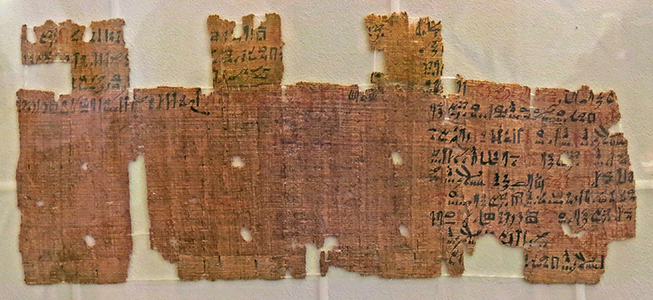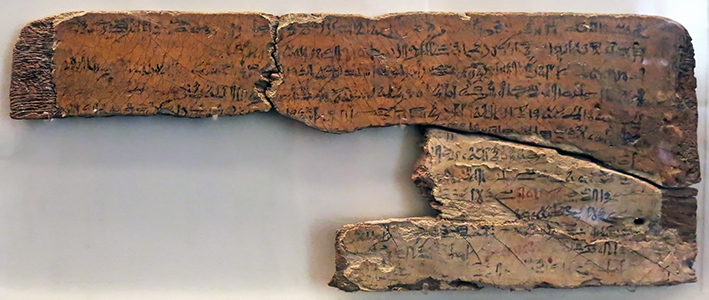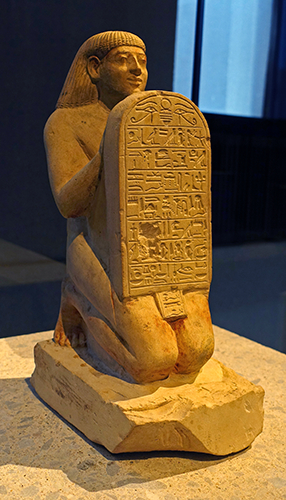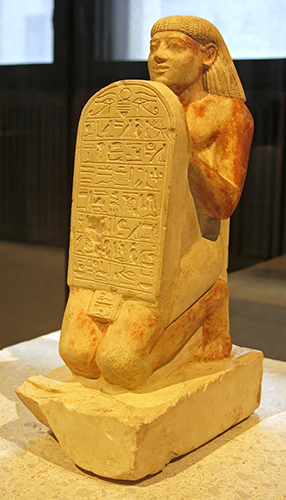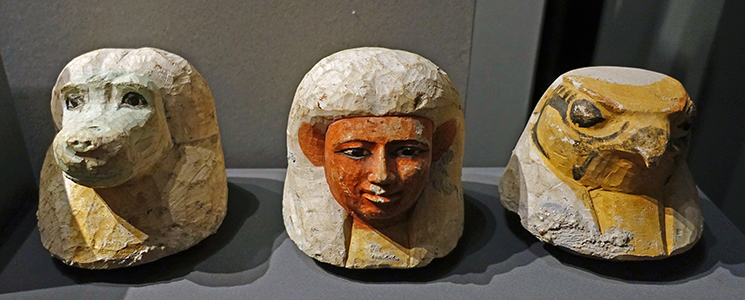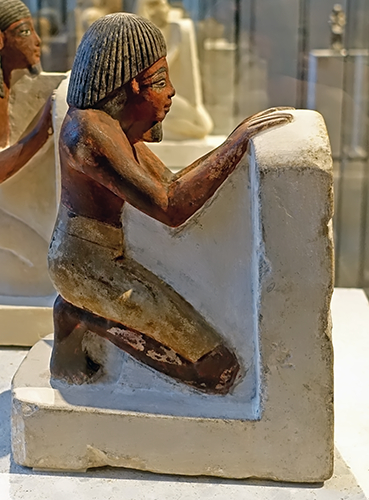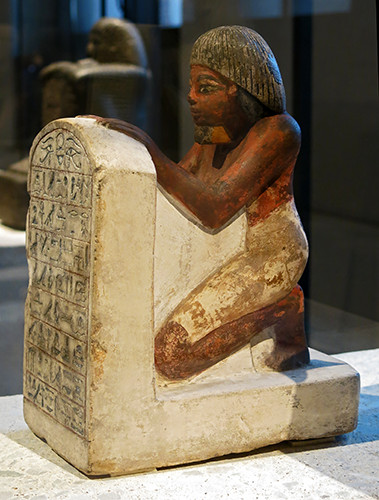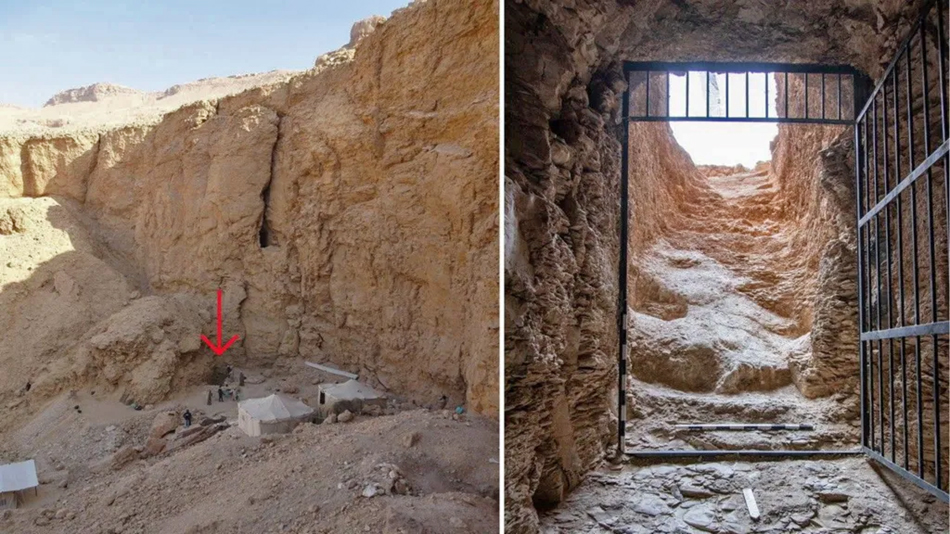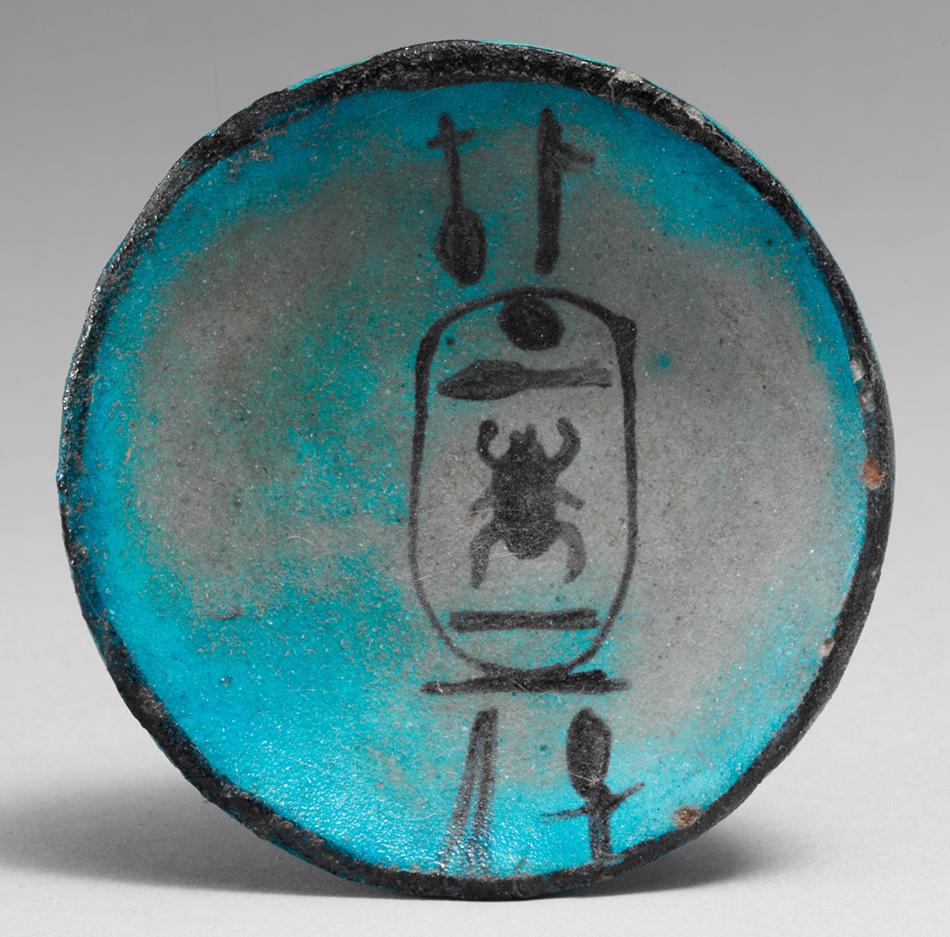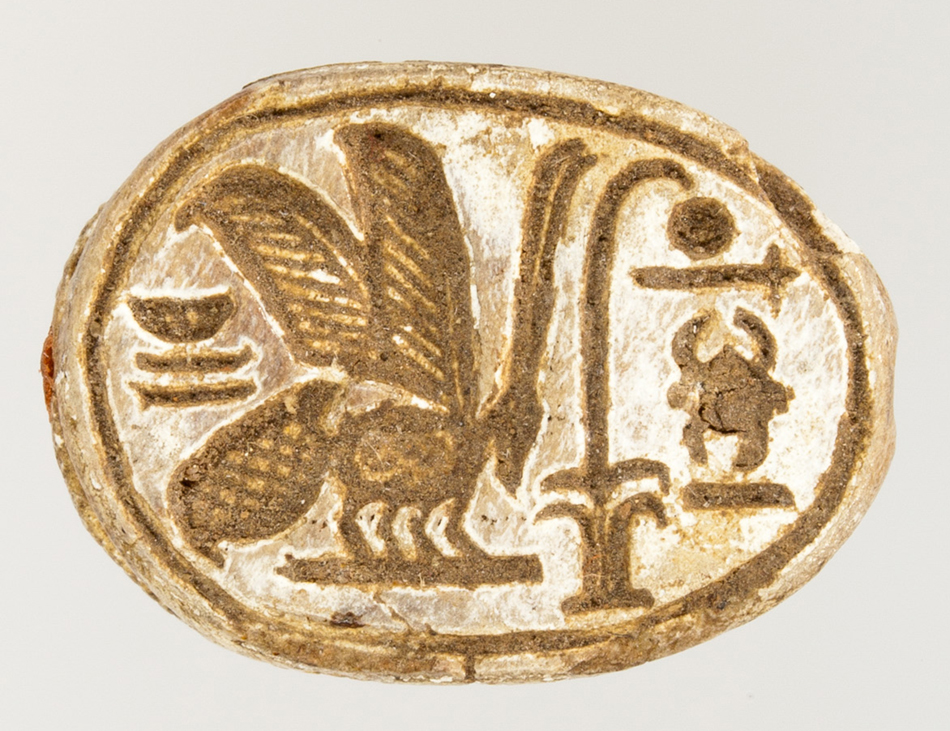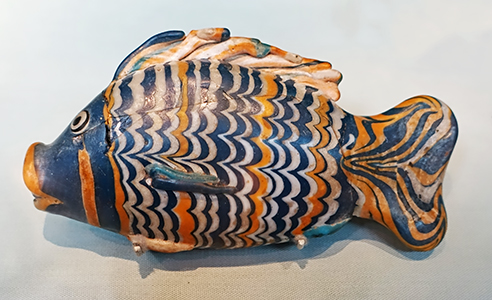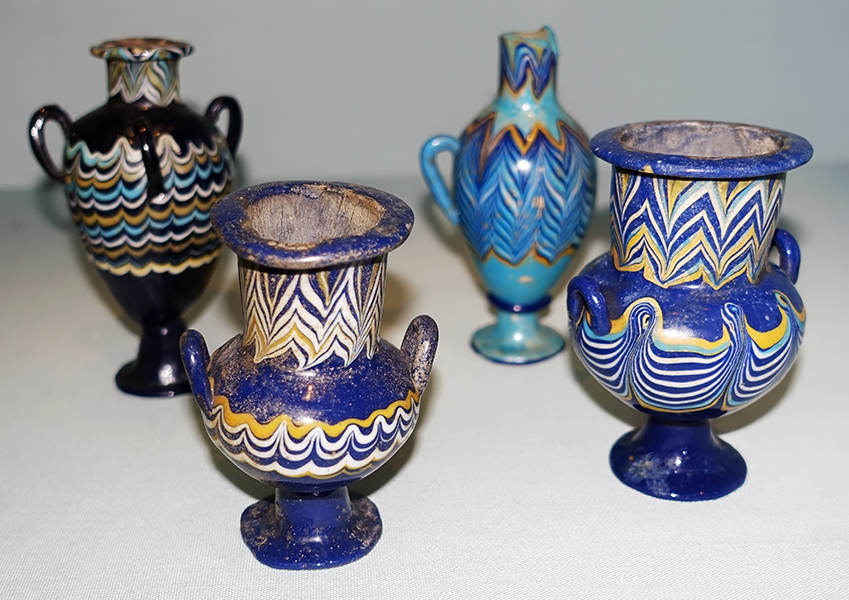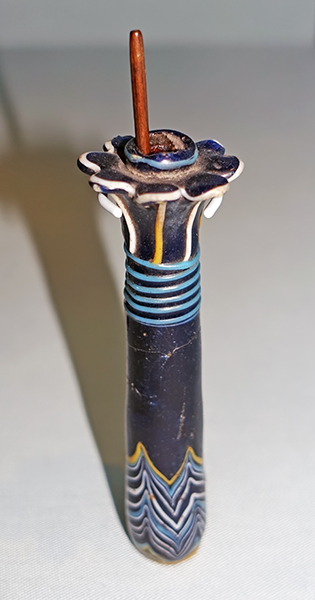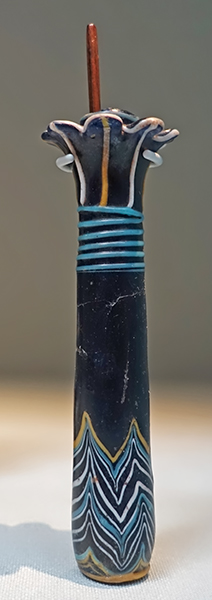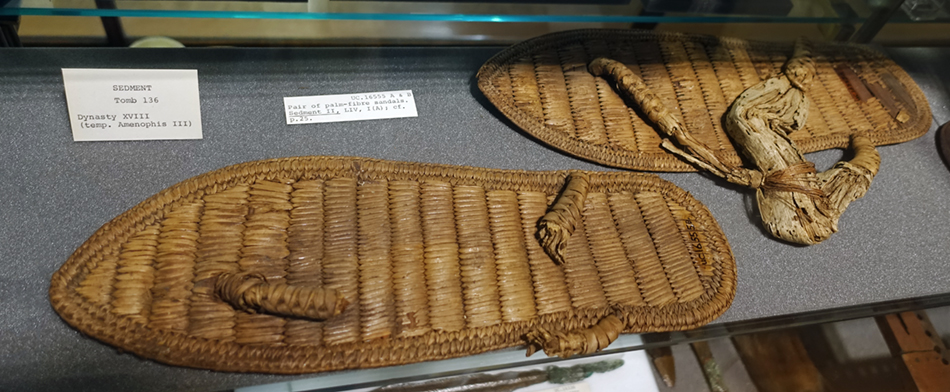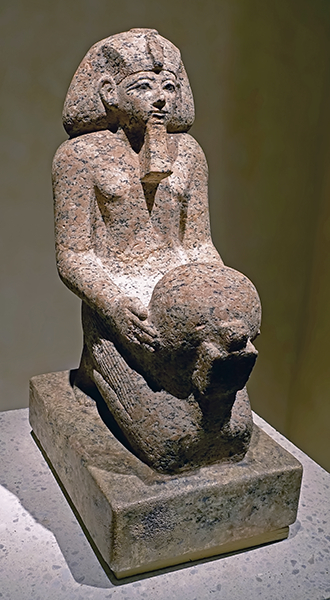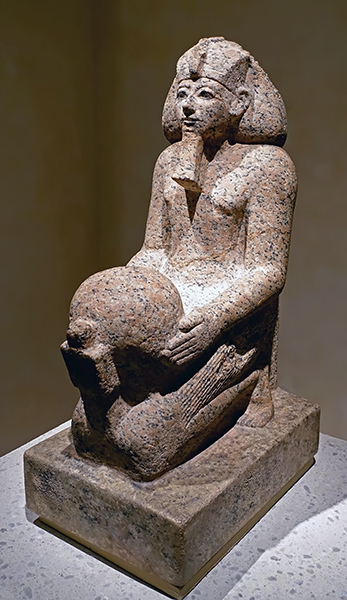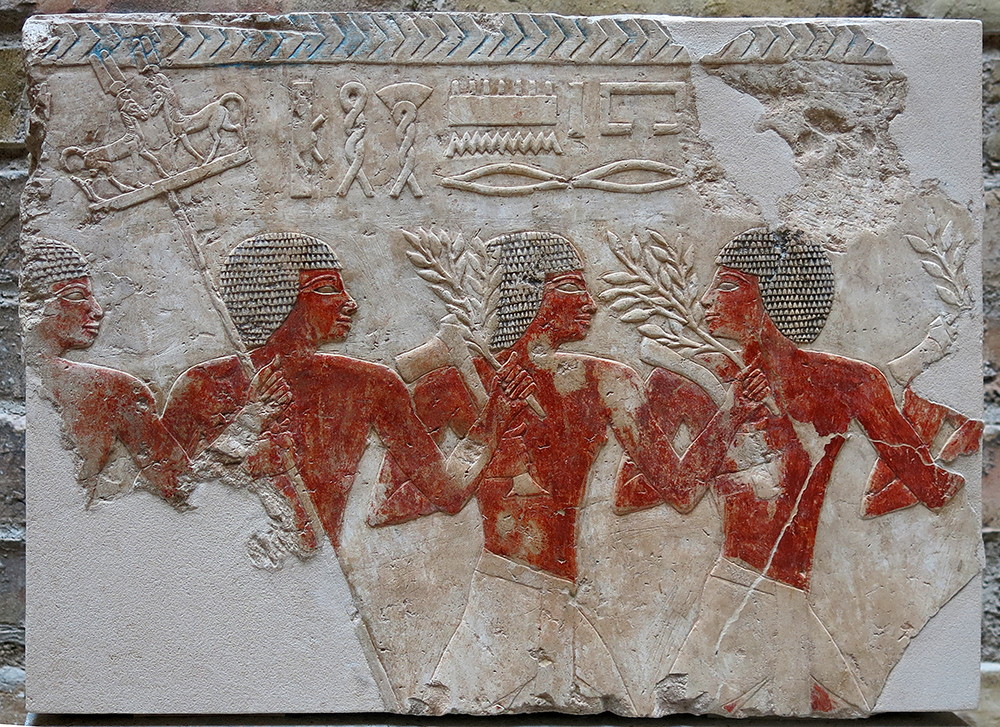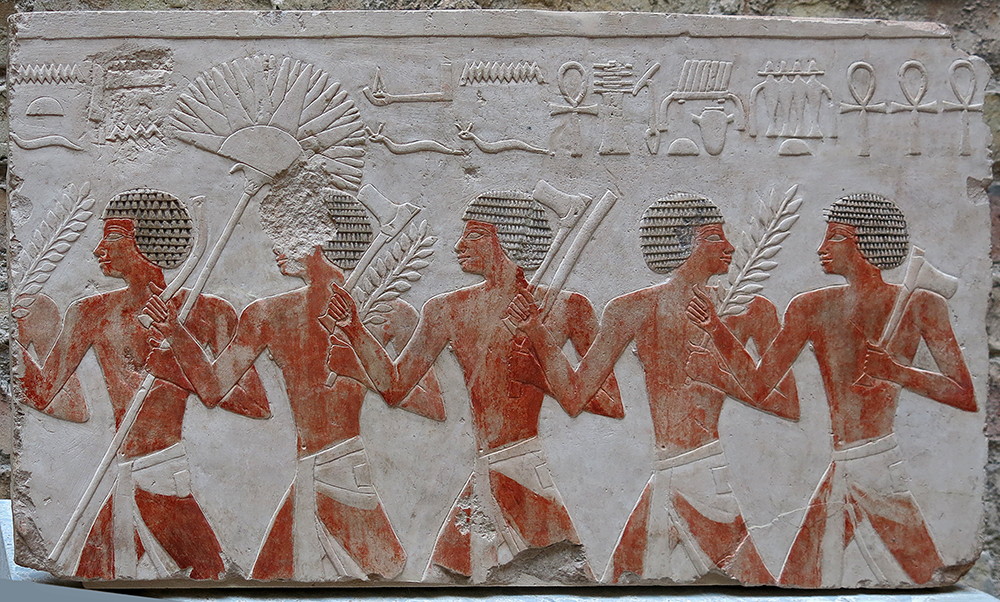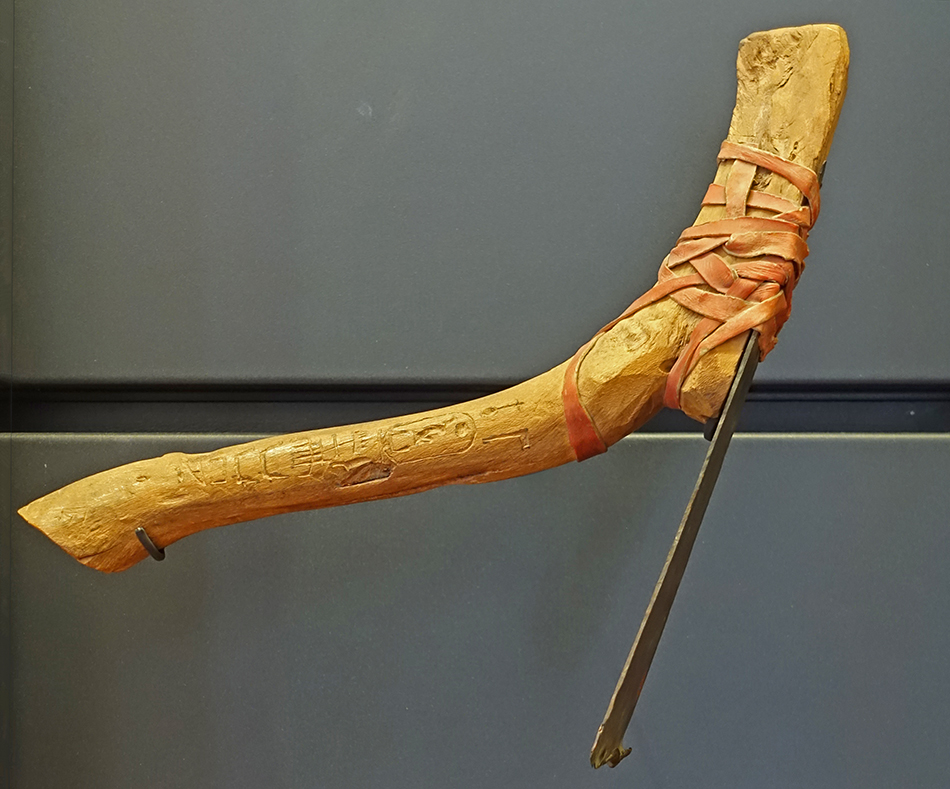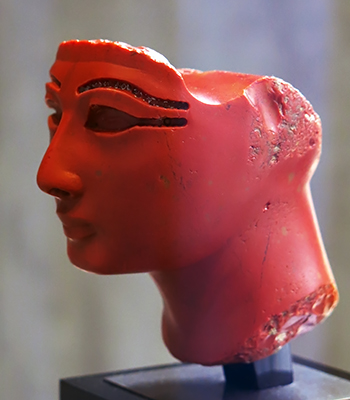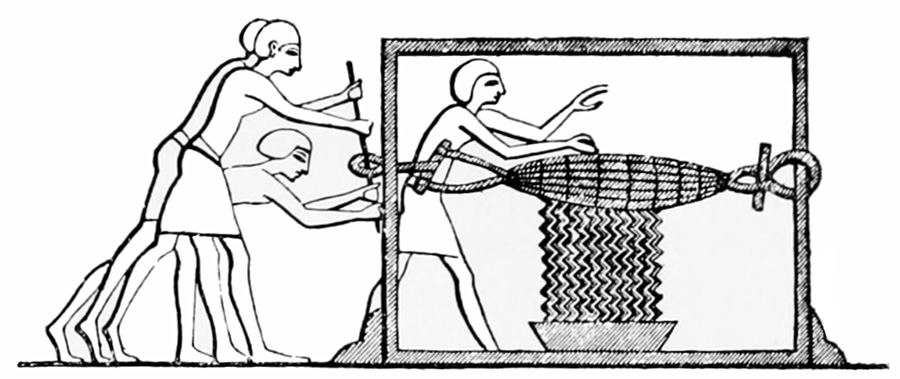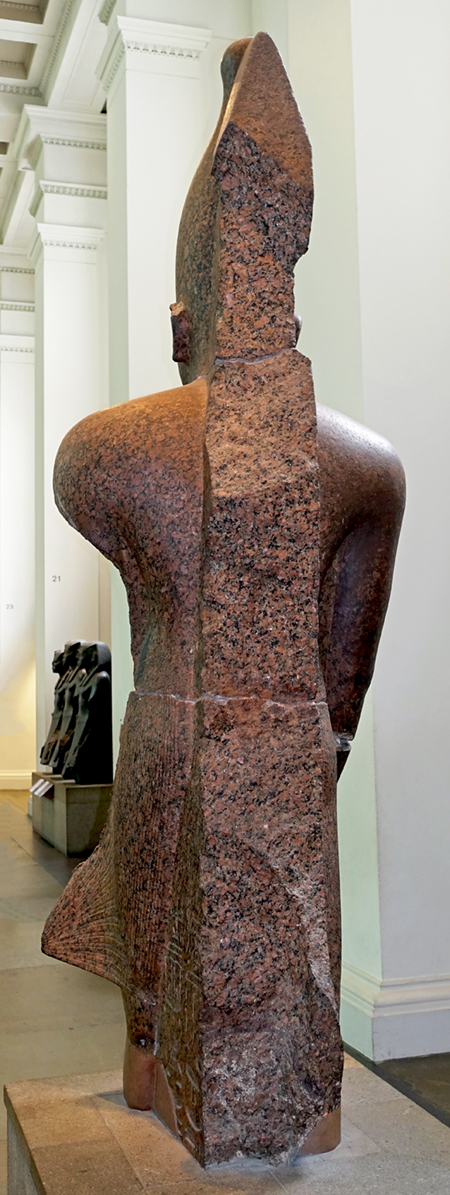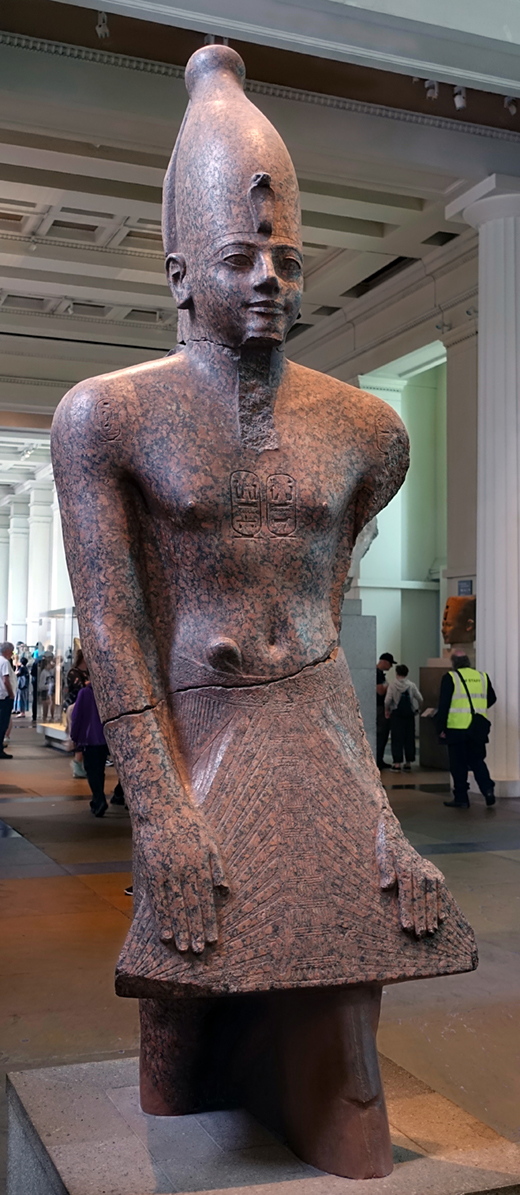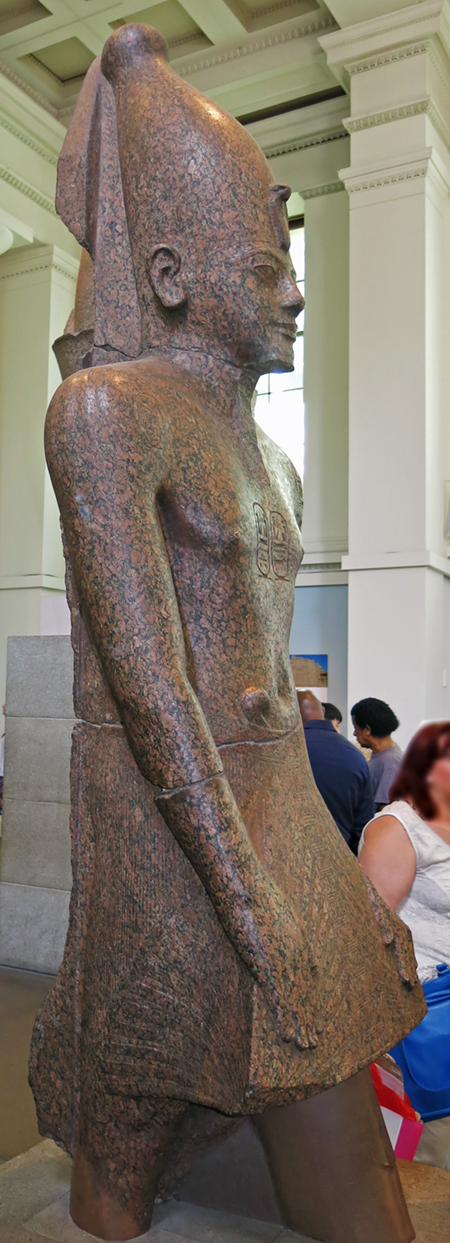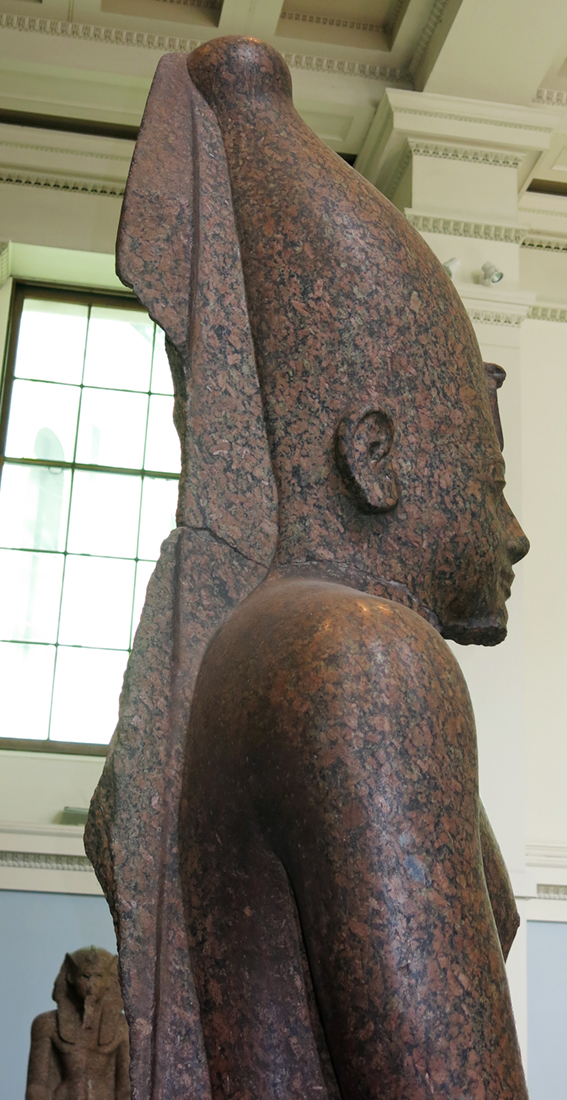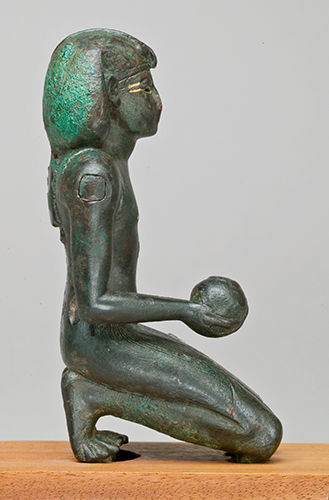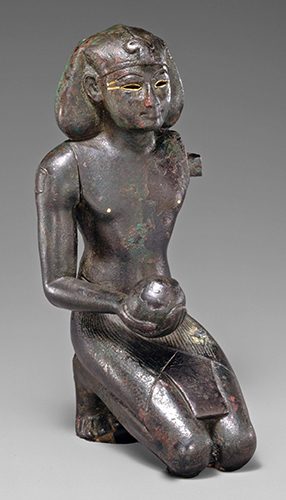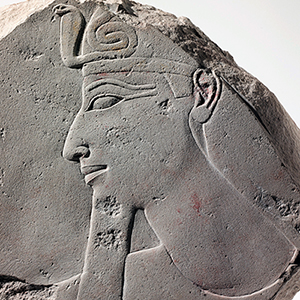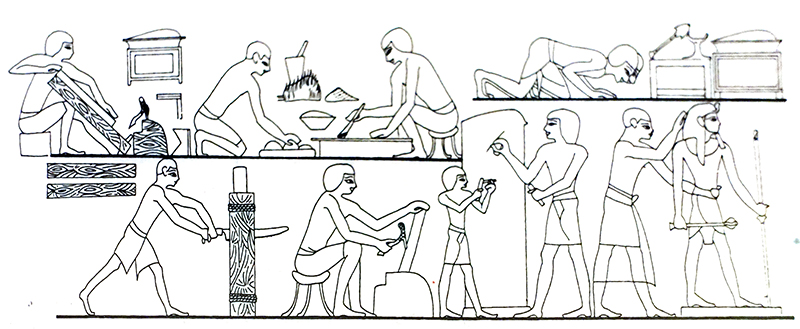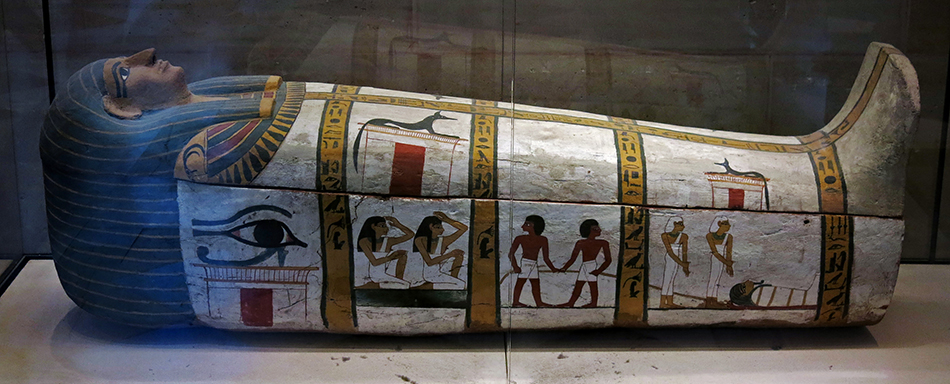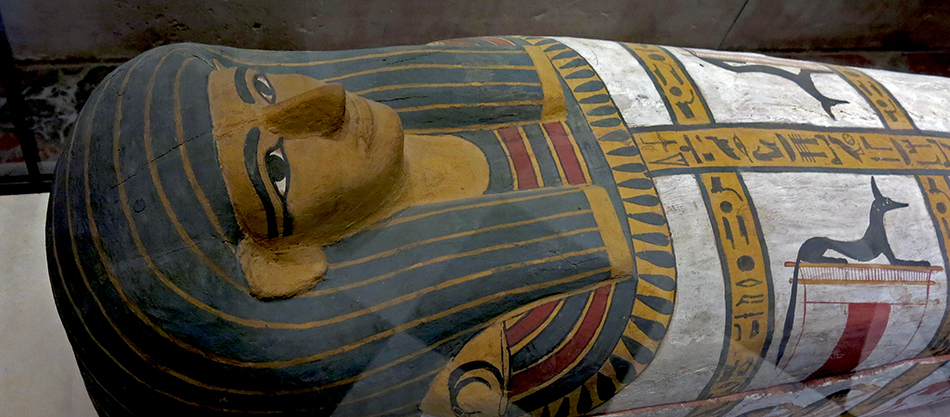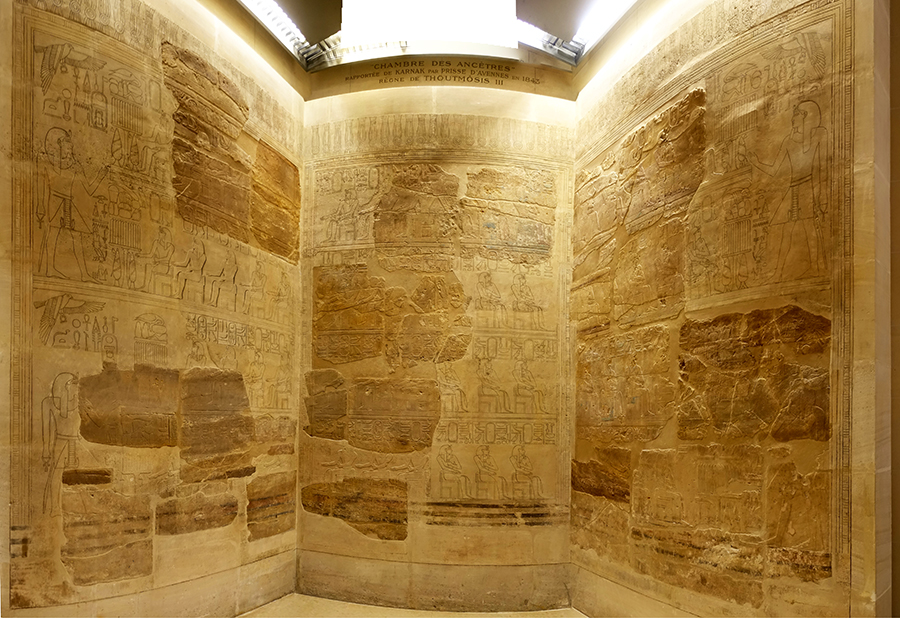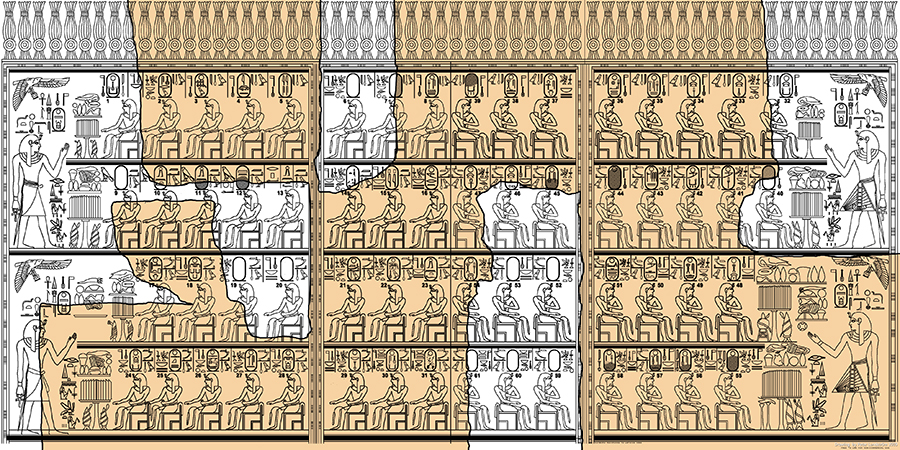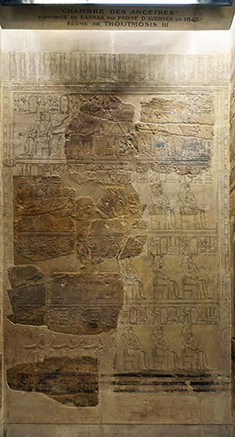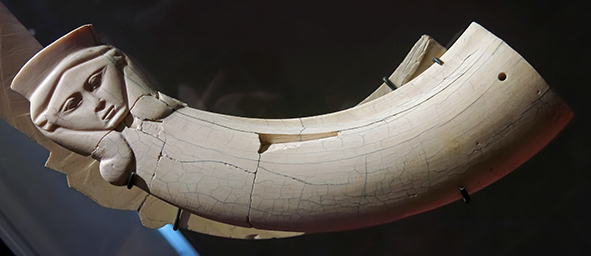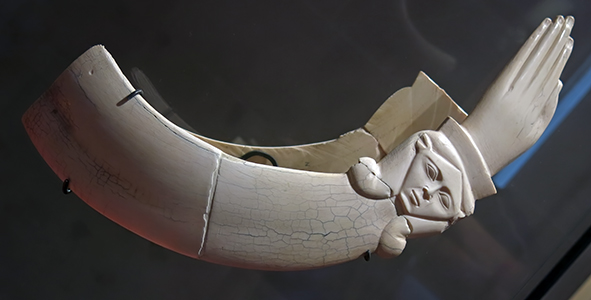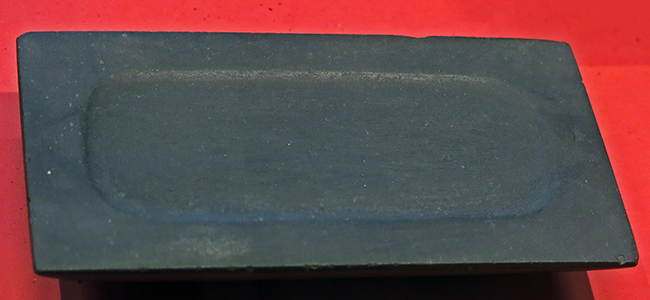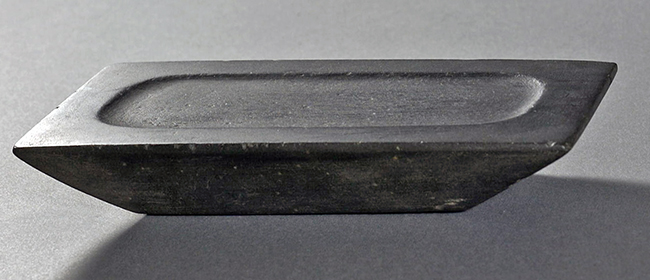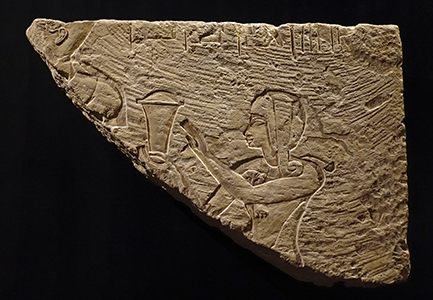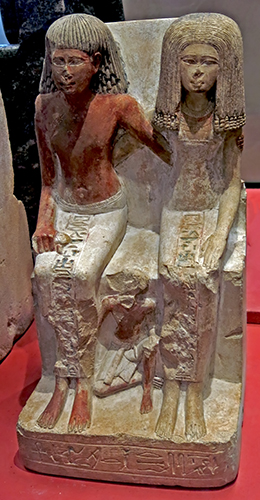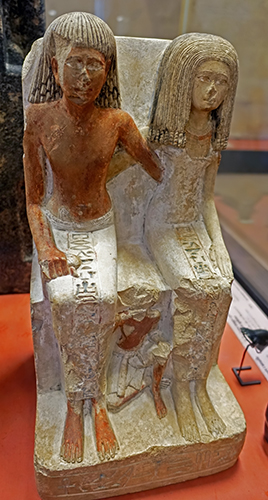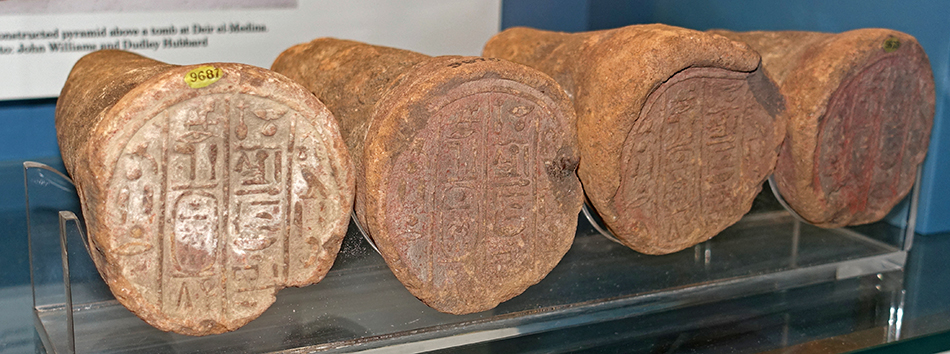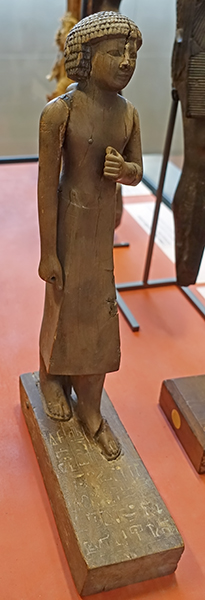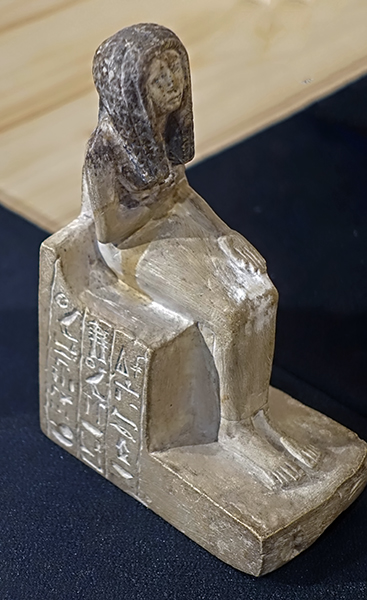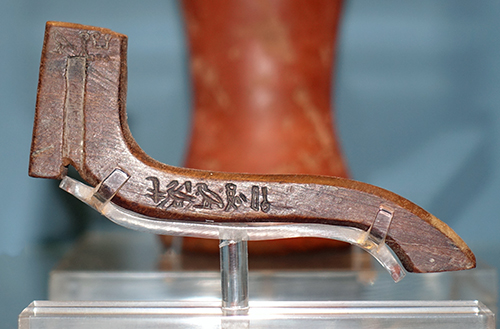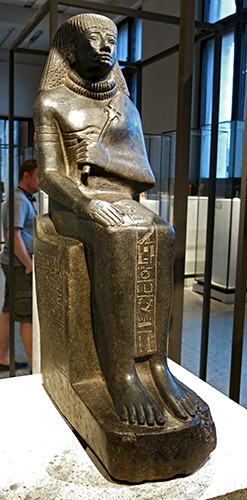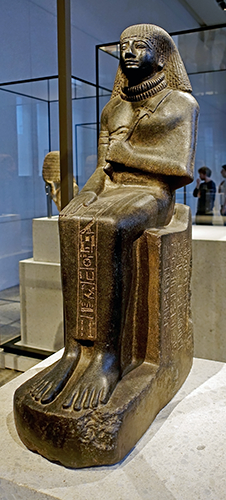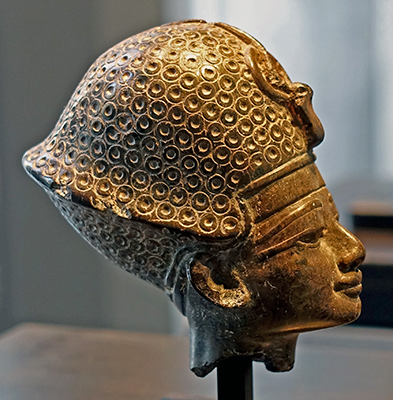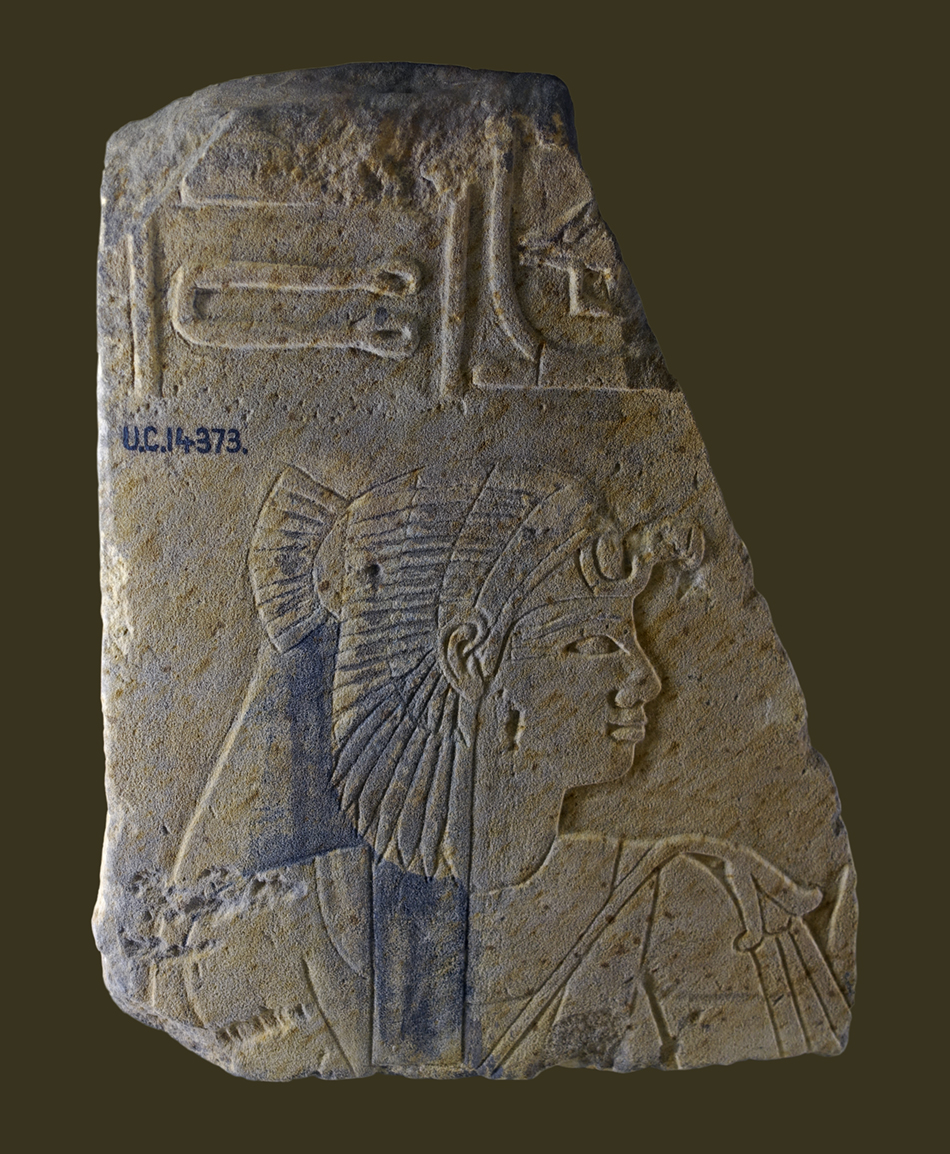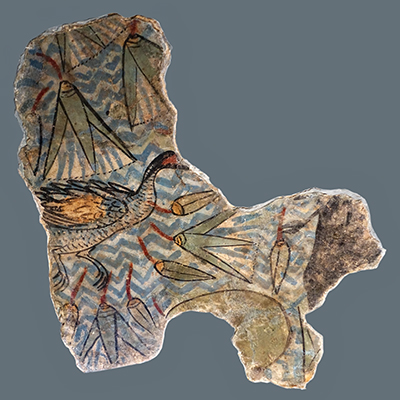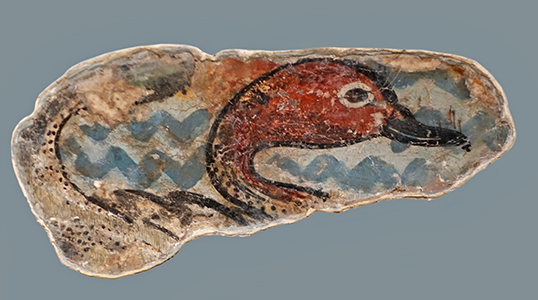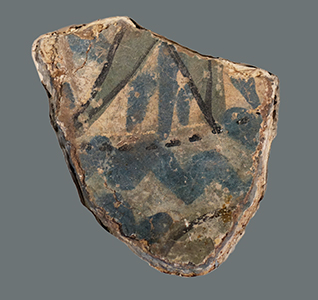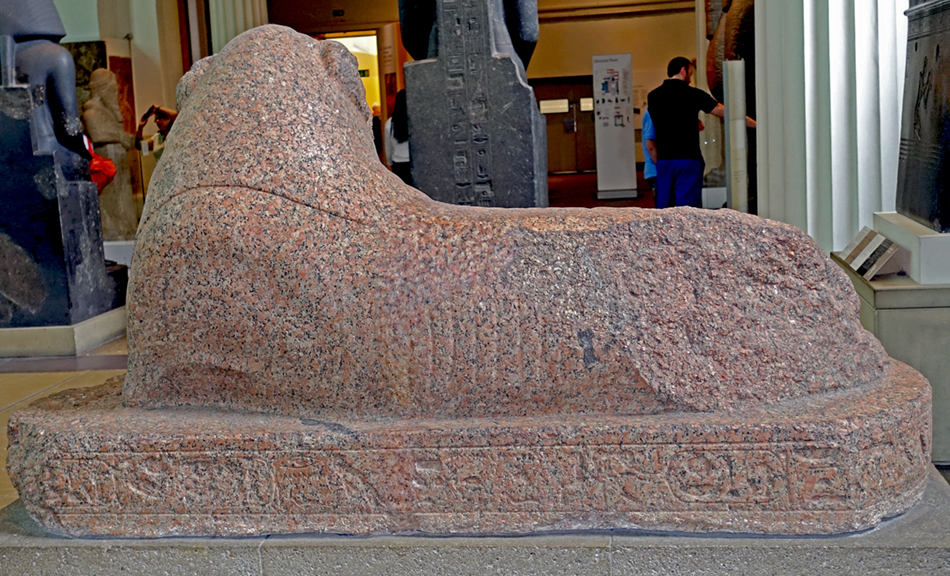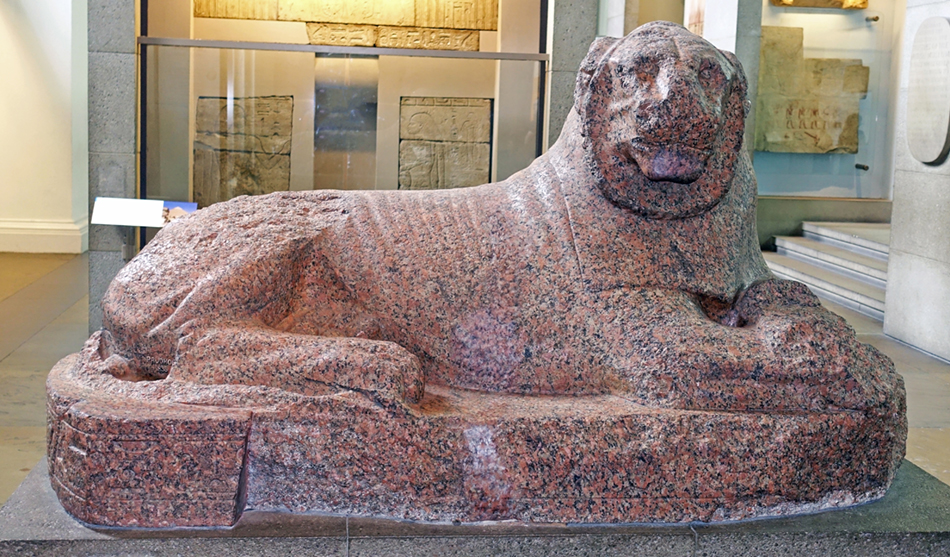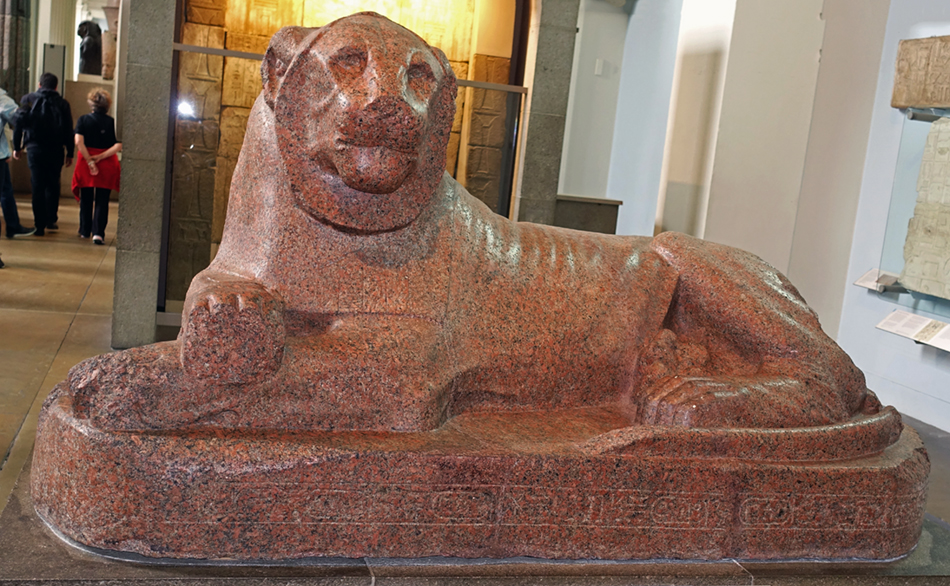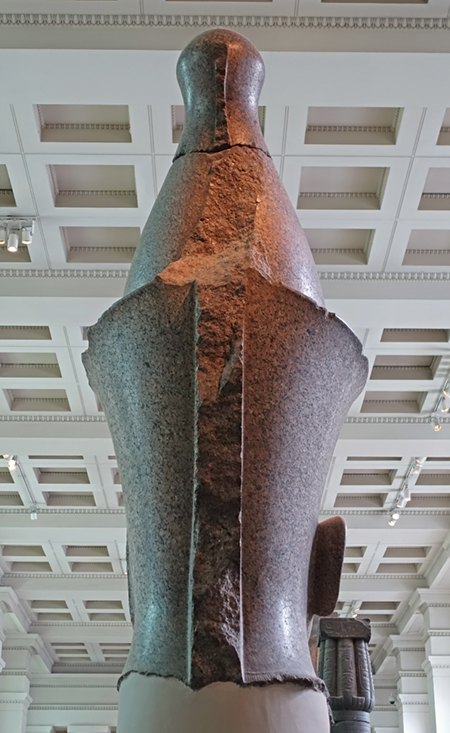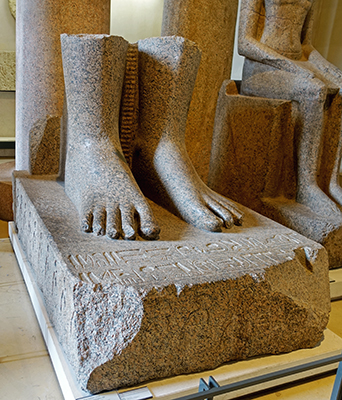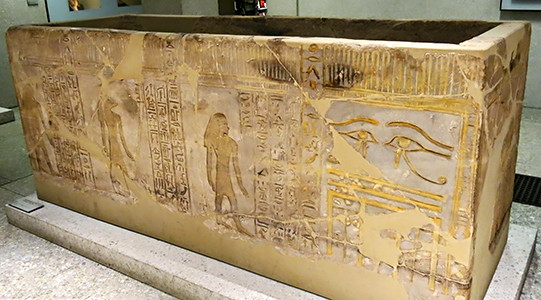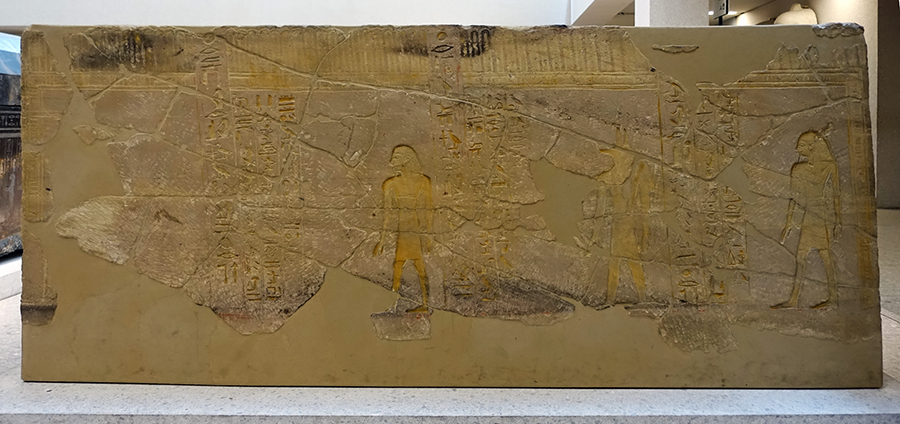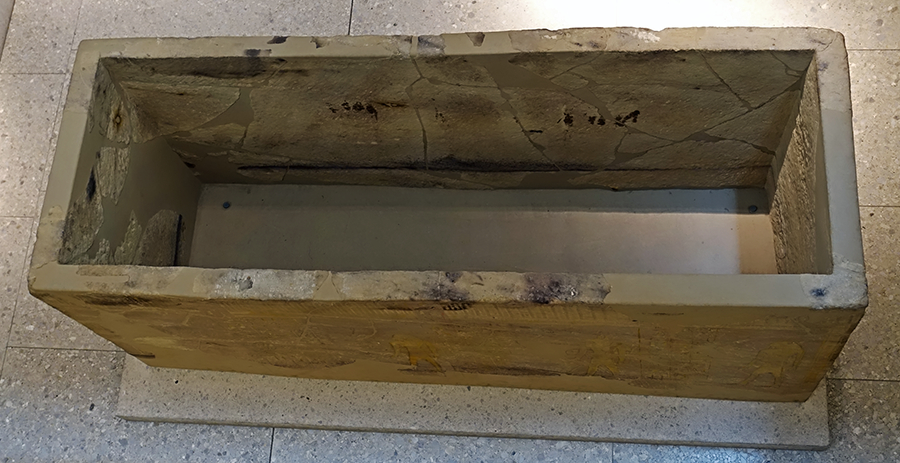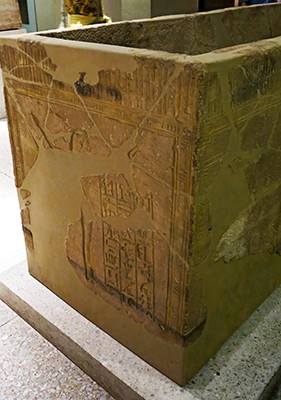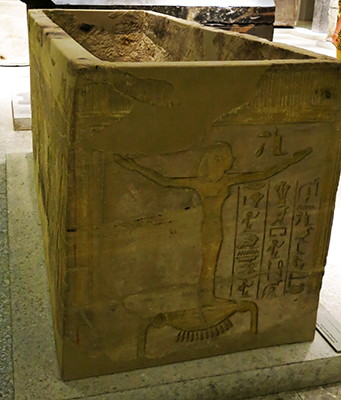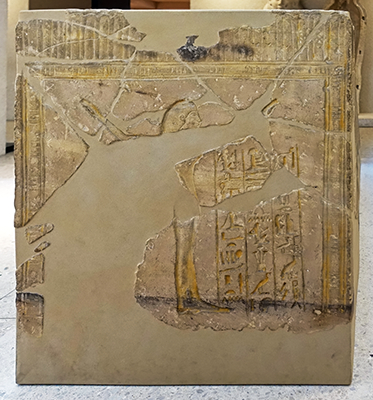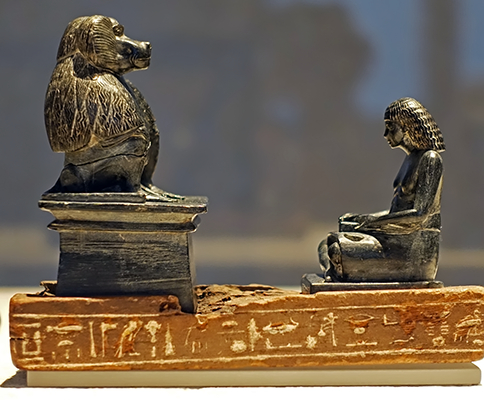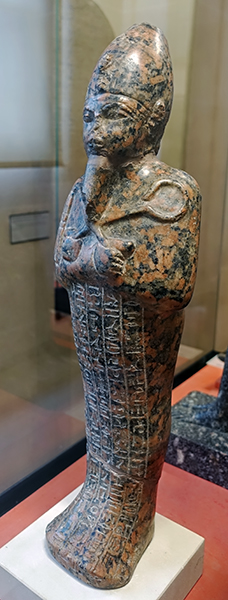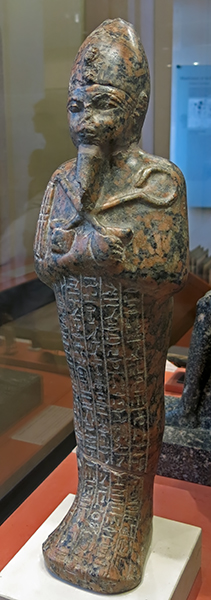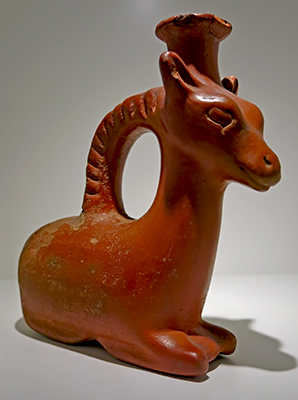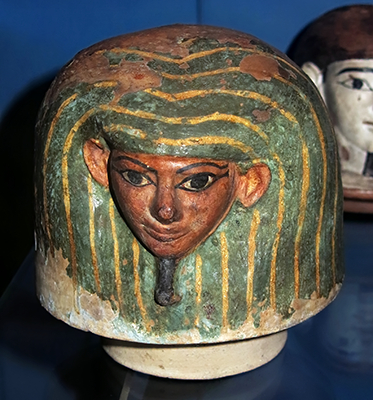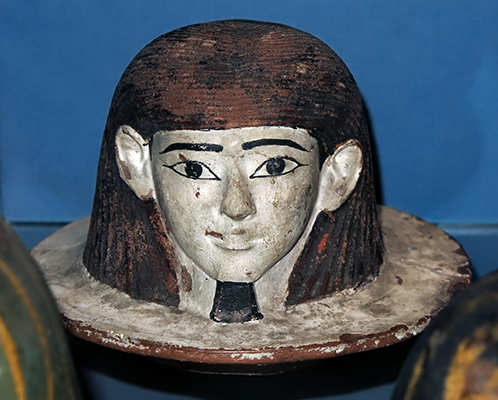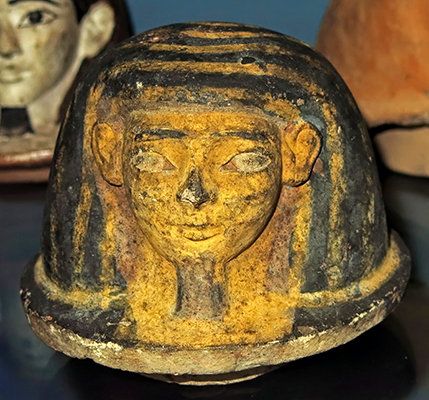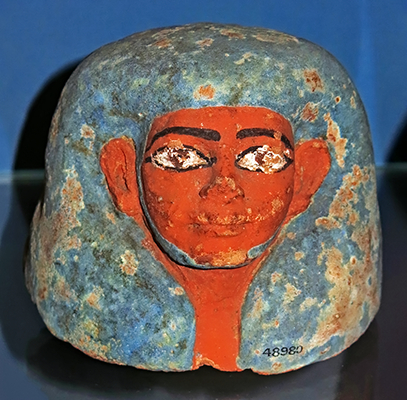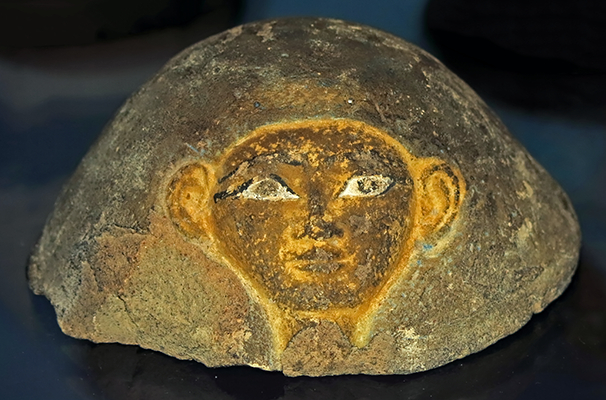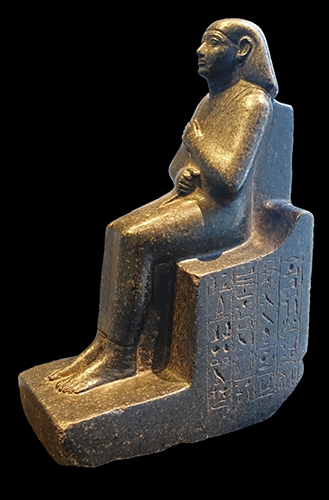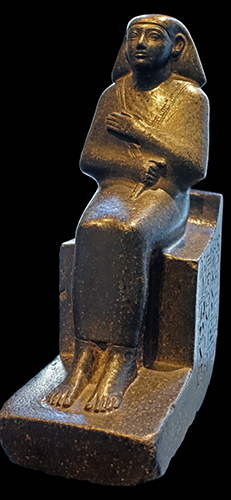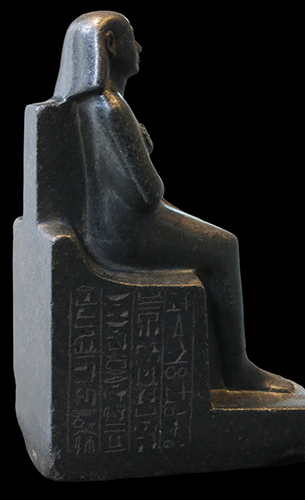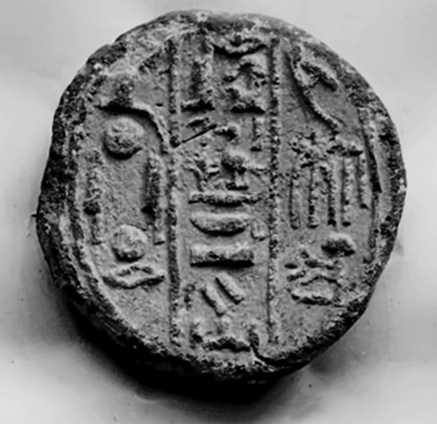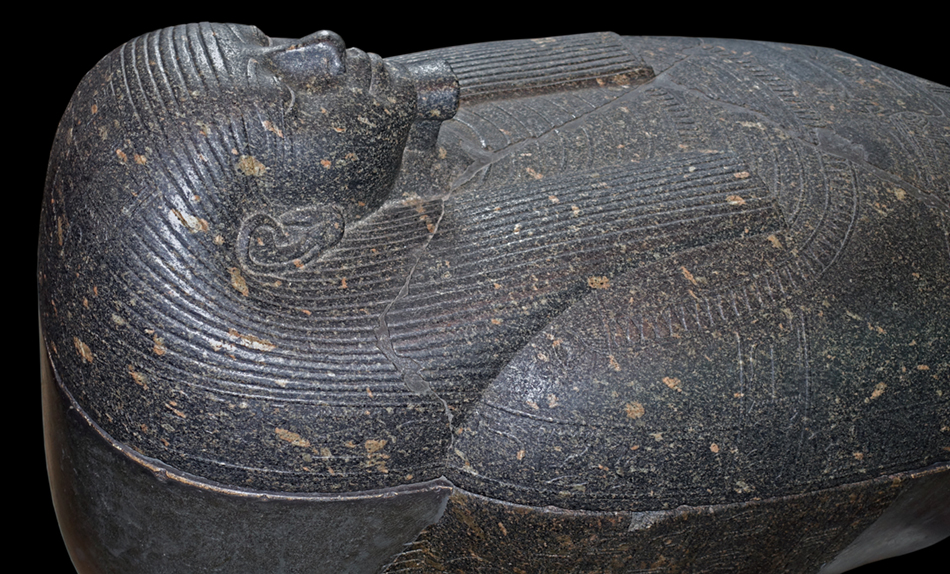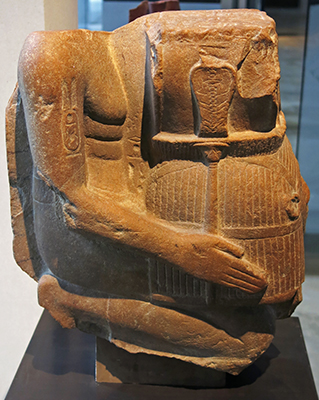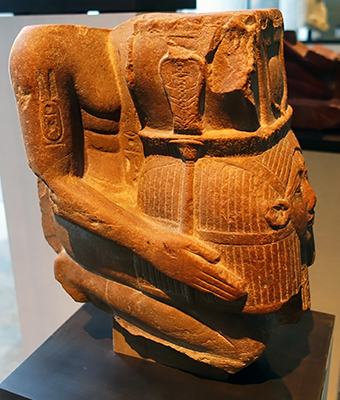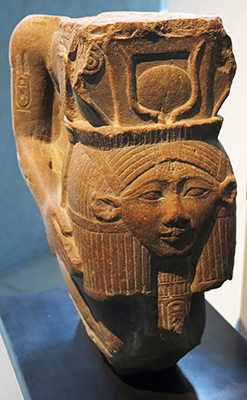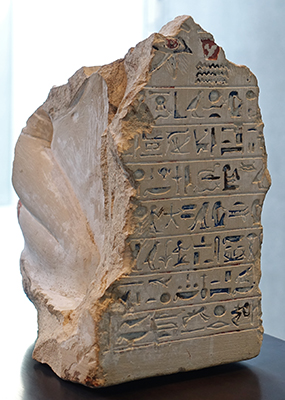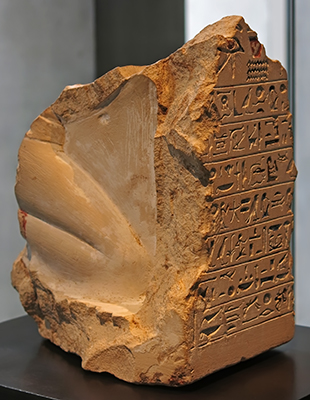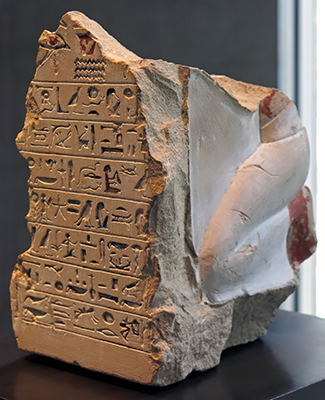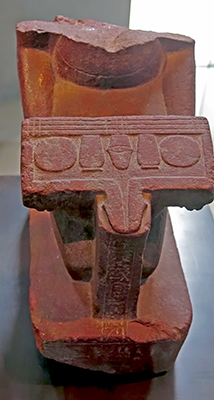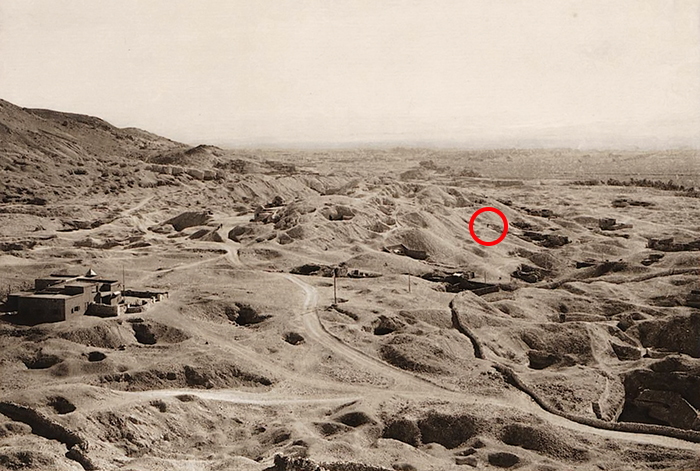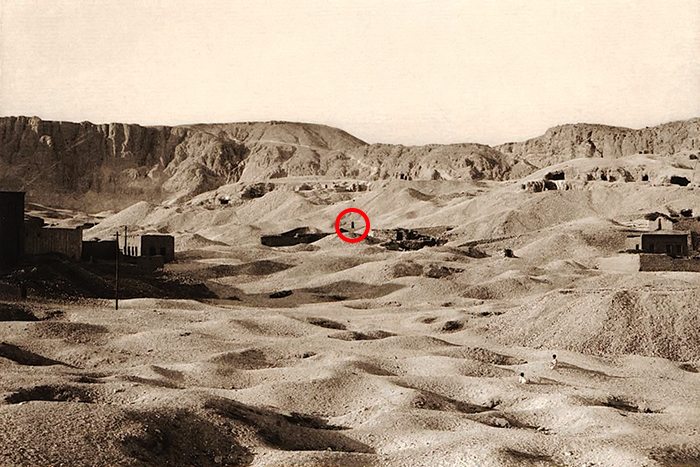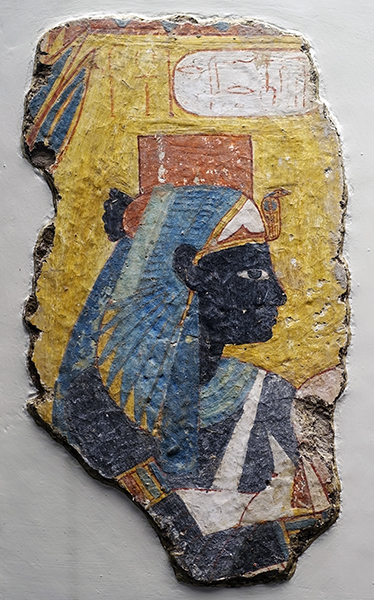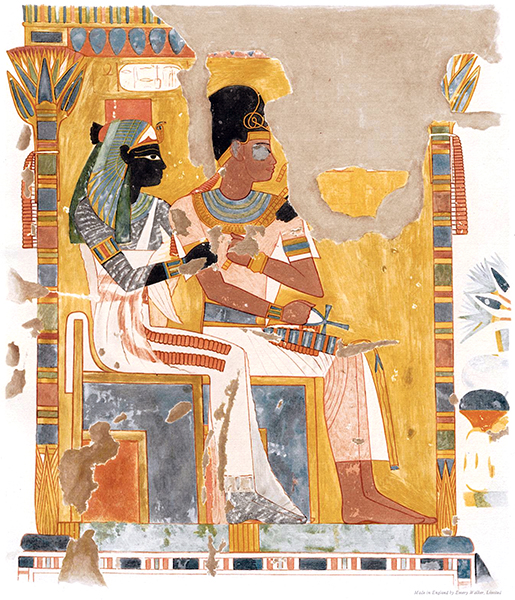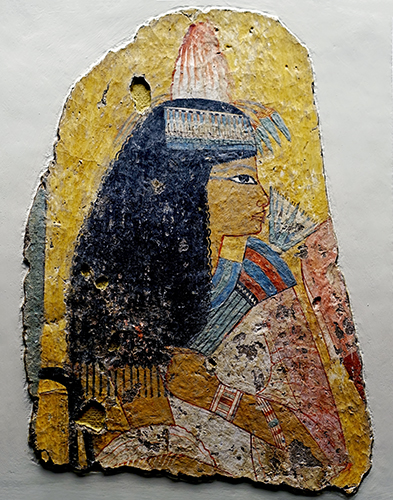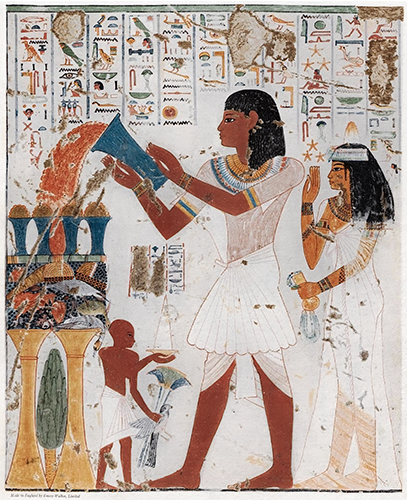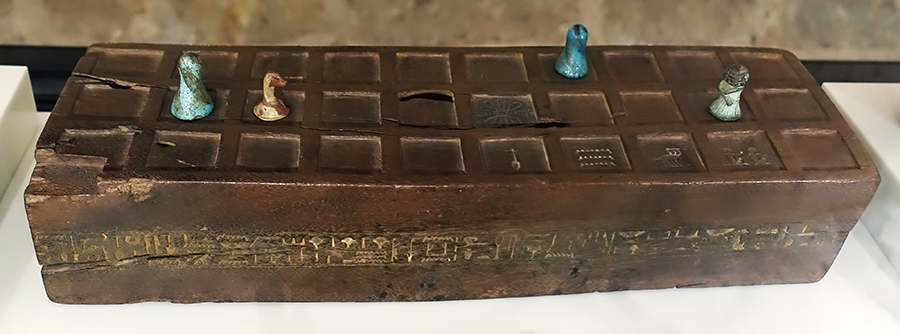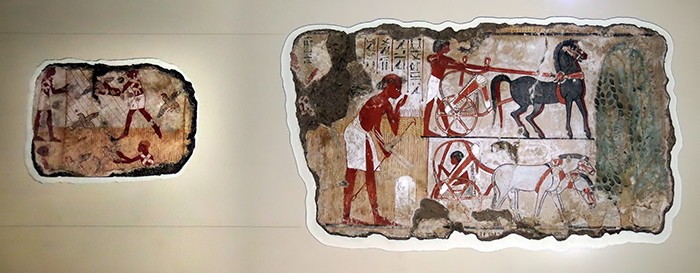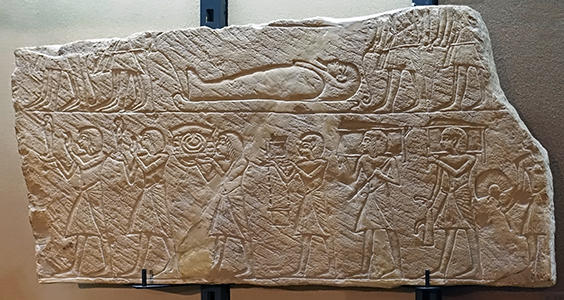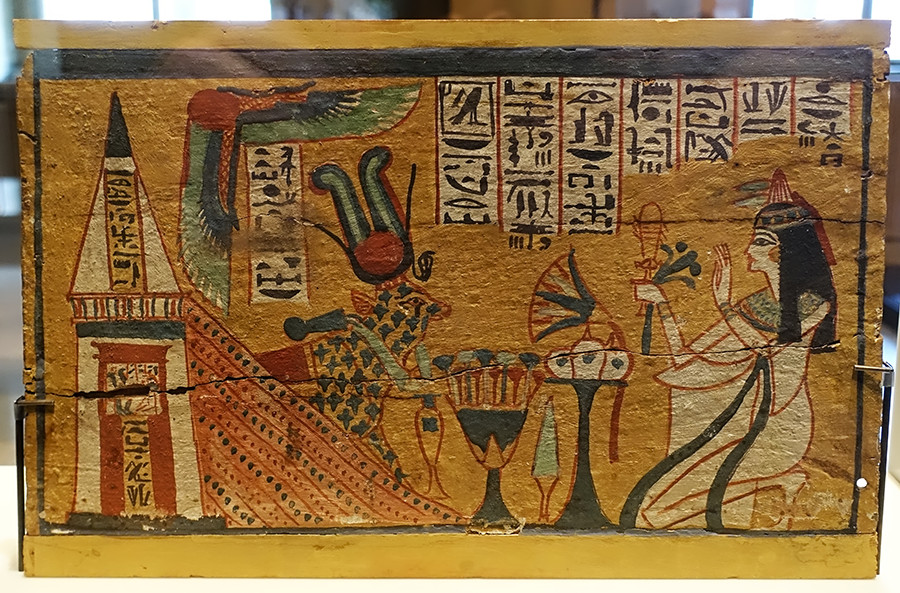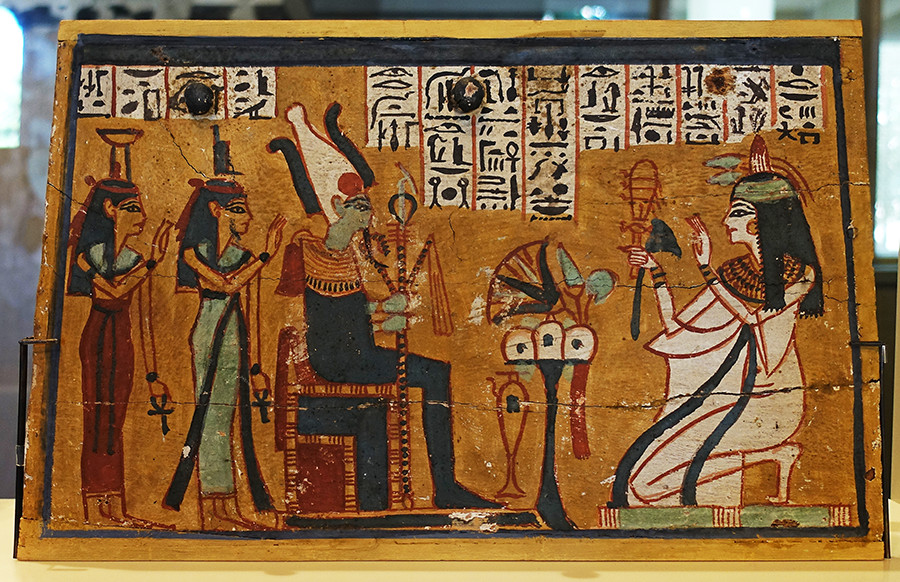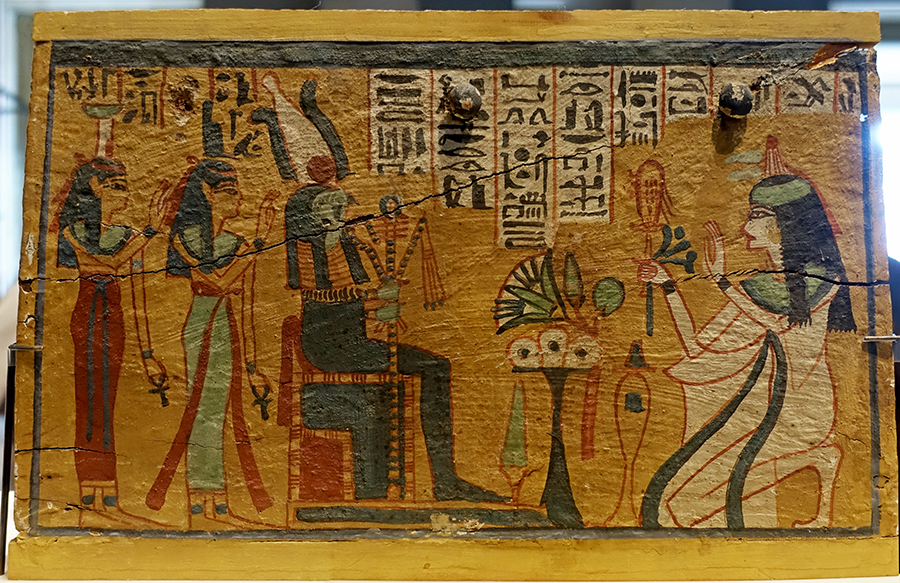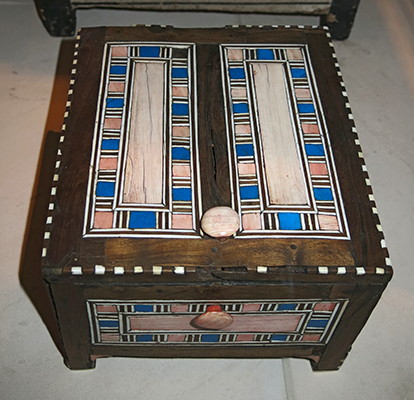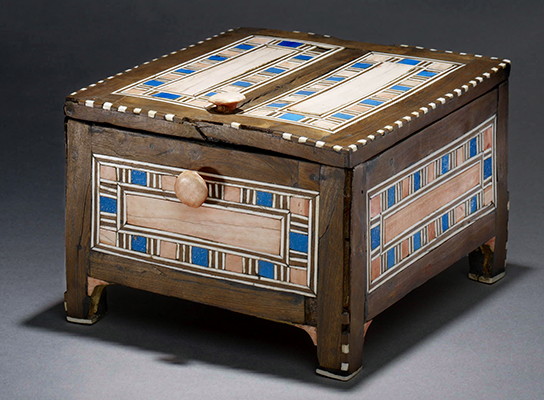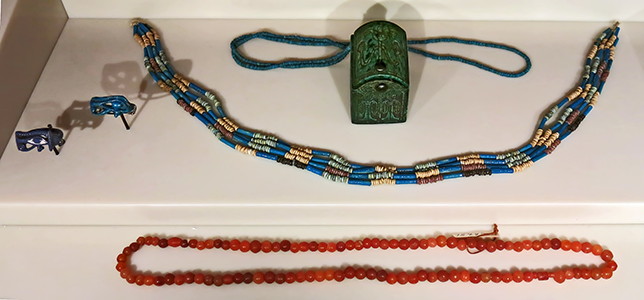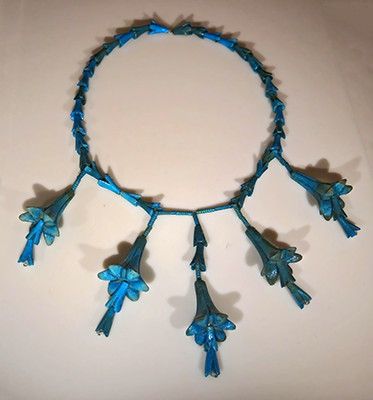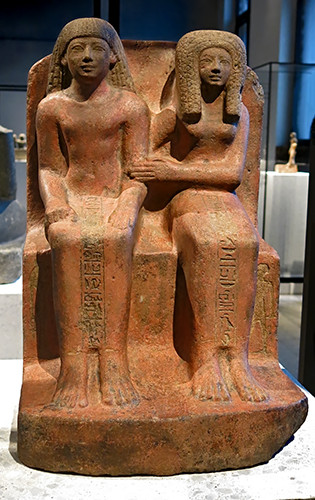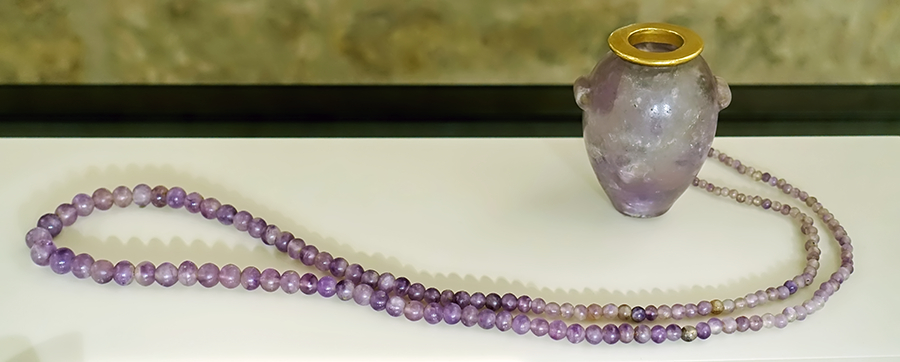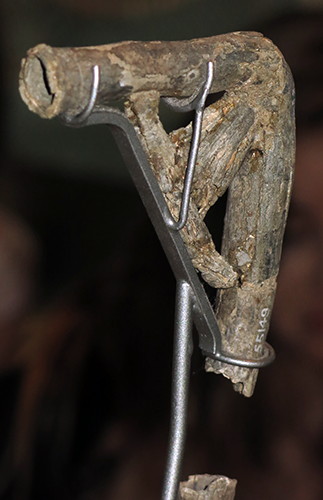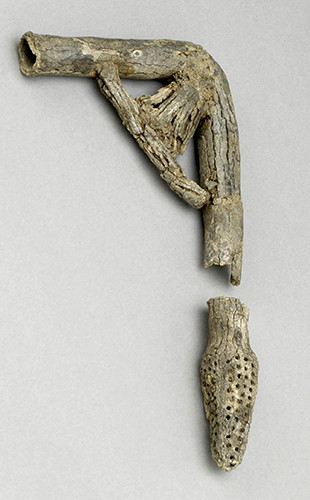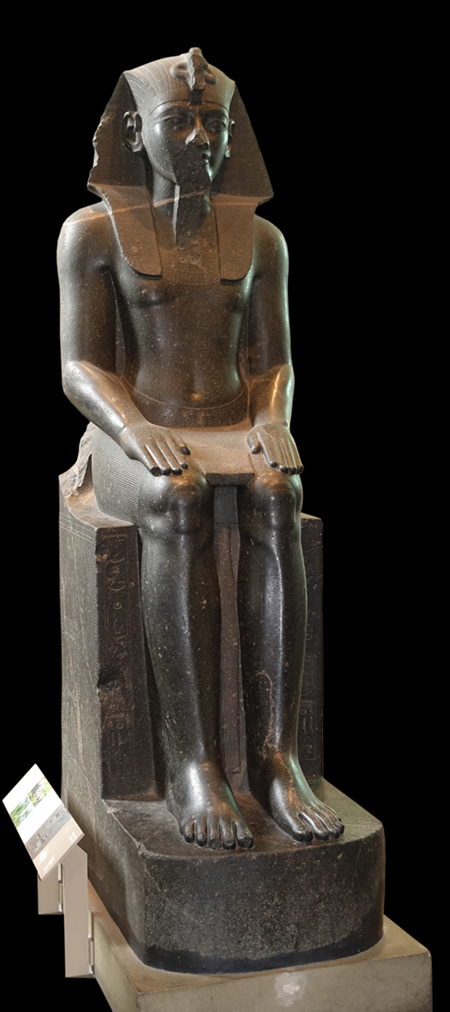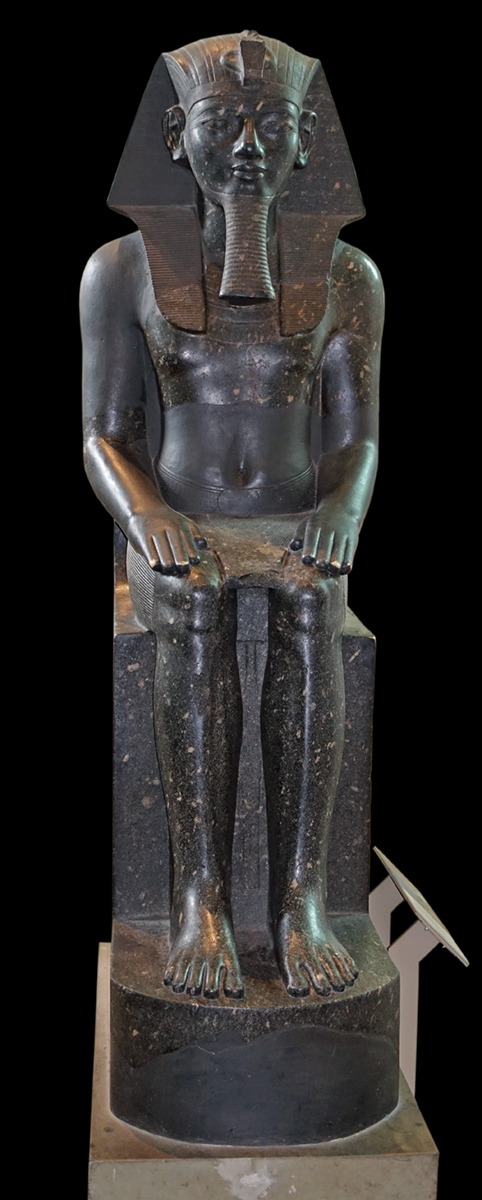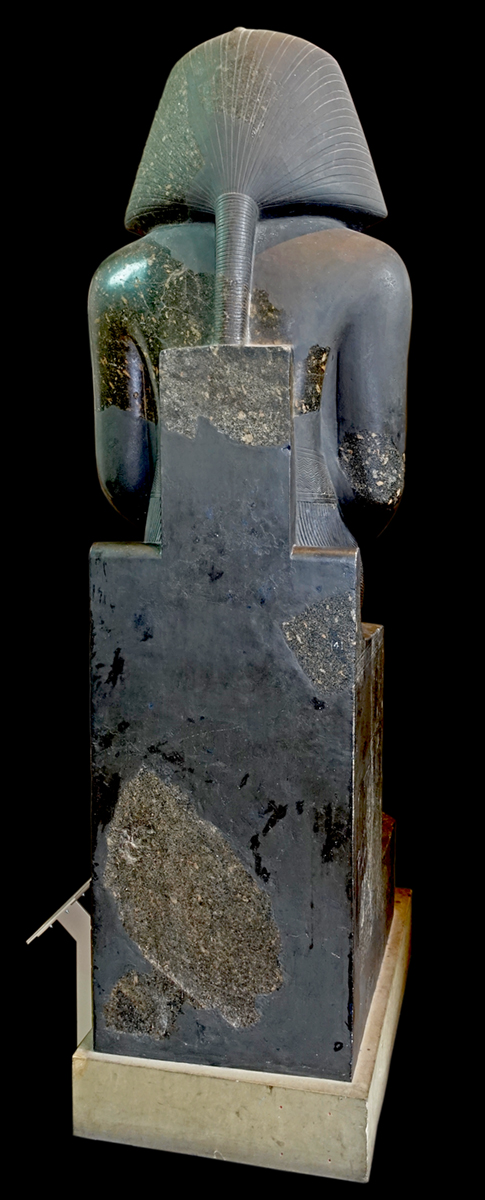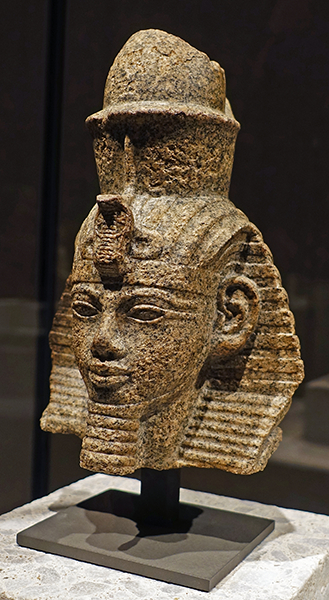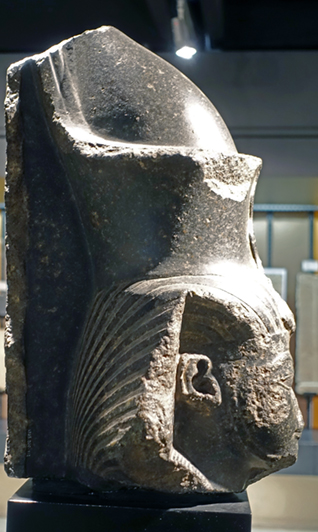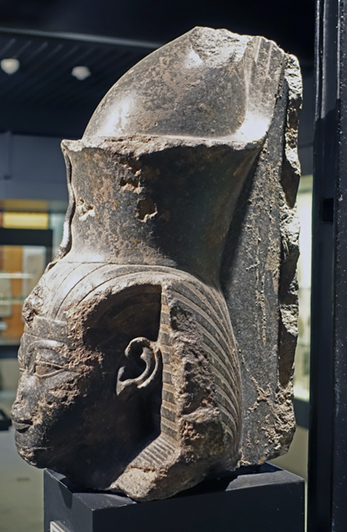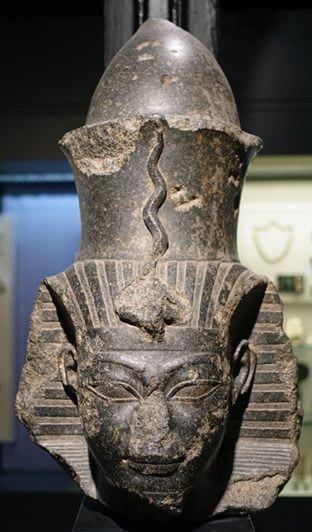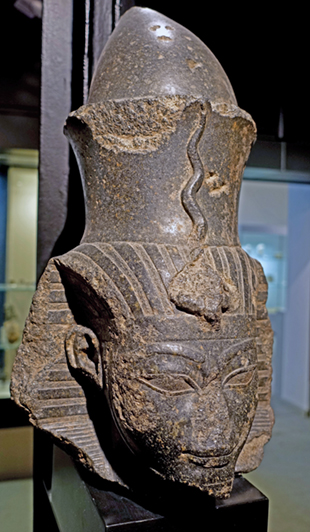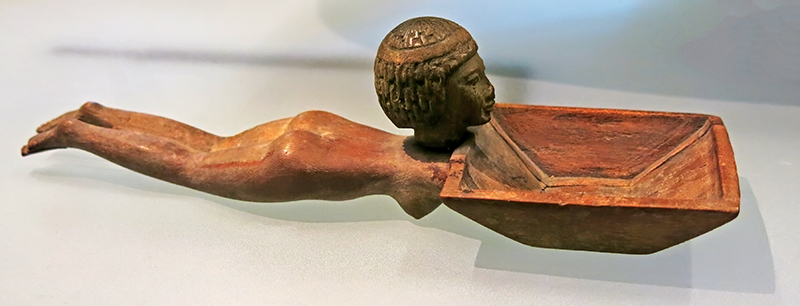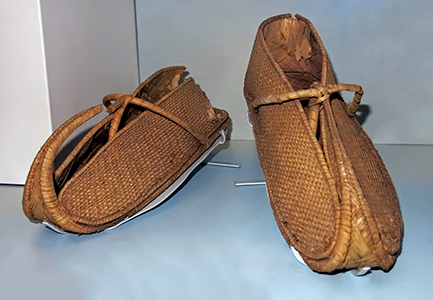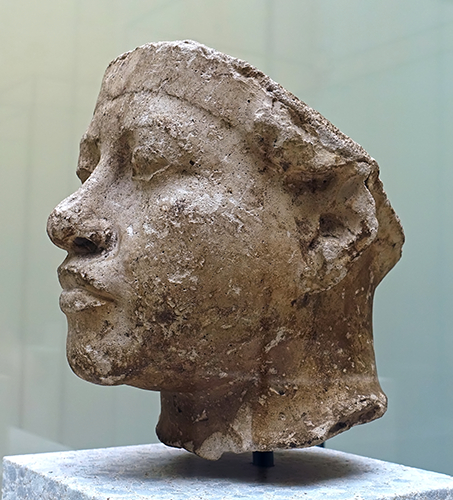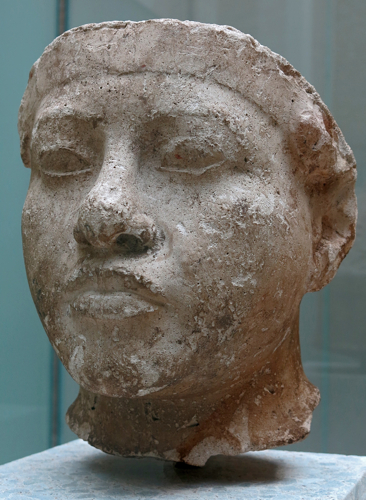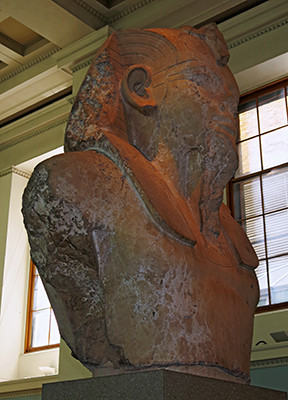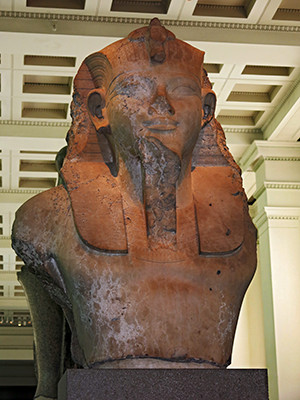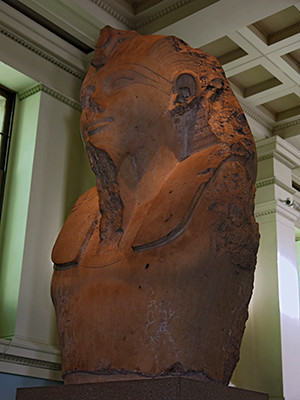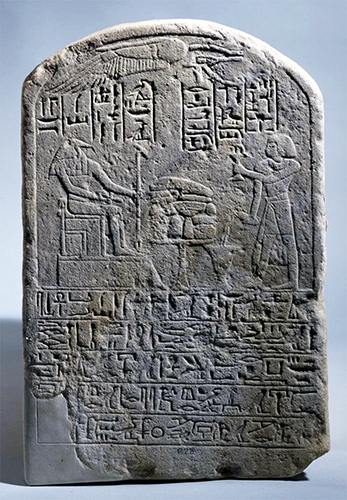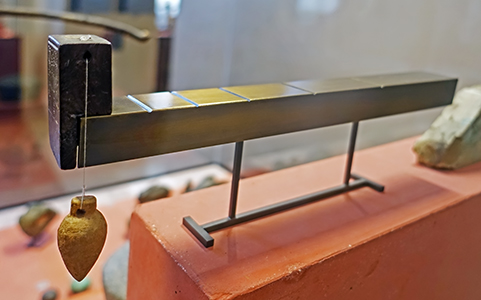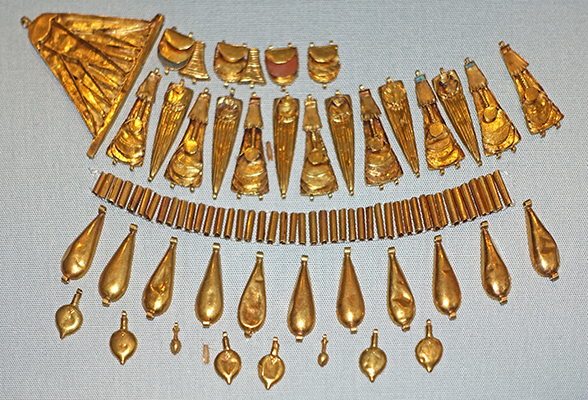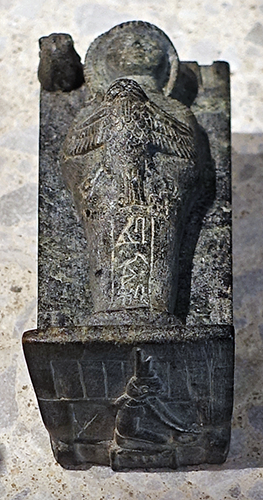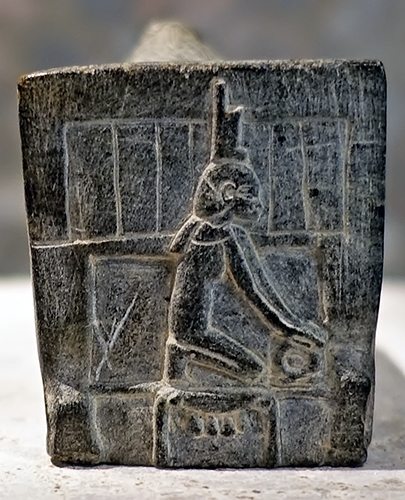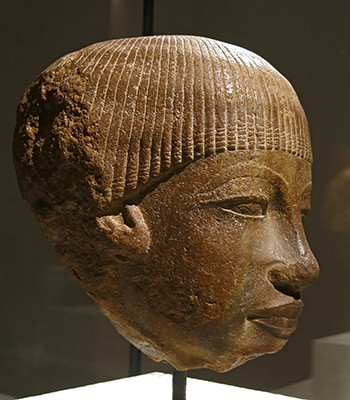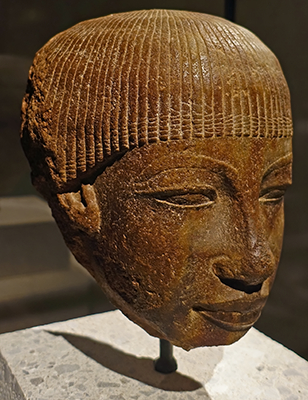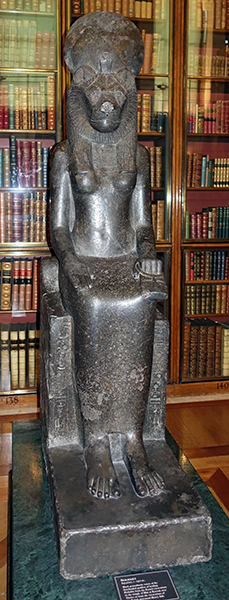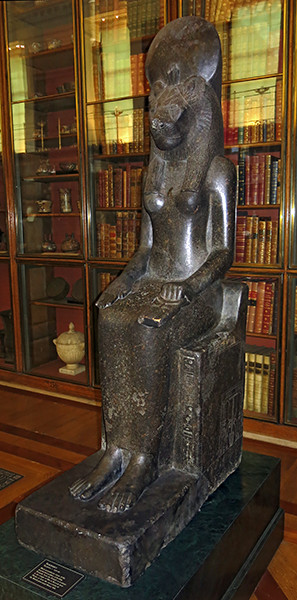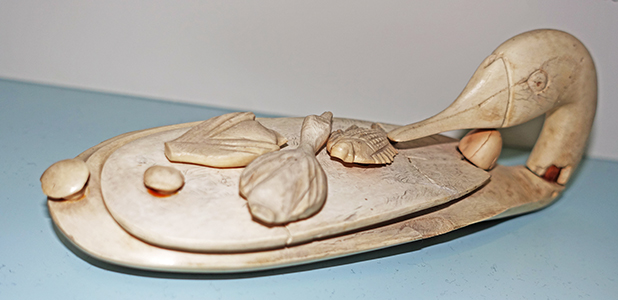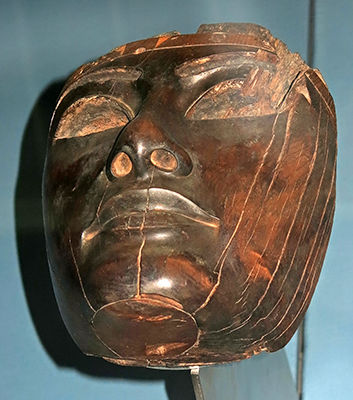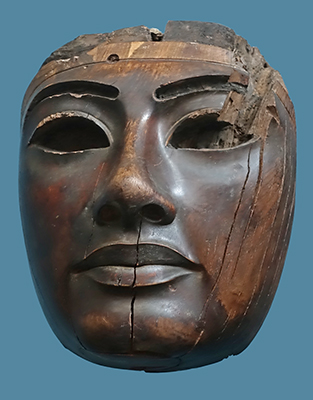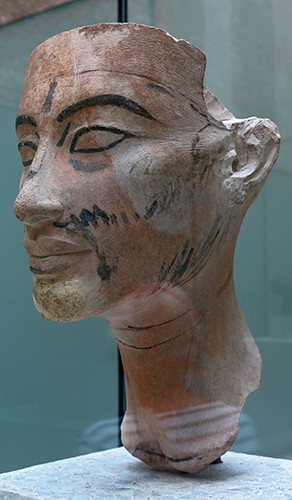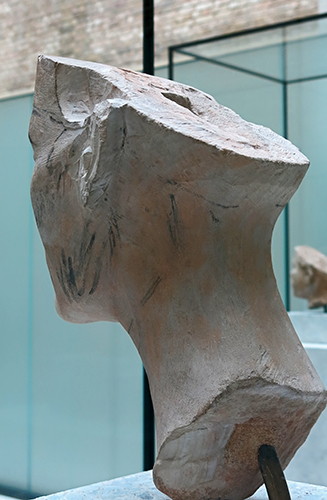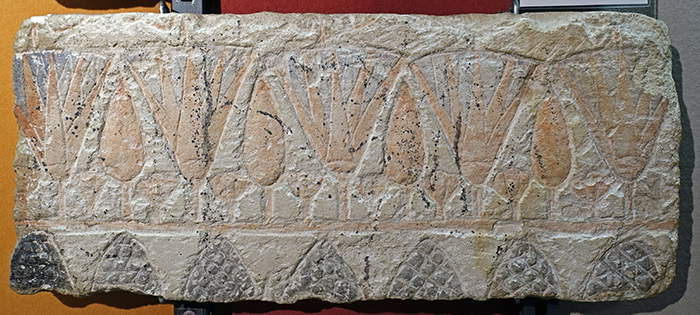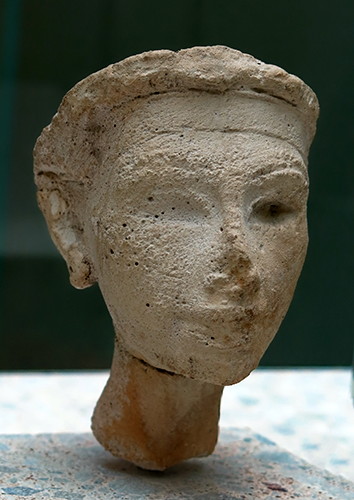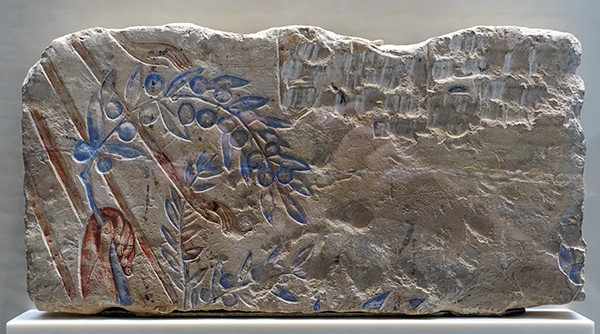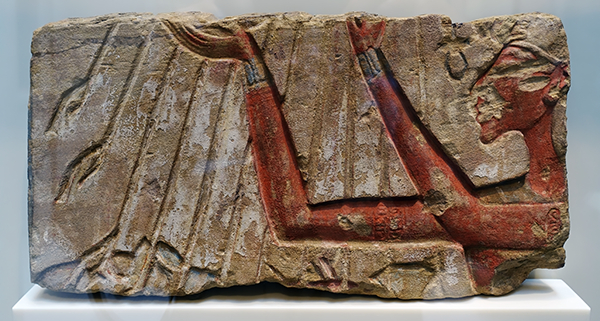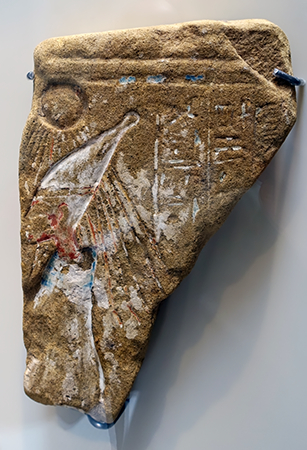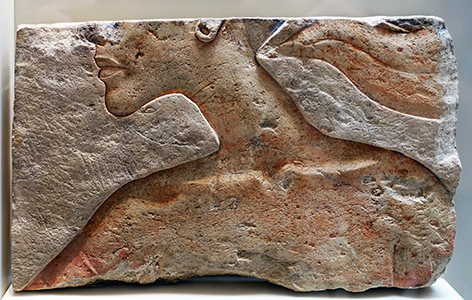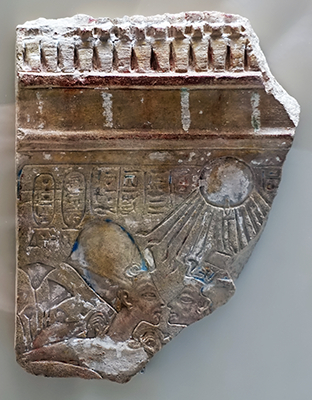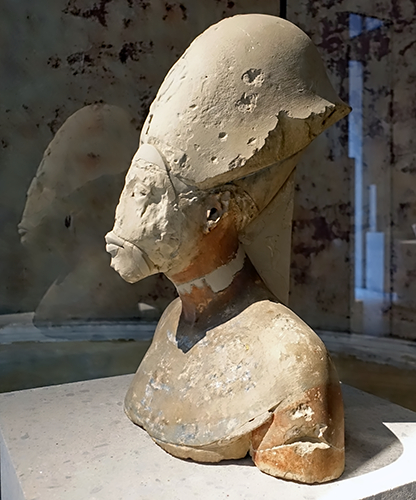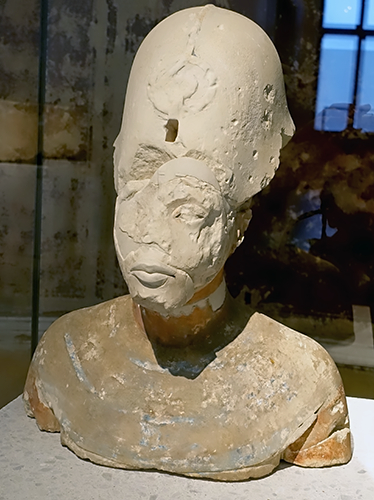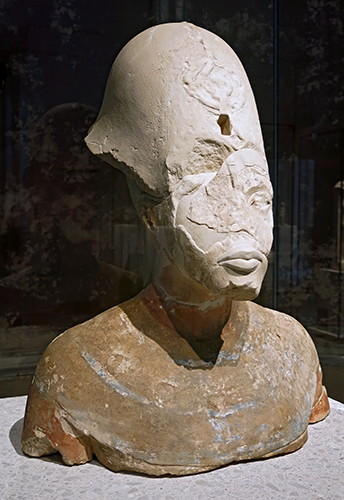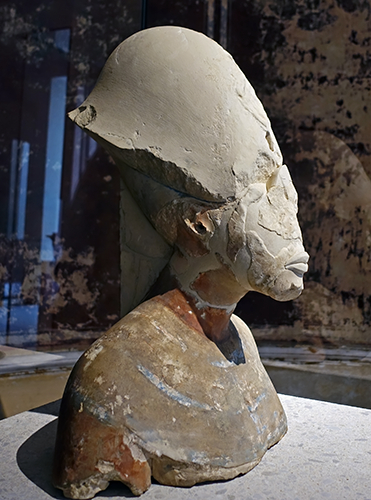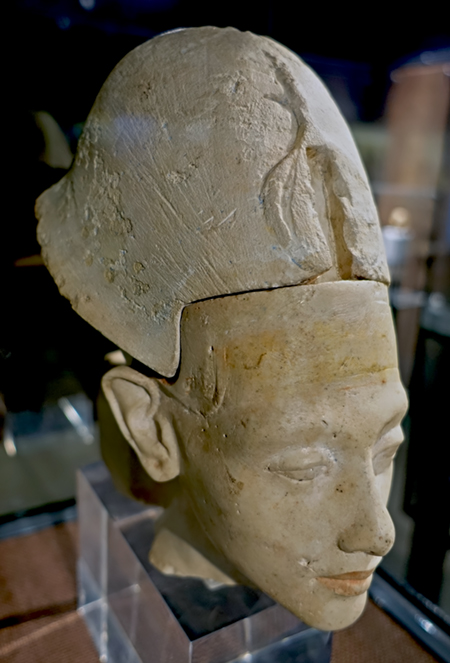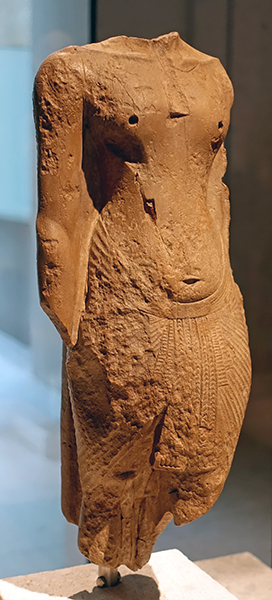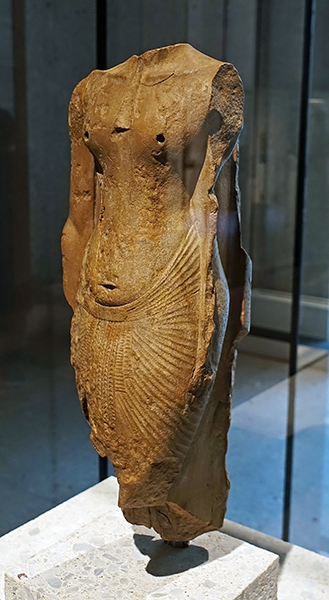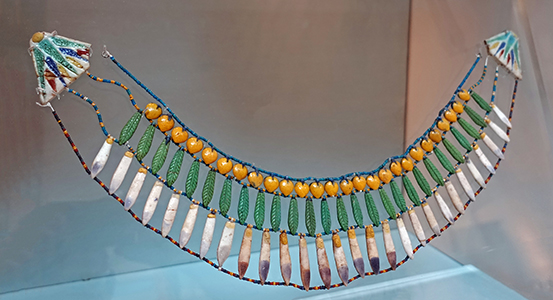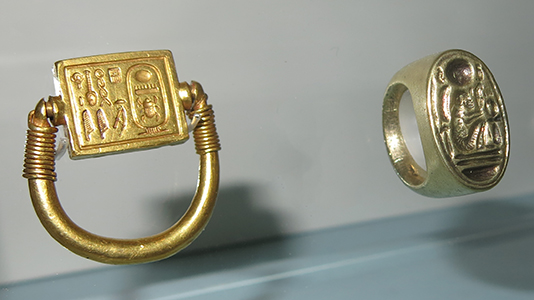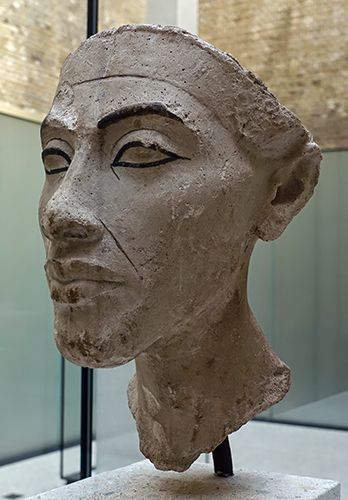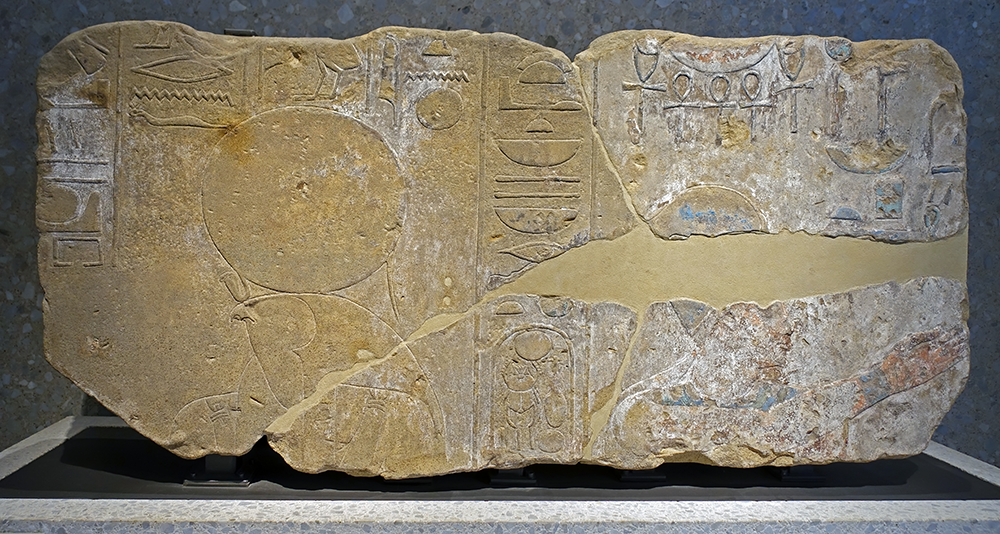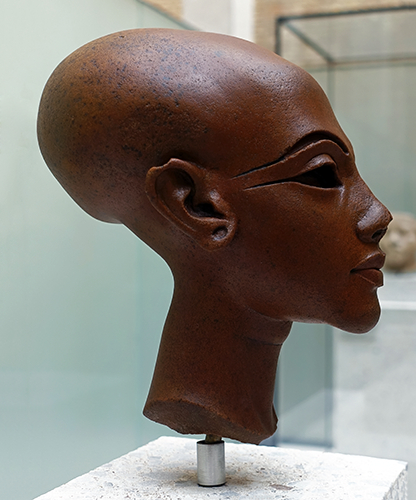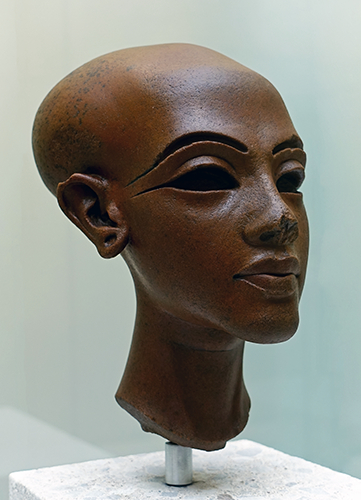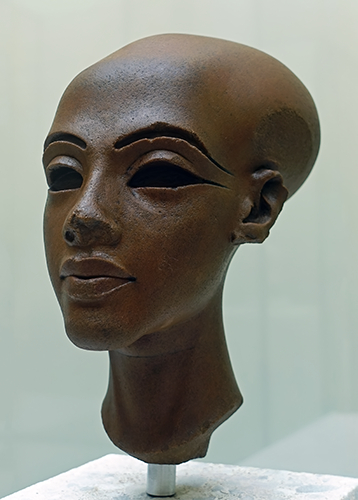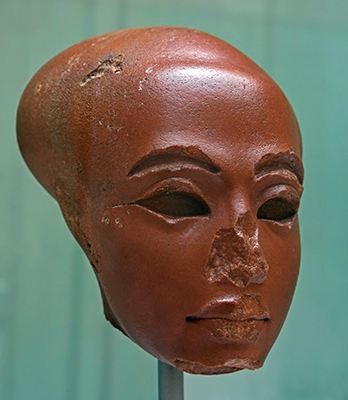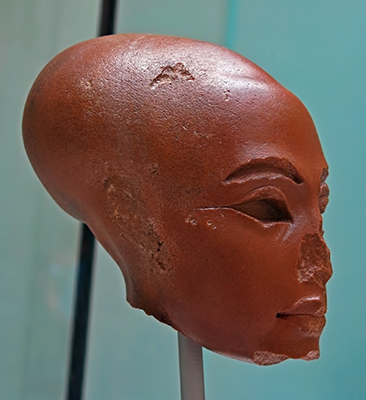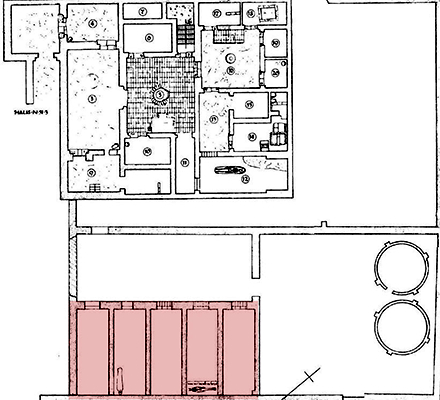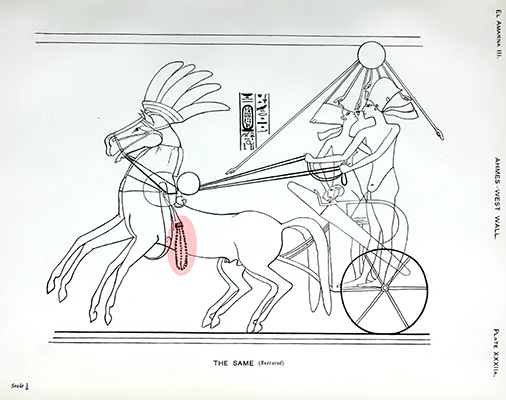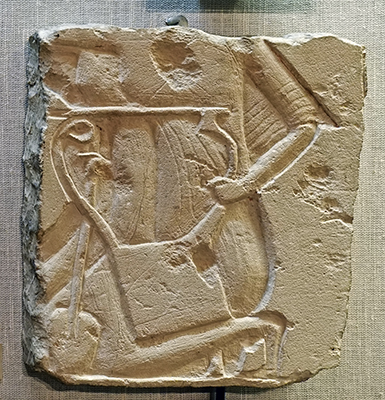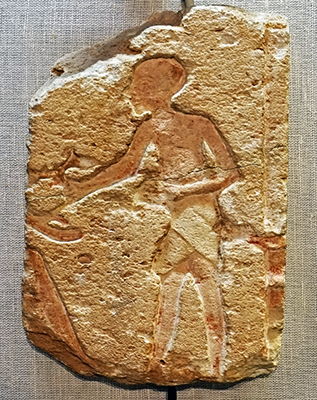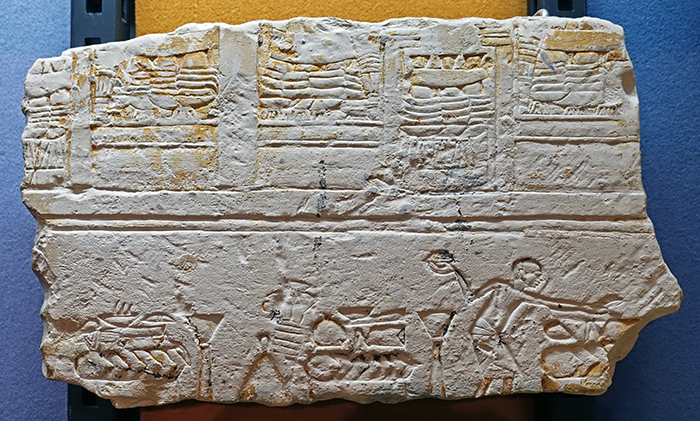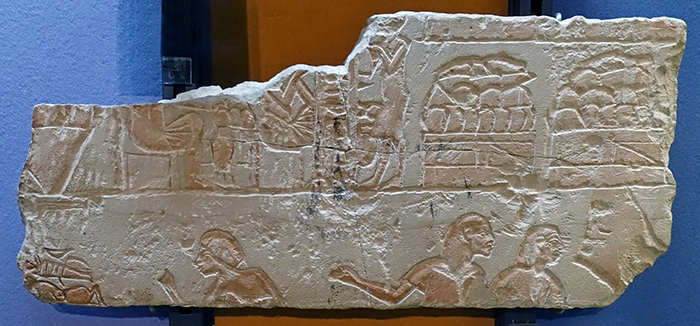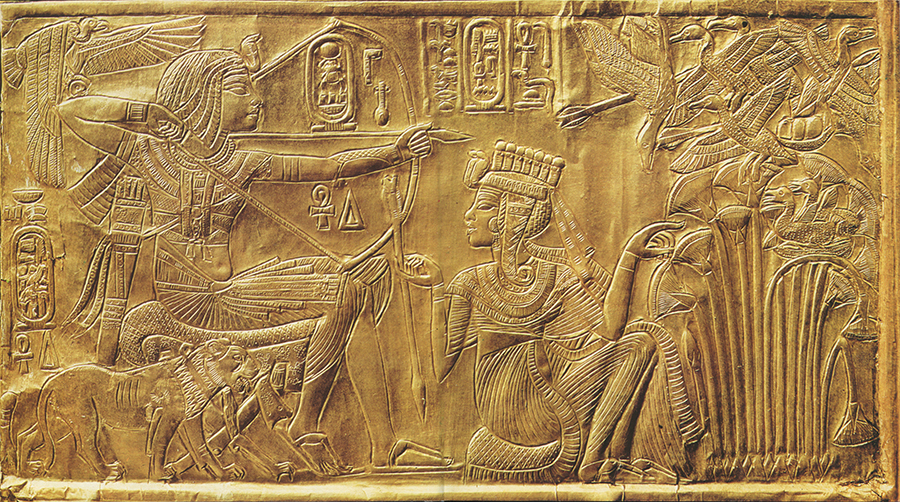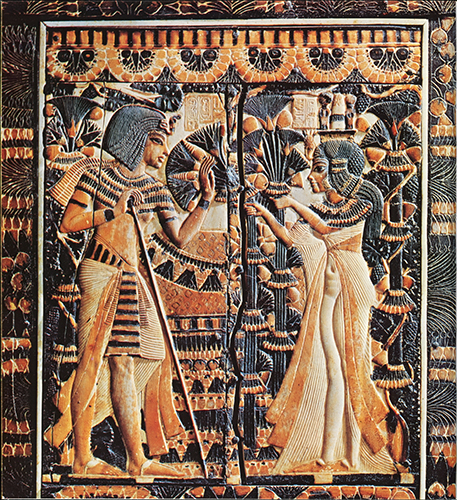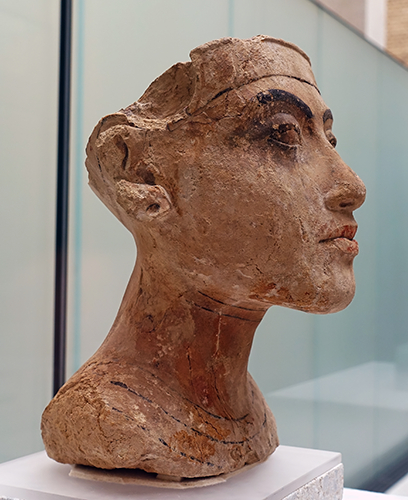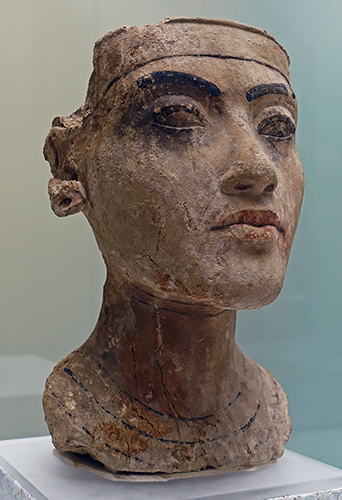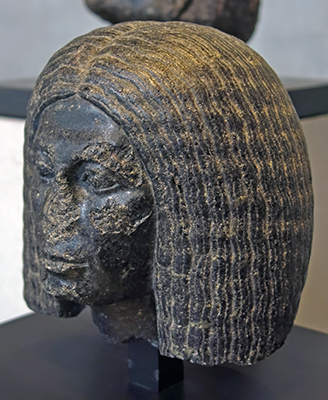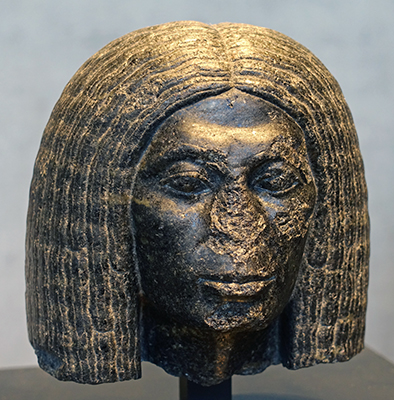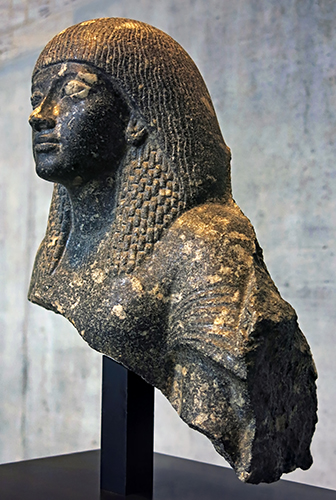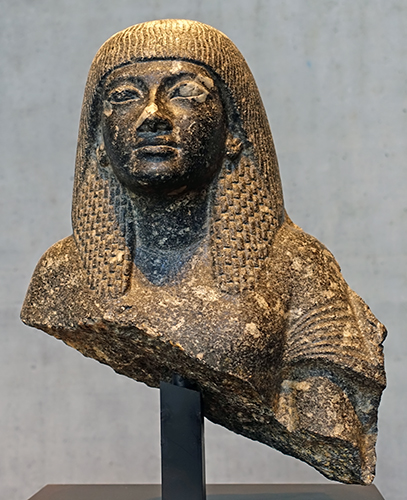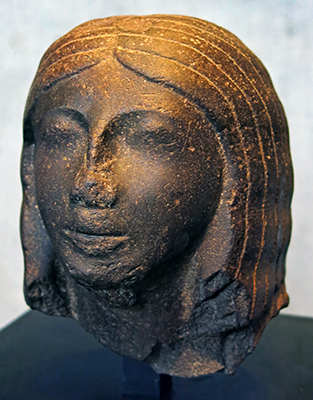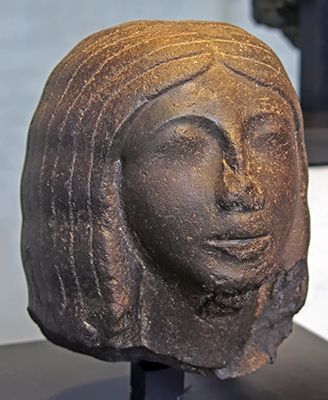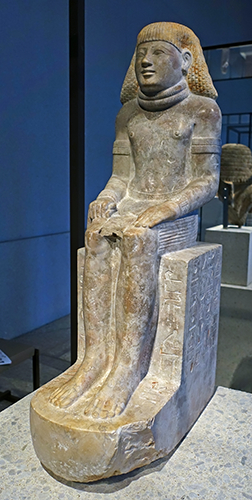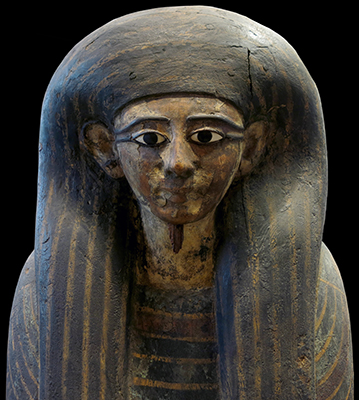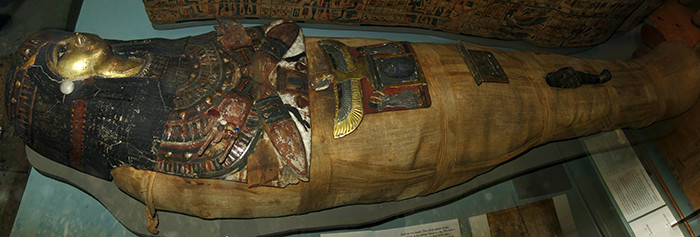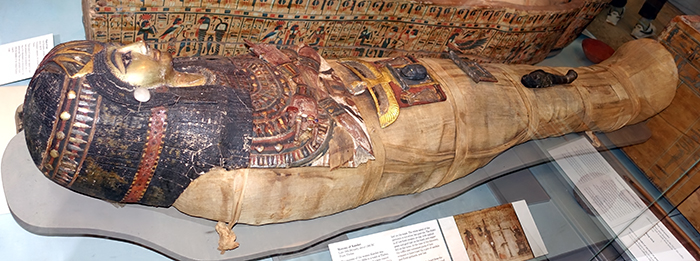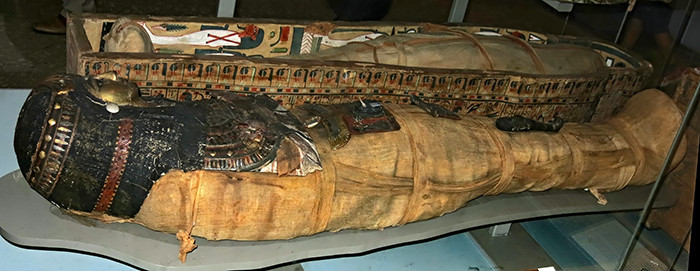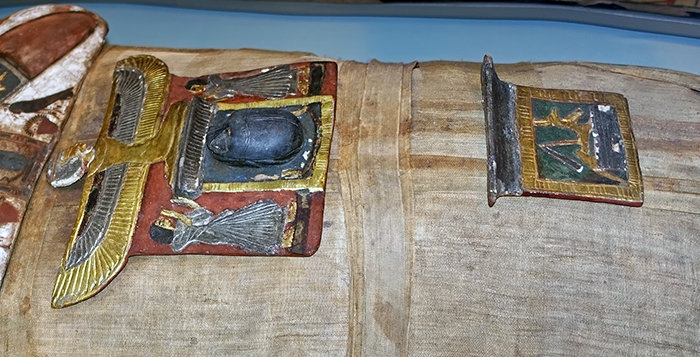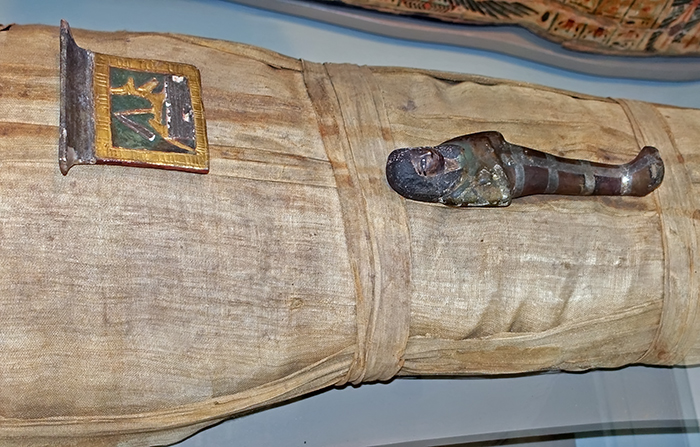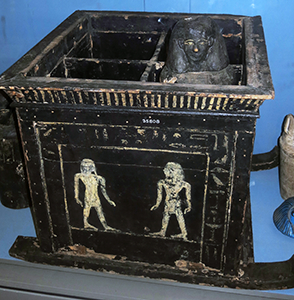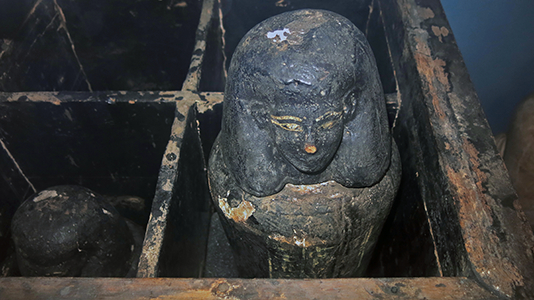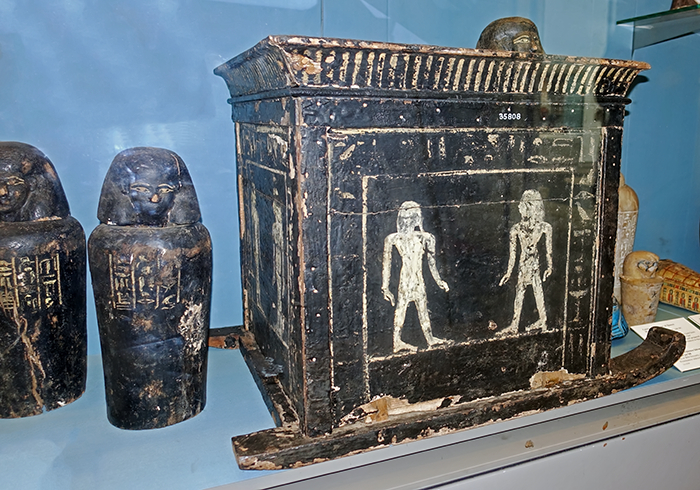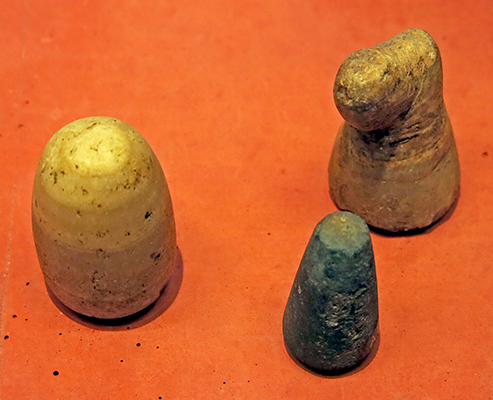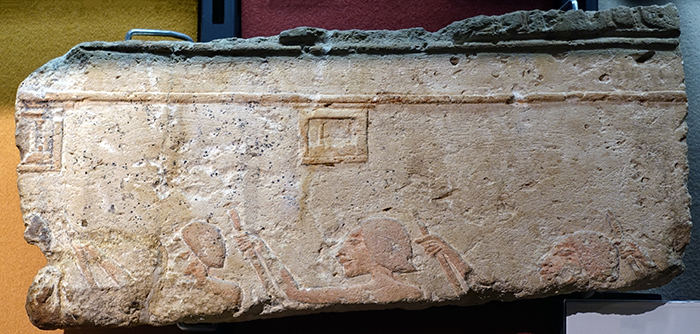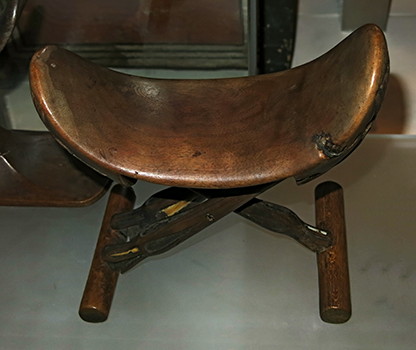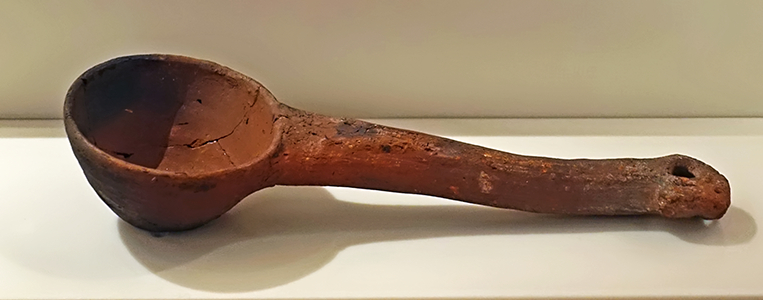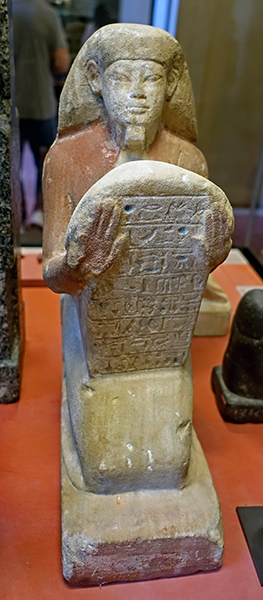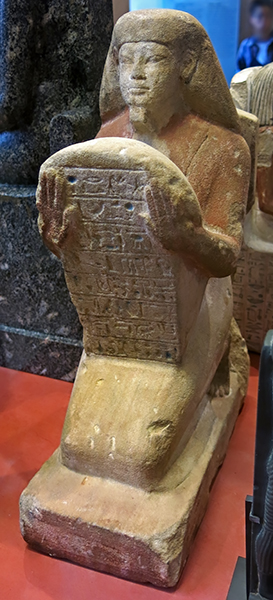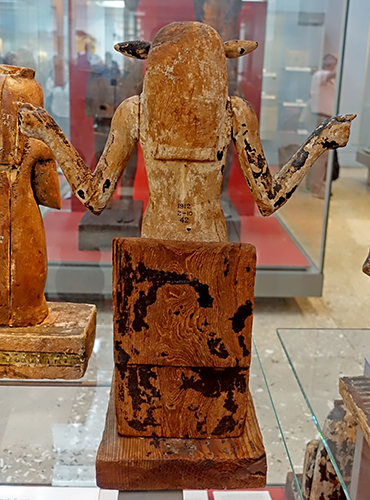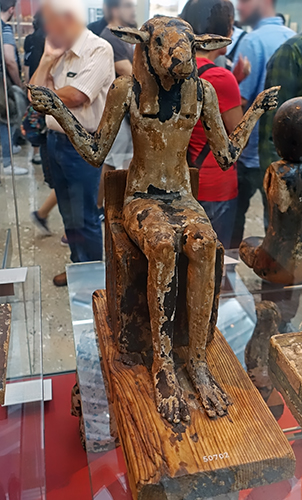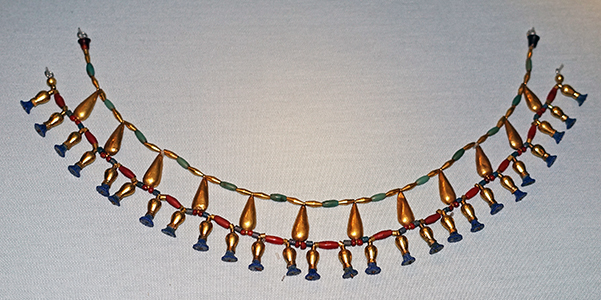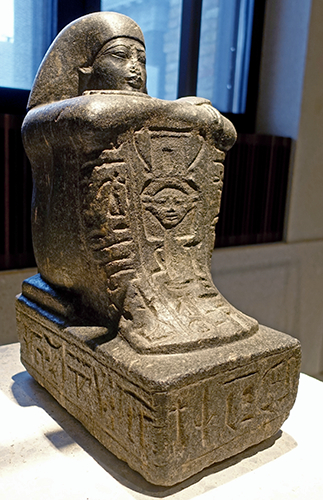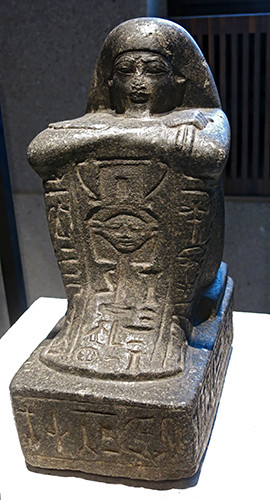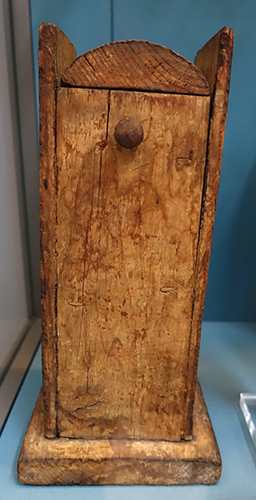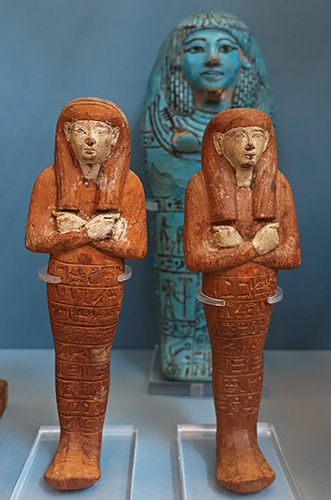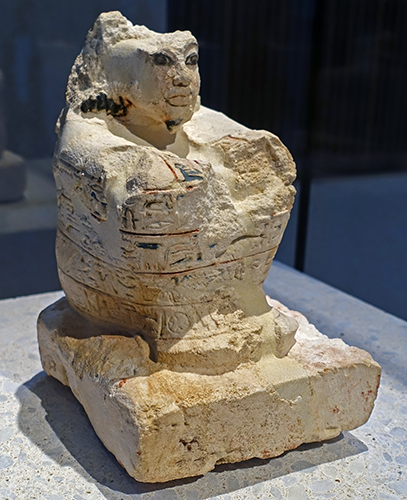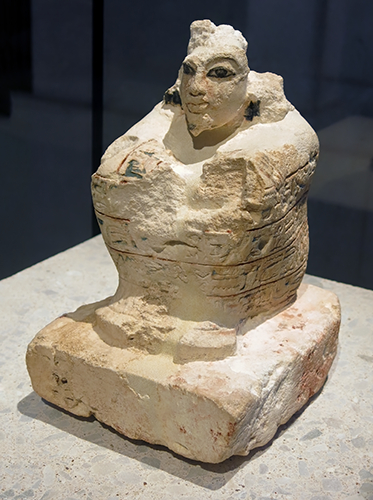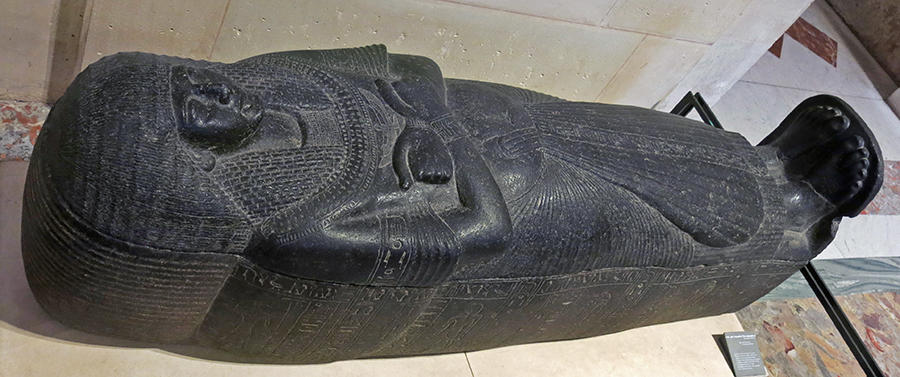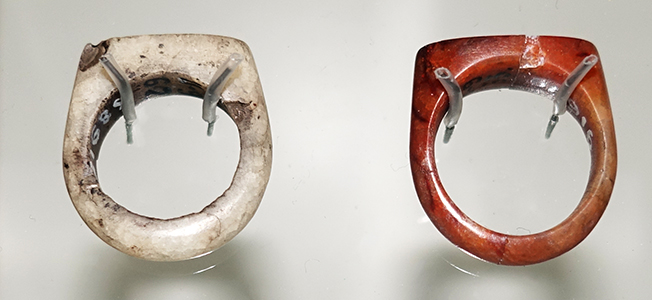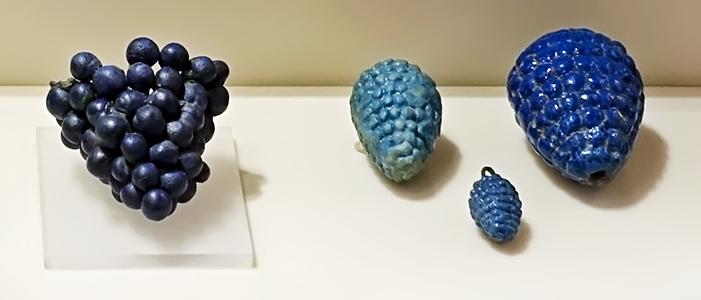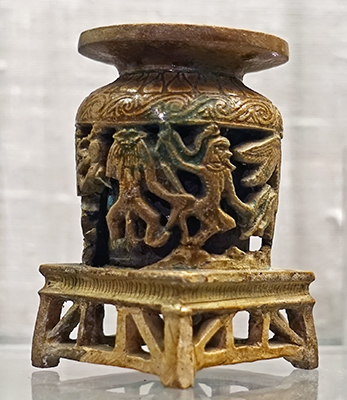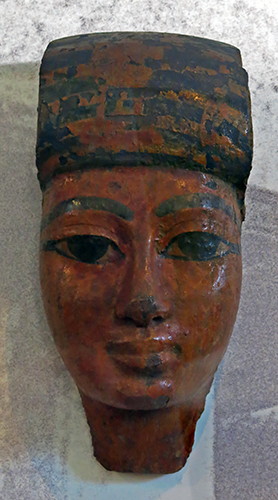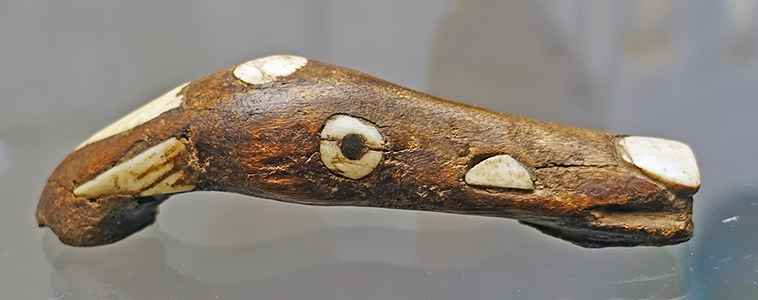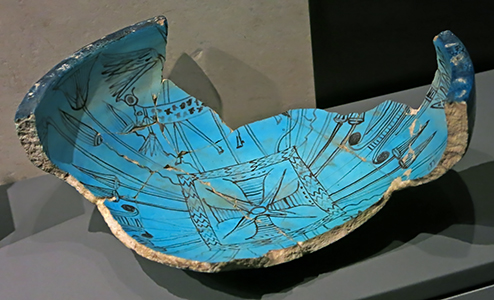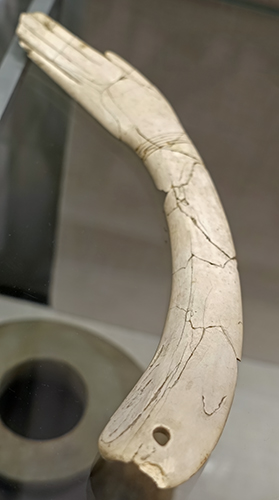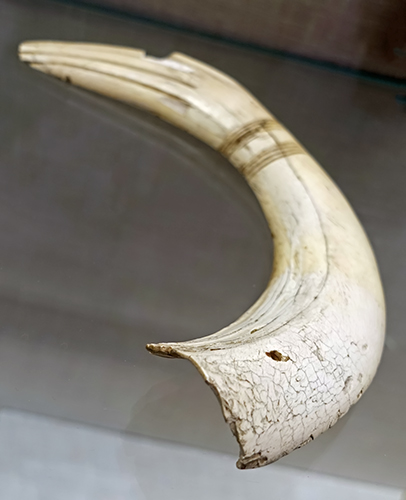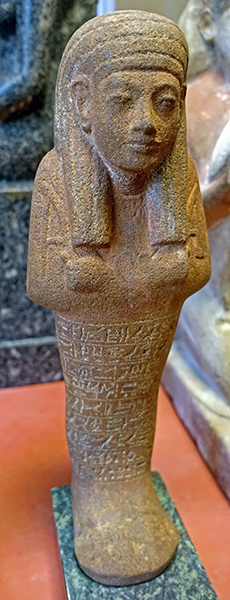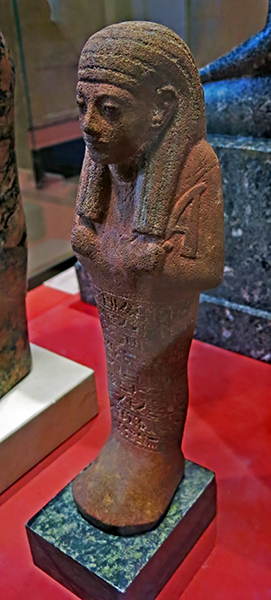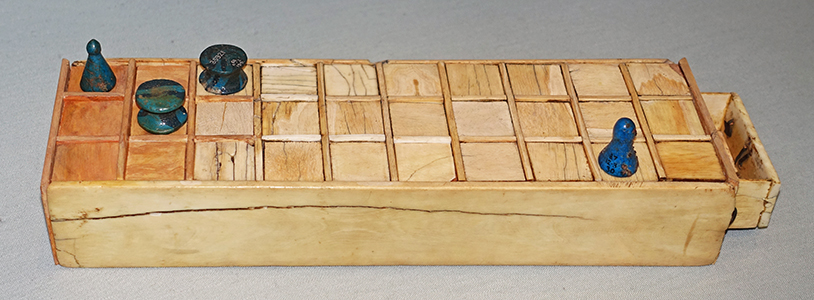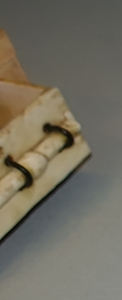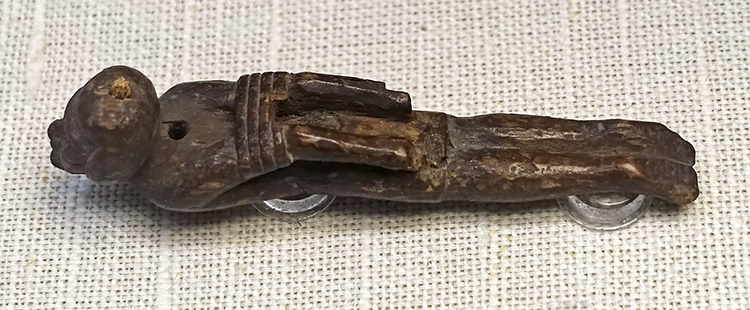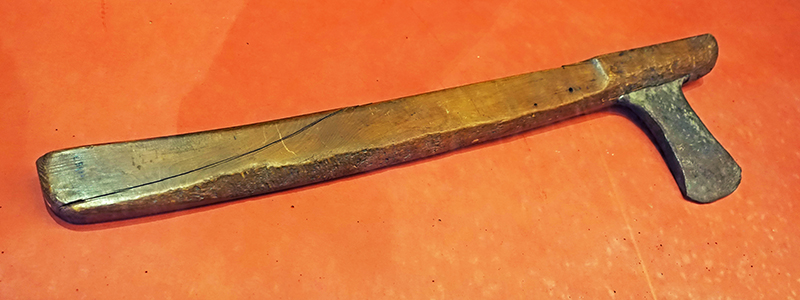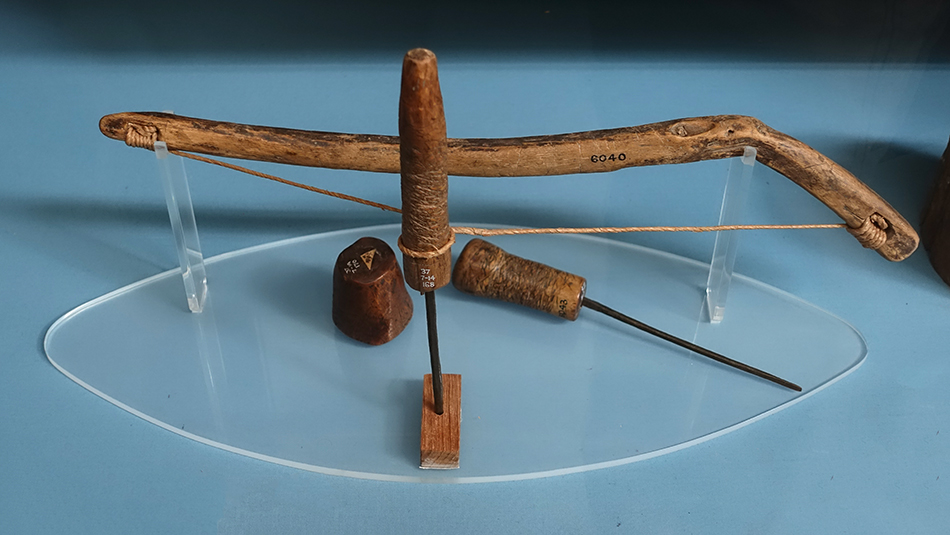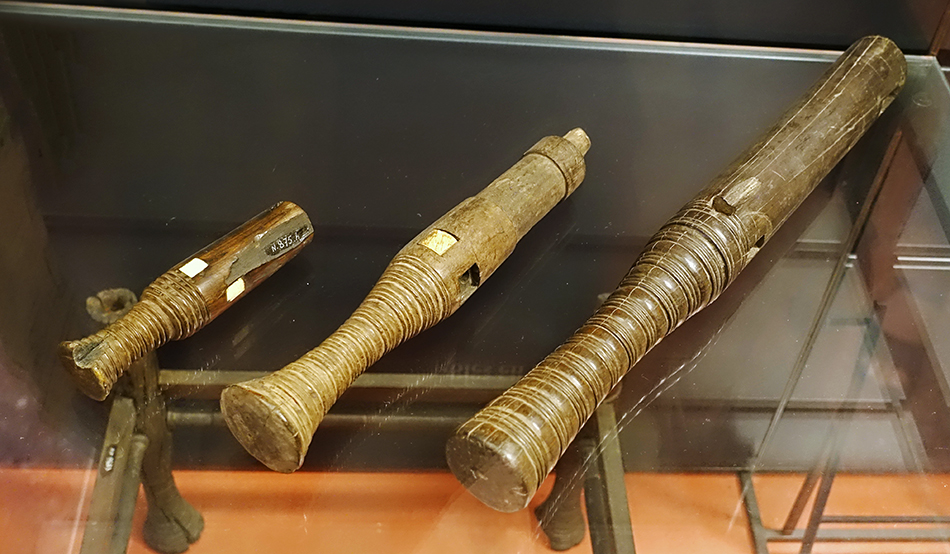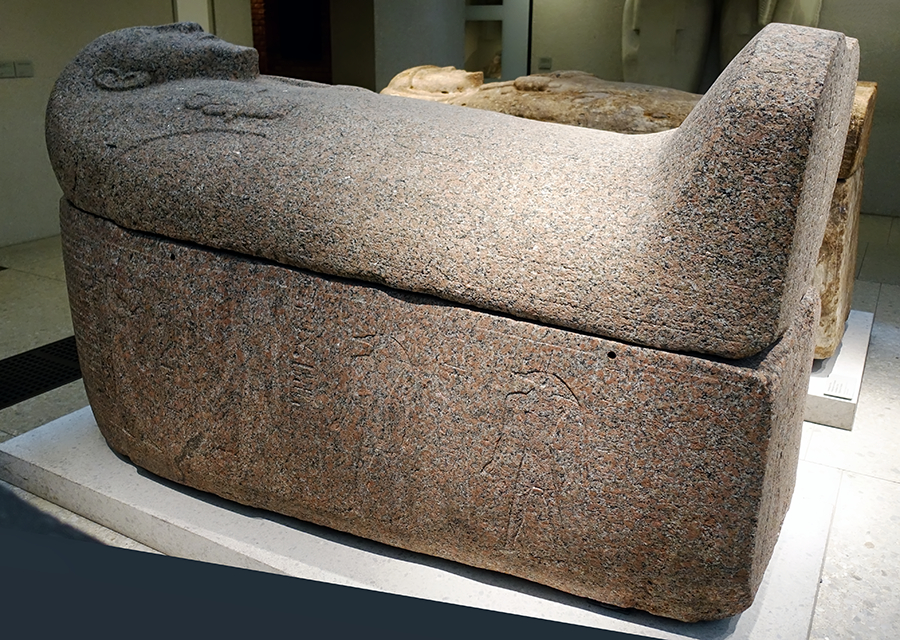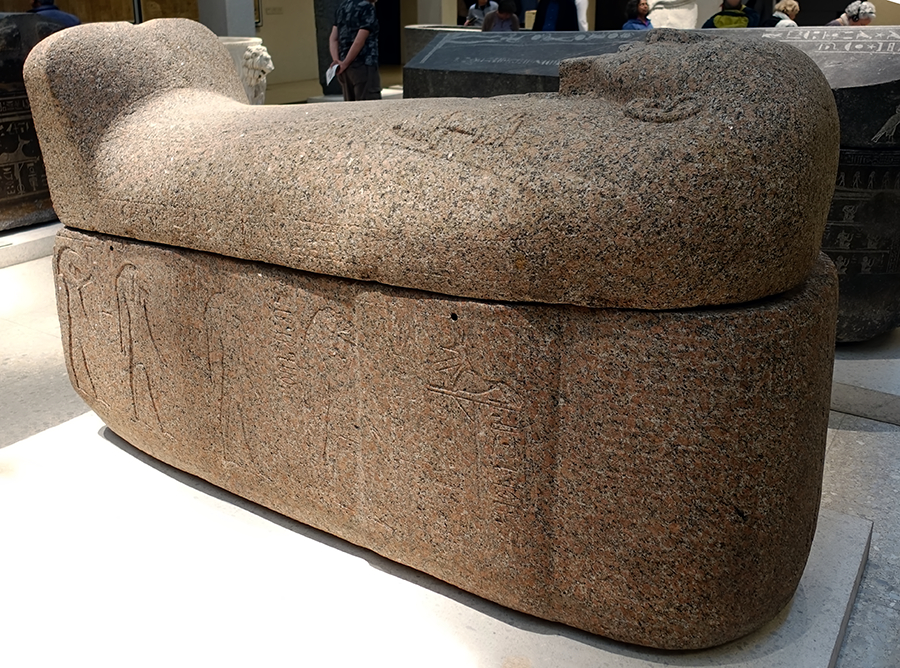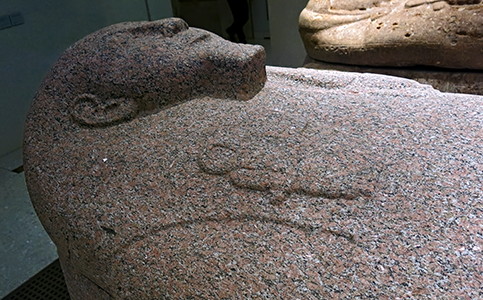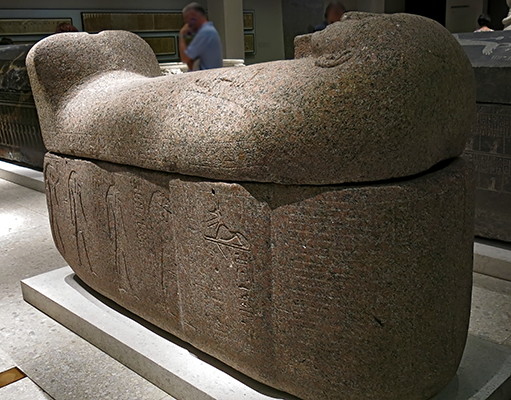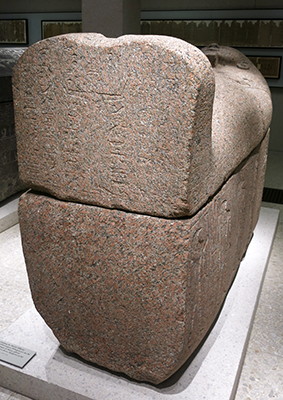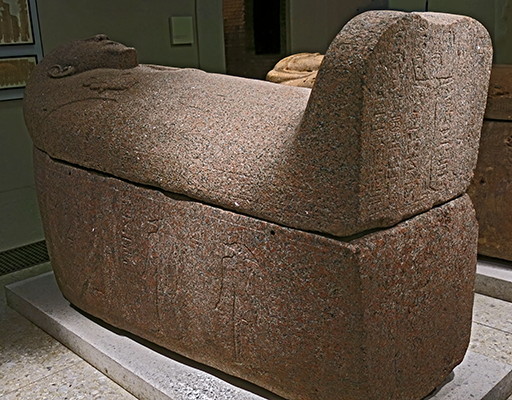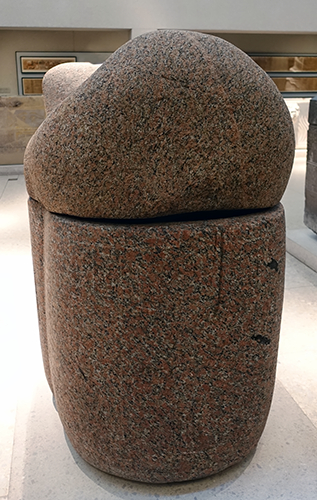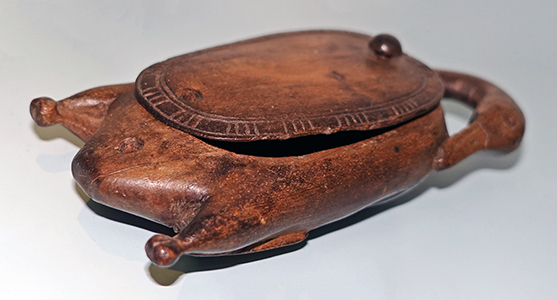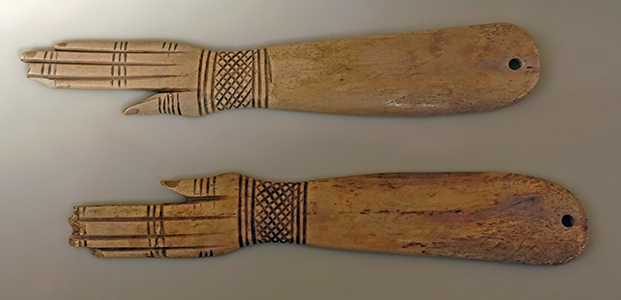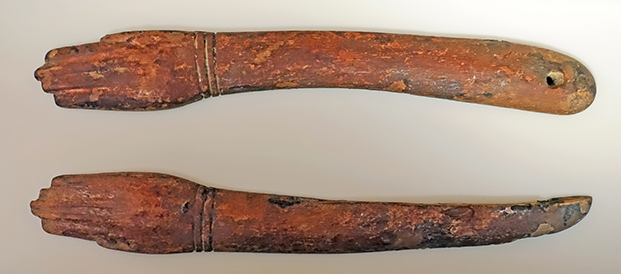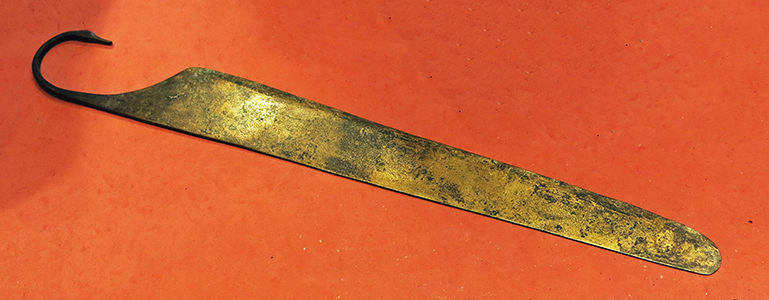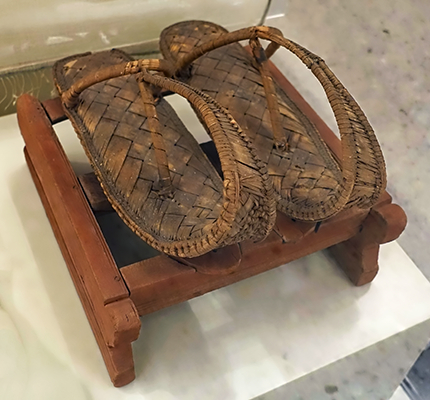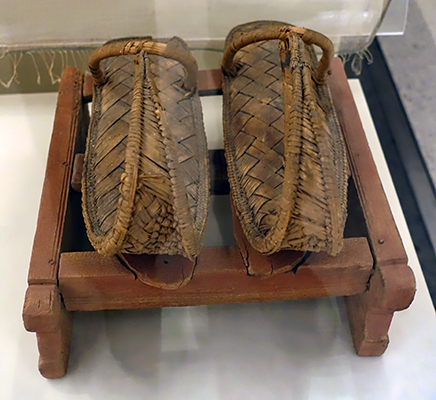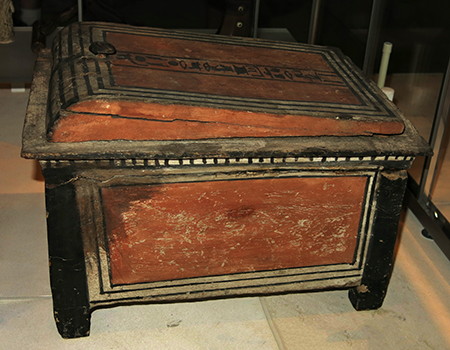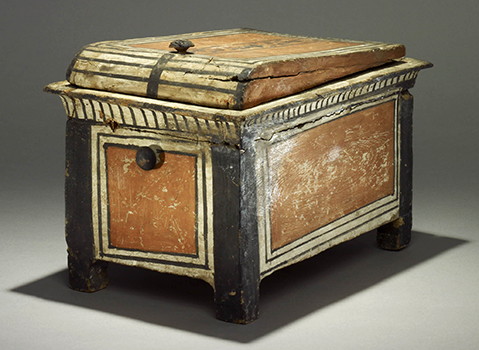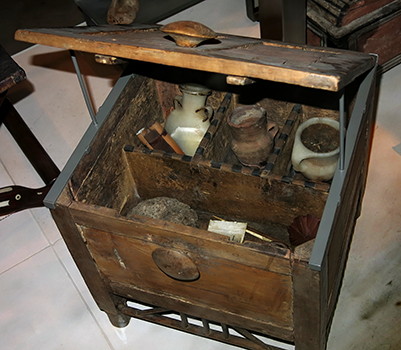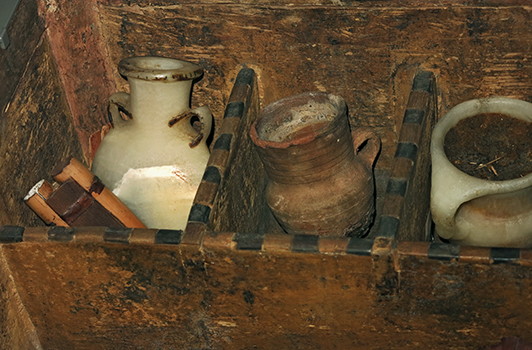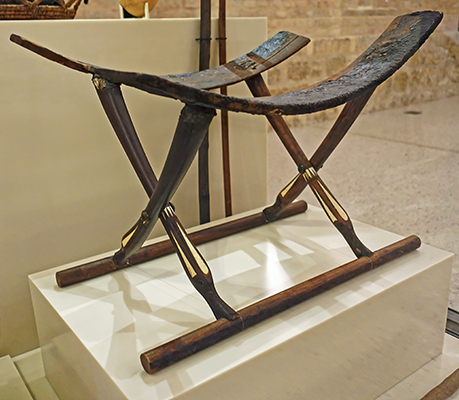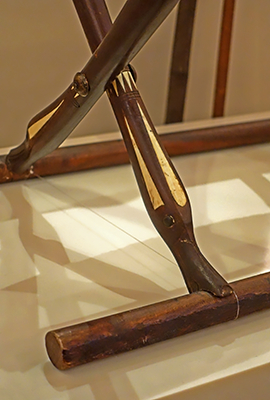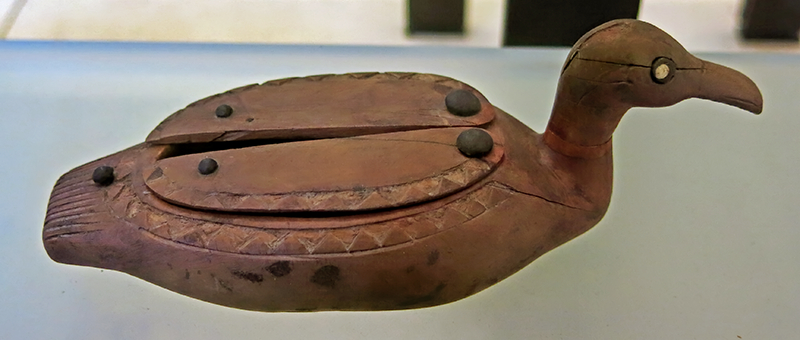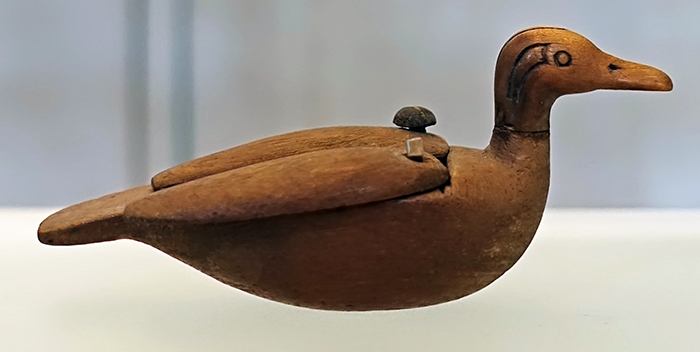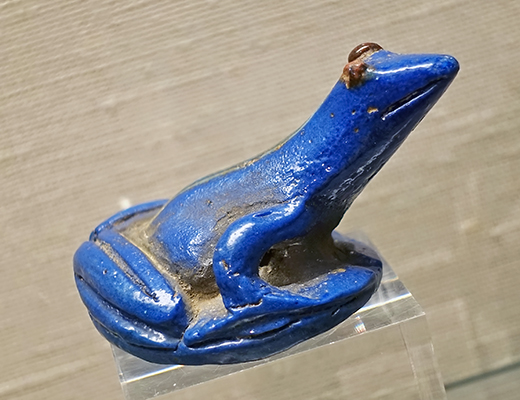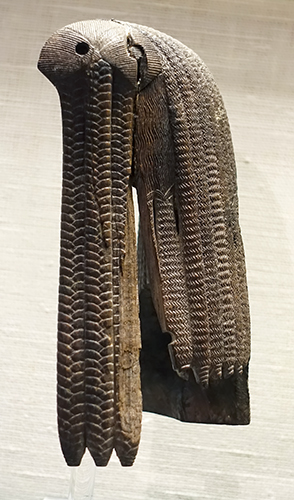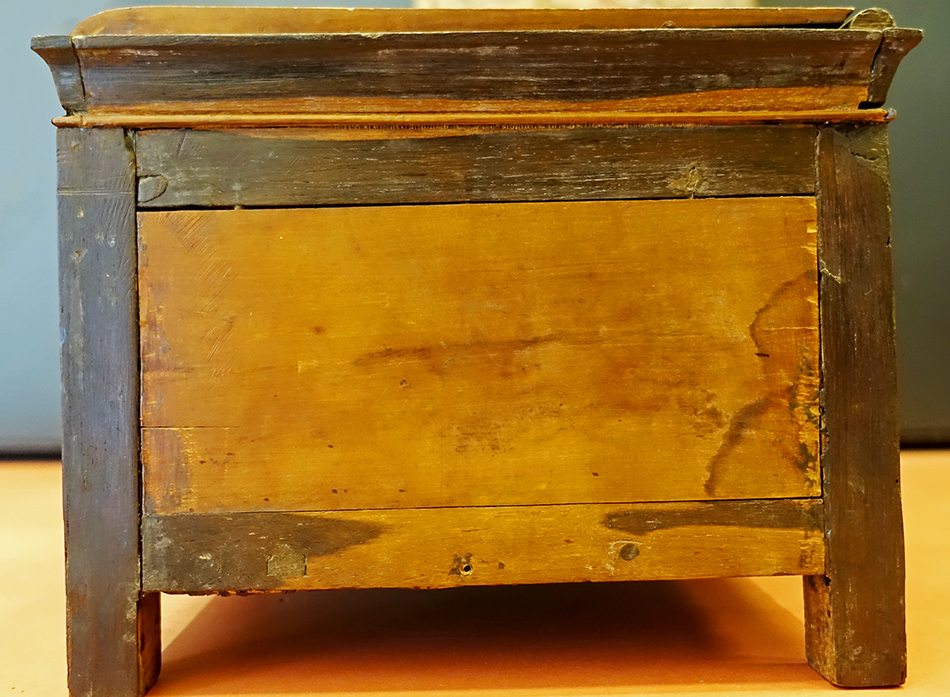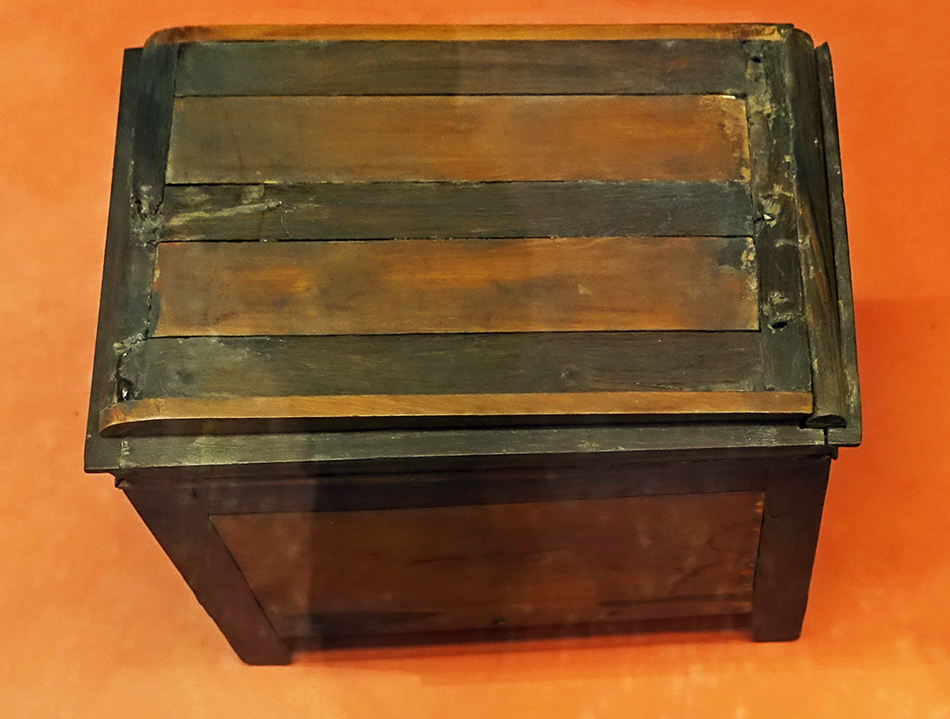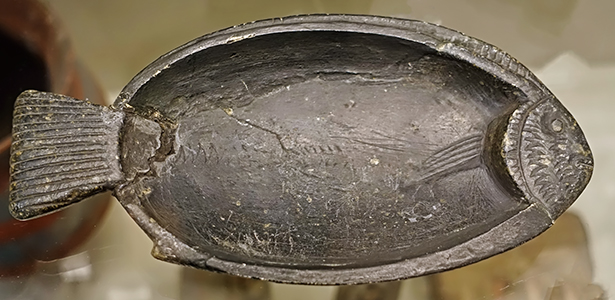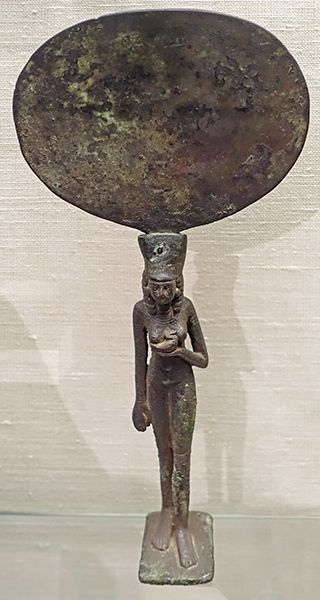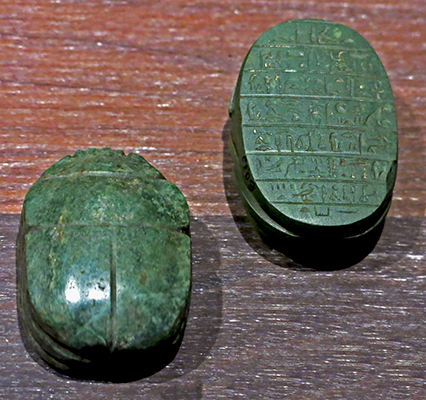Back to Don's Maps
 Back to Archaeological Sites
Back to Archaeological Sites
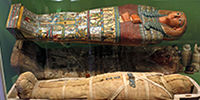 Back to Egypt Index Page
Back to Egypt Index Page
Ancient Egyptian culture during the 18th Dynasty
Egyptian Chronology
| Egyptian Chronology | ||
|---|---|---|
| Date | Culture | Duration |
| 11 000 BC | Jebel Sahaba | |
| Before 8 000 BC - Palaeolithic in Europe and Northern Asia | ||
| 8 000 BC - Nominal end of the Ice Age | ||
| 8 600 - 4 400 BC | Nabta Playa Neolithic | 4 200 years |
| 6 100 - 5 180 BC | Qarunian (formerly known as Fayum B) | 920 years |
| 5 200 - 4 200 BC | Fayum A | 1 000 years |
| 4 800 - 4 200 BC | Merimde | 600 years |
| 4 600 - 4 400 BC | El Omari | 200 years |
| 4 400 - 4 000 BC | Badarian | 400 years |
| 4 000 - 3 300 BC | Maadi | 700 years |
| 3 900 - 3 650 BC | Naqada I | 250 years |
| 3 650 - 3 300 BC | Naqada II | 350 years |
| 3 300 - 2 900 BC | Naqada III | 400 years |
| 3 100 - 2 670 BC | Early Dynastic | 430 years |
| 2 670 - 2 181 BC | Old Kingdom | 489 years |
| 2 181 - 2 025 BC | First Intermediate Period | 156 years |
| 2 025 - 1 700 BC | Middle Kingdom | 325 years |
| 1 700 - 1 550 BC | Second Intermediate Period | 150 years |
| 1 550 - 1 077 BC | New Kingdom | 473 years |
| 1 077 - 664 BC | Third Intermediate Period | 413 years |
| 664 - 332 BC | Late Period | 332 years |
| 525 - 404 BC | First Persian Period | 121 years |
| 404 - 343 BC | Late Dynastic Period | 61 years |
| 343 - 332 BC | Second Persian Period | 11 years |
| 332 - 305 BC | Macedonian Period | 27 years |
| 305 - 30 BC | Ptolemaic Period | 275 years |
| 30 BC - 395 AD | Roman Period | 425 years |
| 395 AD - 640 AD | Byzantine Period | 245 years |
| 640 AD - 1517 AD | Islamic Period | 877 years |
| 1517 AD - 1867 AD | Ottoman Period (French Occupation 1798-1801) |
350 years |
| 1867 AD - 1914 AD | Khedival Period | 47 years |
| 1914 AD - 1922 AD | Sultanate under Hussein Kamel, as a British Protectorate |
8 years |
| 1922 AD - 1953 AD | Monarchy | 31 years |
| 1953 AD - Present Day | Republic | |
| First to Twentieth Dynasties | |||
|---|---|---|---|
| Date | Dynasty | Period | Duration (years) |
| 3 100 - 2 890 BC | First Dynasty | Archaic/Early Dynastic Period | 214 |
| 2 890 - 2 670 BC | Second Dynasty | Archaic/Early Dynastic Period | 220 |
| 2 670 - 2 613 BC | Third Dynasty | Old Kingdom | 57 |
| 2 613 - 2 494 BC | Fourth Dynasty | Old Kingdom - Golden Age | 119 |
| 2 494 - 2 345 BC | Fifth Dynasty | Old Kingdom | 149 |
| 2 345 - 2 181 BC | Sixth Dynasty | Old Kingdom | 164 |
| 2 181 - 2 160 BC | Seventh and Eighth Dynasties | First Intermediate Period | 21 |
| 2 160 - 2 134 BC | Ninth and Tenth Dynasties | First Intermediate Period | 26 |
| 2 134 - 1 991 BC | Eleventh Dynasty | Middle Kingdom | 43 |
| 1 991 - 1 802 BC | Twelfth Dynasty | Middle Kingdom | 189 |
| 1 802 - 1 649 BC | Thirteenth Dynasty From Memphis, over Middle and Upper Egypt |
Middle Kingdom | 153 |
| 1 805 - 1 650 BC | Fourteenth Dynasty From Avaris, Nile Delta, over Lower Egypt |
Second Intermediate Period | 155 |
| 1 650 - 1 550 BC | Fifteenth Dynasty First Hyksos dynasty, ruled from Avaris, without control of the entire land |
Second Intermediate Period | 100 |
| 1 649 - 1 582 BC | Sixteenth Dynasty Ruled the Theban region in Upper Egypt The Hyksos ruled the delta The Kingdom of Kush ruled Upper Egypt |
Second Intermediate Period | 67 |
| 1 580 - 1 550 BC | Seventeenth Dynasty Ruled Thebes, Hyksos ruled the delta |
Second Intermediate Period / New Kingdom | 30 |
| 1 543 - 1 292 BC | Eighteenth Dynasty Egypt reaches the peak of its power |
New Kingdom | 251 |
| 1 292 - 1 187 BC | Nineteenth Dynasty Conquests in Canaan |
New Kingdom | 105 |
| 1 187 - 1 077 BC | Twentieth Dynasty | End of the New Kingdom | 110 |

Timeline for early Egypt, from 11 000 BC to 2 500 BC.
Photo: Poster, British Museum © Trustees of the British Museum, CC BY-NC-SA 4.0
Rephotography: Don Hitchcock 2015
The Eighteenth Dynasty
1 550 BC - 1 292 BC
The eighteenth dynasty of ancient Egypt (Dynasty XVIII) is the best known ancient Egyptian dynasty. It boasts several of Egypt's most famous pharaohs, including Tutankhamun, whose tomb was found by Howard Carter in 1922. The dynasty is also known as the Thutmosid Dynasty for the four pharaohs named Thutmose (English: Thoth bore him).
Famous pharaohs of Dynasty XVIII include Hatshepsut (circa 1 479 BC - 1 458 BC), longest-reigning woman-pharaoh of an indigenous dynasty, and Akhenaten (circa 1 353 BC - 1 336 BC), the 'heretic pharaoh', with his queen, Nefertiti.
Dynasty XVIII is the first of the three dynasties of the Egyptian New Kingdom, the period in which ancient Egypt reached the peak of its power.
| Eighteenth Dynasty | ||||||
|---|---|---|---|---|---|---|
| Name | Horus (Throne) Name | Consort | Burial | Years | Dates | Comments |
| Ahmose II (Amasis I, Ahmose I, Ahmose) |
Nebpehtire | Ahmose-Nefertari Ahmose-Henuttamehu Ahmose-Sitkamose |
25 | 1 550 BC - 1 525 BC | The warrior king Ahmose, founder of the Eighteenth Dynasty, vanquished the foreign Hyksos rulers, reunited Egypt, and initiated the New Kingdom. Sometimes known as Ahmose I, he is also known as Ahmose II, because there had been a Pharaoh Ahmose in the 17th Dynasty | |
| Amenhotep I | Djeserkare | Ahmose-Meritamon | KV39? or Tomb ANB? | 22 | 1 525 BC - 1 503 BC | |
| Thutmose I | Akheperkare | Ahmose Mutnofret |
KV20, KV38 | 10 | 1 503 BC - 1 493 BC | |
| Thutmose II | Akheperenre | Hatshepsut Iset |
KV42? | 14 | 1 493 BC - 1 479 BC | |
| Queen Hatshepsut | Maatkare | Thutmose II | KV20 | 21 | 1 479 BC - 1 458 BC | Hatshepsut ruled jointly with Thutmose III, who had ascended to the throne the previous year as a child of about two years old. Hatshepsut was the chief wife of Thutmose II, Thutmose III's father, though his mother was a member of the harem. |
| Thutmose III | Menkheper(en)re | Satiah Merytre-Hatshepsut Nebtu Menhet, Menwi and Merti |
KV34 | 54 | 1 479 BC - 1 425 BC | |
| Amenhotep II | Akheperure | Tiaa | KV35 | 27 | 1 425 BC - 1 398 BC | |
| Thutmose IV | Menkheperure | Nefertari Iaret Mutemwiya Daughter of Artatama I of Mitanni |
KV43 | 10 | 1 398 BC - 1 388 BC | |
| Amenhotep III | Nebmaatre | Tiye Gilukhipa of Mitanni Tadukhipa of Mitanni Sitamun Iset Daughter of KurigalzuI I of Babylon Daughter of Kadashman-Enlil of Babylon Daughter of Tarhundaradu of Arzawa Daughter of the ruler of Ammia |
KV22 | 38 | 1 388 BC - 1 350 BC | Amenhotep's father, Thutmose IV / Tuthmosis IV, left his son an empire of immense size, wealth, and power. He was only twelve years old when he came to the throne and married Tiye in a royal ceremony. He was a master of diplomacy, who placed other nations in his debt through lavish gifts of gold so that they would be inclined to bend to his wishes, which they invariably did. |
| Amenhotep IV/ Akhenaten |
Neferkepherure-Waenre | Nefertiti Kiya Tadukhipa of Mitanni Daughter of Šatiya, ruler of Enišasi Meritaten? Meketaten? Ankhesenamun Daughter of Burna-Buriash II, King of Babylon |
Royal Tomb of Akhenaten |
17 | 1 351 BC - 1 334 BC | |
| Smenkhkare | Ankhkheperure | Meritaten | 1 | 1 335 BC - 1 334 BC | ||
| Neferneferuaten | Ankhkheperure | Akhenaten? Smenkhkare? |
2 | 1 334 BC - 1 332 BC | ||
| Tutankhamun | Nebkheperure | Ankhesenamun | KV62 | 9 | 1 332 BC - 1 323 BC | |
| Ay | Kheperkheperure | Ankhesenamun Tey |
KV23 | 4 | 1 323 BC - 1 319 BC | |
| Horemheb | Djeserkheperure-Setepenre | Mutnedjmet Amenia |
KV57 | 27 | 1 319 BC - 1 292 BC | |
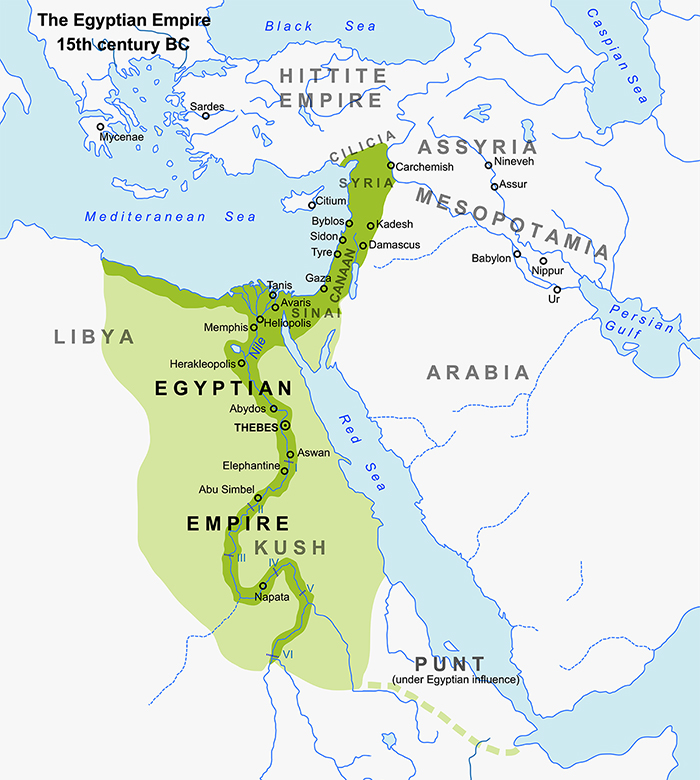
The maximum extent of the New Kingdom during the Eighteenth, Nineteenth, and Twentieth dynasties of Egypt.
Photo: Andrei Nacu, Jeff Dahl
Permission: Creative Commons Attribution-Share Alike 3.0 Unported license.
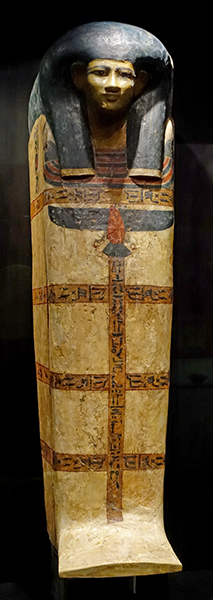
Eighteenth Dynasty: 1 500 BC - 1 292 BC
Coffin
Coffin with the image of the goddess Isis on the bottom, circa 1 500 BC .
Catalog: Wood, stucco, West Thebes, ÄS 1329
Photo: Don Hitchcock 2018
Source: Original, Ägyptischen Museum München
Text: Museum card, © Ägyptischen Museum München
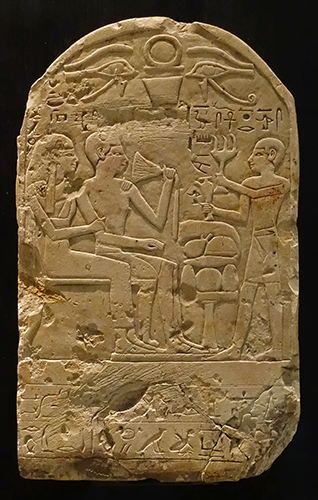
Eighteenth Dynasty: 1 550 BC - 1 292 BC
Tjatya
Stela of Tjatya and her husband.
( In the main register Tjatya and her husband are seated at the Burial Feast, attended by a servant. Above is a double Wedjat eye, and the Shen symbol of eternity and divine protection - Don )
Catalog: Limestone, ÄS 44
Photo: Don Hitchcock 2018
Source: Original, Ägyptischen Museum München
Text: Museum card, © Ägyptischen Museum München
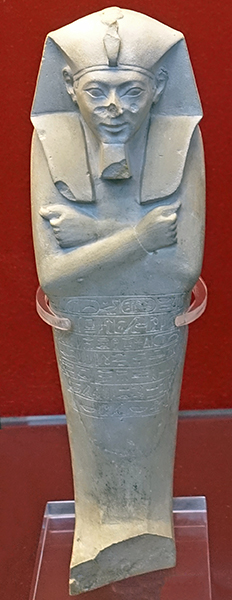
Eighteenth Dynasty: 1 550 BC - 1 292 BC
Ahmose I (Ahmose II)
Limestone shabti of King Ahmose: the features on this small face hark back to royal Theban sculpture of the early Middle Kingdom. Its face is tapered, and the eyebrows and upper contours of the eyes are strongly arched. There are seven rows of incised hieroglyphic text at waist-level. The foot of this shabti is damaged.
Circa 1 550 BC - 1 525 BC
Dimensions: Height 289 mm, width 82 mm, depth 65 mm.
Incised in seven lines at the waist, an inscription gives Ahmose's names in cartouches, followed by the 'shabti spell', Spell 6 in the 'Book of the Dead'.
This shabti is an important historical document in its own right, for it is one of only three surviving representations of the warrior king Ahmose, founder of the Eighteenth Dynasty, who vanquished the foreign Hyksos rulers, reunited Egypt, and initiated the New Kingdom. Presumably this figure comes from his tomb, which is believed to have been at Thebes, but which has not been located. This is also the oldest known royal shabti.
Catalog: Limestone, Thebes, EA32191
Photo: Don Hitchcock 2018
Source: Original, British Museum
Text: Card at the British Museum, http://www.britishmuseum.org/, © Trustees of the British Museum, CC BY-NC-SA 4.0
Eighteenth Dynasty: 1 550 BC - 1 292 BC
Medical text
Medical text written on papyrus.
Partial translation:
'Another perfect remedy: galena, a measure; honey, a measure; fat ... fruit - péret chény (?); peas; dry frankincese. Make a bandage with this, four days in a row.
Translation after T. Bardinet.
Height: 162 mm, length 378 mm.
Catalog: Papyrus, Black/red text, E 4864
Photo: Don Hitchcock 2015
Source and text: Original, Louvre Museum, https://collections.louvre.fr/
Eighteenth Dynasty: 1 550 BC - 1 292 BC
Schoolboy's tablet
Schoolboy's tablet: a 'satire of trades', circa 1 550 BC - 1 425 BC
An important extract from the 'Hymn to the Nile' and the 'Satire of the Trades', both classics of Egyptian students. The text, written in black, is punctuated and dated in red. The student took 18 days to copy it. Here are the descriptions of the trades of mat maker, and arrow maker:
'The mat maker in the workshop is more miserable than a woman, he has no money, he is beaten with 50 lashes, he has to give food to the doorman to let him go out in the daylight.
The arrow-maker, in a really terrible situation, goes into the desert. What he has to give to his ass to eat exceeds the work she provides and he has to give a lot to the inhabitants of the marshes who guide him when he is in Egypt. He returns home, dejected, after his journey has broken him. His home is only cloth and bricks, he cannot relax. '
Hieratic writing, on the front and the back. Text in black, dates in red.
The Hieratic script was derived from hieroglyphic writing, but its cursive form was more suited to writing with a reed pen on papyrus, or in this case wood and canvas.
Length 520 mm, width 205 mm, thickness 10 mm.
Catalog: Stuccoed wood and canvas, Black/red text, E 8, N 693
Photo: Don Hitchcock 2015
Source and text: Original, Louvre Museum, https://collections.louvre.fr/
The Satire of the Trades
This didactic text, also called The Satire of the Trades dates from the Middle Kingdom. Whether it was intended to be a humorous description of crafts or just a dry schoolmaster's copying exercise for budding officials, it depicts working life quite realistically: mostly hard and often boring drudgery.
( The source for the 'satire of the trades' below appears to be listed as pSallier II, part of what is called the Sallier papyri, often mentioned, but never defined, a bit like the land of Punt - Don )
The Instruction of Dua-Khety
The Satire of the Trades
The beginning of the teaching which the man of Tjel named Dua-Khety made for his son named Pepy, while he sailed southwards to the Residence to place him in the school of writings among the children of the magistrates, the most eminent men of the Residence.
So he spoke to him: Since I have seen those who have been beaten, it is to writings that you must set your mind. Observe the man who has been carried off to a work force. Behold, there is nothing that surpasses writings! They are a boat upon the water. Read then at the end of the Book of Kemyet this statement in it saying:
As for a scribe in any office in the Residence, he will not suffer want in it. When he fulfills the bidding of another, he does not come forth satisfied. I do not see an office to be compared with it, to which this maxim could relate. I shall make you love books more than your mother, and I shall place their excellence before you. It is greater than any office. There is nothing like it on earth. When he began to become sturdy but was still a child, he was greeted (respectfully). When he was sent to carry out a task, before he returned he was dressed in adult garments. -
I do not see a stoneworker on an important errand or a goldsmith in a place to which he has been sent, but I have seen a coppersmith at his work at the door of his furnace. His fingers were like the claws of the crocodile, and he stank more than fish excrement.
Every carpenter who bears the adze is wearier than a fieldhand. His field is his wood, his hoe is the axe. There is no end to his work, and he must labor excessively in his activity. At nighttime he still must light his lamp.
The jeweller pierces stone in stringing beads in all kinds of hard stone. When he has completed the inlaying of the eye-amulets, his strength vanishes and he is tired out. He sits until the arrival of the sun, his knees and his back bent at (the place called) Aku-Re.
The barber shaves until the end of the evening. But he must be up early, crying out, his bowl upon his arm. He takes himself from street to street to seek out someone to shave. He wears out his arms to fill his belly, like bees who eat (only) according to their work.
The reed-cutter goes downstream to the Delta to fetch himself arrows. He must work excessively in his activity. When the gnats sting him and the sand fleas bite him as well, then he is judged. The potter is covered with earth, although his lifetime is still among the living. He burrows in the field more than swine to bake his cooking vessels. His clothes being stiff with mud, his head cloth consists only of rags, so that the air which comes forth from his burning furnace enters his nose. He operates a pestle with his feet with which he himself is pounded, penetrating the courtyard of every house and driving earth into every open place.
I shall also describe to you the bricklayer. His kidneys are painful. When he must be outside in the wind, he lays bricks without a garment. His belt is a cord for his back, a string for his buttocks. His strength has vanished through fatigue and stiffness, kneading all his excrement. He eats bread with his fingers, although he washes himself but once a day.
It is miserable for the carpenter when he planes the roof-beam. It is the roof of a chamber 10 by 6 cubits. A month goes by in laying the beams and spreading the matting. All the work is accomplished. But as for the food which is to be given to his household (while he is away), there is no one who provides for his children.
The vintner carries his shoulder-yoke. Each of his shoulders is burdened with age. A swelling is on his neck, and it festers. He spends the morning in watering leeks and the evening with corianders, after he has spent the midday in the palm grove. So it happens that he sinks down (at last) and dies through his deliveries, more than one of any other profession.
The fieldhand cries out more than the guinea fowl. His voice is louder than the raven's. His fingers have become ulcerous with an excess of stench. When he is taken away to be enrolled in Delta labour, he is in tatters. He suffers when he proceeds to the island, and sickness is his payment. The forced labour then is tripled. If he comes back from the marshes there, he reaches his house worn out, for the forced labor has ruined him.
The weaver inside the weaving house is more wretched than a woman. His knees are drawn up against his belly. He cannot breathe the air. If he wastes a single day without weaving, he is beaten with 50 whip lashes. He has to give food to the doorkeeper to allow him to come out to the daylight.
The arrow maker, completely wretched, goes into the desert. Greater than his own pay is what he has to spend for his she-ass for its work afterwards. Great is also what he has to give to the fieldhand to set him on the right road to the flint source. When he reaches his house in the evening, the journey has ruined him.
The courier goes abroad after handing over his property to his children, being fearful of the lions and the Asiatics. He only knows himself when he is back in Egypt. But his household by then is only a tent. There is no happy homecoming.
The furnace-tender, his fingers are foul, the smell thereof is as corpses. His eyes are inflamed because of the heaviness of smoke. He cannot get rid of his dirt, although he spends the day at the reed pond. Clothes are an abomination to him.
The sandal maker is utterly wretched carrying his tubs of oil. His stores are provided with carcasses, and what he bites is hides.
The washerman launders at the riverbank in the vicinity of the crocodile. I shall go away, father, from the flowing water, said his son and his daughter, to a more satisfactory profession, one more distinguished than any other profession. His food is mixed with filth, and there is no part of him which is clean. He cleans the clothes of a woman in menstruation. He weeps when he spends all day with a beating stick and a stone there. One says to him, dirty laundry, come to me, the brim overflows.
The fowler is utterly weak while searching out for the denizens of the sky. If the flock passes by above him, then he says: would that I might have nets. But God will not let this come to pass for him, for He is opposed to his activity.
I mention for you also the fisherman. He is more miserable than one of any other profession, one who is at his work in a river infested with crocodiles. When the totalling of his account is made for him, then he will lament. One did not tell him that a crocodile was standing there, and fear has now blinded him. When he comes to the flowing water, so he falls as through the might of God.
See, there is no office free from supervisors, except the scribe's. He is the supervisor!
But if you understand writings, then it will be better for you than the professions which I have set before you. Behold the official and the dependent pertaining to him. The tenant farmer of a man cannot say to him: Do not keep watching me. What I have done in journeying southward to the Residence is what I have done through love of you. A day at school is advantageous to you. Seek out its work early, while the workmen I have caused you to know hurry on and cause the recalcitrant to hasten.
I will also tell you another matter to teach you what you should know at the station of your debating. Do not come close to where there is a dispute. If a man reproves you, and you do not know how to oppose his anger, make your reply cautiously in the presence of listeners.
If you walk to the rear of officials, approach from a distance behind the last. If you enter while the master of the house is at home, and his hands are extended to another in front of you, sit with your hand to your mouth. Do not ask for anything in his presence. But do as he says to you. Beware of approaching the table.
Be serious, and great as to your worth. Do not speak secret matters. For he who hides his innermost thoughts is one who makes a shield for himself. Do not utter thoughtless words when you sit down with an angry man.
When you come forth from school after midday recess has been announced to you, go into the courtyard and discuss the last part of your lesson book.
When an official sends you as a messenger, then say what he said. Neither take away nor add to it. He who abandons a chest of books, his name will not endure. He who is wise in all his ways, nothing will be hidden from him, and he will not be rebuffed from any station of his.
Do not say anything false about your mother. This is an abomination to the officials. The offspring who does useful things, his condition is equal to the one of yesterday. Do not indulge with an undisciplined man, for it is bad after it is heard about you. When you have eaten three loaves of bread and swallowed two jugs of beer, and the body has not yet had enough, fight against it. But if another is satiated, do not stand, take care not to approach the table.
See, you send out a large number. You hear the words of the officials. Then you may assume the characteristics of the children of men, and you may walk in their footsteps. One values a scribe for his understanding, for understanding transforms an eager person. You are to stand when words of welcome are offered. Your feet shall not hurry when you walk. Do not approach a trusted man, but associate with one more distinguished than you. But let you friend be a man of your generation.
See, I have placed you on the path of God. The fate of a man is on his shoulders on the day he is born. He comes to the judgement hall and the court of magistrates which the people have made. See, there is no scribe lacking sustenance, (or) the provisions of the royal house. It is Meskhenet who is turned toward the scribe who presents himself before the court of magistrates. Honour your father and mother who have placed you on the path of the living. Mark this, which I have placed before your eyes, and the children of your children.
It has come to an end in peace.
Source: Erman (1927)
-->

Eighteenth Dynasty: 1 550 BC - 1 292 BC
Ahmose I (Ahmose II)
Stele of Pharaoh Ahmose I, circa 1 535 BC.
Catalog: Limestone, Thebes, Inv. Nr. 1935.200.209
Photo: Don Hitchcock 2018
Source and text: Original, Museum August Kestner, Hannover
Eighteenth Dynasty: 1 550 BC - 1 292 BC
Ahmose II
Lintel of Pharaoh Ahmose II.
Two mirroring scenes show Ahmose kneeling, offering wine to Montu, a falcon-headed war god. Montu was a natural patron of the warrior kings of the New Kingdom, an era that began with Ahmose's defeat of the Hyksos ruler in the north. Having unified Egypt, he wears the crown of Upper Egypt (left) and the red crown of Lower Egypt (right).
The orientation of the figures matched their architectural context. The god faces out from inside the temple while the king faces in.
The fragment, carved in sunk relief, is divided into two parallel scenes separated by a vertical column of inscription. The inscriptions throughout are incised.
On the right panel, the god Montu receives offerings from King Ahmose I. The god, who is seated on a throne, is falcon-headed and wears a long wig surmounted by a disc and two uraei, a bead collar and a short skirt with tail. In his right hand he holds an ankh and in his left a sceptre.
The king, wearing the crown of Lower Egypt, a bead collar and short stiffened skirt (?), bears in each hand a bowl of offerings. Above him is an inscription in two vertical columns. Beneath the hands is an inscription in one vertical column. Behind the king is a pillar, terminating in a papyrus flower, around which is entwined a serpent. Behind the serpent are two signs.
The sides of the pillar are inscribed vertically. The right margin is inscribed, in one vertical column. On the left panel, the figures of both the god and the kings are represented as in the right-hand scene, except that the ankh and sceptre which the god holds are in the opposite hands, and the king wears the crown of Upper Egypt. In front of the god is an inscription, in one vertical column. Above the king there is an inscription.
Beneath his hands, there is one vertical column of inscription. Behind the king is a pillar, similar to the one in the right-hand scene, but with a lily capital surmounted by a vulture.
The sides of the pillar are inscribed vertically. On the left-hand margin is the same inscription as on the right, but written in the reverse direction. The fragment consists of three pieces, of which the two on the left-hand side join. Between them and the third piece there is a small lacuna. At the top and bottom portions of the stone have been cut away in antiquity.
Height 48 cm, length 217 cm
Catalog: Limestone, Armant, Temple of Montu, EA1708
Photo: Don Hitchcock 2018
Source: Original, British Museum
Text: Card at the British Museum, © Trustees of the British Museum, CC BY-NC-SA 4.0
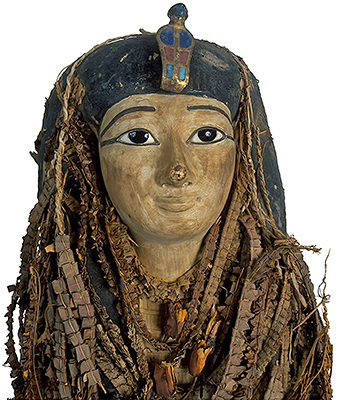
Eighteenth Dynasty: 1 550 BC - 1 292 BC
Pharaoh Amenhotep I
The picture of the right lateral view of the mummy of Amenhotep I shows the body fully wrapped in linen, covered from head to foot with floral garlands, and wearing a head mask.
The head mask of the mummy of Amenhotep I is made of painted wood and cartonnage. The face is painted in a faint yellow colour. The contour of the eyes and eyebrows is painted black. The eyes are inlaid with black pupils made of obsidian crystals. On the forehead is a separately carved painted cobra of painted wood, inlaid stones, and cartonnage. The rest of the head mask is partially hidden by floral garlands.
Photo, source and text: Saleem & Hawass (2021)
Amenhotep I ruled Egypt for about 21 years (circa 1 525 – 1 504 BC). He was the second king of the 18th Dynasty to ascend the throne after the death of his father Ahmose I. Amenhotep I may have co-reigned with his mother Ahmose-Nefertari. The name Amenhotep means: 'Amun is satisfied'. His throne name was Djeserkare: 'Holy is the Soul of Re'. During his reign, Amenhotep I protected the territories of Egypt; he led a campaign to Kush and an expedition to Libya. Amenhotep I had a peaceful reign that enabled him to focus on the administrative organisation and to commission the building of temples. The most important temples built by Amenhotep I were the temple of Amun at Karnak, a temple in Nubia at Sai, as well as structures in Upper Egypt at Elephantine, Kom Ombo, Abydos, and the Temple of Nekhbet. After his death, Amenhotep I and his mother were worshiped in Deir El Medina.Text above: Saleem & Hawass (2021)
The original tomb of Amenhotep I has not yet been found in modern times. The mummy of Amenhotep I was discovered in 1881 at Deir el-Bahari Royal Cache in Luxor, where the officials of the 21st Dynasty hid the mummies of several New Kingdom kings and nobles to protect them from tomb robbers. The mummy of Amenhotep I was found wrapped inside a coffin. The hieroglyphic inscriptions on the coffin and on dockets confirmed the name of Amenhotep I and recorded the rewrapping of the mummy after being damaged by grave robbers. The mummy of Amenhotep I has been rewrapped twice by the 21st Dynasty's priests: by Pinedjem I, Theban High Priest of Amun, and a decade later by his son Masarharta.
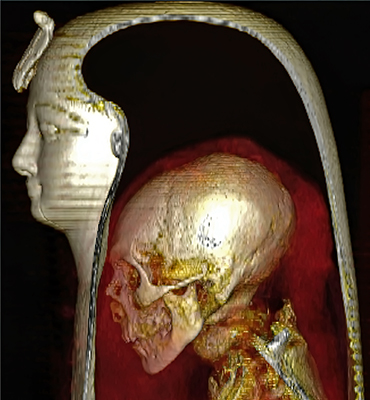
Eighteenth Dynasty: 1 550 BC - 1 292 BC
Pharaoh Amenhotep I
Three-dimensional CT image of the head of the wrapped mummy of Amenhotep I in a left lateral view allows visualisation of the component layers: the mask, the head of the mummy, and the surrounding bandages.
Photo, source and text: Saleem & Hawass (2021)
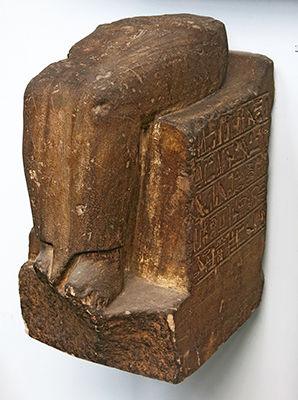
Eighteenth Dynasty: 1 550 BC - 1 292 BC
Ahmose-Turi
Lower half of a sandstone seated statue of Ahmose-Turi from Kerma, Circa 1530 BC.
Ahmose-Turi was viceroy of Kush under Pharaohs Amenhotep I and Thutmose I.
The hieroglyphic inscription on the sides of the throne invoke the gods Osiris, Horus Lord of Buhen and Dedwen (a native Nubian god), and gives the names of Ahmose' s parents.
Abyssinia, or Ethiopia, was known as Kush to the ancient Egyptians.
Photo: Don Hitchcock 2015
Source: Original, British Museum
Text: Card at the British Museum, © Trustees of the British Museum, CC BY-NC-SA 4.0

Eighteenth Dynasty: 1 550 BC - 1 292 BC
Mencheper
Stela of Mencheper and his family, circa 1 500 BC, reign of Thutmose I.
( In the upper register, Mencheper and his wife and son adore Osiris.
Above, a pair of Wedjat eyes, associated with Horus - Don )
Catalog: Limestone, Gl.WAF 20
Photo: Don Hitchcock 2018
Source: Original, Ägyptischen Museum München
Text: Museum card, © Ägyptischen Museum München
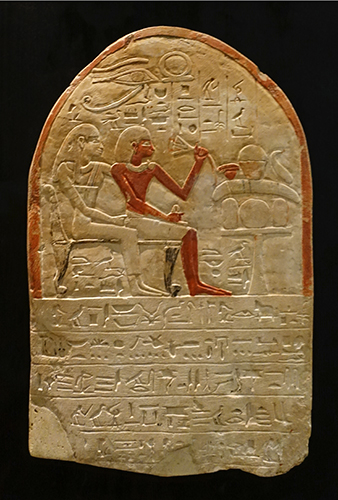
Eighteenth Dynasty: 1 550 BC - 1 292 BC
Penre
Stela of the Royal Stonecutter Penre, circa 1 500 BC, reign of Thutmose I.
( In the upper register, Penre and his wife are shown at the Burial Feast. Above is a single Wedjat eye, and the Shen symbol of eternity and divine protection - Don )
Catalog: Limestone, ÄS 43
Photo: Don Hitchcock 2018
Source: Original, Ägyptischen Museum München
Text: Museum card, © Ägyptischen Museum München
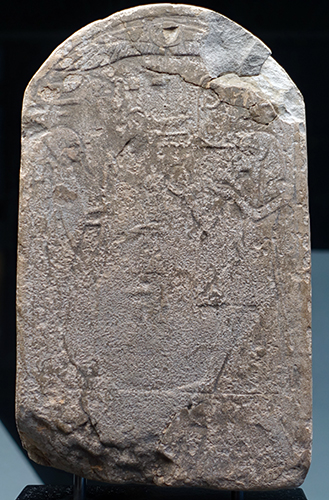
Eighteenth Dynasty: 1 550 BC - 1 292 BC
Pharaoh Amenhotep I
Small stele with Pharaoh Amenhotep I in front of the god Ptah sacrificing.
Reign of Amenhotop 1, 524 BC - 1 503 BC.
The Pharaoh (right), who can be identified by his cartouche, hands with both hands (wine) vessels to the god 'Ptah, perfect in face, the Lord of truth'. In return to Pharaoh, the god (hieroglyphics between the two) says: 'I give (you) power of guidance'.
Catalog: Limestone
Photo: Don Hitchcock 2018
Source and text: Original, Museum August Kestner, Hannover
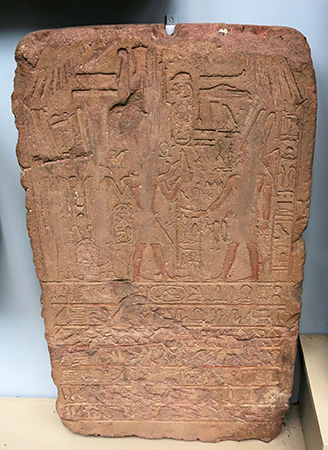
Eighteenth Dynasty: 1 550 BC - 1 292 BC
Amenhotep I
Sandstone stela dated to Year 8 of Pharaoh Amenhotep I, from Qasr Ibrim, circa 1 530 BC.
The scene shows the king making offerings to the god Horus of Miam (modern-day Aniba).
( Note that the god is wearing the double plumed headdress of the god Amun - Don )
He is accompanied by his mother, Queen Ahmose-Nefertary, and a second royal female, possibly his wife Queen Merytamun (whose name appears to have been excised and later inaccurately restored as Ahmose-Nefertary).
Below is a hieroglyphic text boasting of the power of the pharaoh over foreign lands.
Catalog: EA1835
Photo: Don Hitchcock 2015
Source: Original, British Museum
Text: Card at the British Museum, © Trustees of the British Museum, CC BY-NC-SA 4.0

Eighteenth Dynasty: 1 550 BC - 1 292 BC
Shabti of Nefer
Limestone shabti of the priest of Amun, Nefer, with a lappet-wig, a modelled face with a beard and arms crossed in relief over the chest. The leg section is inscribed with seven rows of Hieroglyphs.
Circa 1 500 BC.
Height 250 mm, width 80 mm, depth 69 mm.
Titles/epithets include: God's Servant of Amun.
Catalog: EA51819
Photo: Don Hitchcock 2015
Source: Original, British Museum
Text: © Card at the Museum, http://www.britishmuseum.org/research/ © Trustees of the British Museum, CC BY-NC-SA 4.0
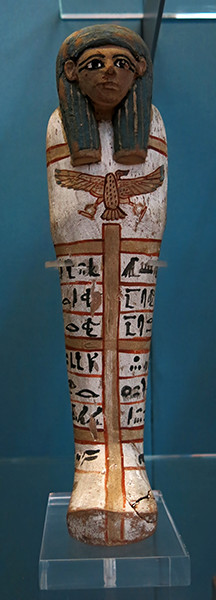
Eighteenth Dynasty: 1 550 BC - 1 292 BC
Shabti of Renseneb
Painted wooden shabti of Renseneb, circa 1 500 BC.
Eight rows of Hieroglyphic text. Height 242 mm.
Catalog: EA57342
Photo: Don Hitchcock 2015
Source: Original, British Museum
Text: © Card at the Museum, www.britishmuseum.org/research/ © Trustees of the British Museum, CC BY-NC-SA 4.0
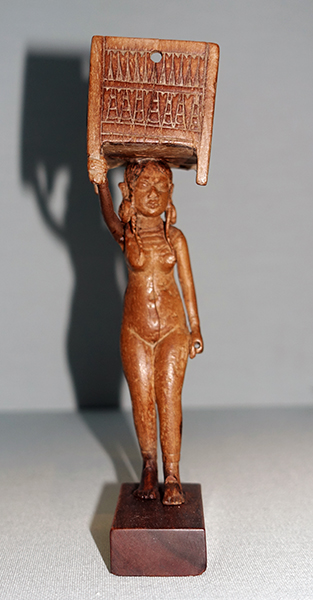
Eighteenth Dynasty: 1 550 BC - 1 292 BC
Cosmetic Box
Wooden cosmetic-box held by a female figure. The young girl wears only a pair of large earrings with rosette centres. Her hair is plaited into three skinny pigtails, two of which hang down in front and the other behind.
On her head she carries a rectangular four-legged casket, which is evidently rather precariously balanced: she grasps one of the legs to hold it steady. She is bent slightly forward under the weight of the box.
The unusual hairstyle of this figure suggests that she may represent a foreigner. The hole pierced through this girl's free hand was probably intended to hold the handle of an applicator.
Height 140 mm, width 50 mm.
Catalog: Wood, EA32767
Photo: Don Hitchcock 2018
Source: Original, British Museum
Text: © Card at the Museum, http://www.britishmuseum.org/research/ © Trustees of the British Museum, CC BY-NC-SA 4.0
Eighteenth Dynasty: 1 550 BC - 1 292 BC
Amenemhat
Statue of Amenemhat holding a stela (stelophore), height 345 mm.
Circa 1 500 BC.
( note that the same names keep coming up in the records of Ancient Egypt. There were a number of men called Amenemhat, and it is unclear which one this is - Don )
Catalog: Painted limestone, ÄM 2316
Photo: Don Hitchcock 2015, 2018
Source: Original, Staatliche Museen zu Berlin, Neues Museum, Germany
Text: © Card at the Staatliche Museen zu Berlin, (CC BY-NC-SA 3.0 DE)
Eighteenth Dynasty: 1 550 BC - 1 292 BC
Canopic Lids
Three lids from viscera jars, shaped like the sons of Horus, circa 1 500 BC.
Catalog: Limestone, ÄS 6924, ÄS 6925, ÄS 6926
Photo: Don Hitchcock 2018
Source: Original, Staatliche Museen zu Berlin, Neues Museum, Germany
Text: © Card at the Staatliche Museen zu Berlin
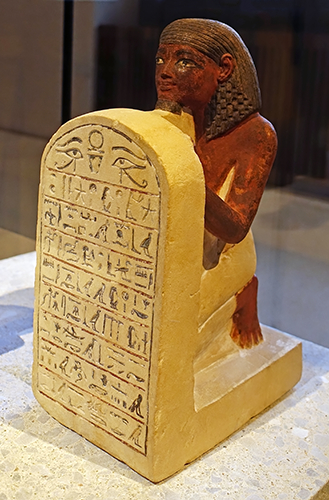
Eighteenth Dynasty: 1 550 BC - 1 292 BC
Sa-Iset
Stelophore of Sa-Iset
Dimensions: 300 x 145 x 175 mm.
Sa-Iset kneels on the ground. He raises his arms in prayer and touches with his palms the stele standing in front of him. The figure portrayed carries a long apron extending from the hips to the ankles. The head is covered by a hairy wig, which, however, leaves the ears free. A short beard adorns the chin. It is, like the wig, painted black. A reddish-brown hue was used for the skin colour.
The stele is adorned with the symbols for duration (the ring in the middle) and for protection (the two Udjat eyes). This is followed by the text: ' Adoration of the Re in the morning, when he walks on the horizon of heaven, through the goldsmith of Amun, Si-Ese, saying, Rejoice, Re, when you arise, hidden, God-power. Rise. Enlighten the two countries. You are crossing the sky, joyfully, with a great heart in the Mandjet barge, truly complete. '
Catalog: Circa 1500 BC - 1400 BC, painted limestone, Thebes-West, ÄM 2314
Photo: Don Hitchcock 2018
Source: Original, Staatliche Museen zu Berlin, Neues Museum, Germany
Text: © Card at the Staatliche Museen zu Berlin, http://www.smb-digital.de/ (CC BY-NC-SA 3.0 DE)
Eighteenth Dynasty: 1 550 BC - 1 292 BC
Samut
Statue of Samut holding a stela with prayers to the sungod, circa 1500 BC - 1400 BC.
Catalog: Painted limestone, Thebes West, ÄM 2312
Photo: Don Hitchcock 2015, 2018
Source: Original, Staatliche Museen zu Berlin, Neues Museum, Germany
Text: © Card at the Staatliche Museen zu Berlin, (CC BY-NC-SA 3.0 DE)
Eighteenth Dynasty: 1 550 BC - 1 292 BC
Thutmose II
Location and entry to the tomb of Thutmose II.
Egyptologists have discovered the first tomb of a pharaoh since Tutankhamun's was uncovered over a century ago.
King Thutmose II's tomb was the last undiscovered royal tomb of the 18th Egyptian dynasty.
A British-Egyptian team has located it in the Western Valleys of the Theban Necropolis near the city of Luxor. Researchers had thought the burial chambers of the 18th dynasty pharaohs were more than 2km away, closer to the Valley of the Kings.
The crew found it in an area associated with the resting places of royal women, but when they got into the burial chamber they found it decorated - the sign of a pharaoh.
'Part of the ceiling was still intact: a blue-painted ceiling with yellow stars on it. And blue-painted ceilings with yellow stars are only found in kings' tombs' said the field director of the mission Dr Piers Litherland.
He told the BBC's Newshour programme he felt overwhelmed in the moment.
'The emotion of getting into these things is just one of extraordinary bewilderment because when you come across something you're not expecting to find, it's emotionally extremely turbulent really' he said.
'And when I came out, my wife was waiting outside and the only thing I could do was burst into tears.'
Dr Litherland said the discovery solved the mystery of where the tombs of early 18th dynasty kings are located.
Researchers found Thutmose II's mummified remains two centuries ago but its original burial site had never been located.
Dr Litherland said the 'large staircase and a very large descending corridor' of the tomb suggested grandeur.
'It took us a very long time to get through all that," he said, noting it was blocked by flood debris and the ceilings had collapsed.
'It was only after crawling through a 10 metre long passageway that had a small 40 cm gap at the top that we got into the burial chamber'.
There they discovered the blue ceiling and decorations of scenes from the Amduat, a religious text which was reserved for kings. That was another key sign they had found a king's tomb, Dr Litherland said.
They set to work clearing the debris - expecting that they would find the crushed remains of a burial underneath.
But 'the tomb turned out to be completely empty', said Dr Litherland. 'Not because it was robbed but because it had been deliberately emptied.'
They then worked out that the tomb had been flooded - 'it had been built underneath a waterfall' - just a few years after the king's burial and the contents moved to another location in ancient times.
It was through sifting through tonnes of limestone in the chamber that they found fragments of alabaster jars, which bore the inscriptions of the names of Thutmose II and Hatshepsut.
These fragments of alabaster 'had probably broken when the tomb was being moved' said Dr Litherland.
'And thank goodness they actually did break one or two things because that's how we found out whose tomb it was.'
The artefacts are the first objects to be found associated with Thutmose II's burial.
Dr Litherland's said his team had a rough idea of where the second tomb was, and it could still be intact with treasures.
The discovery of the pharaoh's tomb caps off more than 12 years of work by the joint team from Dr Litherland's New Kingdom Research Foundation and Egypt's Ministry of Tourism and Antiquities.
Photo: © New Kingdom Research Foundation
Source and text: Frances Mao, BBC News, www.bbc.com
Eighteenth Dynasty: 1 550 BC - 1 292 BC
Thutmose II
Entrance to the tomb of Thutmose II.
Photo: © New Kingdom Research Foundation
Source and text: Frances Mao, BBC News, www.bbc.com
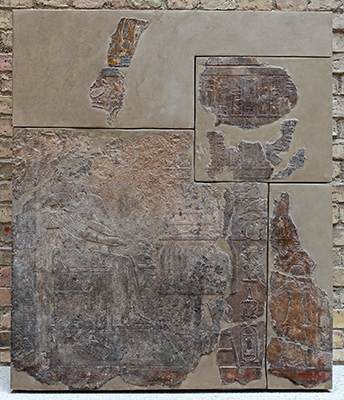
Eighteenth Dynasty: 1 550 BC - 1 292 BC
Thutmose II
Temple relief showing Pharoah Thutmose II in front of an offering table, circa 1 480 BC
Found at Deir el-Bahari, a complex of mortuary temples and tombs located on the west bank of the Nile, opposite the city of Luxor, Egypt. This is a part of the Theban Necropolis.
Catalog: Limestone, Deir el-Bahari, Mortuary Temple of Queen Hatshepsut, Hatchepsut, ÄM 1623
Photo: Don Hitchcock 2018
Source: Original, Staatliche Museen zu Berlin, Neues Museum, Germany
Text: © Card at the Staatliche Museen zu Berlin
Additional text: Wikipedia
Eighteenth Dynasty: 1 550 BC - 1 292 BC
Thutmose II
Dish Inscribed with the Throne Name of Thutmose II
Circa 1 492 BC – 1 473 BC
In 1936 the Metropolitan Museum's Egyptian Expedition discovered a small sealed doorway on the hillside beneath Senenmut's tomb (TT 71). Inside lay four coffins surrounded by boxes, baskets, and pottery. This turned out to be one of the few well-preserved private burials from the early New Kingdom. Two coffins were inscribed for Hatnefer and Ramose, Senenmut's mother and father. Two others contained six anonymous mummies, almost certainly members of the same family.
The chief beneficiary of the tomb was Senenmut's elderly mother, who lived to benefit from her son's rise at court. At her death, Senenmut seems to have transferred the burials of other family members to Thebes, where their spirits could reap the benefits of the grave goods he was able to provide for Hatnefer.
The entrance of the small tomb was sealed with a large rock and covered by loose chip from the construction of Senenmut's chapel on the hillside above. Several inscriptions from the tomb date to regnal year 7. This indicates that the tomb was sealed in the seventh year of the joint reign of Hatshepsut and Thutmose III. One amphora bears a stamp referring to Hatshepsut as the 'Good Goddess'. This is generally regarded as the earliest attestation of Hatshepsut as Pharoah.
This small bowl is inscribed with the throne name of Hatshepsut’s husband (and half-brother), Thutmose II – it reads 'The Good God, Aakheperenre, Given Life'. It was found in coffin number 3 which contained the burial of two young women and two children. The presence of the bowl suggests that at least one of the occupants was originally buried during the reign of Thutmose II.
Findspot: From Egypt, Upper Egypt, Thebes, Sheikh Abd el-Qurna, Tomb of Hatnefer and Ramose (below TT 71), coffin III, MMA excavations, 1935–36.
Dimensions: Height 18 mm, diameter 80 cm.
Catalog: Faience, paint, Nr. 36.3.9
Photo and text: Mettropolitan Museum
Permission: ![]() Public Domain, Open Access
Public Domain, Open Access
Eighteenth Dynasty: 1 550 BC - 1 292 BC
Thutmose II
Dish Inscribed with the Throne Name of Thutmose II
Circa 1 492 BC – 1 473 BC
Scarab Inscribed with the Throne Name of Thutmose II
Length 15 mm.
Catalog: Steatite, Nr. 05.3.355
Photo and text: Mettropolitan Museum
Permission: ![]() Public Domain, Open Access
Public Domain, Open Access
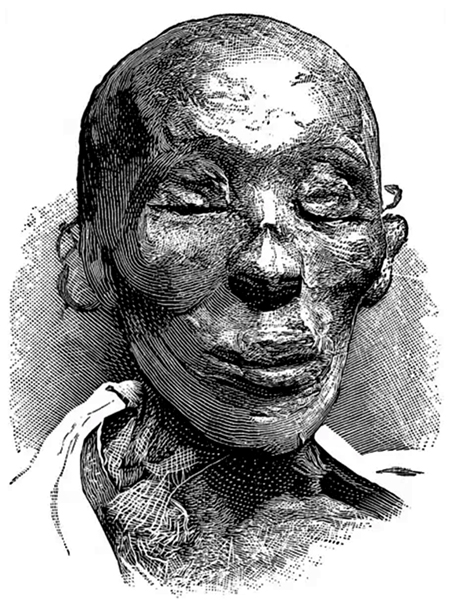
Eighteenth Dynasty: 1 550 BC - 1 292 BC
Thutmose II
Head of Thutmose II, from the mummy.
Source: Moberly Bell (1888), Public Domain

Eighteenth Dynasty: 1 550 BC - 1 292 BC
Kohl Jar
Calcite kohl jar with a circular lid. The rim has been repaired from fragments.
Diameter 71 mm, height 70 mm.
Catalog: Calcite, EA29336
Photo: Don Hitchcock 2018
Source: Original, British Museum
Text: © Card at the Museum, http://www.britishmuseum.org/research/ © Trustees of the British Museum, CC BY-NC-SA 4.0
Eighteenth Dynasty: 1 550 BC - 1 292 BC
Fish
Glass cosmetic bottle in the shape of a fish, found buried under the floor of a house at el-Amarna with other glass vessels.
This is a polychrome glass vessel in the form of a 'bulti'-fish: this is the most spectacular of a small group of fish-form vessels, all representing the 'bulti'-fish common in the Nile and a standard feature of Egyptian decorative art. The body is core-built in blue glass with a matt finish, and is decorated with simple festoons in groups of three or four white lines followed by a yellow line. The tail decorations are in the same colours.
The dorsal fin is composed of a series of heavy threads in the body (blue, white, yellow, and turquoise-blue). The front fins are each composed of one light and one darker blue thread. The front ventral fins are made from one white and one yellow thread each while the rear ventral fin is of turquoise-blue glass. A yellow thread outlines the mouth. The eyes are white opaque circles with the pupils represented by black thread loops. The fish is assembled from several fragments.
Length: 141 mm, width 70 mm, depth 36 mm, weight 140 gm.
Curator's comments: This vessel was found in a medium-sized private house at El-Amarna, found buried under a plaster floor together with two glass jugs and some metal objects.
Fish-form vessels were common in many media at this time - the glass examples are but versions of others - but how they were used is not evident. They seem to have been ointment vessels and must have been furnished with stands as they are incapable of standing by themselves.
Catalog: Glass, core-formed, EA55193
Photo: Don Hitchcock 2018
Source: Original, British Museum
Text: © Card at the Museum, http://www.britishmuseum.org/research/ © Trustees of the British Museum, CC BY-NC-SA 4.0
Eighteenth Dynasty: 1 550 BC - 1 292 BC
Glass Jars
Front left: EA36344, Thebes, Ruler Ramses II.
Twin-handled jar of heavy, squat form. The body is opaque dark blue with chevron decorations of the neck are in opaque white and yellow. On the central area of the body are shallow white festoons bordered at top and bottom by a single orange-yellow festoon line, the upper one in high relief. The surface is glossy.
Height 81 mm.
Catalog: Glass, Thebes, EA36344
Front right: Cosmetic Jar, EA4741
Two-handled jar with wide neck: this form is distinguished by a hemispherical body, a relatively high hollow foot, and a flat slightly projecting rim. The body is of opaque dark-blue glass with two monochrome loop handles of the same fabric.
The chevron decorations of the neck are in opaque white, yellow, and turquoise-blue, while the clustered festoons of the body are in the same almost standard combination of opaque white, turquoise-blue, and yellow. All surfaces have a high gloss.
Circa 1 390 BC - 1 352 BC
Height 87 mm.
Curator's comments:
This is a fine and typical example of a shape directly copied from stone, which along with the palm-column form 'kohl' tube and lentoid flask was one of the three most popular shapes of the New Kingdom glass vessels.
Catalog: Glass, EA4741
Back left: Cosmetic Jar, EA4743
Four-handled ovoid cosmetic jar, with a cylindrical neck and a hollow trumpet-shaped base with flat rim. The body is of opaque dark-blue glass, a colour repeated in the four vertical monochrome handles.
A chevron pattern in opaque yellow, turquoise-blue, and white decorates the neck and the flat rim. These colours are repeated in the simple festoons of the body. All surfaces are glossy. One handle is lost.
Height 100 mm.
Curator's comments: A shape frequent in the later Eighteenth Dynasty.
Catalog: Glass, Memphis, EA4743
Back right: Cosmetic Jar, EA4742
Small cosmetic jar with ovoid body, a high hollow foot and two large vertical handles. The turquoise-blue body is opaque with a glossy surface. The chevron decorations of both neck and body are in dark blue with the exception of the top and bottom lines of the body and neck which are in opaque yellow.
A heavy dark-blue thread encircles the base of the body and the rim of the foot. The handles are of the same fabric as the body, one being lost, with dark-blue threads worked into the outer surface. The upper neck and rim are lost.
Diameter: 58 mm, height 103 mm.
Catalog: Glass, Memphis, EA4742
Photo: Don Hitchcock 2018
Source: Original, British Museum
Text: © Card at the Museum, http://www.britishmuseum.org/research/ © Trustees of the British Museum, CC BY-NC-SA 4.0
Eighteenth Dynasty: 1 550 BC - 1 292 BC
Kohl tube and Kohl stick
Kohl tube in the form of a a palm column. The hollow shaft is of translucent dark blue glass, with its base outlined with a yellow thread. The lower body is decorated with two lines of chevrons in white and turquoise blue. A turquoise blue thread encircles the upper shaft six times.
White threads outline the individual elements of the palm-leaf capital while the rim of the opening has a single turquoise blue thread. The core is red-brown and retains faint traces of a fabric pattern. A slight chip on the capital is the sole damage. A wooden kohl applicator accompanies the object.
Length 100 mm (tube)
Length 112 mm (applicator)
Catalog: Glass, core-formed, Wood, late 18th Dynasty, EA2589
Photo: Don Hitchcock 2018
Source: Original, British Museum
Text: © Card at the Museum, http://www.britishmuseum.org/research/ © Trustees of the British Museum, CC BY-NC-SA 4.0
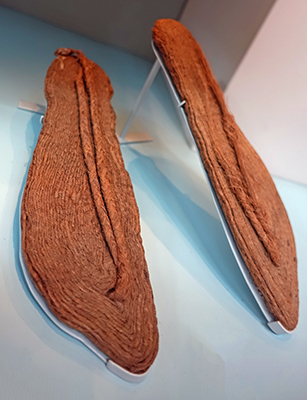
Eighteenth Dynasty: 1 550 BC - 1 292 BC
Sandals
Pair of child's sandals made from woven cord. The simple but functional design features a sole of woven fibre, with a thong designed to fit between the first and second toe. This thong was joined to the strap that ran around the ankle.
Height: 18 mm, length 232 mm, width 75 mm.
Catalog: Fibre, Giza (Memphis), EA4418, EA4419
Photo: Don Hitchcock 2018
Source: Original, British Museum
Text: © Card at the Museum, http://www.britishmuseum.org/research/ © Trustees of the British Museum, CC BY-NC-SA 4.0
Eighteenth Dynasty: 1 550 BC - 1 292 BC
Sandals
Pair of fine palm-fibre sandals from Sedment, Tomb 136, white ant damage. Tie of one (B) missing.
Length 335 mm, width 165 mm, Accession Number LDUCE-UC16555
Photo: Don Hitchcock 2018
Source: Original, Petrie Museum, London, England
Text: Card / online catalogue, the Petrie Museum, © 2015 UCL. CC BY-NC-SA license
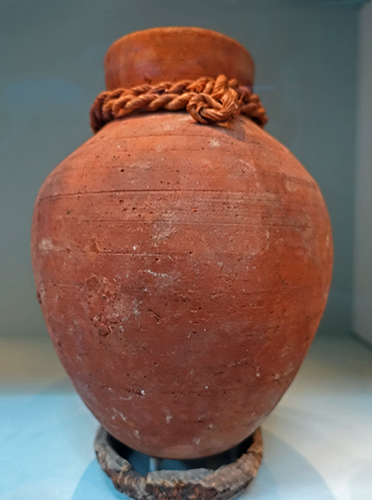
Eighteenth Dynasty: 1 550 BC - 1 292 BC
Jar
Nile siltware jar, with cylindrical neck (flaring slightly towards the top) and a simple rim.
Accessioned with rope around base of neck, and with reed stand, catalog EA 49224.
Height: 252 mm.
Catalog: Ceramic, Deir el-Bahri (Thebes), EA43223
Photo: Don Hitchcock 2018
Source: Original, British Museum
Text: © Card at the Museum, http://www.britishmuseum.org/research/ © Trustees of the British Museum, CC BY-NC-SA 4.0
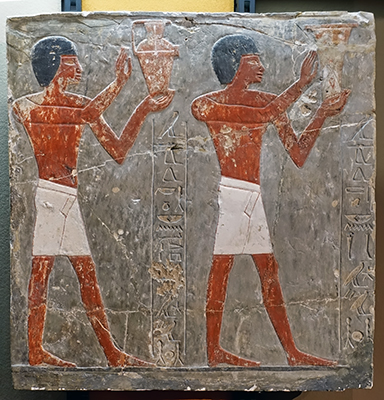
Eighteenth Dynasty: 1 550 BC - 1 292 BC
Relief with gift bearers
From the tomb of Dua-Neheh, First Royal Herald, Overseer of the possessions of Amun.
Circa 1 480 BC during the reign of Hatshepsut.
Catalog: Painted limestone, Thebes West, Tomb No. 125
Photo: Don Hitchcock 2018
Source and text: Original, Museum August Kestner, Hannover
Additional text: Wikipedia
Eighteenth Dynasty: 1 550 BC - 1 292 BC
Queen Hatshepsut
Kneeling figure of Queen Hatshepsut with Nemset jug, a cultic vessel, circa 1 475 BC.
Dimensions: 870 x 370 x 570 mm
Hatshepsut was one of the few women to rise to the throne as Pharaoh. She was the daughter of King Thutmose I and the wife of her half-brother Thutmose II, who died at an early age, and she was the regent for the government affairs for her husband's son Thutmose III, who was born to a co-wife and was a minor when he ascended the throne.
Probably in the 7th year of her reign, she was crowned king. She justified her claim to rule with her election by the imperial god Amun. In the terraced mortuary temple built by her favourite in Deir el-Bahari, she had the legend of her divine birth depicted in a relief sequence.
Their over 20-year reign was peaceful, with an outstanding event being the sending of an expedition to the legendary incense land of Punt. ( The Land of Punt was an ancient kingdom. A trading partner of Egypt, it was known for producing and exporting gold, aromatic resins, blackwood, ebony, ivory and wild animals. Its exact location is not known, but it is now understood to be probably in the region of modern Eritrea and Ethiopia - Don )
After Hatshepsut assumed rule as Pharaoh, she was now presented as such, ie as a man. As a king with the prescribed ceremonial clothing with a bare torso, royal headscarf, ceremonial beard and short apron, she kneels before the god and presents him with a water jug, on the front of which is the symbol for 'duration, permanence'.
Nevertheless, the artist understood how to include feminine features on the queen's face. They radiate youthfulness through the gentle curvature of the face shape, the curved eyebrows, the large eyes and the graceful mouth. The liveliness is emphasised by the black painting of the eyes and brows. The figure is part of a series of similar portraits from the Queen's Temple.
Catalog: Pink granite, painted, Western Thebes, Deir el Bahari, ÄM 22883
Photo: Don Hitchcock 2018
Source: Original, Staatliche Museen zu Berlin, Neues Museum, Germany
Text: © Card at the Staatliche Museen zu Berlin http://www.smb-digital.de/ , (CC BY-NC-SA 3.0 DE)-->
Additional text: Wikipedia
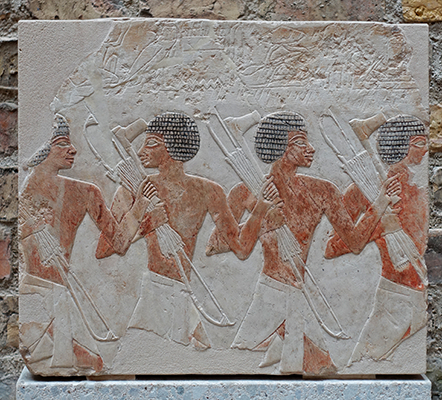
Eighteenth Dynasty: 1 550 BC - 1 292 BC
Fragments of reliefs from the tomb of Hatshepsut: Egyptian soldiers and Nubian mercenaries, circa 1470 BC.
The tomb of Hatshepsut dates from the 18th dynasty and is the best preserved temple in Deir el-Bahari on the west bank of the Nile at Thebes.
(top, ÄM 18542) 315 x 425 x 65 mm.
The relief comes from the Temple of Queen Hatshepsut in Deir el-Bahari and shows a series of soldiers who are participating in a procession. They are armed with throwing sticks and axes, and carry olive branches. One of the soldiers holds a standard, on which decorated horses are to be seen, and which indicates the troop the men are part of.
(middle, ÄM 14507), 330 x 585 mm
(bottom, ÄM 14141) The soldiers in this panel are armed with axes and bows and arrows.
Catalog: Painted Limestone, ÄM 18542, ÄM 14507, ÄM 14141
Photo: Don Hitchcock 2015, 2018
Source: Original, Staatliche Museen zu Berlin, Neues Museum, Germany
Text: © Card at the Staatliche Museen zu Berlin, F. Seyfried at http://www.smb-digital.de/ (CC BY-NC-SA 3.0 DE)
Eighteenth Dynasty: 1 550 BC - 1 292 BC
Adze (copy), from the reign of Hatshepsut, 1 479 BC - 1 458 BC
( The piece is described as a simalucrum, a copy. However although the leather binding and possibly the wooden handle is modern, it may be that the copper adze blade is original. It may be a copy from when it was first added to the collection in 1857. - Don )
Height 127 mm, width 22 mm.
Text is engraved on the blade, and text is painted on the back of the handle, in black.
Catalog: Deir el-Bahari (West Thebes), Temple of Hatshepsut, Room 327, Sully Wing, Level 0, Vitrine 1, no. 789
Photo: Don Hitchcock 2018
Source and text: copy, Louvre Museum, Paris, France, https://collections.louvre.fr/
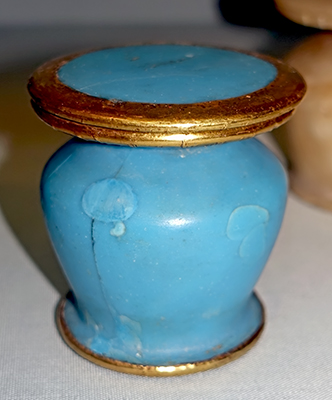
Eighteenth Dynasty: 1 550 BC - 1 292 BC
Kohl Jar
Kohl jar with separate cover: this vessel is fashioned in opaque turquoise-blue glass. The edges of the cover, the rim and the base are bordered with sheet gold. The shape is rare in glass, traces of only four other specimens are known.
The interior hollow is cylindrical (typical for New Kingdom kohl-jars), descending to about three-quarters of the height of the jar. In the centre of the underside of the cover is the usual boss to keep the cover in position.
If the cylindrical interior of this jar was drilled, as seems reasonably certain, no trace of the drilling survives and it must be inferred that this area was pumiced. Some abrasive marks, admittedly inconclusive evidence, on the underside of the rim suggest cold cutting. It is uncertain if the rim was made separately and, if so, whether it was cut or moulded. Areas of the lip and body have been filled in with blue wax. Gold work on rim of jar partly a gilded plaster restoration. The goldwork is probably ancient.
Diameter 64 mm, height 63 mm.
Curator's Comment: Budge says that this jar is said to be from the funerary equipment of Hatshepsut, a statement without known support, although the dating is probably correct.
Catalog: Glass, gold, plaster, wax, EA24391
Photo: Don Hitchcock 2018
Source: Original, British Museum
Text: © Card at the Museum, http://www.britishmuseum.org/research/ © Trustees of the British Museum, CC BY-NC-SA 4.0
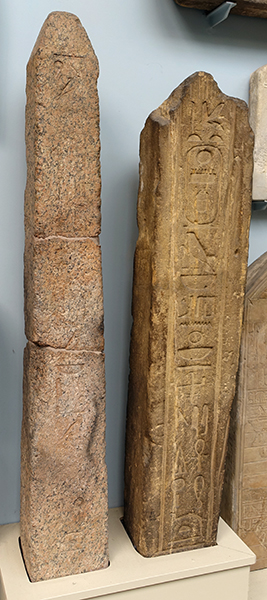
Eighteenth Dynasty: 1 550 BC - 1 292 BC
Queen Hatshepsut
(left) Pink granite obelisk of Queen Hatshepsut, early 1 400s BC, from Qasr Ibrim.
On one side it is inscribed with the names of the queen described as 'beloved of Horus, Lord of Miam (modern-day Aniba), living forever like Ra'. The names were later erased as an attempt to remove her memory from history.
Catalog: EA1834
(right) Sandstone door-jamb with the name of Pharaoh Thutmose Ill, from Buhen, about 1 470 BC.
The door-jamb bears an incised hieroglyphic text on the front, including the name of the pharaoh, who is described as 'beloved of the god Horus Lord of Buhen'.
Buhen was an ancient Egyptian settlement situated on the West bank of the Nile below (to the North of) the Second Cataract in what is now Northern State, Sudan. It is now submerged in Lake Nasser, Sudan.
Catalog: EA1019
Photo: Don Hitchcock 2018
Source: Original, British Museum
Text: Card with the display at the British Museum, © Trustees of the British Museum, CC BY-NC-SA 4.0, http://www.britishmuseum.org/
Eighteenth Dynasty: 1 550 BC - 1 292 BC
Hatshepsut
Head from a composite statue of Pharaoh Hatshepsut, circa 1 465 BC.
( Although the inlays (for the eyes and eyebrows) originally used on this sculpture have been lost, the remains of the white glue used can still be seen at the base of the circular holes left by the drill bit used for the initial carving. The edges of the circular drill holes can also still be seen on the surface where they were not completely smoothed away, easily visible in the right hand image. A slightly smaller diameter drill bit would have been advisable. (The inlays themselves may well have had flanges to hide these irregularities). These are good indicators of some of the techniques used by the Egyptian artists on this hard stone - Don )
Catalog: Jasper, Private Collection
Photo: Don Hitchcock 2015
Source: Original, Ägyptischen Museum München
Text: © Ägyptischen Museum München
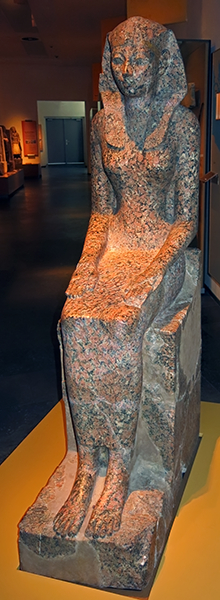
Eighteenth Dynasty: 1 550 BC - 1 292 BC
Queen Hatshepsut
Temple sculpture of Hatshepsut, sitting on a throne with close-fitting dress and king's headscarf, circa 1 473 - 1 458 BC.
Dimensions: 57 x 41 x 30 cm (torso); 170 x 41 x 90 (whole sculpture); circa 600 kg (after reconstruction); weight with box: 967 kg.
Hatshepsut ruled jointly with Thutmose III, who had ascended to the throne the previous year as a child of about two years old. Hatshepsut was the chief wife of Thutmose II, Thutmose III's father.
Hatshepsut is one of the rare ruling queens of ancient Egypt. This image shows her with the royal head cloth (nemes). This sculpture was originally with about two hundred others in Hatshepsut's mortuary temple in Thebes.
All sculptures were removed from it and smashed by Hatshepsut's stepson, Thutmose III, once he alone was the Pharoah. The torso of this sculpture ended up in the RMO, and the head and the lower half at the Metropolitan Museum of Art in New York. It was not until 1998 that the parts were joined together, 3 500 years after they separated.
Catalog: Pink granite, F 1928 / 9.2
Photo: Don Hitchcock 2014
Source and text: Original, Rijksmuseum van Oudheden, National Museum of Antiquities, Leiden, http://www.rmo.nl/
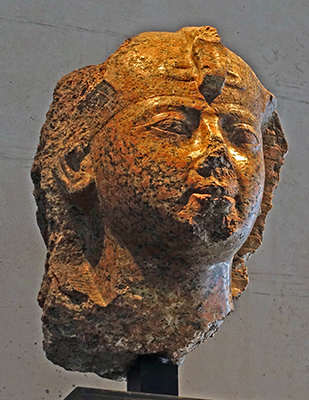
Eighteenth Dynasty: 1 550 BC - 1 292 BC
Hatshepsut
Head from a statue of the queen Hatshepsut as Pharaoh, wearing the royal headdress.
New Kingdom, circa 1 460 BC
Catalog: Pink granite, ÄS 5900
Photo: Don Hitchcock 2018
Source: Original, Ägyptischen Museum München
Text: © Ägyptischen Museum München

Eighteenth Dynasty: 1 550 BC - 1 292 BC
Queen Hatshepsut
Head of a statue of Hatshepsut or of King Thutmose III, circa 1 460 - 1 450 BC.
It may be of Carbonatite, a type of intrusive or extrusive igneous rock defined by a mineralogic composition consisting of greater than 50% carbonate minerals. Carbonatites may be confused with marble and may require geochemical verification.
Catalog: Carbonatite (?), ÄM 34431
Photo: Don Hitchcock 2018
Source: Original, Staatliche Museen zu Berlin, Neues Museum, Germany
Text: © Card at the Staatliche Museen zu Berlin
Additional text: Wikipedia

Eighteenth Dynasty: 1 550 BC - 1 292 BC
Statue Procession
Thutmose III, circa 1 479 BC
The Opet Festival became a mainstream festival in the early New Kingdom (circa 1 539 BC - 1 075 BC) when the 18th dynasty came to power, after driving out the Hyksos invaders who had occupied the northern part of the Nile Valley for 200 years.
Egypt's new rulers wasted no time in making its capital city Thebes a vast ceremonial stage to celebrate the consolidation of power, and the Opet festival took centre stage.
During the reign of Thutmose III (1 479 BC - 1 425 BC), the festival lasted for 11 days. As part of this festival, when the Nile flooded, the statues of the gods were carried from Karnak to Luxor.
Catalog: Limestone, Thebes, Deir el-Bahan, Inv. Nr. 1935.200.200
Photo: Don Hitchcock 2018
Source and text: Original, Museum August Kestner, Hannover
Additional text: Escolano-Poveda (2019), via Wikipedia
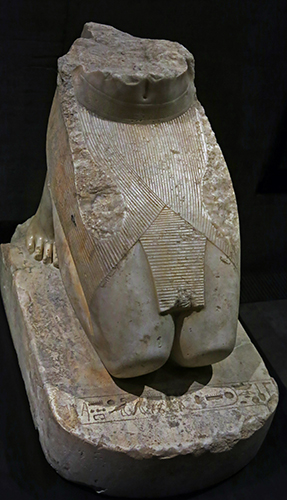
Eighteenth Dynasty: 1 550 BC - 1 292 BC
Thutmose III
Lower half of a kneeling figure of Pharaoh Thutmose III, circa 1 450 BC.
Catalog: Limestone, Karnak, Great Hypostyle Hall, Gl. 88
Photo: Don Hitchcock 2015
Source: Original, Ägyptischen Museum München
Text: © Ägyptischen Museum München
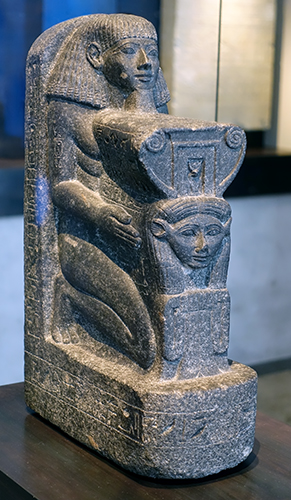
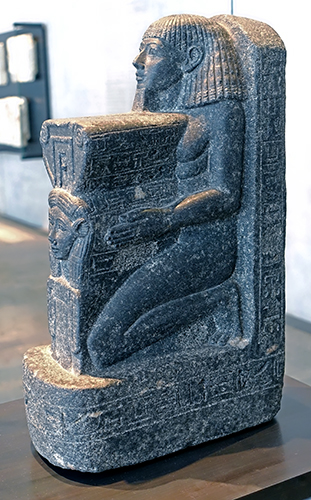
Eighteenth Dynasty: 1 550 BC - 1 292 BC
Senenmut
Kneeling figure of the architect Senenmut holding a symbol of the goddess Hathor
New Kingdom, circa 1 470 BC
Catalog: Granite, Armant, ÄS 6265
Photo: Don Hitchcock 2018
Source: Original, Ägyptischen Museum München
Text: © Ägyptischen Museum München
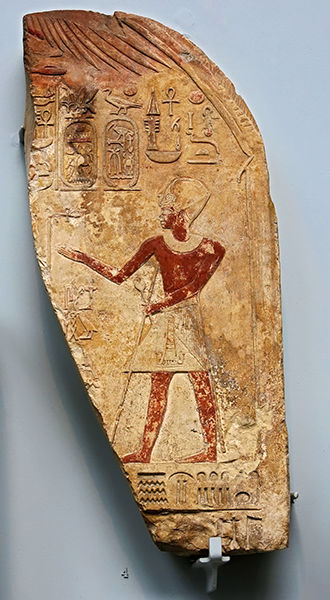
Eighteenth Dynasty: 1 550 BC - 1 292 BC
Thutmose III
Part of a painted limestone stela with Pharaoh Thutmose III making offerings to the god Horus, who will have been depicted on the missing left side of the stone.
From Wadi Halfa, Northern Sudan, circa 1 470 BC.
Catalog: EA1021
Photo: Don Hitchcock 2015
Source: Original, British Museum
Text: Card at the British Museum, © Trustees of the British Museum, CC BY-NC-SA 4.0
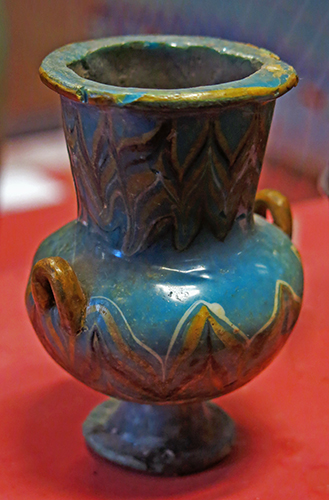
Eighteenth Dynasty: 1 550 BC - 1 292 BC
Bottle
Reign of Thutmose III, circa 1 479 BC - 1 425 BC
Opaque glass, with colours of blue, green, yellow, black, and white.
Height 78 mm, diameter 56 mm.
Catalog: Glass, Thutmose III, Aile Sully, Room 334, Materials and Techniques, Vitrine 6, AF 6737
Photo: Don Hitchcock 2015
Source and text: Original, Louvre Museum, Paris, France, https://collections.louvre.fr/

Eighteenth Dynasty: 1 550 BC - 1 292 BC
Vase
Vase or 'juglet' of the type known as a bilbil, derived from a Cypriot type, dark blue glass.
Circa 1 550 - 1 425 BC.
Bilbils were shipped in great numbers from Cyprus to Egypt. They resemble inverted poppy plants, and recent chemical analyses reveal that some of these vessels contained opium, a poppy extract.
Height 104 mm, width 60 mm.
Catalog: Glass, Dark blue, Thutmose III, Aile Sully, Room 334, Materials and Techniques, Vitrine 6, AF 2624, Drovetti no. 22
Photo: Don Hitchcock 2015
Source and text: Original, Louvre Museum, Paris, France, https://collections.louvre.fr/
Additional text: brooklynmuseum.org
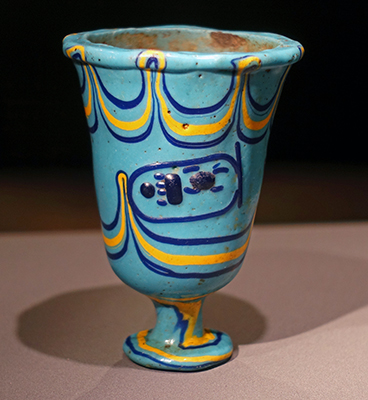
Eighteenth Dynasty: 1 550 BC - 1 292 BC
Chalice
Reign of Thutmose III, circa 1 479 BC - 1 425 BC
Chalice in the shape of a lotus bearing the throne name of Pharaoh Thutmose III.
Circa 1 450 BC
Height 81 mm, diameter 60 mm.
Catalog: Glass, Thebes, ÄS 630
Photo: Don Hitchcock 2018
Source: Original, Ägyptischen Museum München
Text: Museum card, © Ägyptischen Museum München
Additional text: https://www.bavarikon.de
Eighteenth Dynasty: 1 550 BC - 1 292 BC
Olive Press
Painting/relief of an olive press, tomb of Puyemre.
Circa 1 479 -1 458 BC.
This is a very important image, since it shows exactly how olive oil was extracted. In this example, the 'two twist' method is used, whereby the crushed olives are put into a strong woven bag, and both ends are twisted to exert pressure on the olive mash and extract the oil. Another method was the 'one twist' where the far end was fixed, and only the near end was twisted.
The Egyptians used olive oil extensively, including it in their diet, medicine and for rituals. It was used for anointing their bodies, and as a fuel for candles.
Photo: Wikimedia Commons
Permission: Public Domain
Additional text: www.marbrin.co.za
Oil press made of matting, using the 'one twist' method, where the far end was fixed, and only the near end was twisted.
Source: Popular Science Monthly Volume 51, 1897
Proximal source: Wikimedia Commons
Permission: Public domain
Eighteenth Dynasty: 1 550 BC - 1 292 BC
King Thutmose III
The king wears the white crown of Upper Egypt, with a protective cobra emblem representing the goddess Wadjyt. A long flaring beard has broken away. The hands are in a pose of devotion.
For stylistic reasons the identity of this king seems certain, but his name, once present on the belt, was erased when the statue was usurped. Ramesses II put cartouches with his names both on the belt and the shoulders, and his son Merenptah added a pair on the chest.
From Thebes, Karnak, temple of Amun-Ra, reign of Thutmose III, circa 1 479 - 1 425 BC.
Thutmose III was the sixth pharaoh of the Eighteenth Dynasty. Officially, Thutmose III ruled Egypt for almost 54 years and his reign is usually dated from 28 April 1479 BC to 11 March 1425 BC, from the age of two and until his death at age fifty-six; however, during the first 22 years of his reign, he was coregent with his stepmother and aunt, Hatshepsut, who was named the pharaoh.
While he was shown first on surviving monuments, both were assigned the usual royal names and insignia and neither is given any obvious seniority over the other. Thutmose served as the head of Hatshepsut's armies. During the final two years of his reign, he appointed his son and successor, Amenhotep II, as his junior co-regent. His firstborn son and heir to the throne, Amenemhat, predeceased Thutmose III.
Becoming the sole ruling pharaoh of the kingdom after the deaths of Thutmose II and Hatshepsut, he created the largest empire Egypt had ever seen; no fewer than 17 campaigns were conducted and he conquered lands from the Niya Kingdom in northern Syria to the Fourth Cataract of the Nile in Nubia.
When Thutmose III died, he was buried in the Valley of the Kings, as were the rest of the kings from this period in Egypt.
Catalog: Granite, EA61
Photo: Don Hitchcock 2015, 2018
Source: Original, British Museum
Text: Card with the display at the British Museum, © Trustees of the British Museum, CC BY-NC-SA 4.0, http://www.britishmuseum.org/
Additional text: Wikipedia

Eighteenth Dynasty: 1 550 BC - 1 292 BC
King Thutmose III
Relief of Thutmose III, circa 1 458 BC - 1 425 BC
This fine relief of Thutmose III probably came from his valley temple. He also constructed a mortuary temple against the cliffs of Deir el-Bahri at Thebes adjacent to that of Hatshepsut, with whom he shared the kingship for part of his reign. It shows the king wearing the khat headcloth with a very menacing coiled uraeus on his brow.
The khat was a head cloth worn by the nobility of Ancient Egypt. Simpler than the nemes head-dress, it did not have pleats or stripes, and hung down open in the back rather than being tied together.
The fragment was found reused in a Ramesside temple on the same site as Thutmose's valley temple. It was excavated in 1906 by Lord Carnarvon and came to the Museum after his death along with many other items in his collection.
Height 320 mm, width 320 mm, thickness 65 mm.
Catalog: Limestone, paint, Gallery 118, 26.7.1399
Photo: Met Museum
Permission: ![]() Public Domain, Open Access
Public Domain, Open Access
Source: Original, Met Museum
Text: Met Museum
Additional text: Wikipedia
Eighteenth Dynasty: 1 550 BC - 1 292 BC
King Thutmose III
Ritual Statuette of Thutmose III, black bronze, gold inlay, circa 1 479 BC - 1 425 BC.
Beautifully poised, this small bronze king offers wine or milk to a god. The fluid, athletic modelling of his body and details of his costume indicate a date in mid - Dynasty 18. In fact, the statuette represents the great king Tuthmosis III, as is revealed by traces of his prenomen (or throne name), Menkheperre, on the belt buckle.
This figure is the earliest known New Kingdom royal bronze statuette and, with a few Late Middle Kingdom copper and copper-alloy precursors, it initiates the tradition of bronze statuary in Egypt. It is a 'black' bronze, darkened to heighten the lustre of its precious metal inlays. The body of the statuette was solid cast, with separately cast arms (one is missing) fitted onto dowels.
Kneeling bronze kings dating to the New Kingdom are rare. They are found in greater numbers in the Third Intermediate and Late Periods. Such figurines are frequently represented on the great processional barks of the gods, expressing the respectful yet dignified role of the king — himself a god — in ensuring the continuing worship of the gods.
Height 131 mm, width 60 mm, depth 76 mm.
Catalog: Black bronze, gold inlay, Gallery 118, 1995.21
Photo: Met Museum
Permission: ![]() Public Domain, Open Access
Public Domain, Open Access
Source: Original, Met Museum
Text: Met Museum
Additional text: Wikipedia
Eighteenth Dynasty: 1 550 BC - 1 292 BC
King Thutmose III - The Battle of Megiddo
Above:
The three roads described in the Annals of Thutmose III in relation to the battle of Megiddo in the 15th century BCE (as reconstructed by Nelson). Thutmose took the middle road, the Wady Arah, which was the most difficult but led him very close to Megiddo.
Base map and text: adapted from Nelson (1913)
Permission: Public Domain

Eighteenth Dynasty: 1 550 BC - 1 292 BC
King Thutmose III
Upper part of a statue of Thutmose III, circa 1 479 BC - 1 425 BC
Height 426 mm.
Catalog: Thebes, Deir el-Bahri, Temple of Mentuhotep II, 07.230.3
Photo: Met Museum
Permission: ![]() Public Domain, Open Access
Public Domain, Open Access
Source: Original, Met Museum
Text: Met Museum
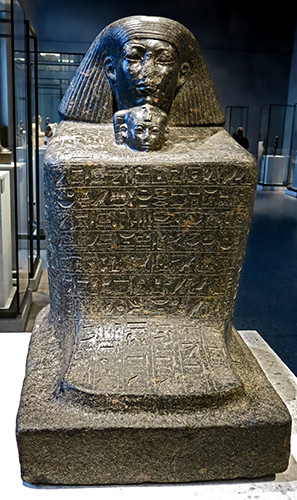
Eighteenth Dynasty: 1 550 BC - 1 292 BC
Senenmut and Princess Neferure
Block Statue of the steward Senenmut with Neferure / Nefrurê.
This cuboid statue represents a man seated with his arms encircling his drawn up knees. His cloth garment is stretched tight against the lines of his arms and legs. He is balanced on a thick base, now partly broken. The head of a child, whose body is hidden within the taut folds of his clothing, emerges from his embrace. The flat panel formed by the fabric between his legs is covered with finely incised hieroglyphs.
The text reveals the identity of the man, Senenmut, who served as the highest official in Egypt during the reign of Queen Hatshepsut. The child on his lap is the princess Neferure, shown with a sidelock hairstyle (characteristic of children in ancient Egypt) and a uraeus on her forehead (marking her royal status). This is one of eight statues of Senenmut that pair him with the princess Neferure, daughter of Hatshepsut. Despite the fact that he must have been at least middle-aged, Senenmut is depicted here as a youthful man, with a smooth, idealised face.
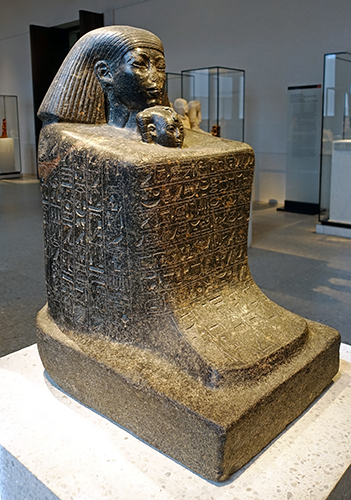
Eighteenth Dynasty: 1 550 BC - 1 292 BC
Senenmut and Princess Neferure
More than 20 statues depicting Senenmut, the most favoured and influential person during the reign of Queen Hatshepsut, were found in the Karnak cache. Eight of them portray Senenmut with Princess Neferure, the daughter of Queen Hatshepsut.
This statue shows the nobleman with the features of a young man: full cheeks in a smooth round face, wide-open eyes with long lashes executed in relief, large ears, and a small, straight, full mouth. As Senenmut was her tutor, the princess' head emerges from his mantle. An indication of her position as heiress to the throne, the child wears her hair in the pleated tress characteristic of royal children, ornamented with the uraeus. Her name, inscribed within a cartouche next to her head, is preceded by the title ' god's wife ', most probably Amun-Re. This honorary and religious title began to be borne by unmarried princesses from now on and was wide spread in the Late Period.
The sides of the statue were ideal for a long text, listing Senenmut's numerous titles and functions in connection with the palace and with the cult of Amun.
Circa 1 475 BC, height 130cm. Found during excavations of the ' cachette ' in the court of the 7th pylon.
By the New Kingdom, most cuboid statues (also called ' block statues ') were set up in temples. They were inscribed with texts that offered prayers for the person depicted, providing their owner with a permanent presence within the temple's sacred halls, courts, or chapels.
Catalog: Grey granite, Thebes/Karnak, ÄM 2296
Photo: Don Hitchcock 2015, 2018
Source: Original, Staatliche Museen zu Berlin, Neues Museum, Germany
Text: © Card at the Staatliche Museen zu Berlin (CC BY-NC-SA 3.0 DE)
Additional text: © C. Zarnoch, E. Sullivan, http://dlib.etc.ucla.edu/projects/Karnak/resource/ObjectCatalog/1841
Additional text: http://www.globalegyptianmuseum.org/record.aspx?id=14859
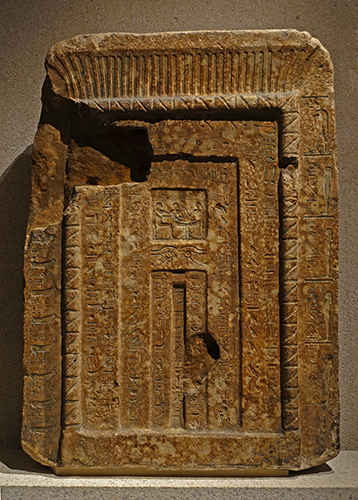
Eighteenth Dynasty: 1 550 BC - 1 292 BC
False door of Senenmut
False door of Senenmut, steward of Queen Hatshepsut.
Circa 1480 - 1460 BC.
Catalog: Thebes-west, Sandstone, ÄM 2066
Photo: Don Hitchcock 2018
Source: Original, Staatliche Museen zu Berlin, Neues Museum, Germany
Text: © Card at the Staatliche Museen zu Berlin (CC BY-NC-SA 3.0 DE)
Eighteenth Dynasty: 1 550 BC - 1 292 BC
Carpenters
Carpenters' workshop. At the right, carpenters and sculptors in wood present their final products.
This drawing is after the tomb of Rekhmire, an Egyptian noble and official of the 18th Dynasty who served as 'Governor of the Town' (Thebes) and Vizier during the reigns of Thutmosis III and Amenhotep II.
Catalog: drawing from the tombe of Rekhmire, circa 1 450 BC
Rephotography: Don Hitchcock 2018
Source and text: Poster, Louvre Museum
Additional text: Wikipedia
Eighteenth Dynasty: 1 550 BC - 1 292 BC
Madja
Mummiform coffin of Madja.
Madja is shown with a tripartite wig and an Usekh necklace. Decorating the coffin are four representations of the dog-god Anubis lying on shrines. On the right hand side of the coffin are a Wedjat eye, the transport of the sarcophagus, and four mourners.
Reign of Thutmose III.
Height 620 mm, length 1840 mm, width 460 mm.
Catalog: Wood, Tomb 1370 Madja, East cemetery, Deir el-Medina, West Thebes, E 14543
Location: Aile Sully, Salle 321, Les sarcophages
Photo: Don Hitchcock 2015
Source and text: Original, Louvre Museum, https://collections.louvre.fr/

Eighteenth Dynasty: 1 550 BC - 1 292 BC
Offering table spout/gutter
Spout broken from a monumental offering table, bearing the name of Thutmose III.
Reign of Thutmose III, 1 479 BC - 1 425 BC.
Height 240 mm, length 830 mm, width 450 mm.
Catalog: Diorite, Thebes, E 7823
Location: Aile Sully, Salle 324, Le Temple, not in a vitrine
Photo: Don Hitchcock 2018
Source and text: Original, Louvre Museum, https://collections.louvre.fr/

Eighteenth Dynasty: 1 550 BC - 1 292 BC
Toeris
Upper part of a Toeris or Tawaret, a protective ancient Egyptian goddess of childbirth and fertility.
Faience, circa 1440 BC.
The deity is typically depicted as a bipedal female hippopotamus with feline attributes, pendulous female human breasts, the limbs and paws of a lion, and the back and tail of a Nile crocodile.
Dr. phil. Christian E. Loeben, for the last 10 years keeper of Egyptian and Islamic Art at the Museum August Kestner, said in a lecture that this piece is one of the most important treasures of the Museum.
Just in the head, it has the teeth of a crocodile, the snout of a lion, and the eyes of a hippo.
See: https://vimeo.com/115753799 at 19.08 on the video.
Height 33 mm.
This particularly valuable fragment bears a yellow detailed drawing on a blue background and a cartouche with the throne name Amenhotep II on the right upper arm, so that the object may come from the private property of the king.
The name Taweret means 'she who is great' or simply 'great one', a common pacificatory address to dangerous deities.
Catalog: Faience, place of discovery unknown, Inv.no. 2616
Photo: Don Hitchcock 2018
Source and text: Original, Museum August Kestner, Hannover
Additional text: Wikipedia
Eighteenth Dynasty: 1 550 BC - 1 292 BC
Chamber of the Ancestors
Offering scene. Thutmose III making offerings before the ancestor kings.
Reign of Thutmose III, 1 479 BC - 1 425 BC.
list of proper names (61 cartouches):
Amenemhat I; Amenemhat II; Amenemhat IV; Sehertaouy Antef I; Djedkarê Isési; Khâânkhrê Sobekhotep; Khâheteprê Sobekhotep; Khâneferrê Sobekhotep; Khâsekhemrê Neferhotep I; Merkaourê Sobekhotep; Niouserrê Ini ; Nebhepetre Montouhotep II; Neferousobek; Ouahankh Antef II; Pépi I; Seânkhkarê Montouhotep III; Sekhemrê-Oupmaat Antef-Âa; Sékhemrê-Seouadjtaouy Sobekhotep; Seouadjenrê Nebiryraou; Sésostris I; Sésostris III; Snefru; Thutmose III; Merenre Nemtyemsaf I; Sahoure; Tepâa Mentouhotep I; Noubkheperrê Antef; Seouserenrê Bebiankh; Senakhtenrê; Sekhemrê-Sementaouy Djéhouty; Seânkhibrê Amény-Antef-Amenemhat ; Sékhemrê-Ouadjkhaou Sobekemsaf I; Sekhemrê-Ouahkhaou Rahotep; Seouahenrê Senebmiou; Khoutaouyrê Ougaf; Sekhemrê-Khoutaouy Amenemhat-Sobekhotep; Sékhemrê-Séousertaouy Sobekhotep; Mersekhemrê Néferhotep II; Merheteprê Sobekhotep.
Height 3600 mm, width 2470 mm, thickness 2650 mm.
Catalog: Akhenu Temple of Amun-Ra, Karnak, the south western corner of the festival hall of Thutmose III, E 13481 BIS
Location: Aile Sully, Salle 325, Les chapelles, not in a vitrine
Photo: Don Hitchcock 2018
Drawing: PLstrom
Permission: Creative Commons Attribution-Share Alike 3.0 Unported license
Source and text: Original, Louvre Museum, https://collections.louvre.fr/
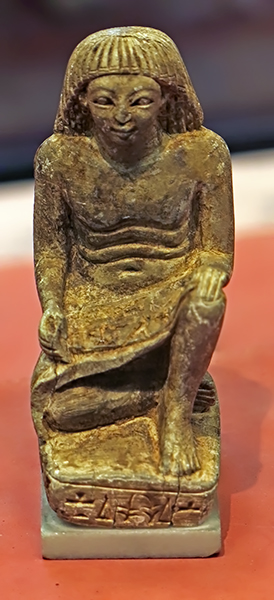
Eighteenth Dynasty: 1 550 BC - 1 292 BC
Scribe Sebeknakht
Statue of a scribe, in soapstone, shown seated, with one knee raised, wearing a loincloth, curly wig, and holding a roll of papyrus, in a common pose for a scribe.
Circa 1 427 BC - 1 353 BC
Height 78 mm, width 37 mm, depth 50 mm.
Catalog: Soapstone/steatite, Deir el-Gebraoui , Middle Egypt, E 8064, AF 744
Location: Sully, Salle 335, Writing and the scribes, Vitrine 2
Photo: Don Hitchcock 2015
Source and text: Original, Louvre Museum, https://collections.louvre.fr/

Eighteenth Dynasty: 1 550 BC - 1 292 BC
Roy and Kashisha
Stela of the priest Roy and the Standard-bearer Kashisha, circa 1 420 BC.
( In the top register Roy and Kashisha each adore Osiris. Above is a double Wedjat eye, and the Shen symbol of eternity and divine protection. The two registers below that show the deceased with their wives at burial feasts - Don )
Catalog: Limestone, ÄS 52
Photo: Don Hitchcock 2018
Source: Original, Ägyptischen Museum München
Text: Museum card, © Ägyptischen Museum München
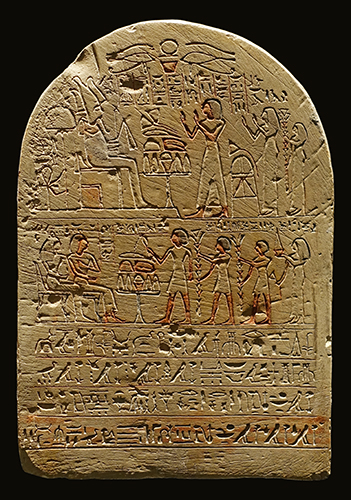
Eighteenth Dynasty: 1 550 BC - 1 292 BC
Nemu
Stela of Nemu, Scribe of the Divine Book, circa 1 400 BC.
( In the top register Nemu and his family adore Osiris. Above is a double Wedjat eye, and the Shen symbol of eternity and divine protection.
The register below shows the deceased and his wife seated at the Burial Feast, attended by servants - Don )
Catalog: Limestone, Gl.WAF 18
Photo: Don Hitchcock 2018
Source: Original, Ägyptischen Museum München
Text: Museum card, © Ägyptischen Museum München
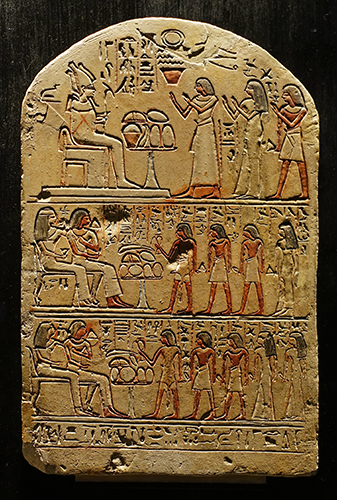
Eighteenth Dynasty: 1 550 BC - 1 292 BC
Khai
Stela of Khai, Follower of the King, circa 1 400 BC.
( In the top register Khai and his family adore Osiris before a table of offerings. Osiris is seated, and carries a Was sceptre as a symbol of power.
The two registers below each show the deceased and his wife seated at the Burial Feast, attended by servants - Don )
Catalog: Limestone, Gl.WAF 19
Photo: Don Hitchcock 2018
Source: Original, Ägyptischen Museum München
Text: Museum card, © Ägyptischen Museum München
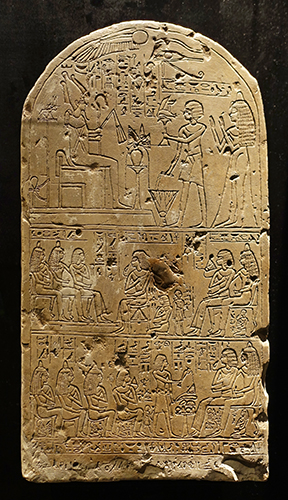
Eighteenth Dynasty: 1 550 BC - 1 292 BC
Amunherhetef
Stela of the Fan-bearer Amunherhetef, circa 1 380 BC.
( In the top register Amunherhetef and his wife adore Osiris, with Amunherhetef offering gifts. Osiris is seated, and carries the crook and flail as symbols of power.
The females in the registers below wear cones of perfume on their heads.
Perfume cones were presumably made of a mixture of oils, resins and fat, and containing myrrh. Images of the era show people wearing them on wigs or on shaved heads. The slow melting of the cones due to bodily heat would have spread the fragrance - Don )
Catalog: Limestone, ÄS 37
Photo: Don Hitchcock 2018
Source: Original, Ägyptischen Museum München
Text: Museum card, © Ägyptischen Museum München
Additional text: Wikipedia
Eighteenth Dynasty: 1 550 BC - 1 292 BC
Claquoirs / clapsticks
Circa 1 550 BC - 1 425 BC.
Fishnet decoration, in several fragments that have been glued back together.
Height 245 mm, width 34 mm, thickness 10 mm.
Catalog: Hippopotamus ivory, Aile Sully, Room 329 - Les loisirs, Vitrine 1, E 10827, AF 2654
Photo: Don Hitchcock 2015
Source and text: Original, Louvre Museum, Paris, France, https://collections.louvre.fr/
Eighteenth Dynasty: 1 550 BC - 1 292 BC
Pair of Claquoirs
Circa 2 106 BC - 1 069 BC
( I have placed these items in the 18th Dynasty for convenience and for comparison with the claquoirs above. They are within the age range of the 18th Dynasty - Don )
Musical instrument, clapper, Hathor headdress, pierced.
(upper) Incomplete; without hand; in several fragments that have been glued back together
(upper) Height 302 mm, width 74 mm, thickness 46 mm.
(upper) Catalog: Hippopotamus ivory, Aile Sully, Room 329, Les loisirs, Vitrine 1, N 1480, Champollion n°14, CC 243
(lower) In several fragments that have been glued back together
(lower) Height 354 mm, width 74 mm, thickness 45 mm.
(lower) Catalog: Hippopotamus ivory, Aile Sully, Room 329, Les loisirs, Vitrine 1, N 1479, Champollion n°14, CC 243
Photo: Don Hitchcock 2015
Source and text: Original, Louvre Museum, Paris, France, https://collections.louvre.fr/
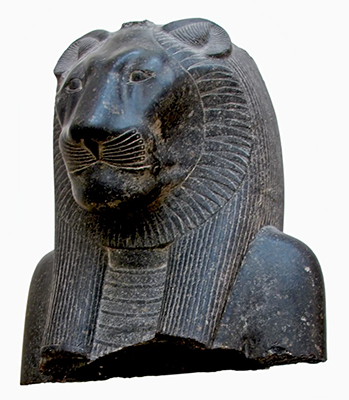
Eighteenth Dynasty: 1 550 BC - 1 292 BC
Sekhmet
The goddess Sekhmet with a lion's head. Sekhment was a sun and war goddess, the opposite of Bastet, the cat goddess. Granite. The temple of Mut in Luxor, circa 1 403 BC - 1 365 BC.
Photo: Don Hitchcock 2014
Source: Original, Københavns (Copenhagen) Museum, National Museum of Denmark
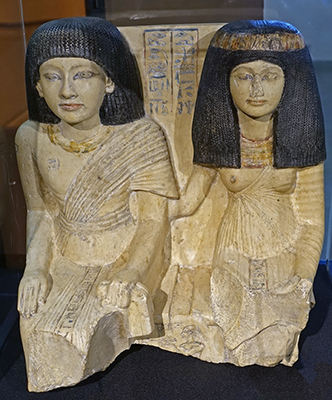
Eighteenth Dynasty: 1 550 BC - 1 292 BC
Ki-nebu and Isis
Seated group of the priest Ki-nebu and his wife Iset.
Iset or Aset is an Ancient Egyptian name, meaning '(She) of the throne'. It was the name of the goddess better known by her Greek name Isis.
Circa 1390 to 1353 BC, remodelled in the 20th Dynasty (Ramses VIII), circa 1140 BC.
The style and clothing of the figures clearly indicate that they were made at the end of the 18th Dynasty. Later, the group came into the possession of new owners and was adapted to the prevailing fashion.
Height 410 mm, width 405 mm, depth 310 mm.
If the tomb of the Amun priest Ki-nebu and his wife, the Amun musician Iset (Isis), did not contain an inscription by Ramesses VIII, this group would never have been dated to the end of the Ramesside period (19th - 20th Dynasties), since in its masterly execution and style it is directly attributable to the late 18th Dynasty. It is thus one of the last testimonies to the great courtly and elegant art of Thebes. Both spouses wear richly pleated dresses and heavy wigs, Iset with a wreath of flowers.
A characteristic criterion for all Egyptian group statues can be seen here: The spouses are sitting next to each other, the woman even puts her arm around the husband's back.
Nevertheless, this gesture remains purely symbolic, for attachment and affection are only implied, but not really developed.
Both remain in isolation, do not lean towards each other, but are aligned completely straight, i.e. not 'merged', but only 'added'.
This finding, which is in no way to be understood as a value judgement, is rooted in the Egyptian canon, which does not seek to reproduce a diagram, but rather a known content expressed in an abstract formula.
This form of objectivity is often broken in flat paintings and engravings from Ancient Egypt. But in group sculpture, however personal and sensitive the individual figure may be, it is not broken, even in Amarna art.
The surfaces of the base and the back plate are densely covered with inscriptions (names and prayers) and representations.
In front, between the couple is their son, offering incense. On the reverse side is Horus in the form of the god of the dead, Sokar / Seker. On the upper register, the jackal-headed Anubis tends the corpse of Osiris on the lion bed, with Isis and Nephtys standing at its ends.
Ki-nebu and Iset pour out a donation of water, thus assisting in the expectation that the god may grant them a similar dispensation in the hereafter. In the lower register, the couple receive the funeral sacrifice from their sons Amanhatpa and Hori.
Catalog: Limestone, painted, Thebes-West, from the collection of August Kestner, Inv. no. 2945
Photo: Don Hitchcock 2018
Source and text: Original, Museum August Kestner, Hannover
Additional text: Cramer (1936)
In the late Eighteenth Dynasty a new sort of anthropoid coffin came into use alongside the black-painted type. By the reign of Ramses II the new type had superseded the older.Text above from Robins (2008)
The ground was yellow, with decorations in red, light blue and dark blue, all covered by a varnish that has darkened over time and changed the blues to greens. The new scheme imitated gold and coloured inlay, and exceptional coffins used gold rather than paint. It became normal to show the forearms crossed on the chest underneath the elaborate collar through which the hands protrude. Women's hands were usually depicted open and men's clenched, holding amulets.
Below the collar a kneeling figure of the goddess Nut spreads her wings in protection. On the lower part of the lid the spaces between the bands of text show the deceased and deities, burial rites, and various scenes taken from the decorative repertory of tomb chapels. On the case Thoth and the four sons of Horus are still depicted.
Traditionally the coffin showed the deceased in an idealised form wearing the divine three part wig, and, if male, the long beard associated with male gods.

Eighteenth Dynasty: 1 550 BC - 1 292 BC
Gourd
Circa 1 388 BC - 1 350 BC, reign of Amenhotep III.
Decoration of festoons, geometric decoration, colours green, yellow, white, dark blue.
Height 90 mm, diameter 65 mm, thickness 41 mm.
Catalog: Glass, Thutmose III, Aile Sully, Room 334, Materials and Techniques, Vitrine 6, E 10805
Photo: Don Hitchcock 2015
Source and text: Original, Louvre Museum, Paris, France, https://collections.louvre.fr/
Eighteenth Dynasty: 1 550 BC - 1 292 BC
Long godet / mortar
Circa 1 427 BC - 1 353 BC
Length 120 mm, width 65 mm, height 21 mm.
The ink used by Egyptian scribes is made by burning organic materials such as wood or oil, and then pulverising the material before mixing it with water. To keep the particles from clumping together, the black is mixed with a binder, probably a plant gum from the Acacia tree family. As a valuable source of timber in Egypt, its branches may have also been used as the source for the charcoal. As well as keeping the carbon particles suspended in the water solution, the gum binder helps to keep the ink adhered to the papyrus surface. This ink is very stable, does not fade, and does not deteriorate the papyrus below as some metallic inks can do.
Another predominant colour seen on the papyrus is red, derived from the earth pigment iron oxide. Like most pigments used in ancient Egypt it is made from a naturally-occurring mineral, rather than an organic material derived from living sources such as plants. The mineral iron gives it its colour. The red was often used for rubrics such as titles and headings to distinguish them from the rest of the text. In the Book of the Dead red ink is often used to denote the beginning of spells.
The ancient Egyptians used reed brushes to write the text. These brushes looked somewhat like brushes today and allowed the scribe to vary the thickness of the line. They were held in a wooden (or sometimes ivory) palette which had a depression to hold the red and black inks.
Catalog: Black stone, AF 12754
Location: Aile Sully, Salle 335, Writing and the scribes, Vitrine 2
Photo (above): Don Hitchcock 2015
Photo (below): © Louvre Museum
Source and text: Original, Louvre Museum, https://collections.louvre.fr/
Additional text: https://www.brooklynmuseum.org/
Eighteenth Dynasty: 1 550 BC - 1 292 BC
Prince Thutmose
Relief of Prince Thutmose presenting offerings behind his father Amenhotep III, circa 1 360 BC
However, Prince Thutmose predeceased his father, and Amenhotep was ultimately succeeded by his second son, initially called Amenhotep IV.
It has long been theorised that Amenhotep III shared a coregency with his son and successor, Amenhotep IV (later called Akhenaten).
Catalog: Limestone, Sakkara, Gl. 93
Photo: Don Hitchcock 2018
Source: Original, Ägyptischen Museum München
Text: Museum card, © Ägyptischen Museum München
Additional text: Wikipedia

Eighteenth Dynasty: 1 550 BC - 1 292 BC
Arched stele
At the top of the arch is a shen ring, flanked by two wedjat eyes.
In the arch, left, a funeral meal. A man stands near the centre, wearing a loincloth and with a shaved head, his right arm extended. There is an offering table piled with gifts, a seated couple, with a child standing behind them, naked, finger in mouth, and wearing a childhood wick. On the right is a man offering a censer, wearing a loincloth and panther skin, pouring libations from a hes vase. In front of him is a seated woman on a well made chair.
On the second register of the arch are a group of relatives, two men and four women, seated on the floor, each with the left arm folded over the chest.
The offering formula is a hymn to Osiris from the Book of the Dead, Chapter 185A:
'... Hail to thee, Osiris, lord of eternity, king of the gods, whose names are many, whose manifestations are sublime, whose forms are mysterious in the temples... The plants grow at his desire, the soil gives birth to food for him... he whose function is lasting, whose government is well established...
Isis the beneficent, the one who protects her brother, who seeks him without tiring, who travels this country in her mourning; she did not stop until she found him. She is the one who shades him with her feathers, gives him air with her wings, performs the rites of jubilation and buries his brother.
It is she who raises what is sagging in the god with a failing heart, who extracts his seed, who procreates an heir, who nurses the child in solitude, without anyone knowing where he was..."
Names and titles: Imenmes (director of Amun's cattle); Henout (mother, mistress of the house); Nefertiry (wife, mistress of the house); Imenemhat (son); Imenemwia (son); Satmut (son); Imenqen (son); Merymaat (daughter); Satimen (daughter); Soumout (daughter); Houymnetcher (daughter); Baket (mistress of the house); Saiy (First priest, interpreter of Osiris); Osiris.
Height 1060 mm, width 620 mm.
Catalog: Limestone, painted, Aile Sully, Salle 323, Crypte d'Osiris, Vitrine 9, E 13482 BIS, C 286
Location: Abydos, El-Araba el-Madfouna
Photo: Don Hitchcock 2015
Source and text: Original, Louvre Museum, Paris, France, https://collections.louvre.fr/
Eighteenth Dynasty: 1 550 BC - 1 292 BC
Neferhebef
Neferhebef, his wife and son.
Limestone, the most common stone in the north of the country, is of varying fineness and quality depending on the quarry.
( it would appear that the museum curator is gently bringing attention to the poor quality of the limestone used in this particular group statue. In addition, the quality of workmanship is, in my opinion, fair at best - Don )
Neferhebef is seated, wearing a kilt, a wig with curls, and holding his wife by the waist. His wife Taiounes is seated beside him, wearing a dress and a wraparound wig, and an Usekh necklace. This is a type of broad collar or necklace. Deities, women, and men were depicted wearing this jewellery. It is typically adorned with closely placed rows of coloured stone beads, or it is made entirely of metal. The collars were connected with clasps of gold.
At their feet is their son, Benermerout, seated, with one knee up.
Height 350 mm, width 178 mm, depth 185 mm.
The style places this piece within the reigns of Thutmose III and Amenhotep II, his son.
Catalog: Limestone, painted, Thebes, Aile Sully, Room 334, Materials and Techniques, Vitrine 4, A 57, N 58
Photo: Don Hitchcock 2015, 2018
Source and text: Original, Louvre Museum, Paris, France, https://collections.louvre.fr/
Additional text: Wikipedia
Eighteenth Dynasty: 1 550 BC - 1 292 BC
Neferhebef
Four funerary cones from the tomb of Neferhebef.
Circa 1 400 BC
Neferhebef was a priest of Amenhotep II
Far left: EA9687: Diameter 80 mm, length 185 mm.
Catalog: Limestone, Thebes, EA9687, EA9673, EA9677, EA9679
Photo: Don Hitchcock 2018
Source: Original, British Museum
Text: Card with the display at the British Museum, https://www.britishmuseum.org/, © Trustees of the British Museum, CC BY-NC-SA 4.0
Eighteenth Dynasty: 1 550 BC - 1 292 BC
Spoon in the shape of an Oryx
This cosmetics spoon has been identified as being of Egyptian Blue, or Cuprorivaite. This is a pigment with the formula CaCuSi
The powder was moulded and annealed to make beads and small objects.
Egyptian blue shows exceptional luminescence in the near-infrared region. This means that the pigment can be easily detected in a completely non-destructive fashion simply by illuminating ancient works of art with near-infrared radiation. The luminescence is so strong that the presence of minute amounts of Egyptian blue can be detected even when no blue colour is visible to the naked eye. The British Museum was able to use this technique to provide the first proof that the Elgin Marbles had once been painted, finding the pigment on several sculptures from the Parthenon.
Length 135 mm, width 60 mm.
Catalog: Egyptian Blue, Aile Sully, Room 334, Materials and Techniques, Vitrine 6, E 3217
Photo: Don Hitchcock 2018
Source and text: Original, Louvre Museum, Paris, France, https://collections.louvre.fr/
Additional text: https://edu.rsc.org/resources/egyptian-blue/1625.article, https://www.chemistryworld.com/features/egyptian-blue-more-than-just-a-colour/9001.article
Eighteenth Dynasty: 1 550 BC - 1 292 BC
Statue of Ib
Standing, left foot forward, left arm folded over chest, right arm swinging, closed fist, kilt with apron, short curly wig, arm bracelet.
Names and titles: Ib, guardian of the house of money, child of kap.
Height 299 mm, length 164 mm, width 74 mm.
Hieroglyphs filled with whitish-blue coloured paste.
Catalog: Boxwood, jujube, Heliopolis (Lower Egypt, Eastern Delta), Aile Sully, Room 334, Materials and Techniques, Vitrine 3, N 1574, Drovetti no. 53
Photo: Don Hitchcock 2015, 2018
Source and text: Original, Louvre Museum, Paris, France, https://collections.louvre.fr/
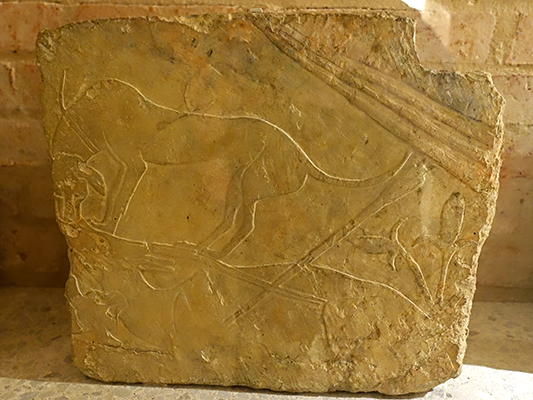
Eighteenth Dynasty: 1 550 BC - 1 292 BC
Hunting scene
Two hounds have pulled down a scimitar-horned oryx.
Limestone, ÄM 31200
Photo: Don Hitchcock 2018
Source: Original, Staatliche Museen zu Berlin, Neues Museum, Germany
Text: © Card at the Staatliche Museen zu Berlin, (CC BY-NC-SA 3.0 DE)
Eighteenth Dynasty: 1 550 BC - 1 292 BC
Pa-aa
This papyrus contains the text of the magical spells recited by the
lector priest at the mortuary cult, and was prepared for the funeral
or cult of a scribe named Pa-aa.
The papyrus roll is inscribed with a mortuary liturgy in hieratic script.
Circa 1 550 BC - 1 295 BC.
Length 790 mm (frame), width 197 mm (frame).
Catalog: EA10819,1
Photo: Don Hitchcock 2018
Source: Original, British Museum
Text: Card with the display at the British Museum, https://www.britishmuseum.org/, © Trustees of the British Museum, CC BY-NC-SA 4.0
Eighteenth Dynasty: 1 550 BC - 1 292 BC
Baket
Two seated figures of Baket, circa 1 500 BC
In the inscription it says that Baket is to be supplied with speech offerings in the hereafter. Her posture corresponds to the relief of Dschefanesut (Jefanesut): Baket also holds one hand in front of her chest and the other is lying on her thigh and 'reaches' for offerings before her, but these are only mentioned in the inscription on her seat and are not really placed in front of her.
The statuettes were donated to Baket 'by her brother (i.e. husband), Aman-wen-her, who (always) keeps her name alive' and thus she will be eternal in the hereafter.
(left) Height 136 mm, width 51 mm, depth 94 mm.
Catalog: Limestone, painted, Thebes, (left) Inv. Nr. 1935.200.107
Photo: Don Hitchcock 2018
Source and text: Original, Museum August Kestner, Hannover
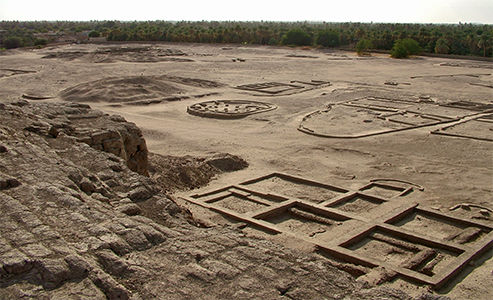
Kerma was the capital city of the Kerma Culture, which was located in present-day Sudan at least 5500 years ago. Kerma is one of the largest archaeological sites in ancient Nubia. It has produced decades of extensive excavations and research, including thousands of graves and tombs and the residential quarters of the main city surrounding the Western/Lower Deffufa.
Around 3 000 BC, a cultural tradition began around Kerma. It was a large urban centre that was built around a large adobe temple known as the Western Deffufa.
Photo: Lassi via Wikipedia
Permission: Creative Commons Attribution-Share Alike 4.0 International, 3.0 Unported, 2.5 Generic, 2.0 Generic and 1.0 Generic license
Text: Adapted from Wikipedia
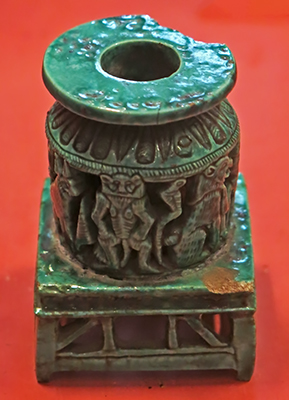
Eighteenth Dynasty: 1 550 BC - 1 292 BC
Kohl Pot
Green kohl pot with flat rim and foot.
Early 18th Dynasty, circa 1 550 BC - 1 425 BC
Decorations include a parade of animals including a cat, snake, lion, and the household god Bes.
Height 60 mm, width 43 mm, thickness 43 mm.
Catalog: Glazed soapstone, openwork, Aile Sully, Room 334, Materials and Techniques, Vitrine 6, N 1362
Photo: Don Hitchcock 2015
Source and text: Original, Louvre Museum, Paris, France, https://collections.louvre.fr/
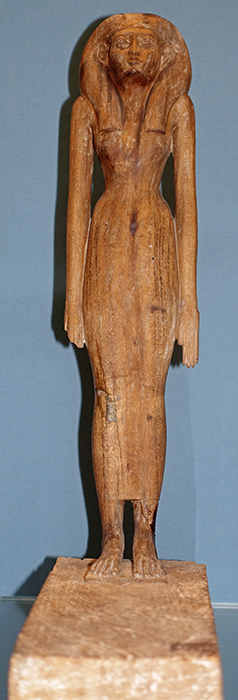
Eighteenth Dynasty: 1 550 BC - 1 292 BC
Wooden Statuette
Wooden statuette of a woman.
Early 18th Dynasty, circa 1 500 BC
Wooden female figure: when it was new, this wooden statuette would have been fully painted to show the two straps of the woman's white dress, perhaps a necklace, and most probably her name, on the base. The figure stands with her feet together and her open hands at her sides.
The palms, however, do not face her body, but are turned toward the back in a reverential or prayerful gesture. Her narrow torso, wasp waist, bony hips, and long, swelling thighs represent the ideal of female beauty in the Middle Kingdom. In this case, the effect is fairly natural.
It is startling to turn from the stylish, youthful body to its stern, heavy, mature-looking face. The woman's narrowed, hooded eyes and full cheeks indicate that the model for this statue was that of King Amenemhat III.
Height 320 mm, length (plinth) 177 mm, width (plinth) 75 mm.
Catalog: Wood, EA2373
Photo: Don Hitchcock 2018
Source and text: Original, Louvre Museum, Paris, France, https://collections.louvre.fr/
Eighteenth Dynasty: 1 550 BC - 1 292 BC
Incense Tongs
Bronze incense-tongs with the terminals in the form of hands and the arms decorated with incised representations of bracelets.
Length 353 mm, width 10 mm.
Catalog: Bronze, el-Amarna, EA59284
Photo: Don Hitchcock 2018
Source: Original, British Museum
Text: Card with the display at the British Museum, https://www.britishmuseum.org/, © Trustees of the British Museum, CC BY-NC-SA 4.0
Eighteenth Dynasty: 1 550 BC - 1 292 BC
Model of an Adze
Wooden model of an adze for the 'Opening of the Mouth' ritual, bearing the name of the King's son Nehy.
Circa 1 450 BC.
Length 102 mm.
Catalog: Wood, EA15779
Photo: Don Hitchcock 2018
Source: Original, British Museum
Text: Card with the display at the British Museum, https://www.britishmuseum.org/, © Trustees of the British Museum, CC BY-NC-SA 4.0
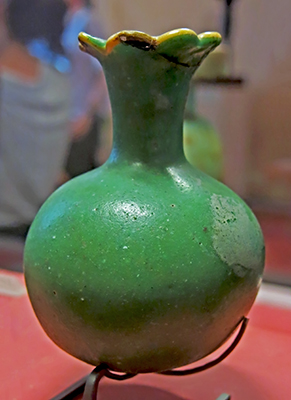
Eighteenth Dynasty: 1 550 BC - 1 292 BC
Glass Vase
Green Glass Vase in the shape of a pomegranate.
Height 105 mm, length 35 mm, diameter 78 mm.
Catalog: Light green glass, Amarna Period, Aile Sully, Room 334, Materials and Techniques, Vitrine 6, E 11224, AF 1571
Photo: Don Hitchcock 2015
Source and text: Original, Louvre Museum, Paris, France, https://collections.louvre.fr/
Eighteenth Dynasty: 1 550 BC - 1 292 BC
Amenhotep II
Head from a sphinx of Pharaoh Amenhotep II.
New Kingdom, circa 1 420 BC
Catalog: Granodiorite, Armant, Cache of the Karnak Temple(?), ÄS 500
Photo: Don Hitchcock 2018
Source: Original, Ägyptischen Museum München
Text: © Ägyptischen Museum München
Eighteenth Dynasty: 1 550 BC - 1 292 BC
Mentechenu
Mentechenu, an official from the time of Amenhotep II, was ' the Captain of the Guard at the gate of the royal palaces ', with the honorary rank of ' wrist-bearer on the right hand of the king '. As a sign of his rank he holds a small ostrich feather in his left hand. Another of his titles is 'Fanbearer of the King'. He is dressed in a long robe, which shows the right breast above the waist.
Around his neck Mentechenu wears two chains of golden rings, the so-called ' gold of bravery '. This award may indicate that he was a career officer, although the inscriptions only cite the official titles from his civilian career. It was customary, however, to appoint officers who had been discharged from the service into the state or priestly administrative apparatus. The inscriptions characterise the portrait as a temple figure.
Height 830 mm, circa 1 450 BC - 1 425 BC.
Catalog: Granodiorite, Thebes - Karnak, ÄM 19289
Photo: Don Hitchcock 2015, 2018
Source: Original, Staatliche Museen zu Berlin, Neues Museum, Germany
Text: © Card at the Staatliche Museen zu Berlin (CC BY-NC-SA 3.0 DE)
Eighteenth Dynasty: 1 550 BC - 1 292 BC
Figure
Head from a statue of Thutmose IV wearing the Blue Crown.
Thutmose IV was the son of Amenhotep II and Tiaa, and ruled for ten years.
Catalog: Circa 1380 BC, ÄS 6770
Photo: Don Hitchcock 2018
Source: Original, Ägyptischen Museum München
Text: © Ägyptischen Museum München

Eighteenth Dynasty: 1 550 BC - 1 292 BC
Thutmose IV
Armguard of King Thutmose IV, defeating enemies before the war god Montu.
Dimensions: 45 x 120 x 60 mm (incl. Base)
Catalog: Ivory, from Q 48.01, A small group of houses at Amarna, AE 21685
Photo: Don Hitchcock 2018
Source: Original, Staatliche Museen zu Berlin, Neues Museum, Germany
Text: © Card at the Staatliche Museen zu Berlin, (CC BY-NC-SA 3.0 DE)
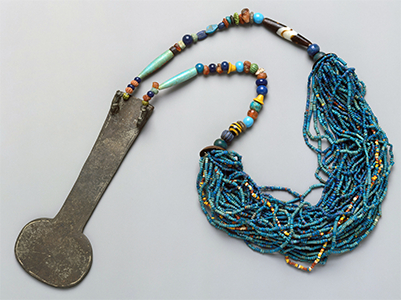
Eighteenth Dynasty: 1 550 BC - 1 292 BC
Complete Menat
Reign of Amenhotep III, circa 1 388 BC – 1 350 BC.
A menat necklace consists of a heavy, keyhole-shaped counterpoise (menat) and many strands of beads. Although the necklace is sometimes shown being worn, it was more often carried by females participating in religious ceremonies. It functioned as a percussion instrument that was shaken to create a soothing noise that was thought to appease a god or goddess. In the New Kingdom the menat necklace and sistrum were attributes of women who held the title 'Singer of Amun-Re' such as Renenutet, who is depicted holding her menat on her lap in a statue.
In the early 20th century, the Museum conducted excavations at Malqata, a site at the southern end of the Theban necropolis where Amenhotep III had built a festival city for the celebration of his three jubilees (or heb seds). This miraculously preserved menat necklace and two single-strand necklaces of beads and amulets were found in the corner of a room in a private house near the King's Palace. According to the excavators, the three necklaces had been placed in a linen bag, traces of which were still visible.
Dimensions: Length of counterpoise 147 mm.
Catalog: Faience, bronze or copper alloy, glass, agate, carnelian, lapis lazuli, turquoise, Thebes, Malqata, Birket Habu Mound B 1, Private House B, MMA excavations, 1911–12, Accession Number 11.215.450
Photo: CC0 1.0, Public Domain ![]()
Source: https://www.metmuseum.org/art/collection/search/544509
Text: https://www.metmuseum.org/art/collection/search/544509
Eighteenth Dynasty: 1 550 BC - 1 292 BC
Princess Sitamun/Sitamen
Reign of Amenhotep III, circa 1 388 BC – 1 350 BC.
A sandstone block fragment from the temple of king Amenhotep II on the west bank at Thebes, with raised relief, and a preserved area with the head of Princess Sitamun, daughter of Amenhotep III, wearing a vulture headdress and holding a floral sceptre, facing right, and above part of her name in a cartouche.
Sitamun is considered to be the eldest daughter of Pharaoh Amenhotep III and his Great Royal Wife Tiye. She was later married to her father around Year 30 of Amenhotep III's reign.
Height 565 mm, width 490 mm, Accession Number LDUCE-UC14373.
Photo: Don Hitchcock 2018
Source: Original, Petrie Museum, London, England
Text: Card / online catalogue, the Petrie Museum, © 2015 UCL. CC BY-NC-SA license.
Additional text: Wikipedia
Eighteenth Dynasty: 1 550 BC - 1 292 BC
Nile Landscape
Fragment of a palace floor: Nile landscape, circa 1 360 BC
Catalog: Plaster, West Thebes, Malqata, Gl. 74
Photo: Don Hitchcock 2018
Source: Original, Ägyptischen Museum München
Text: Museum card, © Ägyptischen Museum München
Eighteenth Dynasty: 1 550 BC - 1 292 BC
Papyrus knife
Handle in the form of a duck neck and head, bronze, length 245 mm, width 30 mm, thickness 5 mm. Middle 18th Dynasty.
Catalog: Bronze, West Thebes, E 3673
Photo: Don Hitchcock 2018
Source and text: Original, Louvre Museum, Paris, France, https://collections.louvre.fr/
Scribes' palettes
(left)
Eighteenth Dynasty: 1 550 BC - 1 292 BC
Scribe's palette with two round cups, calamus (writing pens made from a hollow reed), ink.
An inscription/dedication/signature to Tutankhamun.
Length 370 mm, width 55 mm, thickness 13 mm.
Catalog: Wood, writing implements, ink, Thebes, Room 335 Aile Sully, Level 0, N 2241.
(right)
Nineteenth Dynasty: 1 292 BC - 1 187 BC
Scribe's palette with 7 oblong cups, calamus, and ink.
It bears an inscription naming Sety I , 1 290 BC - 1 276 BC.
Height 410 mm, width 52 mm, thickness 12 mm.
Catalog: Wood, writing implements, ink, Thebes, Room 335 Aile Sully, Level 0, N 2274
Photo: Don Hitchcock 2018
Source and text: Original, Louvre Museum, Paris, France, https://collections.louvre.fr/
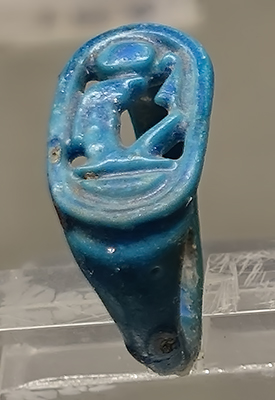
Eighteenth Dynasty: 1 550 BC - 1 292 BC
Amenhotep III Ring
Faience personalised ring in the form of a signet ring.
Diameter 21 mm x 25 mm.
The ring plate is rendered as openwork and shows, as if enclosed in a cartouche, the three hieroglyphs of the throne name Amenhotep III, Nebmaatre, Neb-Maat-Re - Lord of the divine world order is ( the sun god ) Re.
Despite the beautiful cobalt blue glaze, however, it can be assumed with some certainty that the ring did not belong to the king himself, but was given by him as a token of honour.
The name here perhaps also stands for that of a protective deity, for at least in Nubia Amenhotep III / Amenophis III, like kings of the Middle Kingdom before him, had himself divinely worshipped.
Comparable to this are the commemorative scarabs of this ruler, albeit much more elaborate, in which he immortalised various events of his reign that seemed essential to him and which he openly presented to dignitaries who were particularly worthy of distinction.
Catalog: Faience, place of discovery unknown, Inv.no. 1935.146
Photo: Don Hitchcock 2018
Source and text: Original, Museum August Kestner, Hannover

Eighteenth Dynasty: 1 550 BC - 1 292 BC
Amenhotep III
Commemorative scarab of Pharaoh Amenhotep III with a report on lion hunts.
Catalog: Steatite, ÄS 1594
Photo: Don Hitchcock 2015
Source: Original, Ägyptischen Museum München
Text: Museum card, © Ägyptischen Museum München

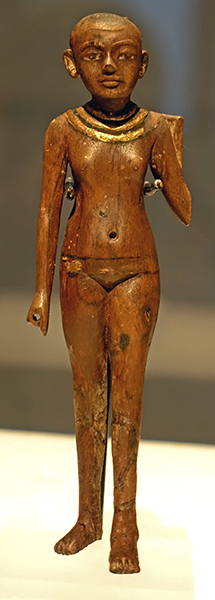
Eighteenth Dynasty: 1 550 BC - 1 292 BC
Nubian female servant
Wooden figurine of a female servant, carrying an object on the left shoulder, the left forearm is lost. It is possibly a cosmetic item, funerary equipment, Amenophis III / Amenhotep III (?), 1 388 BC - 1 350 BC
Partially painted, with the remains of gilded pastiglia.
Pastiglia is an Italian term meaning 'pastework', and consists of low relief decoration, normally modelled in gesso or white lead, applied to build up a surface that may then be gilded or painted, or left plain.
Dimensions: 135 x 40 x 30 mm.
Catalog: Wood, Thebes West (?) ÄM 14389
Photo: Don Hitchcock 2018
Source: Original, Staatliche Museen zu Berlin, Neues Museum, Germany
Text: © Card at the Staatliche Museen zu Berlin, http://www.smb-digital.de/ (CC BY-NC-SA 3.0 DE)
Additional text: http://www.griffith.ox.ac.uk/gri/3berlin.pdf, Wikipedia
Eighteenth Dynasty: 1 550 BC - 1 292 BC
King Amenhotep III as a lion
Reign of Amenhotep III (circa 1 388 - 1 350 BC)
This pair of statues guarded a temple at Soleb, Upper Nubia, present day Sudan. Built in the heart of Kush, a land where many Egyptians settled, this was their largest temple on foreign soil. In it they worshipped the supreme god Amun-Ra and the king, deified as 'lord of Nubia'. The lions represent Amenhotep himself.
The statues declare the king's might by representing him as a lion. Pharaohs were often shown as a sphinx with the body of a lion, but the full lion image is rare. An inscription on the chest, added by Amenhotep IV, calls Amenhotep III a 'lion of rulers, wild when he sees his enemies tread his path'. In the fifth year of his reign, Amenhotep IV changed his name from Amenhotep ('Amon Is Content') to Akhenaten ('Beneficial to Aton').
The sculptures are famed for their realistic anatomical detail and depart from the frontality of most Egyptian statues. The eyes were originally inlaid.
Amenhotep III commissioned the lion sculptures for the temple of Amun-Ra at Soleb in Upper Nubia, in the conquered former kingdom of Kush. The next king, Amenhotep IV, ensured that both reached Soleb after his father's untimely death. In the text on the base, Amenhotep III is honoured by his grandson, Tutankhamun. A thousand years later the statues so impressed the Kushite ruler Amanislo that he moved them 500 km south to the city of Napata. Aminoslo's names appear on the left foreleg.
( This addition of Amanislo's names may be made out on the lowest of the four images above, at the left foreleg elbow. - Don )
Catalog: Napata (Gebel Barkal, Sudan); originally from Soleb (Sudan), granite, EA1
Photo: Don Hitchcock 2018
Source: Original, British Museum
Text: Card with the display at the British Museum, © Trustees of the British Museum, CC BY-NC-SA 4.0, http://www.britishmuseum.org/
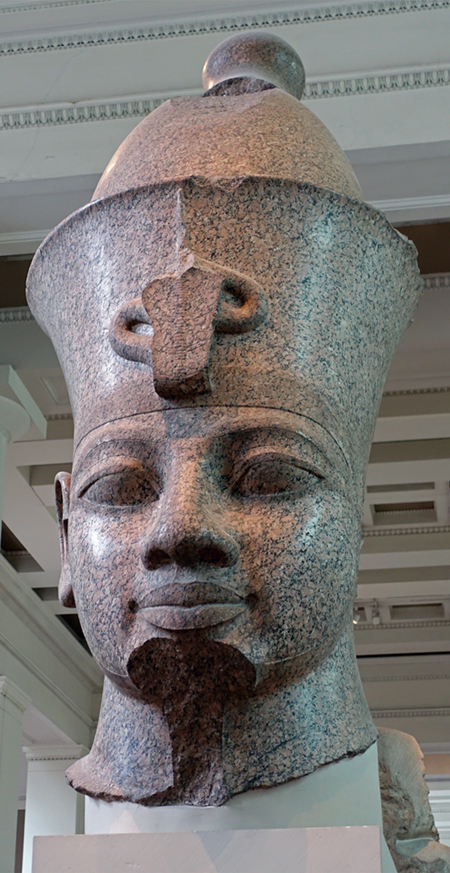
Eighteenth Dynasty: 1 550 BC - 1 292 BC
King Amenhotep III
Head from a monumental red granite statue of Amenhotep III, circa 1 370 BC.
Height: 2900 mm, weight 3 600 kilograms.
Curator's comments:
This statue, wearing the double crown of Upper and Lower Egypt, was found in front of the temple of Khonsupakhered in the temple enclosure of Mut at Karnak. It is uncertain whether it was originally erected there. An arm from the statue is also in the Museum (Big Number EA55), while the body has been identified in the Mut enclosure. This head was stored in Cairo apparently in the house of Signor Rossi in 1818, according to FitzClarence, as reported by Manley and Ree, Henry Salt, p 150:
This head was stored in Cairo apparently in the house of Signor Rossi in 1818, according to FitzClarence, as reported by Manley and Ree, Henry Salt, p 150:
'One evening Salt took him to call on Signor Rossi, where he had deposited some interesting items brought from the neighbourhood of Thebes, including a head of 'Orus', "10 feet from the top of the mitre to the chin, having a band at the bottom part of it not unlike a turban ... made of red granite ... and in a very fine state of preservation ... an arm 18 feet long of the same statue with the fist clenched." '
Catalog: red granite, Uqsur, el- (Governorate): Karnak (Thebes): Temple of Khonspakhered, EA15
Photo: Don Hitchcock 2015, 2018
Source: Original, British Museum
Text: Card with the display at the British Museum, © Trustees of the British Museum, CC BY-NC-SA 4.0, www.britishmuseum.org/

Eighteenth Dynasty: 1 550 BC - 1 292 BC
King Amenhotep III
Left arm from the monumental red granite statue of Amenhotep III (above).
Height 550 mm, length 3280 mm, width 850 mm.
Catalog: red granite, Uqsur, el- (Governorate): Karnak (Thebes): Temple of Khonspakhered, EA55
Photo: Don Hitchcock 2018
Source: Original, British Museum
Text: Card with the display at the British Museum, © Trustees of the British Museum, CC BY-NC-SA 4.0, www.britishmuseum.org/
Eighteenth Dynasty: 1 550 BC - 1 292 BC
King Amenhotep III
Feet of a royal colossus reinscribed by Amenhotep III. From the great court of his funeral temple at Thebes.
Circa 1 388 BC - 1 350 BC.
Around the base are the names of defeated peoples.
Height 1590 mm, width 1440 mm, depth 2240 mm, weight 7 000 kg.
Catalog: Pink granite, Kom el-Heitan (West Thebes), Mortuary temple of Amenhotep III, N 18, A 18, Salt n° 3831
Location: Sully, Salle 324
Photo: Don Hitchcock 2015
Source and text: Original, Louvre Museum, https://collections.louvre.fr/
Royal sarcophagi of the New Kingdom in the Valley of the Kings
The mummies of kings were enclosed in up to three coffins of increasing size, of gilded wood or precious metal. These were placed in an outer stone coffin or sarcophagus. The design of kings' sarcophagi evolved throughout the New Kingdom. Those of the 18th Dynasty (about 1550-1295 BC) were carved from quartzite or granite, rectangular in shape and sometimes rounded at the head.
In the 19th Dynasty as many as four sarcophagi, of different stones and varying designs, were sometimes provided. In the 19th and 20th Dynasties, the innermost sarcophagus was of polished calcite (Egyptian alabaster), imitating the shape of the body and covered with scenes and inscriptions from the Book of Gates. This funerary text described the sun god's nocturnal journey through the underworld. The finest sarcophagus of this type was found in the tomb of Sety I (and is now in the Sir John Soane Museum, London).
Fragments from other tombs indicate that later kings including Ramesses II and Merenptah possessed similar sarcophagi.
Source: Poster, British Museum
Text: Poster at the Museum, © Trustees of the British Museum, CC BY-NC-SA 4.0
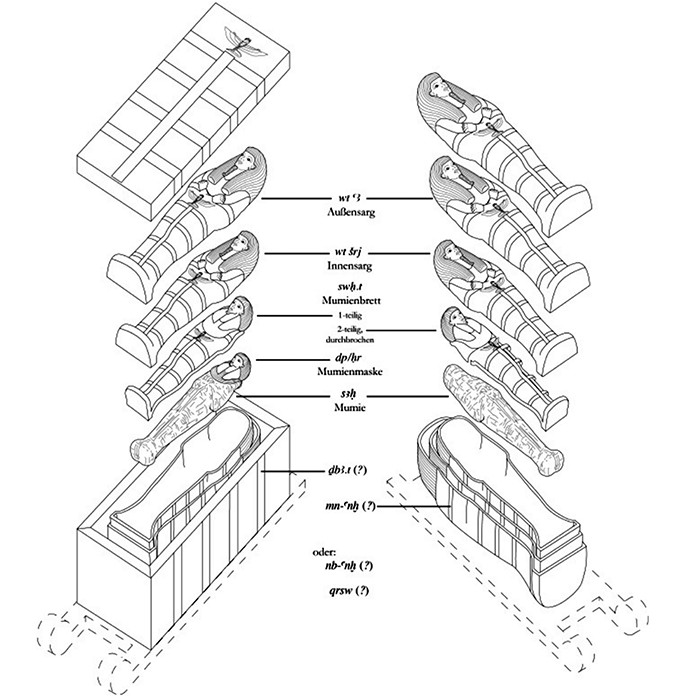
Private coffin and sarcophagus terms in the New Kingdom and their position in the ensemble.
Photo and text: Böhme (2013)
Eighteenth Dynasty: 1 550 BC - 1 292 BC
Nehi
Sarcophagus case of Nehi, circa 1 390 BC - 1 350 BC
Nehi (or Nehy) was an Ancient Egyptian official with the titles of a viceroy of Kush - the governor of the Nubian provinces which were under Egyptian control. Nehy was in office under Thutmose III. In the 23rd year of Thutmose III he followed the king on his campaign to Syria. There are several inscriptions of Nehy found in Nubia, attesting building activity at several places. Nehy was buried at Thebes although the exact location of his tomb is lost. However, in the Egyptian Museum of Berlin is preserved his monumental sarcophagus. Sarcophagi for officials are rare in this period providing evidence for the high social status of Nehy in his time.
Thebes. TT D.1. Nehi.
Sethe Urk. iv, 982-3 [284 A] a-c; Aeg. Inschr. ii, 597-601.
Catalog: Sandstone, ÄM 17895
Photo: Don Hitchcock 2015, 2018
Source: Original, Staatliche Museen zu Berlin, Neues Museum, Germany
Text: © Card at the Staatliche Museen zu Berlin, (CC BY-NC-SA 3.0 DE)
Additional Text: http://www.griffith.ox.ac.uk/gri/3berlin.pdf, Wikipedia

Eighteenth Dynasty: 1 550 BC - 1 292 BC
Sobeknakht
Stela of the hereditary Prince Sobeknakht
( Note that there appears to be more than one Sobeknakht at this period, including a Princess Sobeknakht - Don )
New Kingdom, 18th Dynasty circa 1 380 BC Kalzitalabaster (fine calcite like alabaster).
Catalog: Quarries of Amarna (?) Gl. WAF 28
Photo: Don Hitchcock 2018
Source: Original, Ägyptischen Museum München
Text: © Ägyptischen Museum München
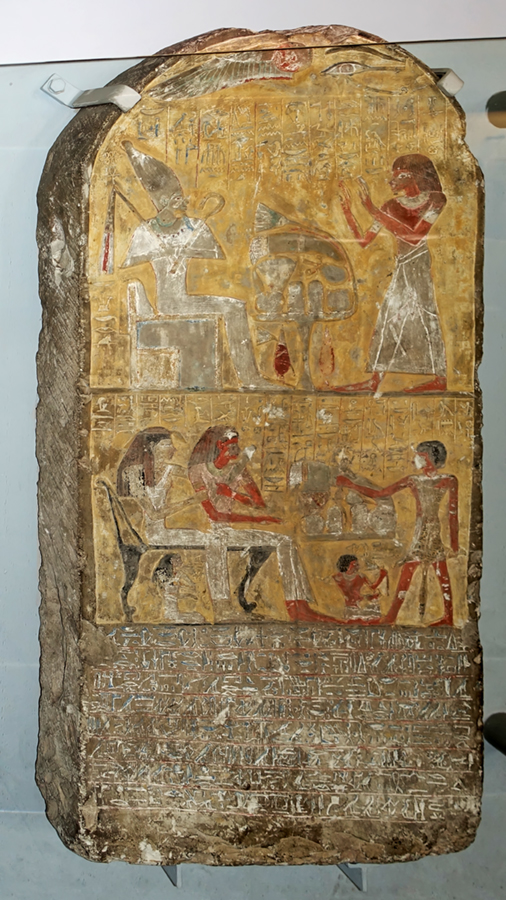
Eighteenth Dynasty: 1 550 BC - 1 292 BC
Sapair
Round-topped limestone stela of Sapair bearing painted sunk relief divided into three registers:
1 - Deceased worshipping the enthroned figure of Osiris; eleven columns of incised Hieroglyphic text and a single-winged disc above.
2 - Deceased seated with sister receiving offerings from his son; sixteen columns of Hieroglyphic text above.
3 - Eight rows of Hieroglyphic text.
Height 1160 mm, width 580 mm.
Catalog: Limestone, painted, EA906
Photo: Don Hitchcock 2018
Source: Original, British Museum
Text: Card with the display at the British Museum, © Trustees of the British Museum, CC BY-NC-SA 4.0, www.britishmuseum.org/

Eighteenth Dynasty: 1 550 BC - 1 292 BC
Ptah
Head from a collosal figure of the god Ptah.
Circa 1 370 BC
Catalog: Greywacke, Gl. 80
Photo: Don Hitchcock 2018
Source: Original, Ägyptischen Museum München
Text: © Ägyptischen Museum München
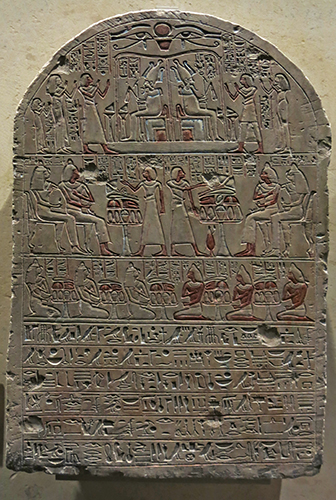
Eighteenth Dynasty: 1 550 BC - 1 292 BC
Sobeknakht
Stela of the Overseer of the Temple of Amun, Sobeknakht, with an offering formula.
Circa 1 350 BC.
Catalog: Painted limestone, Abydos, ÄS 38
Photo: Don Hitchcock 2015
Source: Original, Ägyptischen Museum München
Text: Museum card, © Ägyptischen Museum München

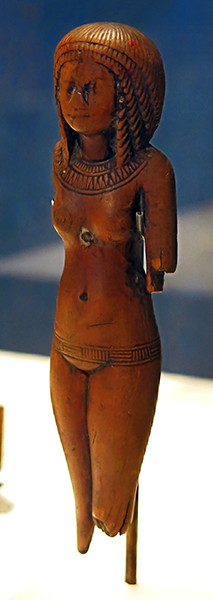
Eighteenth Dynasty: 1 550 BC - 1 292 BC
Nude Girl
Statue of a nude girl, left forearm, right arm and feet lost, possibly a mirror-handle, wood, late Eighteenth Dynasty.
Catalog: Wood, ÄM 12463
Photo: Don Hitchcock 2015, 2018
Source: Original, Staatliche Museen zu Berlin, Neues Museum, Germany
Text: © Card at the Staatliche Museen zu Berlin, (CC BY-NC-SA 3.0 DE)
Additional text: http://www.griffith.ox.ac.uk/gri/3berlin.pdf
Eighteenth Dynasty: 1 550 BC - 1 292 BC
The Scribe Tjaj and the god Thoth
The Scribe Tjaj in front of the god Thoth, patron of scribes, in the shape of a baboon.
Amenophis III / Amenhotep III (?), circa 1388 - 1350 BC.
Catalog: Wood, serpentine ÄM 20001
Photo: Don Hitchcock 2018
Source: Original, Staatliche Museen zu Berlin, Neues Museum, Germany
Text: © Card at the Staatliche Museen zu Berlin, (CC BY-NC-SA 3.0 DE)
Additional text: http://www.griffith.ox.ac.uk/gri/3berlin.pdf
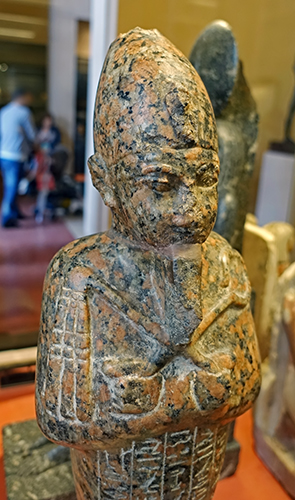
Eighteenth Dynasty: 1 550 BC - 1 292 BC
Amenhotep III / King Amenophis III
Mummiform shabti of King Amenhotep III / Amenophis III, found in his tomb in the Valley of the Kings, at KV 33.
The granite used for this and other artefacts, always predominantly pink, was extracted from quarries southeast of Aswan, as was diorite.
The shabti is standing, with a false beard and wearing the Hedjet or White Crown of Egypt, arms crossed, holding the crook and flail. Toby Wilkinson, Egyptologist and academic notes that the flail, used to goad livestock, was a symbol of the ruler's coercive power: as shepherd of his flock, the ruler encouraged his subjects, denoted by the flail, as well as restraining them, symbolised by the crook.
Height 542 mm, width 160 mm, thickness 113 mm.
Catalog: Pink granite, Western Valley of Thebes, Aile Sully, Room 334, Materials and Techniques, Vitrine 4, N 467, E 27488, Salt n°3362
Photo: Don Hitchcock 2015, 2018
Source and text: Original, Louvre Museum, Paris, France, https://collections.louvre.fr/
Additional text: Wikipedia

Eighteenth Dynasty: 1 550 BC - 1 292 BC
Scribe
Statuette of a scribe in the style of the time of Pharaoh Amenhotep III. Late 18th Dynasty
Amenhotep III/IV , circa 1388 - 1334 BC.
Catalog: Dark stone, Amarna, House O 47.7, serpentine ÄM 22621
Photo: Don Hitchcock 2018
Source: Original, Staatliche Museen zu Berlin, Neues Museum, Germany
Text: © Card at the Staatliche Museen zu Berlin, (CC BY-NC-SA 3.0 DE)
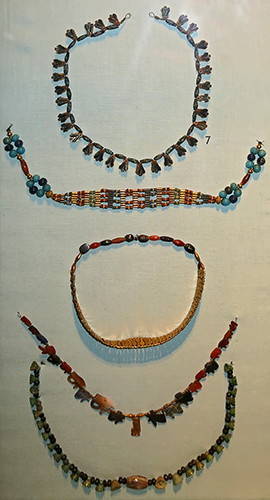
Eighteenth Dynasty: 1 550 BC - 1 292 BC
Necklaces
The fly-shaped necklaces symbolise courage and tenacity. They are given to soldiers as an award.
Catalog: Gold, glass; location unknown, circa 1 500 - 1 300 BC.
Photo: Don Hitchcock 2014
Source and text: Original, Rijksmuseum van Oudheden, National Museum of Antiquities, Leiden
Shabtis: servants for the afterlife
The ancient Egyptian idea of the afterlife included the possibility that the dead might have to carry out agricultural labour. This could be avoided by having small mummy-shaped figurines of the deceased, known as shabti, shawabti or ushabti. These figures, made of stone, wood, faience, pottery and sometimes bronze, would magically perform work on behalf of their owner.Text above: Poster at the British Museum, © Trustees of the British Museum, CC BY-NC-SA 4.0
They were a regular feature of tomb equipment from the Middle Kingdom to the Ptolemaic period (about 2000-30 BC). Originally, the shabti acted as a substitute for its owner, but it later came to be regarded more as a servant, and its character as an agricultural labourer was highlighted by the representation of tools held in the hands. The magical spell which ensured the proper functioning of the shabtis was frequently inscribed on the figures.
The number of shabtis per burial gradually increased from one or two to 401. This total comprised 365 'worker' shabtis (one assigned for each day of the year) and 36 'overseers' to control each team of ten figures. Whereas earlier shabtis were often large and finely carved, the later increase in quantity brought a corresponding decline in size and quality.
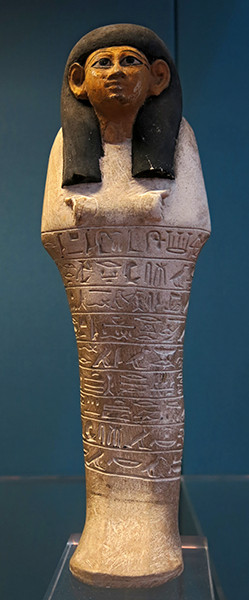
Eighteenth Dynasty: 1 550 BC - 1 292 BC
Shabti of Lady Mes
Painted limestone, height 230 mm, circa 1 450 BC. Nine rows of Hieroglyphic text.
Catalog: EA27372
Photo: Don Hitchcock 2015
Source: Original, British Museum
Text: © Card at the Museum, http://www.britishmuseum.org/research/ © Trustees of the British Museum, CC BY-NC-SA 4.0
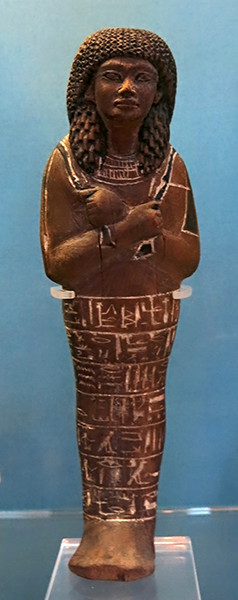
Eighteenth Dynasty: 1 550 BC - 1 292 BC
Shabti of Hatsherit
Wooden shabti of Hatsherit, Chantress of the Aten. Probably reign of Akhenaten, circa 1 352 - 1 336 BC
( note that this identification may be inaccurate. The information here including the catalog number of EA8644 is from the shelves of the British Museum in 2015, and it is at variance with the shabti shown in the online BM catalog, pictured immediately below, which depicts a quite different shabti. It is a possibility that this is also a shabti of Hatsherit, but in any case its catalog number is not EA8644, which is well attested for the shabti shown below - Don )
Catalog number given on card: EA8644
Photo: Don Hitchcock 2015
Source: Original, British Museum
Text: © Card at the Museum, http://www.britishmuseum.org/research/ © Trustees of the British Museum, CC BY-NC-SA 4.0, Wikipedia

Eighteenth Dynasty: 1 550 BC - 1 292 BC
Shabti of Hatsherit
( this is the shabti from the BM online catalog, also with the catalog number of EA8644 - Don )
Ebony shabti of Hatsheret, Chantress of Aten. The number of Osiride attributes of the figures is striking, including the mummiform stance and the epithet 'true of voice', which translates as 'justified' in the traditional religion. The beautiful ebony shabti is inscribed with the conventional shabti spell from the Book of the Dead naming 'the Osiris, Hatsheret'.
Height 235 mm, width 65 mm, depth 47 mm, weight 350 grams.
Catalog: EA8644
Photo: Don Hitchcock 2015
Source: Original, British Museum
Text: © http://www.britishmuseum.org/research/ © Trustees of the British Museum, CC BY-NC-SA 4.0, Wikipedia
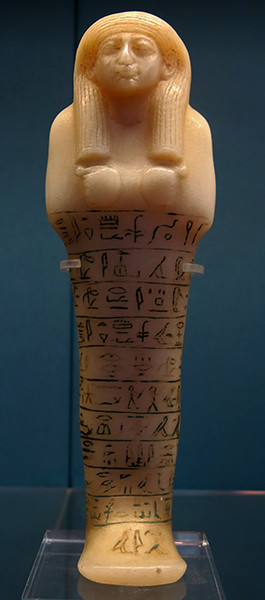
Eighteenth Dynasty: 1 550 BC - 1 292 BC
Shabti of a Royal Nurse
Calcite, height 206 mm, width 64 mm, circa 1 400 BC.
Inscribed with the 6th chapter of the Book of the Dead, in 11 horizontal bands of text.
Catalog: Abydos, EA66677
Photo: Don Hitchcock 2015
Source: Original, British Museum
Text: © Card at the Museum, http://www.britishmuseum.org/research/ © Trustees of the British Museum, CC BY-NC-SA 4.0,
Eighteenth Dynasty: 1 550 BC - 1 292 BC
Ibex
Vessel in the shape of an ibex.
Height 146 mm, width 55 mm, depth 155 mm.
Ceramic, circa 1 400 BC.
Catalog: Ceramic, ÄS 2729
Photo: Don Hitchcock 2015, 2018
Source and text: Original, Ägyptischen Museum München
Additional text: https://www.bavarikon.de/
Eighteenth Dynasty: 1 550 BC - 1 292 BC
Canopic Jar lids
Painted pottery Canopic Jar lids.
EA9604: Painted pottery lid of a canopic jar in the form of a human head; blue and yellow striped head-cloth.
Height 130 mm, width 120 mm.
EA57340: Red ware pottery lid of a canopic jar in the form of a human head; painted black and white.
Diameter 150 mm, height 110 mm.
EA9594: Black and yellow painted pottery lid of a canopic jar in the form of a human head.
Height 105 mm, width 120 mm.
EA48980: Painted pottery human-headed stopper of a canopic jar.
Diameter 127 mm, height 104 mm.
EA9582: Painted pottery lid of a canopic jar in the form of a human head.
Height 50 mm, width 125 mm.
Catalog: Painted pottery, Provenance unknown, circa 1 550 BC - 1 400 BC, EA9604, EA57340, EA9594, EA48980, EA9582
Photo: Don Hitchcock 2015
Source: Original, British Museum
Text: Card with the display at the British Museum, https://www.britishmuseum.org/, © Trustees of the British Museum, CC BY-NC-SA 4.0

Eighteenth Dynasty: 1 550 BC - 1 292 BC
Wooden Canopic Jar lid
Height 130 mm, width 90 mm.
Acacia (?) wood lid from a canopic jar in the form of a human head; eye-detail in black paint.
Catalog: Acacia wood Canopic Jar lid, circa 1 550 BC - 1 295 BC, EA9608
Photo: Don Hitchcock 2015
Source: Original, British Museum
Text: Card with the display at the British Museum, https://www.britishmuseum.org/, © Trustees of the British Museum, CC BY-NC-SA 4.0

Eighteenth Dynasty: 1 550 BC - 1 292 BC
Double row necklace
Circa 1 544 BC - 1 305 BC.
Catalog: Faience, inv. 99/87
Photo: Don Hitchcock 2015
Source: Original, Badisches Landesmuseum Karlsruhe Germany
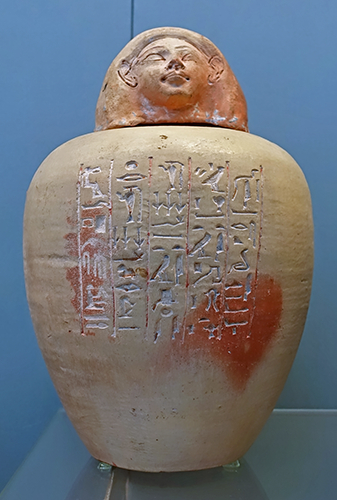
Eighteenth Dynasty: 1 550 BC - 1 292 BC
Canopic jar of a child of the Royal Nursery
Pottery canopic jar of an individual called Iahmose; lid in form of human head; five columns of incised Hieroglyphic text on body; holes pierced in lid and shoulder for attachment.
Height 330 mm.
Catalog: Painted pottery, Upper Egypt, EA9535
Photo: Don Hitchcock 2018
Source: Original, British Museum
Text: Card with the display at the British Museum, https://www.britishmuseum.org/, © Trustees of the British Museum, CC BY-NC-SA 4.0
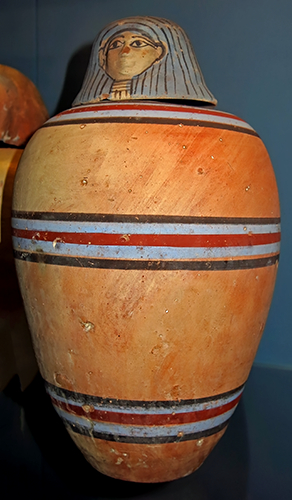
Eighteenth Dynasty: 1 550 BC - 1 292 BC
Canopic Jar
Painted pottery Canopic Jar without inscription. Three red/black/blue bands round the body; human-headed lid with a striped wig and collar.
Diameter: 195 mm. Height 320 mm.
Catalog: Painted pottery, Upper Egypt, circa 1450 BC, EA9544
Photo: Don Hitchcock 2015
Source: Original, British Museum
Text: Card with the display at the British Museum, https://www.britishmuseum.org/, © Trustees of the British Museum, CC BY-NC-SA 4.0

Eighteenth Dynasty: 1 550 BC - 1 292 BC
Canopic Jar
Pottery Canopic Jar with cursive hieroglyphic text. Circa 1500 BC.
Worn ( damaged - Don ) lid in the form of a human head; five columns of painted Hieratic text. Text is speech of the goddess Selkis. The owner is named as Renseneb.
Diameter: 185 mm. Height 310 mm.
Catalog: Painted pottery, provenance unknown, circa 1500 BC, EA53996
Photo: Don Hitchcock 2018
Source: Original, British Museum
Text: Card with the display at the British Museum, https://www.britishmuseum.org/, © Trustees of the British Museum, CC BY-NC-SA 4.0
Eighteenth Dynasty: 1 550 BC - 1 292 BC
Iahmes
Seated figure of Iahmes, Chief of the Granaries of the god Amun, circa 1 480 BC
Catalog: Gabbro, Elkab, ÄS 501
Photo: Don Hitchcock 2015, 2018
Source and text: Original, Ägyptischen Museum München
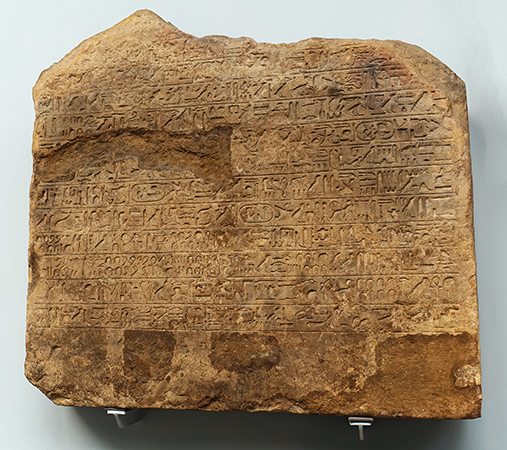
Eighteenth Dynasty: 1 550 BC - 1 292 BC
Merymose
Sandstone stela of Merymose: describing the campaign of Merymose against the Nubians of Ibhet in thirteen lines of incised hieroglyphic text. Several lines from the beginning of the inscription are missing and the whole of the upper portion is badly mutilated and weathered. The greater part of the last half of the sixth and seventh lines is destroyed and the ends of many others are damaged.
Sandstone stela (stone slab) of the Egyptian Viceroy of Kush, Merymose, from Semna, circa 1 400 BC. Abyssinia, or Ethiopia, was known as Kush to the ancient Egyptians.
A hieroglyphic text describes his campaign against the Nubians of lbha. Merymose served under Pharaoh Amenhotep III.
The text describing the campaign of Merymose against the Nubians of Ibhet is in thirteen lines of incised hieroglyphic text. Several lines from the beginning of the inscription are missing and the whole of the upper portion is badly mutilated and weathered. The greater part of the last half of the sixth and seventh lines is destroyed and the ends of many others are damaged.
Catalog: EA657
Photo: Don Hitchcock 2018
Source: Original, British Museum
Text: Card with the display at the British Museum, http://www.britishmuseum.org/, © Trustees of the British Museum, CC BY-NC-SA 4.0
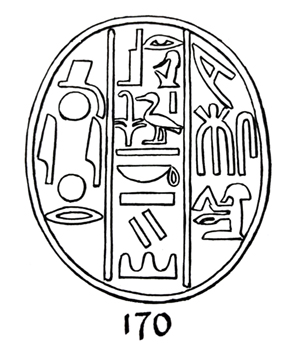
Eighteenth Dynasty: 1 550 BC - 1 292 BC
Merymose
Funerary cone for the tomb facade decoration of Merymose.
Circa 1 350 BC.
Used as architectural decoration, funerary cones were arranged along the upper edge of the facades of private tombs at Thebes.
( These two cones show identical hieroglyphs, and indicate that they are the equivalent of a Pharaoh's cartouche, an honour awarded since Merymose was viceroy of Kush, the pharaoh's representative.
The cartouche drawing is labelled as being that of Merymose - Don )
Funerary cones were small cones made from (fired) clay that were used in ancient Egypt, almost exclusively in the Theban Necropolis. The items were placed over the entrance of the chapel of a tomb. Early examples have been found from the Eleventh Dynasty. However, they are generally undecorated. During the New Kingdom, the cones were smaller in size and inscribed in hieroglyphs with the title and name of the tomb owner, often with a short prayer. The exact purpose of the cones is unknown, but hypotheses exist that they variously served as passports, architectural features, and symbolic offerings, among others.
Merymose, also Mermose or Merimes, was a Viceroy of Kush under Amenhotep III. He served for almost the entire four decades of that reign. He was entombed in Theban tomb 383.
Merymose likely accompanied Amenhotep III in year 5 on his campaign against Kush. It is possible that at a later time Merymose led a campaign against the people of an area called Ibhet. The people of Ibhet had resisted Egyptian domination and may have even attacked some Egyptian interests. Merymose led an attack against the Nubians. He killed 312 Nubians and captured 740 prisoners.
Colour photo top left: Inv. no. 1929 (probably signed Kestner)
Photo: Don Hitchcock 2018
Source and text: Original, Museum August Kestner, Hannover
Black and white photo top right: Funerary cone of the King's Son of Kush Merymose, www.metmuseum.org/, Public Domain
Cartouche Drawing: Macadam and Davies, 'Corpus of Inscribed Funerary Cones', Norman de Garis Davies (1865–5 November 1941), M. F. Laming MacAdam, 1957, #170.
Additional text: Wikipedia
Eighteenth Dynasty: 1 550 BC - 1 292 BC
Sarcophagus of Merymose
Reign of Amenhotep III, circa 1 390 BC - 1 352 BC.
Merymose's mummy lay inside this sarcophagus, which was itself contained within two larger sarcophagi. Protective spells and figures of deities cover all surfaces. The sky goddess Nut spreads her wings on the chest. The goddess Nephthys protects the body at the head end, as does her sister Isis at the foot end. The bands of inscription echo the bandages that enveloped the mummy.
Merymose was a 'King's Son of Kush', a viceroy ruling the whole of conquered Nubia (then known as Wawat and Kush). Such officials were never true sons of the pharaoh, but they were subservient to him alone. Merymose was in office under Amenhotep III, so his reponsibilities included enabling the construction of the king's great temple at Soleb, which was to house the magnificent lion statues seen at the south end of this gallery. The temple's decoration shows Merymose attending Amenhotep's first regnal jubilee (the sed festival).
Produced circa 1 380 BC.
Length 197 cm, width 60 cm, depth 60 cm
Catalog: Granodiorite, Qena (Governorate): Luxor West Bank (Thebes): Qurnet Murai (Thebes): Tomb of Merymose (Thebes) tomb of Merymose, EA1001
Photo: Don Hitchcock 2018
Source: Original, British Museum
Text: Card with the display at the British Museum, www.britishmuseum.org/, © Trustees of the British Museum, CC BY-NC-SA 4.0
Eighteenth Dynasty: 1 550 BC - 1 292 BC
Sarcophagus of Merymose
Reign of Amenhotep III, circa 1 390 BC - 1 352 BC.
Granodiorite inner-sarcophagus of Merymose: the coffin, which is anthropoid in shape, is decorated on the outside with figures and inscriptions carved in low relief. On the lid the deceased is represented wearing a long braided wig, short beard, and a bead collar with falcon-head terminals. On the left side beneath the collar are the two 'wedjat'-eyes.
A figure of Nut, kneeling with arms and wings outstretched, spans the chest. On the crown of the head Nephthys, with arms uplifted, kneels on the 'nbw'-sign. In front of and behind her is carved an inscription in three vertical columns. Beneath the feet is a figure of Isis, standing with arms uplifted between two vertical columns of inscription.
On the lid inscriptions are carved in vertical and horizontal bands (the latter being continued on the lower section) to represent the principal bandages. On the lower section, in addition to the continuation of the horizontal bands, are figures of gods, each accompanied by an inscription. Two figures of Thoth, one at the head-end and one at the foot, a figure of Anubis and figures of two of the Sons of Horus, each accompanied by an inscription, were originally carved on both the right and left sides.
The continuation of the horizontal bands of inscription from the lid separated the various figures and their inscriptions from one another so as to form five divisions. On the end beneath the feet is a 'djed' column. On the right side, only two fragments, one containing the whole of the first division and part of the second and the other containing the inscription of the third division, have been preserved.
At the first division, in front of a figure of Thoth is inscribed in two vertical columns. At the second division, portions of two of the three vertical columns of inscription which preceded the figure of Imsety are preserved. At the third division, the three vertical columns of inscription which preceded the figure of Anubis are preserved. On the left side at the first division, the space in front of a figure of Thoth is inscribed in two vertical columns.
At the second division, in front of a figure of Hapy is inscribed in three vertical columns. At the third division, in front of a figure of Anubis is inscribed in three vertical columns. At the fourth division, in front of a figure of Qebhsenuef is inscribed in three vertical columns. At the fifth division, in front of a figure of Thoth is inscribed in two vertical columns. The coffin has been reassembled from the numerous pieces into which it was broken. The lid is almost complete, but considerable portions of the lower section are missing.
Catalog: Granodiorite, Qena (Governorate): Luxor West Bank (Thebes): Qurnet Murai (Thebes): Tomb of Merymose (Thebes) tomb of Merymose, EA1001
Photo: Don Hitchcock 2018
Source: Original, British Museum
Text: Card with the display at the British Museum, www.britishmuseum.org/, © Trustees of the British Museum, CC BY-NC-SA 4.0
Eighteenth Dynasty: 1 550 BC - 1 292 BC
Rekhmire
Kneeling figure of the Royal Scribe Rekhmire holding a symbol of the goddess Hathor, circa 1 400 BC
Catalog: Quartzite, Koptos, Gl. 87
Photo: Don Hitchcock 2015, 2018
Source and text: Original, Ägyptischen Museum München
Eighteenth Dynasty: 1 550 BC - 1 292 BC
Stelophorous Statue
Lower half of a kneeling figure holding a stela , circa 1 400 BC
Catalog: Limestone, ÄS 7279
Photo: Don Hitchcock 2015, 2018
Source and text: Original, Ägyptischen Museum München
Eighteenth Dynasty: 1 550 BC - 1 292 BC
Iuna
Lower half of a kneeling figure of the high military official Iuna holding an offering table, circa 1380 BC.
Catalog: Quartzite, Memphis/Heliopolis, Äs 6761
Photo: Don Hitchcock 2015, 2018
Source and text: Original, Ägyptischen Museum München
Tomb 181, known as The Tomb of Two Sculptors at Thebes, Neb-Amun and Ipuki
Circa 1398 – 1350 BC, during the reigns of Thutmose IV and Amenhotep III.
For those interested in knowing more about Tomb 181, this is an excellent resource:
https://www.osirisnet.net/tombes/nobles/nebamon_ipouky181/e_nebamon_ipouky_01.htm
The Khokhah Ridge and Tomb 181
Photograph taken from the western hills. In the center is the low ridge, with the domed house of the Expedition on the northern slope. Tomb 181 lies well down on the southern slope and is marked by a man standing just above the second telephone pole from the right of the picture.
Source and text: Davies (1925)
The Khokhah Ridge and Tomb 181
Photograph taken from the south. Above the ridge a path is seen going over the hills to the Tombs of the Kings. Tomb 181 lies below the feet of the man standing in the centre of the picture.
Source and text: Davies (1925)
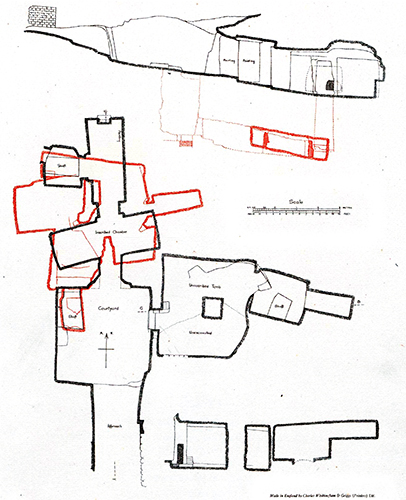
Plan of Tomb 181
The constructions below the level of the floor are in red.
A longitudinal section on AB is at the head of the plate, and a transverse section on CD at the foot.
Source and text: Davies (1925)
Text above: Paper catalogue, Museum August Kestner, Hannover
The nature of the rocky outcrops or 'Gebels' on the Theban west bank is largely unsuitable for the siting and carving of reliefs because of the brittle, splintering rock there.
Thus, at the beginning of the New Kingdom, the hewn-out tomb spaces were covered with a layer of Nile mud and chaff and more even surfaces were created for painting and inscription. Thus the Theban tombs are probably the most productive and important source of ancient Egyptian painting.
Despite their fragmentary state, the four paintings are significant in terms of both art and cultural history; and their importance is heightened by the fact that the pieces can be precisely dated.
All of them come from rock tomb 181, which the artists Neb-Amun and Ipuki had built for themselves in the late years of Amenophis III. This unusual finding - two men as equal owners of one tomb - does not seem to result from blood relations.
Rather, NebAmun apparently married Ipuki's wife Henet-Nefret after Ipuki's death; and instead of jealousy, a friendly relationship existed between the two men beyond the death of one of them.
The aspect of the other world would hardly be so tangible, however, if we did not know the origin of the fragments on the one hand and if they did not contain, on the other hand, the depiction of the famous queen lah-mes-Nefertari and her son King Amenhotep I. Both became patron saints of the Theban necropolis soon after their death, to whom the living and the deceased turned in their prayers.
The queen is thus depicted as black-skinned, not because of a foreign, negroid origin, but because she was regarded as an Osiris-like deity of the afterlife.
However, even without this direct reference, we would have to consider the scenes as belonging to the otherworldly realm. The banquets of the living may have been similar to these pictures of Neb-Amun and Ipuki, the ladies and gentlemen were equally splendidly decorated and received equally meaningful and festive gifts from the hands of the attendants.
But even if it is not explicitly noted in the epigraphs, this is obviously a celebration in honour of the dead: the 'Beautiful Feast of the Western Desert Valley'.
The official occasion of these celebrations was a procession of Amun from Karnak in his portable shrine to the tombs of the deceased kings in Thebes-West. And the people of Thebes used the opportunity (independently of the regular sacrifices for the dead) to hold feasts in the above-ground rooms of the tombs of their families and, as it were, together with them, thus making them forget the boundaries between the two worlds for a short period of time.
Technically and stylistically, Egyptian painting is at its absolute peak here, shortly before the transition to the revolutionary style of the Amarna period. The faces are of unparalleled elegance and delicacy. The men differ from the women only in certain parts of the costume (hairstyles) and - according to the oldest canon - in the darker skin colour.
Linen and its rich pleating are reproduced (especially in the portrayal of the Meal of the Dead). The cones of ointment on the heads of the ladies seem to be slowly melting away - a luxurious custom, by the way, from which the laundresses of the ointment-soaked clothes must have had a great deal to do. Multi-stranded necklaces and artfully composed bundles of flowers (in the Meal of the Dead) complete the opulent jewellery. Although the figures cannot be depicted directly next to each other, but only in a staggered or row-like manner, the tender bond between the spouses is unmistakably expressed, especially in the fragment depicting a man and his wife, below, and the duck and the papyrus plants in the hand as part of the sacrifice to the gods, below, convey a hint of eroticism.
Eighteenth Dynasty: 1 550 BC - 1 292 BC
Queen Ahmose-Nefertari
(left) Fragment of a painting of Queen Ahmose-Nefertari, mother of Pharoah Amenhotep I, wife of Ahmose I, from Tomb 181.
(right) Reproduction of the panel which contained the fragment at left, painted from the original by H.R. Hopgood, of Pharoah Amenhotep I and his mother, Queen Ahmose-Nefertari, wife and full sister of Ahmose I. The deceased Pharoah Amenhotep I and his mother had become deified protectors of the necropolis.
Circa 1 380 BC, during the reign of Pharoah Amenhotep III.
As in the majority of cases, the queen is given a dark, indeed here a coal-black, complexion; a distinction which has been taken as a sign of Berber extraction (though not confined to her among divinities). The black colour duly appears as grey where it is veiled by her thin mantle. She wears as queen the skin of the Nekhebet vulture as headdress (with the unpleasing substitution of a uraeus for the bird's head), a simple red modius ( a flat-topped cylindrical headdress or crown ) above it, and the red sash at the waist under her mantle.
Amenhotep's features have a close resemblance to those of the reigning king, the third of the same name, portraiture being, as usual, out of the question. The descriptive text runs, 'The superintendent of sculptors of the Lord of the two Lands, Nebamun, [giving adoration to the king of south and north Egypt], the Lord of the Two Lands, Joserkere (to whom life is given), and bowing [in homage to the wife of] the god, Ah[mes-Nofre]tari (who liveth), that ye may grant [all kinds of] offerings [and delicacies] daily, and that I may be provided with your [marks of regard (?)] as a favoured servant of yours who is of your train.'
Text above: Page 33, Davies (1925)
The fragment, Inv. no. 1962.70, has height 260 mm, width 160 mm.
Catalog: Nile mud chaff base with stucco and paint coating, Thebes-West, Inv. no. 1962.70
Photo (left): Don Hitchcock 2018
Painting (right) painted by H.R. Hopgood, published in Davies (1925)
Source and text: Original, Museum August Kestner, Hannover
Additional text: Davies (1925)
Eighteenth Dynasty: 1 550 BC - 1 292 BC
Meal of the Dead
The inner chamber of the tomb has had its mud-lined walls slopped over with a thin wash of white, and two thirds of the east wall has been decorated against a ground color of that glistening yellow which is generally reserved for shrines and kiosks. One can gather from the condition of this scene the probable history of its execution.
( A kiosk in this Ancient Egyptian context means a small open structure with columns supporting the roof, which is usually a temple, pavilion or summer house - Don )
It was at first intended to paint it in proper style, and at the far end figures of one of the owners and his wife (?) sitting before a small table of offerings were carefully put in, as in the image above.
Text above: Page 64, Davies (1925)
From https://www.osirisnet.net/tombes/nobles/nebamon_ipouky181/e_nebamon_ipouky_06.htm :
The Longitudinal Chamber - this more intimate part of the tomb, irregularly built, with non parallel walls, measures 390 cm in length by an average width of 150 cm. The height varies, being under 200 cm at the entrance and at the rear end rising substantially higher, to about 280 cm. The entry, only in progress, did not include any decor. At the rear has been partially excavated a niche for one or more statues. The floor slopes downwards towards the rear end.Text above: Adapted from https://www.osirisnet.net/tombes/nobles/nebamon_ipouky181/e_nebamon_ipouky_06.htm
The decorative program which had been envisaged was obviously disrupted, because, excavated in a very unusual way, was a small chamber in the west wall, in which opens up one of the funerary shafts.
The walls of the entry corridor had not been decorated.
However, the walls of the actual chamber had been smoothed over with a clay layer and then a thin wash of white applied. Part of the east (right-hand) wall has been decorated. The background colour is golden yellow, usually reserved for shrines and kiosks, and also found in the Ramesside period. Two artists seem to have worked in parallel on a banquet scene. At the far end of the wall, on the top register, can be found a beautiful representation of an anonymous couple seated in front of a table of offerings. The scene was almost intact in the days of Davies, although even then, the front part of the head of the husband was lost. The missing fragment of the upper torso of the wife is nowadays at the Hannover museum.
The fragment shown here, Inv. no. 1962.69, has height 390 mm and width 310 mm.
Catalog: Nile mud chaff base with stucco and paint coating, Thebes-West, Inv. no. 1962.69
Photo (left): Don Hitchcock 2018
Painting (right) painted by G. K. Wilkinson, published in Davies (1925)
Source and text: Original, Museum August Kestner, Hannover
Additional text: Davies (1925)
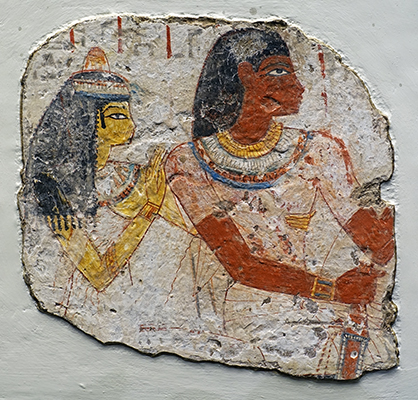 Eighteenth Dynasty: 1 550 BC - 1 292 BC
Eighteenth Dynasty: 1 550 BC - 1 292 BC
Man and Wife
Photo: Don Hitchcock 2018
Source and text: Original, Museum August Kestner, Hannover
Eighteenth Dynasty: 1 550 BC - 1 292 BC
Sacrifice to the Gods
The fragment on the left depicting a servant with a duck and papyrus stems is part of the panel on the right.
Photo (left): Don Hitchcock 2018
Painting (right): Nina de G. Davies, Davies (1925).
Source and text: Original, Museum August Kestner, Hannover
Additional text: Davies (1925)
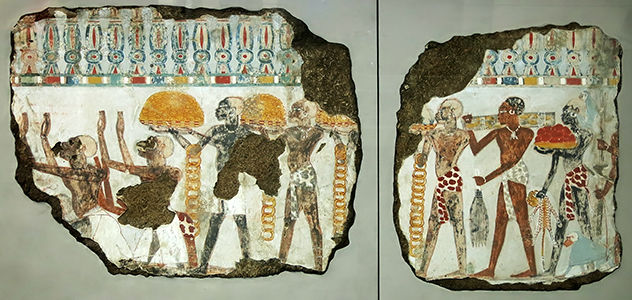
Eighteenth Dynasty: 1 550 BC - 1 292 BC
Sebekhotep
Wall painting from an Egyptian tomb showing the presentation of African products to the pharaoh during the 18th Dynasty, circa 1400 BC, from the tomb-chapel of Sebekhotep at Thebes, TT63, during the rule of Thutmose IV.
The two fragments formed part of a large scene in which Africans and people from Western Asia are shown presenting the products of their lands to the Egyptian king. The men of the south are painted brown or black, and wear large earrings and animal skin kilts. Their offerings include gold nuggets and rings, ebony logs, a monkey, a baboon, giraffe tails and a leopard skin. The last figure carries a tray of reddish objects, probably pieces of red jasper.
EA921: Part of tomb wall, made of plaster on mud. Painted representation of Nubians offering gold nuggets and rings to the king (not seen), with a cornice above.
Height: 710 mm, width 965 mm.
EA922: Part of tomb wall showing Nubians bringing tribute from the south to Pharaoh. The figure at the front carries interlocking gold rings over one arm; the man behind bears ebony logs on his shoulder and a giraffe's tail in one hand. The third figure carries a leopard skin and a basket full of chunks of red jasper; a monkey perches behind his head. All three wear earrings.
Height 740 mm, width 610 mm.
Catalog: EA921, EA922
Photo: Don Hitchcock 2015
Source: Original, British Museum
Text: Card with the display at the British Museum, http://www.britishmuseum.org/, © Trustees of the British Museum, CC BY-NC-SA 4.0
Eighteenth Dynasty: 1 550 BC - 1 292 BC
Senet board of Sennefer with game pieces
The senet gameboard is a grid of 30 squares, arranged in three rows of ten. A senet board has two sets of pawns (at least five of each). Although details of the original game rules are a subject of some conjecture, senet historians Timothy Kendall and R. C. Bell have made their own reconstructions of the game. These rules are based on snippets of texts that span over a thousand years, over which time gameplay is likely to have changed. Therefore, it is unlikely these rules reflect the actual course of ancient Egyptian gameplay. However their rules have been adopted by sellers of modern senet sets.
Catalog: Wood, bone, faience, ÄM 7456, ÄM 8972, ÄM 10756/1, ÄM 11027, ÄM 22056, ÄM 27103
Photo: Don Hitchcock 2018
Source: Display, Staatliche Museen zu Berlin, Neues Museum, Germany
Text: © Card at the Staatliche Museen zu Berlin (CC BY-NC-SA 3.0 DE)
Additional text: Wikipedia
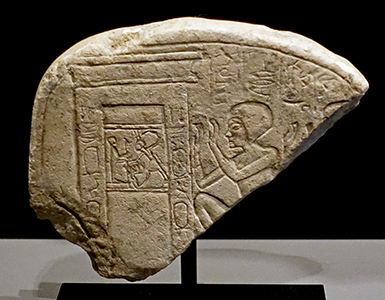
Eighteenth Dynasty: 1 550 BC - 1 292 BC
Stela
Fragment of a stela: praying man standing before the motif 'Pharaoh smiting his enemies', circa 1 390 BC.
( Based on the date given, the Pharaoh would have been Amenhotep III - Don )
Catalog: Limestone, Memphis, ÄS 7274
Photo: Don Hitchcock 2018
Source: Original, Ägyptischen Museum München
Text: Museum card, © Ägyptischen Museum München
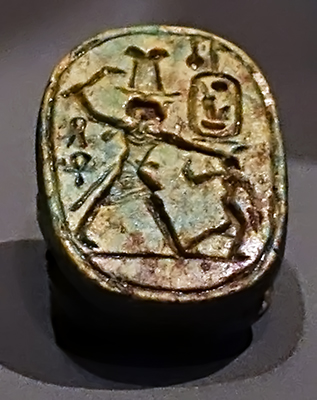
Eighteenth Dynasty: 1 550 BC - 1 292 BC
Scarab
Scarab with the depiction of Pharaoh Amenhotep III smiting an enemy, circa 1 380 BC.
Catalog: Steatite, ÄS 3892
Photo: Don Hitchcock 2018
Source: Original, Ägyptischen Museum München
Text: Museum card, © Ägyptischen Museum München
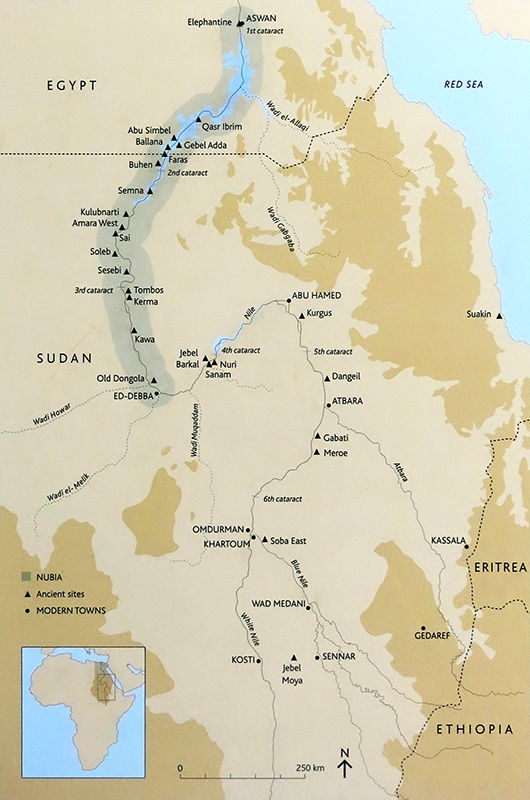
Map showing modern day Sudan, Egypt and Nubia.
Photo: Poster at the British Museum, © Trustees of the British Museum, CC BY-NC-SA 4.0
Rephotography: Don Hitchcock 2015
Text: Poster at the British Museum, http://www.britishmuseum.org/, © Trustees of the British Museum, CC BY-NC-SA 4.0

Timeline from prehistoric Sudan and Nubia to Sudan and Nubia today.
Photo: Poster at the British Museum, © Trustees of the British Museum, CC BY-NC-SA 4.0
Rephotography: Don Hitchcock 2015
Text: Poster at the British Museum, http://www.britishmuseum.org/, © Trustees of the British Museum, CC BY-NC-SA 4.0
Eighteenth Dynasty: 1 550 BC - 1 292 BC
Nebamun
Surveying the fields for Nebamun, circa 1350 BC.
Nebamun was the accountant in charge of grain at the great Temple of Amun at Thebes (Modern Karnak). This scene from his tomb-chapel shows officials inspecting fields. A farmer checks the boundary marker of the field. Nearby, two chariots for the party of officials wait under the shade of a sycamore-fig tree.
Other smaller fragments from this wall are now in the Egyptian Museum, Berlin, and show the grain being harvested and processed.
Paint on plaster, 1067 x 458 mm, Thebes, Egypt
Fragment of a limestone tomb-painting representing the assessment of crops, for the purposes of tax, on Nebamun's estate, five vertical registers of hieroglyphs survive; the rest of the fragment is divided into two registers, with a horse-drawn chariot above and cart drawn by onagers beneath.
Catalog: EA37982
Photo: Don Hitchcock 2015
Source: Original, British Museum
Text: Card at museum display, http://www.britishmuseum.org/, © Trustees of the British Museum, CC BY-NC-SA 4.0
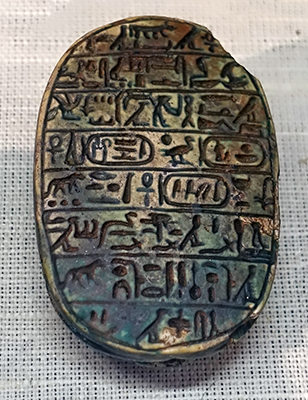
Eighteenth Dynasty: 1 550 BC - 1 292 BC
Amenhotep III
Memorial scarab of Amenhotep III, circa 1 388 BC - 1 350 BC.
Catalog: Steatite, glazed, unknown origin, Inv. Nr. 1976.106
Photo: Don Hitchcock 2018
Source and text: Original, Museum August Kestner, Hannover
Eighteenth Dynasty: 1 550 BC - 1 292 BC
Nebamun
Surveying the fields for Nebamun, circa 1350 BC.
Reconstruction drawing by C. Thorne and R.B. Parkinson
Photographs of the Berlin fragments by J. LIepe, © Ägyptisches Museum, Berlin
Rephotography: Don Hitchcock 2015
Source: display, British Museum
Text: Card at museum display, http://www.britishmuseum.org/, © Trustees of the British Museum, CC BY-NC-SA 4.0
Eighteenth Dynasty: 1 550 BC - 1 292 BC
Procession to the grave
Train of sledges bearing a coffin and grave goods on the way to the grave, circa 1 310 BC.
Catalog: Limestone, Saqqara (?), Inv. Nr. 1935.200.192
Photo: Don Hitchcock 2018
Source and text: Original, Museum August Kestner, Hannover
Eighteenth Dynasty: 1 550 BC - 1 292 BC
Hor and Suty
This inscribed granite stela, circa 1350 BC, comes from the tomb-chapel of twin brothers, Hor and Suty. They were important officials, the chief architects in the Temple of Armun, where Nebamun worked, and they probably knew him. Their door shaped stela is decorated with prayers and hymns to the Sun-God who ruled over life and rebirth.
Granodiorite stela of Hor and Suty: a round-topped stela, carved within the rectangular framework of the door. The inscriptions throughout are incised and the figures carved in sunk relief. On the lintel of the door are three horizontal lines of text reading from the centre outwards. On the right side, there are three vertical lines of text. At the base of the right panel above a figure of Hor, seated at a table of offerings (almost entirely obliterated), are four (?) vertical lines of text.
On the left side are three vertical lines of text. At the base of the left panel above a figure of Suty, seated at a table of offerings (almost entirely obliterated), are four vertical lines of text. On the right and left of the top of the arch of the stela itself, in the angle formed by the frame of the door is a 'wedjat'-eye. In the arch of the stela is a winged disc.
The stela comprises two registers. The first register is divided into two symmetrical scenes: On the right Anubis, shown with jackal's head, wearing a short skirt and holding a sceptre in the left hand and 'ankh' in the right, is adored by Hor and a woman (both almost entirely obliterated). Above Anubis, there are two vertical columns of text. Above Hor and the woman, are four vertical columns of text. On the left Osiris, shown in mummy form, wearing a crown, beard, necklace and counterpoise, and holding a sceptre in his hands, is adored by Suty and a woman (both obliterated).
Above Osiris are two vertical columns of text. Above Suty and the woman, are four vertical columns of text. The second register carries an inscription in twenty-one horizontal lines. The stela is well preserved, but there are minor abrasions. The name of Suty in the left hand panel of the door and all the figures with their accompanying inscriptions, apart from those of the gods, were erased in antiquity.
Hor and Suty are usually regarded as brothers, although it has been proposed that they are a same sex couple; the inscription, however, strongly suggests that they were twins.
Twentyone lines of a hymn to the sungod:
Praising Amun when he rises as Harakhty
by the Overseer of Works of Amun Suty
and the Overseer of Works of Amun Hor: they say,
“Hail to you Re, beauty of every day,
who rises at dawn ceaselessly,
Khepri who tires himself with labour!
Your rays are on the face, unknown;
electrum – it is not like your splendour;
creator of yourself, you fashion your body;
begetter unbegotten;
alone, unique, traversing eternity;
above all ways, with millions under his control;
your splendour is like the sky's splendour;
your colour brighter than its colours;
you cross the sky with all faces seeing you;
you set and (you) are hidden from their sight;
you give yourself at dawn;
secure is your sailing with your majesty;
a short day and you run a race –
hundred thousands and millions of miles;
each day is a moment to you,
passing as you set;
the hours of the night also listen to you;
you have ordered them with no ceasing in your work;
all eye(s) see by you;
they are useless when your majesty sets;
you arise to shine at dawn
and your brightness opens the eyes of the flocks;
you set in the Western Hill
and then they sleep as if dead.
Hail to you sun-disc of day,
Creator of all, making them alive!
Great hawk, dapple-plumed;
scarab who raises himself up;
who creates himself unbegotten;
eldest Horus in the midst of Nut;
applauded for rising and also setting;
who creates what the earth makes;
the Khnum and Amun of the living;
who seizes the two lands, from great to small;
shining mother of mankind and gods;
patient craftsman,
tireless in making them numberless;
valiant shepherd driving his flock,
their shelter keeping them alive;
runner, racer, courser;
Khepri of exceptional birth,
who displays his beauty in the womb of Nut,
who illumines the two lands as his sundisc;
Primeval one of the two lands who made himself,
and who sees that he made alone;
who reaches the ends of the earth every day,
in the view of those who walk on it;
who rises in the sky formed as the sun,
making the seasons in the months;
burning when he wants,
cool when he wants;
he lays bodies low and he revives them;
every land choruses his rising;
every day will praises him!”
The Overseer of Works Suty and the Overseer of Works Hor, he (!) says,
'I was in charge of your city,
overseer of works in your very shrine,
made for you by your beloved son,
Lord of the Two Lands Nebmaatre given live.
My lord appointed me to be in charge of your monuments, knowing my vigilance.
I was a valiant man in charge of your monuments,
who did truth as your wish.
I know you are pleased by truth,
advancing him who does it on earth.
I did it and you advanced me,
giving me favours on earth in Karnak.
I was in your following when you appeared.
I was a just man, whose horror is disorder,
unpleased with any words of a liar -
only my brother, like myself, his ways pleased me,
for he had come from the womb
with me on the same day,
the Overseer of Works of Amun in Luxor, Suty and Hor.
I was in charge on the right while he was in charge on the left,
as we controlled the great monuments in Karnak
at the front of Thebes, the city of Amun.
May you give me an old age in your city,
with my eyes on your beauty,
and a burial in the west, the place of contentment,
as I join with the favoured ones
who have departed in peace!
May you give me a sweet breeze when (I) land
and garlands(?) on the day of the Wag-feast!'
Catalog: EA826
Photo: (left) Don Hitchcock 2015
Photo: (right) © Trustees of the British Museum, CC BY-NC-SA 4.0
Source: Original, British Museum
Text: Card at museum display, http://www.britishmuseum.org/, © Trustees of the British Museum, CC BY-NC-SA 4.0
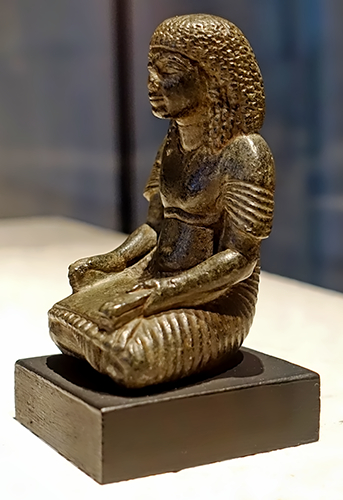
Late Eighteenth Dynasty / Early Nineteenth Dynasty: 1 319 BC - 1 279 BC
Scribe
Statuette of an unknown scribe.
The clerk in his long, pleated robe is crouched with a papyrus spread out on his lap. He is holding his writing instrument in his right hand. The robe, shoulder-length wig and almond-shaped eyes speak for a date in the late 18th Dynasty. The statuette could have been grave goods, or have been a donation in a temple. The job of a writer was one of the most respected in ancient Egypt, so it is not surprising that many officials also portrayed themselves as such.
(J. Jancziak, via https://artsandculture.google.com/ )
Catalog: Green granite, Horemheb/Seti I, ÄM 14445
(identified as glazed steatite, soapstone, by Google Arts and Culture)
Photo: Don Hitchcock 2018
Source: Original, Staatliche Museen zu Berlin, Neues Museum, Germany
Text: © Card at the Staatliche Museen zu Berlin, (CC BY-NC-SA 3.0 DE)
Additional text: Google Arts and Culture, https://artsandculture.google.com/
Eighteenth - Twentieth Dynasty: 1 550 BC - 1 077 BC
Sched-es-en-mut
Ushabti box of Sched-es-en-mut.
Side wall of a Shabti box of Sched-es-en-mut, depicting Hathor in front of the grave of Sched-es-en-mut, while she shows adoration of Hathor.
Dimensions: 250 mm x 400 mm x 13 mm.
This polychrome painted side wall of a shabta box is very likely made of sycomore wood and has a slightly trapezoidal outline. It was purchased in 1823 by Johann Heinrich Carl Menu Freiherr von Minutoli (1772-1846) together with the pieces ÄM 629-632, 780, 783 and 831-832 for his collection of Egyptian antiquities. The object is primed with a strong ochre tone and shows a representation as it is known from numerous Theban graves.
A pyramid-shaped chapel made of bright white limestone is provided with two inscription columns, which represent black hieroglyphs on a yellow background. The first is in the upper area of the pyramid tip and names 'Osiris, Mistress of the Upper Egyptian House of Amun (Karnak)'. The female nominal form refers to the title of the deceased, who has already become an Osiris. Her name is right in the entrance to the grave, which is shown in red (granite?), Sched-es-en-mut.
Immediately above is a tableau depicting the seated god Osiris with an atef crown (the specific feathered white crown of the ancient Egyptian deity Osiris)
in front of a kneeling woman in a long white robe. Presumably it is the deceased herself, whose name is no longer legible in the three columns of inscriptions above her.
Directly next to the tomb chapel is the typical representation of the Theban western mountains consisting of a red background with red-black dot and red line divisions. The goddess Hathor emerges from the mountains in the form of a cow with a backrest, a menitre and the Hathor crown, which consists of a horned cow with a sun disc and two ostrich feathers.
At the front end there is an uraeus that protrudes above the cow's forehead. The colourfully feathered sun disc Behedeti (or Winged Sun of Thebes) hovers over the goddess with spread wings. Below is a column with inscriptions that belong to the goddess Hathor. In front of the cow and over the kneeling adorant are seven further columns, which give the sweet north wind through Hathor, the mistress of the western necropolis and the mistress of the Upper Egyptian house of Amun-Re (Karnak), Sched-s (t )- Courage, the justified, describe. Between Hathor and the deceased are a libation vase (hs), a lotus chalice with papyrus plants, a lettuce (Lactuca sativa) and a one-footed sacrificial table. On the latter are two round flatbreads, which frame a hand washing vessel (nms).
A lotus flower (Nymphaea caerulea) forms the upper end of the sacrificial structure. The kneeling deceased wears a long white dress with a coat over it. Two long blue strips of fabric hold the robe together in front of the chest. Around her neck is a wide Wesekh neck collar made of blue faience beads. While the left hand is raised in the gesture of adoration, it carries a sistrum and a blue plant in the right, which could be a lily due to its shape.
Sched-es-en-mut wears two yellow-blue bangles around her wrists and a wide flower diadem on the wavy long hair wig. On her head there is also an ointment cone with two lotus buds, which are intended to illustrate the fragrance. The representation on the side of a shabti box can be the vignette from the death book claim 186, which is not explicitly reproduced in the text here, but is illustrated solely by the illustration. This interpretation is supported by the opposite shabti wall (ÄM 630), on which there is clearly the vignette for the Book of the Dead 59.
Text above by A. Weber, from http://www.smb-digital.de/
Catalog: Wood, primed and painted, ÄM 629, ÄM 630, ÄM 631, ÄM 632
Photo: Don Hitchcock 2018
Source: Display, Staatliche Museen zu Berlin, Neues Museum, Germany
Text: © Card at the Staatliche Museen zu Berlin, http://www.smb-digital.de/, (CC BY-NC-SA 3.0 DE)
Eighteenth - Twentieth Dynasty: 1 550 BC - 1 077 BC
Sched-es-en-mut
Ushabti box of Sched-es-en-mut.
Catalog: Wood, primed and painted, ÄM 629, ÄM 630, ÄM 631, ÄM 632
Photo: Don Hitchcock 2018
Source: Display, Staatliche Museen zu Berlin, Neues Museum, Germany
Text: © Card at the Staatliche Museen zu Berlin (CC BY-NC-SA 3.0 DE)
Eighteenth - Twentieth Dynasty: 1 550 BC - 1 077 BC
Sched-es-en-mut
Ushabti box of Sched-es-en-mut.
( Adoration of Osiris - Don )
Catalog: Wood, primed and painted, ÄM 629, ÄM 630, ÄM 631, ÄM 632
Photo: Don Hitchcock 2018
Source: Display, Staatliche Museen zu Berlin, Neues Museum, Germany
Text: © Card at the Staatliche Museen zu Berlin (CC BY-NC-SA 3.0 DE)
Eighteenth - Twentieth Dynasty: 1 550 BC - 1 077 BC
Sched-es-en-mut
Ushabti box of Sched-es-en-mut.
( Adoration of the falcon-headed god, Horus. Note that the lower image is of higher resolution, since it has been stitched together from two close up images - Don )
Catalog: Wood, primed and painted, ÄM 629, ÄM 630, ÄM 631, ÄM 632
Photo: Don Hitchcock 2018
Source: Display, Staatliche Museen zu Berlin, Neues Museum, Germany
Text: © Card at the Staatliche Museen zu Berlin (CC BY-NC-SA 3.0 DE)
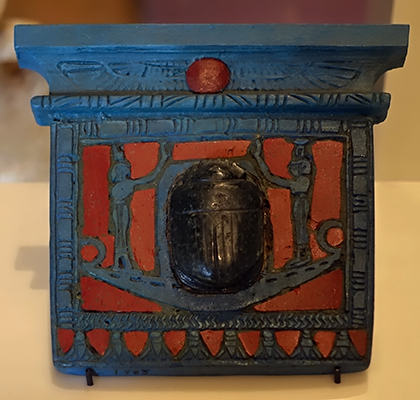
Eighteenth - Twentieth Dynasty: 1 550 BC - 1 077 BC
Nebua
Pectoral of the royal scribe Nebua
Dimensions: 98 x 110 x 21 mm.
The pectoral (breast decoration) of the royal scribe Neb-ua comes from Saqqara and was acquired in 1827 by Giuseppe Passalacqua (1797-1865) for his collection of Egyptian antiquities. It consists of blue faience with red inlays made of jasper and a black and green scarab made of serpentinite on the front. The object is reminiscent of the shape of a small temple, with a groove, a round bar and a square border.
Between the water lines and lotus flowers in the lower area and the winged sun disc Behedeti at the upper end, it could represent the entire cosmos just like a temple. Between heaven and earth is the barque of the sun god, which passes the firmament and the horizons around the regenerated god Re every day, here in his morning form of the Chepri, to drive over the earthly and underground waters. Due to its central position on the object, the shrine that surrounds it and the special inlay work that serves as an application, the sun beetle is to be regarded as the centre of attention.
Next to the sun beetle are the goddesses Isis and Nephthys, who protectively raise their arms over Chepri. As a rejuvenated sun god, the scarab is the symbol of the renewal that the owner of the object wanted after his death. On the back you can see him in the Ramesside-era 'robe of the living', how he stands with raised arms (Betergestus, the gesture of prayer) to the god Osiris, who is wrapped in mummy bandages and demonstrates his status as ruler of the underworld by crook and fronds. In addition, he wears the typical Atef crown on his head.
Two columns of inscriptions reflect the names 'Osiris' and 'Royal Scribe, Neb-ua'. Since the pectoral is not pierced on the sides or has holes for suspension, it can be assumed that it was never worn during his lifetime, but rather served as a burial object and was probably placed directly on the deceased's mummy.
Text above: A. Weber, http://www.smb-digital.de/eMuseumPlus?service=ExternalInterface&module=collection&objectId=597790&viewType=detailView , (CC BY-NC-SA 3.0 DE)
Catalog: Faience, blue, red; Jasper, red; Serpentinite, Memphis / Saqqara, ÄM 1983
Photo: Don Hitchcock 2018
Source: Display, Staatliche Museen zu Berlin, Neues Museum, Germany
Text: © Card at the Staatliche Museen zu Berlin, http://www.smb-digital.de/, (CC BY-NC-SA 3.0 DE)
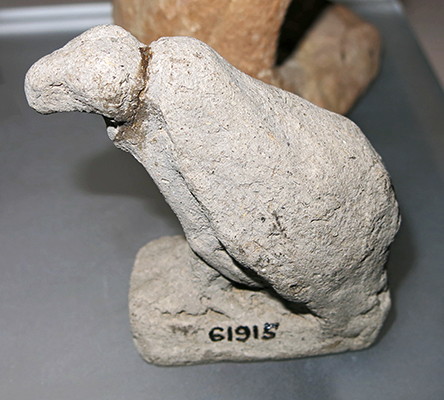
Eighteenth - Twentieth Dynasty: 1 550 BC - 1 077 BC
Votive figure
Hand-modelled unfired clay figurine of a vulture standing upon a low base. The clay has been tempered with fine organic matter, and the maker has detailed the wings, legs and distinctive neck and head of the vulture.
Height 77 mm, width 36 mm, depth 78 mm.
This figure is part of a class of objects which includes representations of cobras, rams, crocodiles, birds etc. They have been found in temple contexts such as Abydos but are also likely to have found used in funerary and domestic spheres. Fired clay figurines, of similar form, scale and subject matter, are a feature of New Kingdom and Third Intermediate Period settlement sites.
Catalog: Abydos, EA61915
Photo: Don Hitchcock 2015
Source: Original, British Museum
Text: Card at museum display, http://www.britishmuseum.org/, © Trustees of the British Museum, CC BY-NC-SA 4.0
Eighteenth - Twentieth Dynasty: 1 550 BC - 1 077 BC
Crocodile
This wooden crocodile has been carved with a movable jaw.
( this was probably a pull-along child's toy, although children's toys are rare in the record - Don )
Catalog: Thebes, ÄM 6817
Photo: Don Hitchcock 2018
Source: Display, Staatliche Museen zu Berlin, Neues Museum, Germany
Text: © Card at the Staatliche Museen zu Berlin (CC BY-NC-SA 3.0 DE)
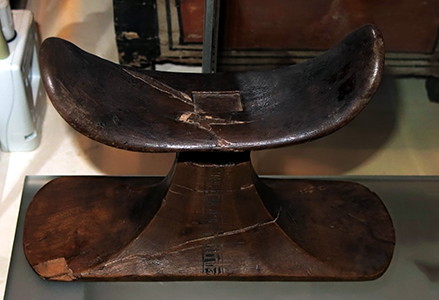
Eighteenth - Twentieth Dynasty: 1 550 BC - 1 077 BC
Headrest
Wooden tripartite head-rest with two ivory domed studs. The middle section has been decorated with a column of incised hieroglyphs, giving the name and title of the owner: 'the wan-priest and chief chisel-bearer of Amun, Huy.
Height 155 mm, length 235 mm, width 76 mm.
Titles/epithets include: Chief Chisel-Bearer of Amun; Pure-Priest.
Catalog: Thebes, EA65266
Photo: Don Hitchcock 2015
Source: Original, British Museum
Text: Card at museum display, http://www.britishmuseum.org/, © Trustees of the British Museum, CC BY-NC-SA 4.0
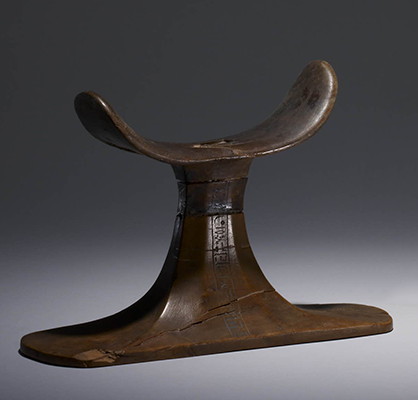
Eighteenth - Twentieth Dynasty: 1 550 BC - 1 077 BC
Headrest
Another view of the headrest above, from the online image database of the British Museum.
Head-rests are a common feature of elite 18th dynasty burials at Thebes.
Catalog: Thebes, EA65266
Photo: © Trustees of the British Museum, CC BY-NC-SA 4.0
Source: Original, British Museum
Text: Card at museum display, http://www.britishmuseum.org/, © Trustees of the British Museum, CC BY-NC-SA 4.0
Eighteenth Dynasty: 1 550 BC - 1 292 BC
Cosmetic box
Rectangular ebony cosmetic-box provided with a lid and four feet. The box is made from six pieces of wood, secured with dowels. The base of each leg has a small ivory pad, glued to the wood. Small right angle braces, also of ivory, are fitted between the legs and base of the box.
The lid of the box is formed from two pieces of wood, joined with a shaped baton which also serves to stop the lid moving when placed on the box. The wood of the box has been covered with a layer of wood veneer, which bears a decorative arrangement of pink-stained ivory and blue faience.
These are not inlaid into the wood of the box itself but are glued in place. A further row of small ivory pieces has been used along the edges of the box. An ivory knob on both the lid and box would have allowed the box to be secured with cord.
Catalog: EA5897
Photo: (left) Don Hitchcock 2015
Photo: (right) © Trustees of the British Museum, CC BY-NC-SA 4.0
Source: Original, British Museum
Text: Card at museum display, http://www.britishmuseum.org/, © Trustees of the British Museum, CC BY-NC-SA 4.0
Middle - New Kingdom: 12th - 20th Dynasty, 1 991 BC - 1 077 BC
Jewellery
Necklaces, collars and ringplates. Ringplates were attached to the circle of metal around the finger.
Catalog: Thebes and Abusir, ÄM 5257 (four row necklace consisting of tube, disc, and ring beads, Faience, yellow, green, red, turquoise, black, 430 x 20 x 4 mm), ÄM 6580, ÄM 9029, ÄM 13199, ÄM 16601, ÄM 18775, ÄM 18777, ÄM 19380.
Eighteenth Dynasty: 1 550 BC - 1 292 BC
Jewellery Case
Jewellery case in the shape of a small chest, and necklace or chain.
Circa 1450 BC.
Catalog: Malachite and Faience, ÄM 2038, ÄM 22908
Photo: Don Hitchcock 2015
Source: Display, Staatliche Museen zu Berlin, Neues Museum, Germany
Text: © Card at the Staatliche Museen zu Berlin (CC BY-NC-SA 3.0 DE)

Eighteenth Dynasty: 1 550 BC - 1 292 BC
Necklace
Necklace with lotus blossoms.
Catalog: Thebes, faience, ÄM 9029
Photo: Don Hitchcock 2018
Source: Display, Staatliche Museen zu Berlin, Neues Museum, Germany
Text: © Card at the Staatliche Museen zu Berlin (CC BY-NC-SA 3.0 DE)
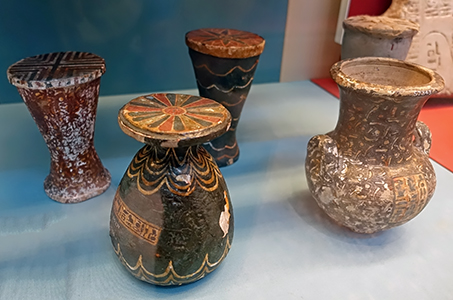
Eighteenth Dynasty: 1 550 BC - 1 292 BC
Model vessels
Mid to late 18th Dynasty, circa 1 450 BC - 1 295 BC.
The tombs of wealthy individuals of the New Kingdom often contained dummy or model vessels, made of wood or pottery, which were painted to imitate stone, glass, or faience. Such dummies acted as magical substitutes for the actual objects.
Wooden vessel of the lady Satamun, imitating coloured glass, EA35271
Wooden vessel of the High Priest of Anhur Nebseny, imitating calcite, EA30454
Wooden vessel imitating porphyry, EA35269
Handled pottery vessel imitating granular stone, EA57343
Wooden vessel imitating glass, EA2464
Photo: Don Hitchcock 2018
Source: Original, British Museum
Text: Card at museum display, http://www.britishmuseum.org/, © Trustees of the British Museum, CC BY-NC-SA 4.0
Eighteenth Dynasty: 1 550 BC - 1 292 BC
Amenhotep-user and Tentwadj
Seated figure of Amenhotep-user and his wife Tentwadj.
Doorkeeper of the granary, and wife, with the outline of their son and daughter carved into the front of seat, and text mentioning Am un-Re of Karnak, Mut and Hathor.
Circa 1 425 BC
Catalog: Quartzite, Thebes, ÄM 2298
Photo: Don Hitchcock 2015, 2018
Source: Original, Staatliche Museen zu Berlin, Neues Museum, Germany
Text: © Card at the Staatliche Museen zu Berlin (CC BY-NC-SA 3.0 DE)
Additional text: http://www.griffith.ox.ac.uk/gri/3pm8sta3.pdf
Eighteenth - Twentieth Dynasty: 1 550 BC - 1 075 BC
Chain
---
Protodynastic: 3 200 BC
Ointment jar
Catalog: Abusir, amethyst, gold, ÄM 18775, ÄM 34405
Photo: Don Hitchcock 2018
Source: Display, Staatliche Museen zu Berlin, Neues Museum, Germany
Text: © Card at the Staatliche Museen zu Berlin (CC BY-NC-SA 3.0 DE)
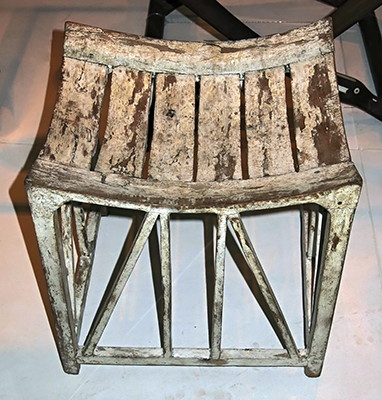
Eighteenth Dynasty: 1 550 BC - 1 292 BC
Stool
Wooden stool with lattice bracing, gessoed and painted white. The double-cove seat is formed of curved strips of wood with four slats in the centre. The wood was either steamed and bent or cut to shape. The surface has been gessoed and painted white.
Lattice bracing fills the voids between the four legs of the stool. The sides alternate in the use of one and two vertical struts, one for the shorter sides and two for the longer. A feature common in latticework stools is the slightly higher stretchers on the shorter sides, which preserves the strength of the wood by separating pairs of mortise-and-tenon joints.
( Stretchers are, in this case, the lowest horizontal piece of wood connecting pairs of legs - Don )
Height 381 mm, width 370 mm, depth 325 mm, weight 2200 grams.
Catalog: Thebes, EA2476
Photo: Don Hitchcock 2015
Source: Original, British Museum
Text: Card at museum display, http://www.britishmuseum.org/, © Trustees of the British Museum, CC BY-NC-SA 4.0
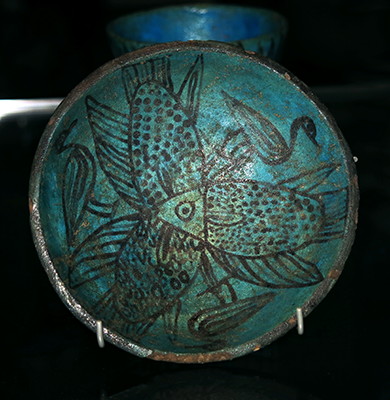
Eighteenth Dynasty: 1 550 BC - 1 292 BC
Bowl
Bright blue-green glazed composition (faience) bowl with circular foot and flaring base, slightly flaring sides and plain rim. The exterior is decorated with a painted flower motif, the interior with a representation of three interlocking fish with birds and floral motifs between. The rim is chipped.
Height 42 mm, diameter 127 mm.
Catalog: EA30449
Photo: Don Hitchcock 2015
Source: Original, British Museum
Text: Card at museum display, http://www.britishmuseum.org/, © Trustees of the British Museum, CC BY-NC-SA 4.0

Eighteenth Dynasty: 1 550 BC - 1 292 BC
Lotus cup
Blue-green glazed composition (faience) cup with circular foot, short stem and bell-shaped body, exterior elaborated with incised decoration representing lotus petals.
Height 136 mm, diameter 95 mm
Footed faience cups of this type were typically recovered from elite tombs.
Catalog: EA32626
Photo: Don Hitchcock 2015
Source: Original, British Museum
Text: Card at museum display, http://www.britishmuseum.org/, © Trustees of the British Museum, CC BY-NC-SA 4.0
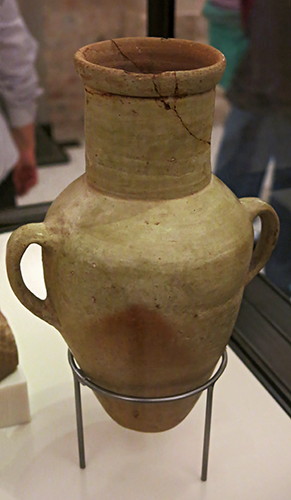
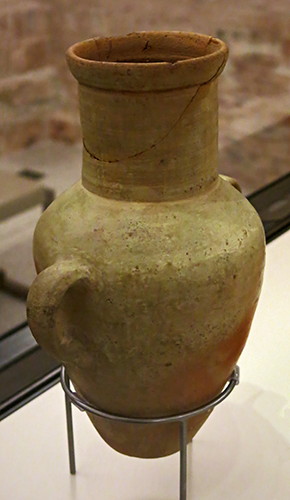
Eighteenth Dynasty: 1 550 BC - 1 292 BC
Beer Mug
Circa 1351 BC - 1334 BC, i.e. during the reign of Amenhotep IV / Akhenaten.
( see below for the way that this beer mug was used - Don )
Catalog: Amarna, Haus Q 47.13; Nilton, ÄM 22290
Photo: Don Hitchcock 2015
Source: Original, Staatliche Museen zu Berlin, Neues Museum, Germany
Text: © Card at the Staatliche Museen zu Berlin, (CC BY-NC-SA 3.0 DE)
Eighteenth Dynasty: 1 550 BC - 1 292 BC
Lead straw and strainer
Angular portion of a lead drinking-tube, with representation of a lily in the angle. The perforated bulb at one end would allow solids in the liquid ( probably beer rather than wine - Don ) to be filtered out. The other end is broken, and would have been significantly longer.
Found at el-Amarna, TA:21/477 Main City, House N.49.20 Found in the same house as the famous glass fish (EA55193), along with two small metal vases, buried under a 'double plaster floor',
Length 192 mm, width 110 mm, height: 3 millimetres
Catalog: EA55149
Photo: (left and centre) Don Hitchcock 2015
Photo: (right) © Trustees of the British Museum, CC BY-NC-SA 4.0
Source: Original, British Museum
Text: Card at museum display, http://www.britishmuseum.org/, © Trustees of the British Museum, CC BY-NC-SA 4.0

Eighteenth Dynasty: 1 550 BC - 1 292 BC
Stela depicting a Syrian mercenary drinking beer, using a lead straw very similar to the above.
Circa 1351 BC - 1334 BC, i.e. during the reign of Amenhotep IV / Akhenaten.
This stela shows the use of the straw, made with a strengthening triangle at the bend, as shown here, with a coarse filter in the beer flagon end to suck the beer from the flagon, thus avoiding the malt floating on top.
( When I saw the beer mug above, I thought 'That's not a beer mug, this is a beer mug!' However this stela shows that it was used more like a beer flagon, and there was a 'straw' used (typically made of lead, with a strengthening triangle at the bend, as shown here with a coarse filter in the beer flagon end) to suck the beer from the flagon, avoiding the malt floating on top. Presumably the 'straw' could have been handed around a group of people sitting at the same table, drinking and talking - Don )
Catalog: Painted limestone, ÄM 14122
Photo: Don Hitchcock 2018
Source: Original, Staatliche Museen zu Berlin, Neues Museum, Germany
Text: © Card at the Staatliche Museen zu Berlin, (CC BY-NC-SA 3.0 DE)
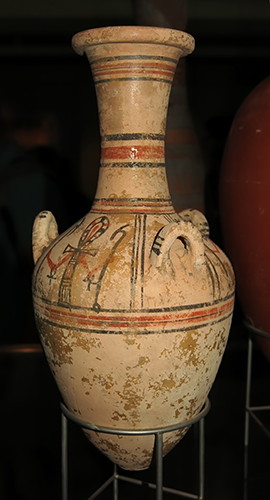
Eighteenth Dynasty: 1 550 BC - 1 292 BC
Pottery jar
Pottery jar with a painted base, convex sides widening to a rounded shoulder with three stirrup-handles. The tall concave neck widens to an everted rim. The vessel is decorated with a buff-coloured slip, and decoration in red and black paint.
Three painted representations of an ankh-sign with arms holding two Was-sceptres (and with two smaller ankh-signs suspended from the arms) are arranged between parallel bands of red and black paint. Further bands embellish the neck of the vase.
Height 275 mm, diameter: 120 mm
A similar form of jar, also with black and red banded decoration but not the ankh-signs, was found as part of a large group of ceramic vessels in tomb 1169 at Deir el-Medina (Nagel, La céramique du Novel Empire à Deir el Médineh, DFIFAO 10, 93 fig.73)
( since no date is given on the museum card nor on the online catalog, I have given this piece the same date as the tomb 1169 mentioned above - Don )
Catalog: EA4861
Photo: Don Hitchcock 2015
Source: Original, British Museum
Text: Card at museum display, http://www.britishmuseum.org/, © Trustees of the British Museum, CC BY-NC-SA 4.0
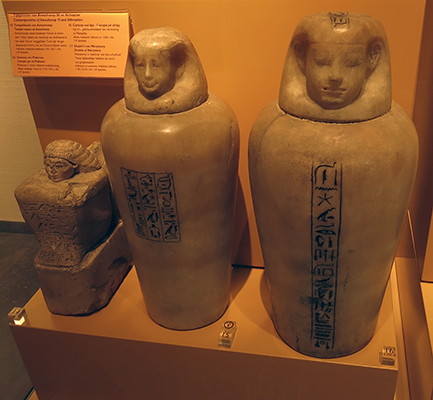
Eighteenth Dynasty: 1 550 BC - 1 292 BC
Contemporaries of Amenhotep III and Akhenaten
(left, 14) Temple statue of Amenhotep.
The Amenhotep name means 'Amon is satisfied'. But during the Akhenaten revolution the 'Amon' part was cut away. Yet the god names Osiris, Isis and Onuris remain. Circa 1 391 BC - 1 353 BC.
Limestone, unknown provenance.
(centre, 15) Canopic jar of Ptahmes. He was a vizier or viceroy.
Alabaster, Thebes (?), circa 1 391 BC - 1 353 BC
(right, 16) Canopic jar of Ipy. Ipy was the Chief Steward of the king in Mamphis.
Alabaster, Saqqara, circa 1 360 BC.
Photo: Don Hitchcock 2014
Source and text: Original, Rijksmuseum van Oudheden, National Museum of Antiquities, Leiden, http://www.rmo.nl/

Eighteenth Dynasty: 1 550 BC - 1 292 BC
Merymery
Shabtis of Merymery
Merymery was 'guardian of the treasury'. Two of the carvings are in the form of grain grinders.
Description of the shabti on the left:
Limestone, mummy shaped, 420 x 130 mm, from the time of Amenhotep III
Catalog: 44a
Photo: Don Hitchcock 2014
Source and text: Original, Rijksmuseum van Oudheden, National Museum of Antiquities, Leiden, http://www.rmo.nl/

Eighteenth Dynasty: 1 550 BC - 1 292 BC
General Djehuty
General Djehuty was a comrade of the pharaoh and governor of the conquered territories in Palestine and Syria. His tomb contains, among other things, gifts from the pharaoh, including alabaster oil vases and gold bracelets, one of the bracelets inscribed with the name of Thutmose III. There is a collar closure in a lotus shape, and a scarab with gold chain, all dated to the reign of Thutmose III, circa 1 485 BC - 1 425 BC.
On the right is a grave model of a slate writing palette, 385 x 57 x 10 mm, Catalog: AD 39.
Photo: Don Hitchcock 2014
Source and text: Original, Rijksmuseum van Oudheden, National Museum of Antiquities, Leiden, http://www.rmo.nl/
Additional text: http://www.tasaram.com/scarves-in-antiquity.html
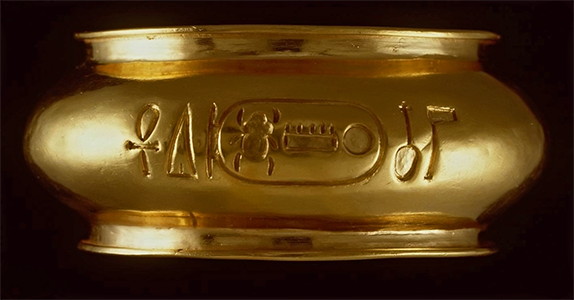
Eighteenth Dynasty: 1 550 BC - 1 292 BC
General Djehuty
To the left of the top of this writing palette is this very beautiful so-called 'bracelet', far too small to fit on an adult's arm, with the inscription of Thutmose III clearly visible. 38 mm wide,
( this 'bracelet' must have performed some other function, such as a ceremonial ring for the finger or thumb (it seems too delicate and thick for everyday use), or perhaps as a closure for a scarf - Don )
The ancient Egyptians wore small shawls or scarves (probably of linen) around their shoulders like little capes, and larger shawl-like scarves draped across their shoulders - often asymmetrically - and tied around the waist. The fabric was fine and gauze-like and the accordion pleats were created by pressing the damp fabric onto ribbed wooden boards.
Catalog: AO 2b
Photo: http://www.rmo.nl/collectie/zoeken?object=AO+2b
Source and text: Original, Rijksmuseum van Oudheden, National Museum of Antiquities, Leiden, http://www.rmo.nl/
Additional text: http://www.tasaram.com/scarves-in-antiquity.html
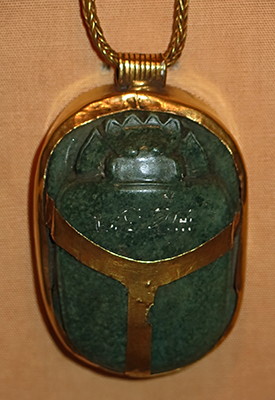
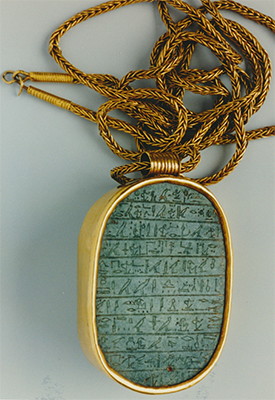
Eighteenth Dynasty: 1 550 BC - 1 292 BC
General Djehuty
This piece is the scarab in green jasper from the tomb of General Djehuty, with gold fittings and attached to a long gold chain, with inscriptions for General Djehuty, and dimensions of 83 x 54 x 1330 mm, dated to the reign of Thutmose III, circa 1 485 BC - 1 425 BC.
Catalog: AO 1a
Photo (left): Don Hitchcock 2014
Photo (right): http://www.rmo.nl/collectie/zoeken?object=AO+1a
Source and text: Original, Rijksmuseum van Oudheden, National Museum of Antiquities, Leiden, http://www.rmo.nl/

Eighteenth Dynasty: 1 550 BC - 1 292 BC
General Djehuty
Alabaster oil vases dated to the reign of Thutmose III, circa 1 485 BC - 1 425 BC.
Centre: Alabastron with inscription of Djehoety, 270 x 175 x 175 mm.
Catalog: L.VIII.20
Photo: Don Hitchcock 2014
Source and text: Original, Rijksmuseum van Oudheden, National Museum of Antiquities, Leiden, http://www.rmo.nl/
The Egyptian Trojan Horse
Djehuty is known from two sources. His undisturbed burial was found in 1824 at Saqqara and he is the main personality in the Egyptian story of 'The Taking of Joppa' (today Jaffa).The Egyptian narrative is preserved on a papyrus now located in the British Museum (EA10060). The city of Joppa had rebelled against Thutmose III's authority and the pharaoh responded by dispatching an Egyptian army under Djehuty to regain control over the city. Djehuty first cunningly arranged to have a parley or talk with the rebel leader of Joppa at a location outside of the city walls. Once he was alone with the leader of the rebellion, Djehuty promptly smote the man on his forehead and captured him.
With this task accomplished, Djehuty decided to take control of the city by subterfuge. Djehuty first falsely proclaimed that he, Djehuty, had been defeated by the rebels and was now sending a 'tribute' to the inhabitants of Joppa. The tribute came in the form of two hundred baskets which were delivered to Joppa as a peace offering by Djehuty. Unbeknownst to Joppa's inhabitants, however, each of the baskets concealed one of Djehuty's own soldiers.
The governor of Joppa, fooled by Djehuty's ruse, had them taken into the city through its city gates. Soon after, Djehuty's soldiers rose out of their baskets and quickly captured the city and seized its citizens. The Egyptian description of the capture of Joppa is, hence, somewhat similar to the story of the Trojan Horse which hypothetically occurred some two centuries later at Troy. With Joppa now firmly back in Egyptian hands, Djehuty sent word to his king, Thutmose III, of his triumph:
'Be of good cheer! For Amun, your good father, has given to you, the rebel of Joppa and all his people, as well as his city. Send men to take them away as captives that you may fill the house of your father Amun-Ra, King of the Gods, with male and female slaves, who have fallen beneath your feet forever.'
Text above: Adapted from Wikipedia
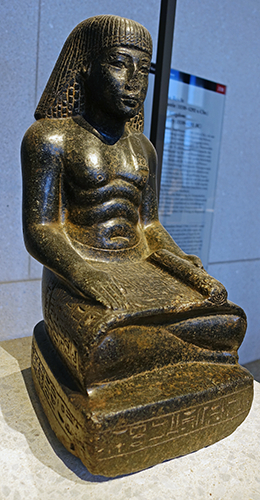
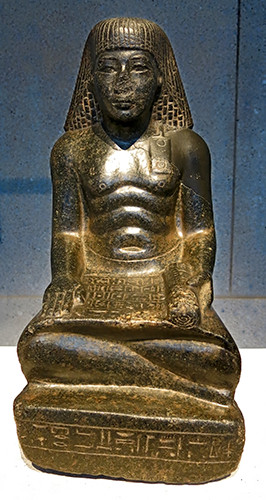
Eighteenth Dynasty: 1 550 BC - 1 292 BC
Sobekhotep
Scribe figure of Sobekhotep, chief of the treasury during part of the reign of Amenhotep III.
Circa 1 388 BC - 1 350 BC.
Catalog: Grey granite, Dime (?) , ÄM 11635
Photo: Don Hitchcock 2015, 2018
Source: Original, Staatliche Museen zu Berlin, Neues Museum, Germany
Text: © Card at the Staatliche Museen zu Berlin (CC BY-NC-SA 3.0 DE)
O'Connor, Cline (1961) write, in part:
Sobekmose's family is also unusual for the relatively secure dating of its members' tenure in office. Sobeknakht was already steward of Amon by year 20, when he joined the staff of Amon's high priests to witness the installation of one Nebnefer a chief grain measurer in the shena of the divine offerings of Amon. Sobeknakht's on, the treasurer Sobekmose, was in office by year 30, when he contributed wine to his master's first jubilee: at that time, his own son Sobekhotep was already an adult but still served as a subordinate treasury scribe. Six years later, however, Sobekhotep had replaced his father as chief treasurer and was deep in preparations for the king's third Sed Festival.
While most officials emerge from official records with no individual marks to colour the bland recital of their achievements, a tiny personal detail my perhaps be inferred for Sobekhotep. If his nickname, Panehsy, ' The Nubian '. is taken at face value, he would have been one of those dark complexioned Saïdis who still populate the towns and villages of Upper Egypt in great numbers. At an earlier stage of his career, he led trade and mining expeditions abroad in person.

Eighteenth Dynasty: 1 550 BC - 1 292 BC
Daughters of Amenhotep III and Tiye
Circa 1 355 BC.
Catalog: Limestone, West Thebes, Grave of Cheruef (TT 192), ÄM 18526
Photo: Don Hitchcock 2018
Source: Original, Staatliche Museen zu Berlin, Neues Museum, Germany
Text: © Card at the Staatliche Museen zu Berlin, (CC BY-NC-SA 3.0 DE)
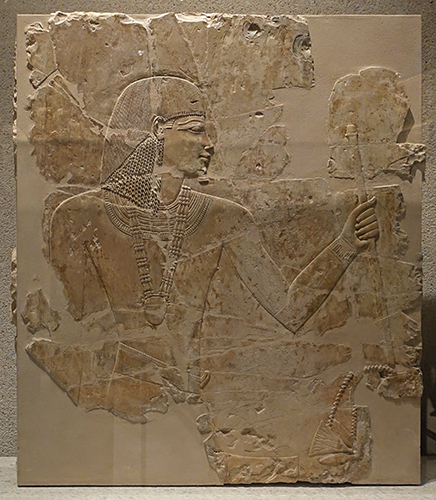
Eighteenth Dynasty: 1 550 BC - 1 292 BC
Khaemhat
Khaemhat, Chief of the Granary during the reign of Amenhotep III.
Circa 1 360 BC
Catalog: Sandstone, Tomb TT 57, Western Thebes, ÄM 2063
Photo: Don Hitchcock 2018
Source: Original, Staatliche Museen zu Berlin, Neues Museum, Germany
Text: © Card at the Staatliche Museen zu Berlin (CC BY-NC-SA 3.0 DE)

Eighteenth Dynasty: 1 550 BC - 1 292 BC
Khaemhat's tomb
Tomb of Khaemhat, Chief of the Granary during the reign of Amenhotep III.
Plan of Theban tomb 57, built circa 1 360 BC
( note that the plan of TT57 in Wikipedia is actually that of TT47. See http://www.griffith.ox.ac.uk/gri/4khaem.html for further details - Don )
Photo: http://www.griffith.ox.ac.uk/gri/4khaem.html
Eighteenth Dynasty: 1 550 BC - 1 292 BC
King Amenhotep III
Reign of Amenhotep III, 1 388 BC - 1 350 BC.
Circa 1 360 BC.
Granodiorite statue of Amenhotep III: the statue, mounted on a pedestal, represents a figure seated on a throne, wearing the 'nemes' head-dress with uraeus, and a beard, bead-collar, short skirt and tail. On the sides of the throne is incised a hieroglyphic symbol flanked by lily and papyrus flowers intertwined, symbolising the union of the Two Lands.
The inscriptions are incised on the girdle of the skirt and on the front and back of the throne. The inscriptions are well preserved, with the exception of the one on the right-hand side of the front of the throne, which is somewhat mutilated. The cartouches containing the name of Amenhotep III and the other places in which this name appears have been erased and recut in antiquity. The statue has been restored.
The statue comes from the king's mortuary temple in Western Thebes. It housed hundreds of statues of himself and the gods.
The temple, one of Egypt's largest, stood on the border between desert and fertile land west of the River Nile. It accommodated the ruler's posthumous offering cult. His tomb lies miles away, in a secluded desert valley.
Height 2900 mm, length 1414 mm, width 830 mm.
Catalog: Granodiorite, Temple of Amenhotep III (Thebes), EA5
Photo: Don Hitchcock 2018
Source: Original, British Museum
Text: Card with the display at the British Museum, www.britishmuseum.org/, © Trustees of the British Museum, CC BY-NC-SA 4.0
Eighteenth Dynasty: 1 550 BC - 1 292 BC
King Amenhotep III
Reign of Amenhotep III, 1 388 BC - 1 350 BC.
Circa 1 360 BC.
Granodiorite seated statue of Amenhotep III; restored.
The statue comes from the king's mortuary temple in Western Thebes. It housed hundreds of statues of himself and the gods.
Amenhotep III was leader of numerous campaigns in Syria-Palestine, builder of numerous temples, shrines, and buildings in Thebes and Memphis, husband to Queen Tiyi and a bevy of lesser wives, including the daughters of the kings of Babylon, Hatti, and Mitanni, Amenhotep III above all encouraged foreign exploration and trade to regions far beyond the borders of Egypt.
Study of Amenhotep III reveals a fascinating and complex individual, responsible in more than one way for the religious and political upheavals that occurred during the reign of his son Akhenaten.
Amenhotep has the distinction of having the most surviving statues of any Egyptian pharaoh, with over 250 identified. These statues provide a series of portraits covering the entire length of his reign.
When Amenhotep died, he left behind a country at the very height of its power and influence, commanding immense respect in the international world. However, it was a country wedded to age-old political and religious certainties under the Amun priesthood.
The resulting upheavals from his son Akhenaten's reforming zeal shook these old certainties to their foundations, and forced the momentous question whether a pharaoh was more powerful than his society as represented in the worship of Amun. Akhenaten even moved the capital away from Thebes, the center of Amun's worship, and built Amarna, a city dedicated to his new deity, the Aten.
The name Belzoni is deeply carved onto the base. Giovanni Battista Belzoni 5 November 1778 – 3 December 1823), sometimes known as The Great Belzoni, was a prolific Italian explorer and pioneer archaeologist of Egyptian antiquities. He is known for his removal to England of the seven ton bust of Ramesses II, the clearing of sand from the entrance of the great temple at Abu Simbel, the discovery and documentation of the tomb of Seti I (still sometimes known as 'Belzoni's Tomb'), including the sarcophagus of Seti I, and the first to penetrate into the Pyramid of Khafre, the second pyramid of the Giza complex.
Catalog: Granodiorite, Temple of Amenhotep III (Thebes), EA4
Photo: Don Hitchcock 2018
Source: Original, British Museum
Text: Card with the display at the British Museum, www.britishmuseum.org/, © Trustees of the British Museum, CC BY-NC-SA 4.0
Additional text: Wikipedia
A good resource: archive.org/details/AmenhotepIIIPerspectivesOnHisReign_201905/page/n49/mode/2up
Eighteenth Dynasty: 1 550 BC - 1 292 BC
King Amenhotep III
Head of a statue of King Amenhotep III, wearing nemes and double crown, circa 1360 BC.
Catalog: Diorite, Heliopolis (?), VÄGM 1997/118
Photo: Don Hitchcock 2015, 2018
Source: Original, Staatliche Museen zu Berlin, Neues Museum, Germany
Text: © Card at the Staatliche Museen zu Berlin, (CC BY-NC-SA 3.0 DE)
Eighteenth Dynasty: 1 550 BC - 1 292 BC
King Amenhotep III
Head of a statue of Pharaoh Amenhotep III.
Granodiorite ('black granite') New Kingdom, 18th Dynasty, around 1400 BC.
The head is an outstanding example of the art of the time of Amenhotep III, which can be clearly identified both by the striking style of the facial features and by the name cartouches on the back pillar.
Inv. no. 1935.200.112
Photo: Don Hitchcock 2018
Source and text: Original, Museum August Kestner, Hannover
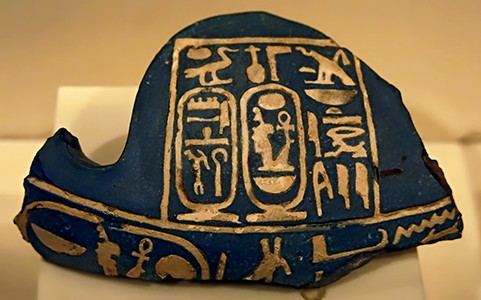
Eighteenth Dynasty: 1 550 BC - 1 292 BC
King Amenhotep III
Cartouche of King Amenhotep III, circa 1388 - 1350 BC.
Catalog: Faience, ÄM 7241
Photo: Don Hitchcock 2015
Source: Original, Staatliche Museen zu Berlin, Neues Museum, Germany
Text: © Card at the Staatliche Museen zu Berlin, (CC BY-NC-SA 3.0 DE)
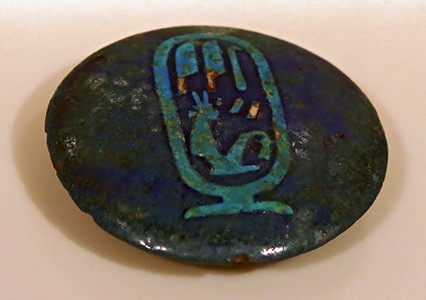
Eighteenth Dynasty: 1 550 BC - 1 292 BC
Queen Tiy cartouche
Button of a chest with the cartouche of Tiy, circa 1388 - 1351 BC.
Catalog: Faience, ÄM 20567
Photo: Don Hitchcock 2015
Source: Original, Staatliche Museen zu Berlin, Neues Museum, Germany
Text: © Card at the Staatliche Museen zu Berlin, (CC BY-NC-SA 3.0 DE)
Eighteenth Dynasty: 1 550 BC - 1 292 BC
Spoon in the form of a swimmer
Circa 1 353 BC - 1 332 BC
Length 200 mm, width 55 mm, Carob wood.
Cosmetic spoon for rouge with a rectangular bowl in the form of a naked female swimmer with a short wig.
Catalog: Wood, from Gourob/Fayoum, Middle Egypt, according to the seller, E 11122
Photo: Don Hitchcock 2015, 2018
Source and text: Louvre Museum, Paris, France, https://collections.louvre.fr/en/ark:/53355/cl010007472
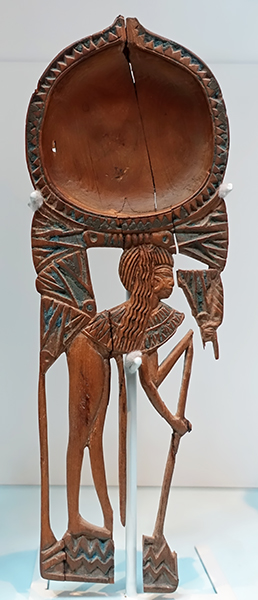
Eighteenth Dynasty: 1 550 BC - 1 292 BC
Cosmetic Spoon
Wooden cosmetic-spoon. The bowl is decorated with inlays in a floral motif, while the handle features an openwork representation of a young girl amongst marsh plants, with an indication of water at the base. The girl wears an earring and has elaborate hair, but is otherwise naked.
( The young girl does appear, however, to be wearing a short cape around her neck and upper body - Don )
Length 165 mm, width 5 mm, depth 60 mm, weight 20 grams.
( Note that the carving appears to have been originally inlaid with Egyptian Blue, calcium copper silicate, the first synthetic pigment, of which remnants remain - Don )
Catalog: Wood, EA38188
Photo: Don Hitchcock 2018
Source: Original, British Museum
Text: Card at museum display, http://www.britishmuseum.org/, © Trustees of the British Museum, CC BY-NC-SA 4.0
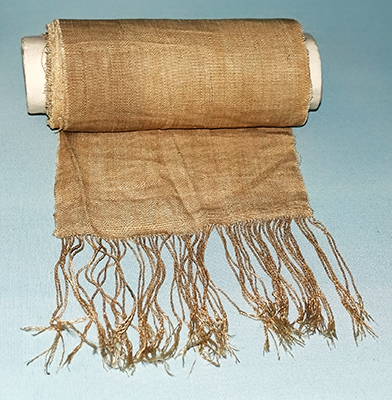
Eighteenth Dynasty: 1 550 BC - 1 292 BC
Funerary Cloth
Fragment of linen mummy wrapping.
Textile fragment; strip of medium-quality, undyed linen from tunic (?); warp fringe at each end preceded by triple self-band. The weave is compact and plain [warp-faced simple tabby] and the threads are S-spun and S-spliced; the stitch gauge is warp c.28 ends per 10mm and weft c.12 picks per 10mm. The warp fringes are made of up of groups of 6 threads = 2x3 Z-plied then S-twisted, knotted at the top (unclear whether originally knotted or looped as the ends are worn away).
Dimensions: Length 2560 mm (max), length 115 mm (fringe a), length: 90 mm (fringe b)
Width: 140 mm (max)
Catalog: EA6542
Photo: Don Hitchcock 2018
Source: Original, British Museum
Text: Card with the display at the British Museum, https://www.britishmuseum.org/, © Trustees of the British Museum, CC BY-NC-SA 4.0

New Kingdom: 1 550 - 1 077 BC
Painted Limestone Figurine
Limestone female figurine representing a woman and child on a bed, from Thebes.
These figures apparently related to fertility and birth during the life on earth, and promoted rebirth after death.
Length 235 mm, width 95 mm, thickness 63 mm.
Catalog: EA2371
Photo: Don Hitchcock 2018
Source: Original, British Museum
Text: www.britishmuseum.org/research/ and card at the Museum, © Trustees of the British Museum, CC BY-NC-SA 4.0
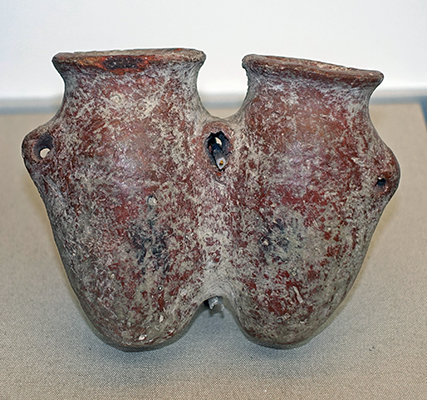
New Kingdom: 1 550 - 1 077 BC
Double Vessel
Burnished red-brown pottery double-vessel comprising two jars with pointed bases, convex bodies and everted rims, each has pierced lug-handles at the shoulder.
Dimensions: height 58 mm, length 73 mm, depth 37 mm.
Catalog: New Kingdom (?), EA57951
Photo: Don Hitchcock 2018
Source: Original, British Museum
Text: Card at the British Museum, © Trustees of the British Museum, CC BY-NC-SA 4.0
New Kingdom: 1 550 - 1 077 BC
Sandals
Pair of woven palm leaf sandals, with toe ends curled upwards and joining the loop passing over the instep. These sandals have also been provided with high sides, creating a more shoe-like appearance. The sole is formed from a piece of widely-plaited palm fibre, stitched to sides of finer woven palm.
Left sandal: height 85 mm, length 325 mm, depth 105 mm.
Right sandal: height 100 mm, length 350 mm, depth 108 mm.
These are likely to be from a high status tomb, as sandals were a common part of the elite New Kingdom burial assemblage.
Catalog: New Kingdom, EA4464
Photo: Don Hitchcock 2015
Source: Original, British Museum
Text: Card at the British Museum, © Trustees of the British Museum, CC BY-NC-SA 4.0

Eighteenth Dynasty: 1 550 BC - 1 292 BC
Funerary Shroud
Fragment of dyed linen shroud.
Provenance unknown.
The outer shrouds of mummies were frequently dyed a deep reddish-pink using a dye made from the Safflower plant.
Catalog: EA6523
Photo: Don Hitchcock 2018
Source: Original, British Museum
Text: Card with the display at the British Museum, https://www.britishmuseum.org/, © Trustees of the British Museum, CC BY-NC-SA 4.0

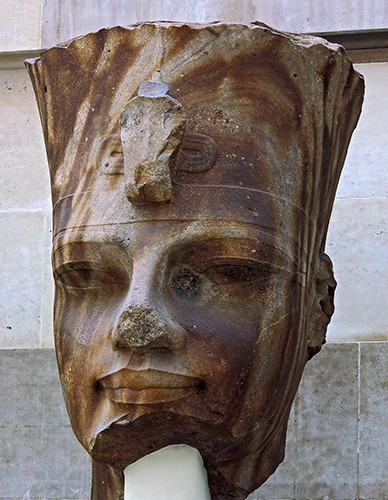
Eighteenth Dynasty: 1 550 BC - 1 292 BC
King Amenhotep III
Circa 1 388 BC - 1 350 BC.
These two heads come from a pair of colossal statues set up in the king's mortuary temple in western Thebes.
On the left, EA6 wears the red crown of Egypt.
On the right, EA7, the quartzite head of Amenhotep III wearing the red crown with uraeus. Despite its huge size, this head has been carved with infinite care. As on all of Amenhotep Ill's large statues, the eyeballs are noticeably angled back from the top to the bottom lid so that they appear to look down toward the viewer. The finishing polish was deliberately varied, from a glittering smoothness on the facial surfaces to less polish on the mouth and eyes - which thus seem slightly different in colour - to quite rough surfaces on the brows and cosmetic lines.
It is a round face, with plump, youthful-looking cheeks, and little indication of the underlying bone structure. The eyes are large, long, and rather narrow, with a slight slant. Heavily made-up eyebrows and upper lids, indicated in relief, extend back to the temples. The nose is rather broad at the nostrils, with a round tip. The mouth is full, its contours defined by a crisply cut outline. The upper lip is thicker than the lower, over which it droops in the centre. The lower lip curves in a perfect shallow arc up to the open corners of the mouth, to produce the effect of a slight smile.
EA6: height 1170 mm.
EA7: height 1170 mm, width 810 mm, depth 660 mm.
Catalog: Quartzite, Thebes, EA6, EA7
Photo: Don Hitchcock 2015
Source: Original, British Museum
Text: Card at the British Museum, http://www.britishmuseum.org/, © Trustees of the British Museum, CC BY-NC-SA 4.0
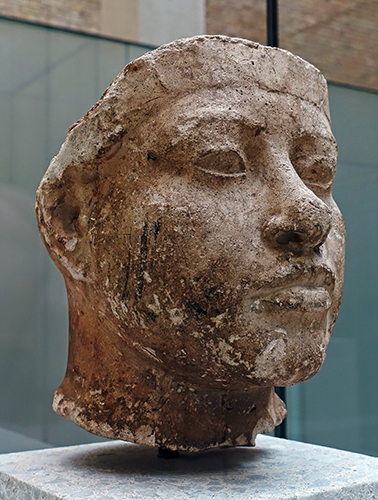
Eighteenth Dynasty: 1 550 BC - 1 292 BC
Head of a King.
Head of the statue of a King, probably Amenhotep III.
Plaster model, 225 x 195 x 220 mm.
This face is distinguished from the other royal studies by its completely different physiognomy. The full face is characterised by a high degree of symmetry. Not only the full cheeks and the powerful, fleshy nose, the full mouth with the slightly raised lips, the round chin and the straight, short and wide neck, but also the characteristically shaped eyes with the barely indicated brows cause us to assume that this is a portrait of Amenhotep III.
Catalog: Amarna, plaster, ÄM 21299
Photo: Don Hitchcock 2015, 2018
Source: Original, Staatliche Museen zu Berlin, Neues Museum, Germany
Text: © Card at the Staatliche Museen zu Berlin, http://www.smb-digital.de/ (CC BY-NC-SA 3.0 DE)
Additional text: Seyfried (2012)
Eighteenth Dynasty: 1 550 BC - 1 292 BC
King Amenhotep III
Circa 1 388 BC - 1 350 BC
Bust of King Amenhotep III. This fragment belonged to a seated pair statue of the king and his wife, Queen Tiye. Originally it stood in Amenhotep's mortuary temple in Western Thebes. The building was apparently devastated by an earthquake some 150 years later, in the reign of Mereneptah. The statue was then moved and reused in Mereneptah's own mortuary temple nearby.
Head and upper torso of monumental limestone statue of Amenhotep III wearing nemes. The nemes is the striped headcloth worn by pharaohs in ancient Egypt. It covered the whole crown and back of the head and nape of the neck (sometimes also extending a little way down the back) and had lappets, two large flaps which hung down behind the ears and in front of both shoulders.
Height: 1523 mm
Catalog: Limestone, Thebes, EA3
Photo: Don Hitchcock 2015
Source: Original, British Museum
Text: Card at the British Museum, http://www.britishmuseum.org/, © Trustees of the British Museum, CC BY-NC-SA 4.0
Additional text: Wikipedia

Eighteenth Dynasty: 1 550 BC - 1 292 BC
King Amenhotep III
Circa 1 388 BC - 1 350 BC
The bust above has been recently identified as one of the upper parts of a pair statue of Amenhotep III and queen Tiye, the lower part of which has now been re-erected in Merenptah's mortuary temple. Merenptah reused many blocks and statues from Amenhotep III's temple.
Catalog: Limestone, Thebes, EA3
Photo: © Trustees of the British Museum, CC BY-NC-SA 4.0
Rephotography: Don Hitchcock 2015
Source: Poster, British Museum
Text: Poster at the British Museum, http://www.britishmuseum.org/, © Trustees of the British Museum, CC BY-NC-SA 4.0
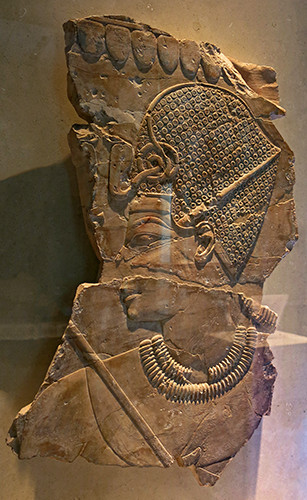
Eighteenth Dynasty: 1 550 BC - 1 292 BC
King Amenhotep III
King Amenhotep III wearing the blue crown.
The khepresh was an ancient Egyptian royal headdress. It is also known as the blue crown or war crown. New Kingdom pharaohs are often depicted wearing it in battle, but it was also frequently worn in ceremonies. It used to be called a war crown by many, but modern historians refrain from defining it thus. The khepresh was made of cloth or leather stained blue and was covered with small yellow sun discs. It was represented in hieroglyphs. As with many other royal crowns, it featured a uraeus fastened to its front.
The earliest known mention of the khepresh is on the stela Cairo JE 59635 (CG 20799) which dates to the reign of pharaoh Neferhotep III, during the Second Intermediate Period. After Amenhotep III's reign – and particularly during the 18th and 19th Dynasties – it came into fashion and was even adopted by some pharaohs as a primary crown. The crown ceased to be depicted in the Kushite Dynasty (747 BC to 656 BC).
During the New Kingdom, pharaohs were shown with this crown in military circumstances. However, some scholars think that the crown was also meant to evoke the divine power of the pharaoh, and was thus worn to religiously situate kings as manifestations of gods on earth.
Catalog: Limestone, West Thebes, Tomb of Chaemhat, ÄM 14442
Photo: Don Hitchcock 2015
Source: Original, Staatliche Museen zu Berlin, Neues Museum, Germany
Text: © Card at the Staatliche Museen zu Berlin (CC BY-NC-SA 3.0 DE)
Additional text: Wikipedia
Eighteenth Dynasty: 1 550 BC - 1 292 BC
Usersatet from Kush
Sandstone stela of Usersatet, an Egyptian Viceroy of Kush, from Wadi Halfa, circa 1 430 BC. Abyssinia, or Ethiopia, was known as Kush to the ancient Egyptians.
Usersatet makes offerings to the god Thoth, Lord of Ta-Seti (Nubia). Below is a funerary prayer to Thoth. Usersatet served under Pharaoh Amenhotep II.
Catalog: Sandstone, Wadi Halfa, EA623
Photo (left): Don Hitchcock 2015
Photo (right): © Trustees of the British Museum, CC BY-NC-SA 4.0
Source: Original, British Museum
Text: Card with the display at the British Museum, © Trustees of the British Museum, CC BY-NC-SA 4.0
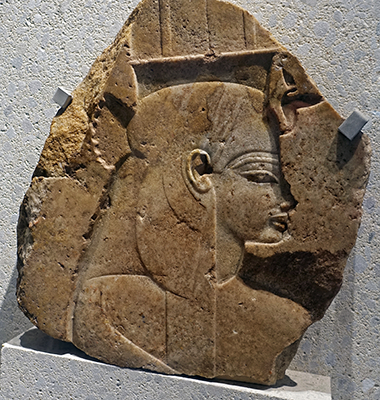
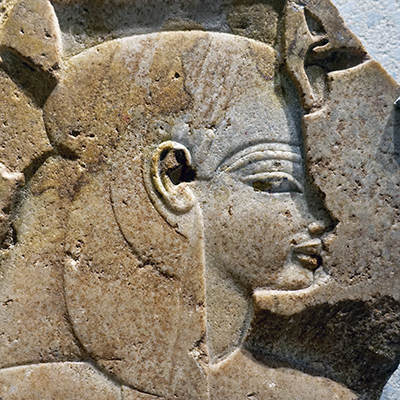
Eighteenth Dynasty: 1 550 BC - 1 292 BC
Queen Tiye
Fragment of a relief representing Queen Tiye, wife of Amenhotep III.
Circa 1375 BC
Relief fragment with representation of Queen Tiye from a stele of Amenhotep III.
Painted sandstone, 375 x 360 x 75 mm.
Attached to the hood is the symbol of the Upper Egyptian crown goddess, the head of a vulture, as well as the royal serpent, the Uraus, carrying the crown of Upper Egypt.
The fragment was part of the gable of a stele.
Tiye came from a ' bourgeois ' family of provincial officials. She was chief queen during the entire reign of Amenhotep III. This special significance can be seen, for example, in the pictorial representations, in which she replaced the royal mother as the most important woman at court. She occupied an almost equal position beside the king, both in public appearances and in correspondence with foreign rulers, but without denying her non-royal origin.
As noted by O'Connor, Cline (1961):
' The unprecedented thing about Tiyi. ... is not where she came from but what she became. No previous queen ever figured so prominently in her husband's lifetime. Tiyi regularly appeared besides Amenhotep III in statuary, tomb and temple reliefs, and stelae while her name is paired with his on numerous small objects, such as vessels and jewellery, not to mention the large commemorative scarabs, where her name regularly follows his in the dateline.
New elements in her portraiture, such as the addition of cows' horns and sun discs - attributes of the goddess Hathor - to her headdress, and her representation in the form of a sphinx - an image formerly reserved for the king - emphasise her role as the king's divine, as well as earthly partner. Amenhotep III built a temple to her in Sedeinga in northern Sudan, where she was worshiped as a form of Hathor ... The temple at Sedeinga was the pendant to Amenhotep III's own, larger temple at Soleb, fifteen kilometres to the south (an arrangement followed a century later by Ramses II at Abu Simbel, where there are likewise two temples, the larger southern temple dedicated to the king, and the smaller, northern temple dedicated to the queen, Nefertiry, as Hathor) '.
Catalog: Painted sandstone, mortuary temple of Amenhotep III, ÄM 23270
Photo: Don Hitchcock 2018
Source: Original, Staatliche Museen zu Berlin, Neues Museum, Germany
Text: © Card at the Staatliche Museen zu Berlin, K. Finneiser at http://www.smb-digital.de/ (CC BY-NC-SA 3.0 DE)
Additional text: O'Connor, Cline (1961)
Amenhotep III and Tiye
The reign of Amenhotep III marked the beginning of a new political era with a strong focus on diplomatic relations with neighbouring peoples and an economic upturn in Egypt. Amenhotep III was unconventional in the choice of his 'Great Royal Wife', Tiye, who was in fact a commoner by birth.
The royal couple had two sons. The first-born, Thutmose, died young, leaving the second-born to succeed his father to the throne as Amenhotep IV / Echnaton. Tiye supported her son who raised her status from that of a queen mother to that of a goddess by reworking her famous head statue.

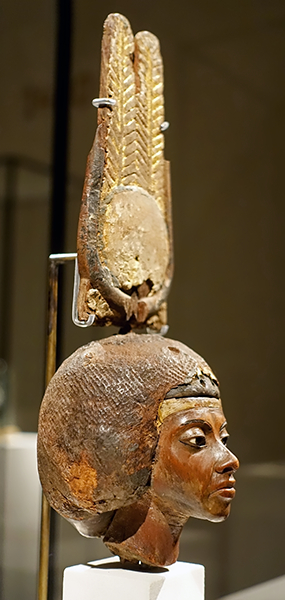
Eighteenth Dynasty: 1 550 BC - 1 292 BC
Queen Tiye
Head of a statuette of queen Tiye with double feather crown, 225 mm high.
Circa 1 355 BC
Tiy was the spouse of King Amenhotep III and mother of Akhenaten. This small portrait was probably produced in the last years of rule of her husband because the queen is shown at an advanced age. The artist produced a realistic face which captures the personality of Tiy: Intelligent, determined and assertive, all qualities which are also evident through historic-literary sources.
After the death of Amenhotep III and still in the lifetime of Tiy the head was reworked, the originally head scarf of silver with the gold uraeus was covered with several layers of linen which were decorated with small faience beads. A crown consisting of a sundisc, cow horns and a pair of feathers was added separately.
Catalog: Yew wood, silver, gold and faience inlays, Medinet el Gurob, ÄM 21834, ÄM 17852
Photo: Don Hitchcock 2018
Source: Original, Staatliche Museen zu Berlin, Neues Museum, Germany
Text: © Card at the Staatliche Museen zu Berlin, K. Finneiser at http://www.smb-digital.de/ (CC BY-NC-SA 3.0 DE)
Additional text: http://www.egyptian-museum-berlin.com/c52.php
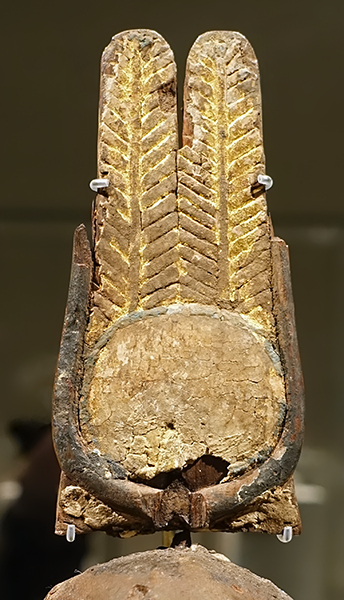
Eighteenth Dynasty: 1 550 BC - 1 292 BC
Queen Tiye
Closeup of the double feather crown of queen Tiye.
Circa 1 355 BC
This type of crown is usually worn by goddesses or deified queens. By adding this crown to the statue Akhenaten raised his mother, already in her lifetime, into the realm of a goddess.
The crown was rediscovered in our collection after having been separated from the head for many years .
Catalog: Yew wood, silver, gold and faience inlays, Medinet el Gurob, ÄM 21834, ÄM 17852
Photo: Don Hitchcock 2018
Source: Original, Staatliche Museen zu Berlin, Neues Museum, Germany
Text: © Card at the Staatliche Museen zu Berlin, K. Finneiser at http://www.smb-digital.de/ (CC BY-NC-SA 3.0 DE)
Additional text: http://www.egyptian-museum-berlin.com/c52.php
Eighteenth Dynasty: 1 550 BC - 1 292 BC
Gnomon
Amenhotep III
Shadow clock, or gnomon. A lead weight or plumb bob is used to make sure that it is level.
( I suspect that the gnomon would need to be rotated as the sun rose in the sky, to keep the shadow aligned exactly on the markings - Don )
Circa 1 388 BC - 1 350 BC
The shadow on the markings of the horizontal rod indicates how much time has elapsed since sunrise.
Height 50 mm, length 32 mm, thickness 19 mm
King Amenhotep III offers Maat (the balance of the world) to the sun god. On the small side, the goddess Sopdet/Sothis, 'mistress of the year' is shown.
Sopdet (or Sothis to the Greeks) is the ancient Egyptian name of the star Sirius.
Catalog: Wood, N 781
Photo: Don Hitchcock 2018
Source and text: Original, Louvre Museum, Paris, France
Additional text: http://cartelfr.louvre.fr/cartelfr/visite?srv=car_not_frame&idNotice=3409&langue=fr
Eighteenth Dynasty: 1 550 BC - 1 292 BC
Collar
Part of a gold collar. The collar consisted of a series of rows of gold beads, attached to terminals in the shape of open lotus flowers. Each row was composed of beads of different shape, mainly imitating plant forms. There are folded leaves, papyrus flowers on stems, mandrake fruits alone and with leaves, flower buds, lotus seed-vessels and closed buds of the lotus. The terminal and beads are excellent examples of the cloisonné work, which was one of the favourite techniques of Egyptian goldsmiths. Most of the inlays have fallen out, but the tiny traces of cornelian and blue glass give a faint hint at the rich impression which the collar would have created in its pristine state. Openwork.
Circa 1 370 BC - 1 300 BC.
Height 122 mm (as strung).
Curator's comments: This fragment, said to have been found on a mummy in the Memphite necropolis in the early 19th century, is a rare survival. It is possible that the elements of which it is made originally formed parts of more than one object, but most of them would certainly have belonged to a collar. The elements of this complex necklace were often a feature of jewellery made from less precious materials, for example glazed composition (faience) which also featured plant and fruit pendants, and lotus-flower terminals.
Catalog: Gold, glass, cornelian, cloisonné (enamelling), inlaid, Memphis (?), EA3074
Photo: Don Hitchcock 2018
Source: Original, British Museum
Text: Card with the display at the British Museum, https://www.britishmuseum.org/, © Trustees of the British Museum, CC BY-NC-SA 4.0
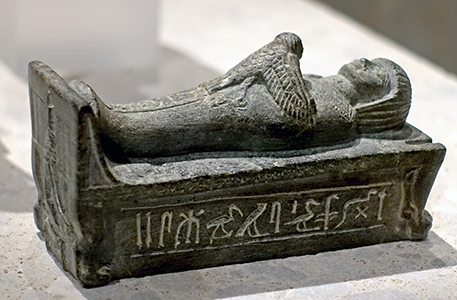
Eighteenth Dynasty: 1 550 BC - 1 292 BC
Prince Thothmose
Prince Thothmose / Thutmose lying on a bier (with sarcophagus)
Circa 1 360 BC
Thutmose (or, more accurately, Djhutmose) was the eldest son of Pharaoh Amenhotep III and Queen Tiye, who lived during the Eighteenth dynasty of Egypt. His apparent death led to the reign of Akhenaten, his younger brother - as the successor to the Egyptian throne - and the intrigues of the century leading up to Ramesses II, the start and ultimately the failure of Atenism, the Amarna letters, and the changing roles of the kingdom's powers.
Catalog: Steatite and limestone, VÄGM 1997/112
Photo: Don Hitchcock 2018
Source: Original, Staatliche Museen zu Berlin, Neues Museum, Germany
Text: © Card at the Staatliche Museen zu Berlin, (CC BY-NC-SA 3.0 DE)
Additional text: Wikipedia
Eighteenth Dynasty: 1 550 BC - 1 292 BC
Prince Thothmose
Prince Thothmose lying on a bier (with sarcophagus).
Circa 1 360 BC.
( On the base may be seen an image of Isis, kneeling - Don )
Catalog: Steatite and limestone, VÄGM 1997/112
Photo: Don Hitchcock 2018
Source: Original, Staatliche Museen zu Berlin, Neues Museum, Germany
Text: © Card at the Staatliche Museen zu Berlin, (CC BY-NC-SA 3.0 DE)
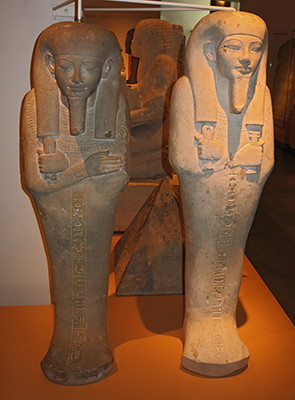
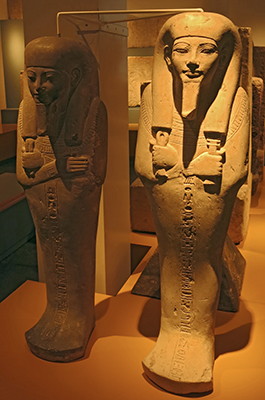
Eighteenth Dynasty: 1 550 BC - 1 292 BC
Tjel and Ipay
Statues of Tjel, Mayor of Memphis from the reign of Amenhotep III, right, with the statue of his wife, Ipay, left.
Circa 1 360 BC.
( note that these objects may be thought of as small statues or as large ushabti - Don )
Dimensions of Tjel statue: 1120 x 350 x 260 mm, circa 75 kg.
Dimensions of Ipay statue: 1080 x 340 x 260 mm, circa 75 kg.
Tjel, or Tjenuro, was the Mayor of Memphis and his wife Ipay was the chantress of Amun, the Royal Nurse. The statues are of mummiform design. Lady Ipay is represented as the god Osiris (complete with beard).
Catalog: AST 14, AST 15
Photo: Don Hitchcock 2014
Source and text: Rijksmuseum van Oudheden, National Museum of Antiquities, Leiden, http://www.rmo.nl/
Additional text: Schneider and Raven (1981), Schneider and Raven (1999)
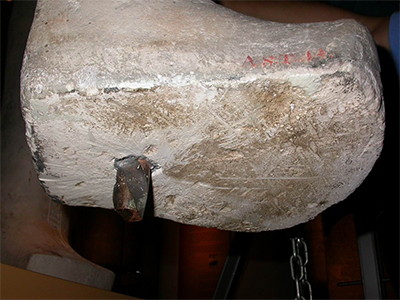
Eighteenth Dynasty: 1 550 BC - 1 292 BC
Tjel and Ipay
The statues have been stabilised by a pin in the base of the statue, projecting into the plinth below. Shown here is the pin of Ipay.
Length pin: 40 - 50 mm, average diameter of plinth hole: 28 mm.
Catalog: Saqqara, limestone, AST 14, AST 15
Photo and text: http://www.rmo.nl/
Source: Rijksmuseum van Oudheden, National Museum of Antiquities, Leiden.
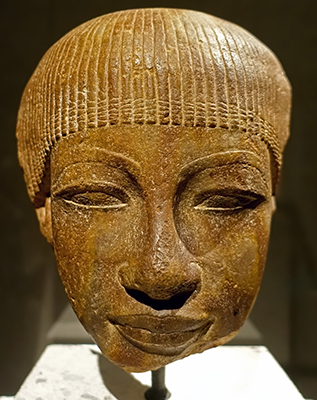
Eighteenth Dynasty: 1 550 BC - 1 292 BC
Head of a scribe, figure of an unknown man.
Circa 1360 BC
Catalog: Quartzite, ÄM 23150
Photo: Don Hitchcock 2015, 2018
Source: Original, Staatliche Museen zu Berlin, Neues Museum, Germany
Text: © Card at the Staatliche Museen zu Berlin, (CC BY-NC-SA 3.0 DE)
Eighteenth Dynasty: 1 550 BC - 1 292 BC
Sekhmet
Black granodiorite statue of the lion-headed goddess of healing, circa 1 370 BC. Probably from the French excavations in the temple of Mut at Karnak near Thebes or from the excavations of the British proconsul Henry Salt.
The following description is dependent on the identification of this statue as EA88, the card does not specify the Catalog number, and unfortunately there is no photograph of EA88 in the Catalog.
The description of EA88 in the Catalog tallies well with this statue, as does the findspot. The description is as follows:
Granodiorite seated statue of Sekhmet.
The sides of the throne are decorated with the motif of binding the plants of the Two Lands and the throne is also inscribed on the front edges with the names of Amenhotep 3. The left hand holds an ankh-sign; the right is much restored. The front of the plinth and the feet is all restoration, as is each side of the solar disc headdress. There is a join with some restoration at the base of the collar. Pink crystals are evident in the grey granite of the face.
Height 210 cm, width 55 cm, depth 104 cm.
Catalog: Karnak (Thebes), Temple of Mut, catalog number probably EA88
Photo: Don Hitchcock 2015, 2018
Source: Original, British Museum
Text: © Card with the display at the British Museum, © Trustees of the British Museum, CC BY-NC-SA 4.0, http://www.britishmuseum.org/
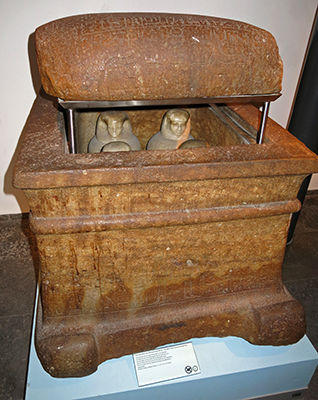
Eighteenth Dynasty: 1 550 BC - 1 292 BC
Amenhotep-Huy
Canopic chest of Amenhotep-Huy. It is made of a single piece of quartzite, and is thus an extremely expensive object. It came to Leiden in 1829 as part of the large collection of Giovanni d'Anastasy.
Amenhotep-Hoey was chief steward of Memphis, at the time of pharaoh Armenhotep III.
The box has the shape of a chapel. The canopenkist stands on a sledge foot frame, a shape inspired by the usual mode of transport during the funeral procession. On the sides are the four sons of Horus and the goddesses Isis, Nephthys, Neith and Selkis.
The four vases (originally at least) contained the embalmed corpse entrails, but in any case they are not the original vases, which were probably broken and destroyed by grave robbers.
Under King Amenhotep III (1 388 - 1 350 BC) he was, after the vizier or viceroy, the most important official in the capital of Memphis. His main task was that of manager of the royal estates. He was also active as a builder. In that capacity Amenhotep-Hoey supervised the construction of a new temple to the Memphite city god Ptah and the placement therein of a large image of his royal master. Additionally Amenhotep-Hoey was involved in the administration of the treasure house and granary.
Material quartzite and alabaster, location Saqqara, circa 1 370 BC.
Photo: Don Hitchcock 2014
Source: Original, Rijksmuseum van Oudheden, National Museum of Antiquities, Leiden.
Additional text: http://www.rmo.nl/onderwijs/museumkennis/verhalen/canopenkist-van-amenhotep-en-canopen-van-ipy

Eighteenth Dynasty: 1 550 BC - 1 292 BC
Yoke Pendant
Yoke pendant of a chariot, beads with magic symbols of health.
Circa 1340 BC - 1334 BC
This thick and heavy bead necklace is divided into 11 beads with Udjat eye painting and 24 beads each depicting an iris with pupil (a so-called fish eye). Another bead appears singularly and represents an Ankh sign ('life' and 'power') between two 'Was' sceptres on one side and a Djed pillar ('stability' and 'power') surrounded by two 'Was' sceptres on the other side. The necklace was found in the stable of house N 51.3 and described by Ludwig Borchardt as possible 'horse jewellery'
According to Ulrich Hofmann , it is a yoke pendant which is referred to in the cuneiform correspondence with Prince Tuschratta as 'maninnu sa sisi' ('chain for horses'). The symbolic function of the eye, which was supposed to protect the wearer, in this case the horse, and give it health, played a major role in this object . The modern reconstruction with the so-called Udjat eyes lined up next to one anther can be considered certain. In a figurative sense, this is the eye of Horus, which was violently removed from him by his adversary Seth. In the myth, the moon god Thoth heals the eye, which is why it is called 'udja' - 'healthy/whole'. Since then, it has been worn as a protective or healing amulet.
The iris with pupil, on the other hand, is a rarer motif. To protect their contents, glass vessels, for example, were given such an eye pattern, but this is probably simply a result of the simple manufacturing process. Round circles were less complex to make in glass than the many curves of the Eye of Horus. Fragments of such vessels are represented in the Egyptian Museum in Berlin with the numbers ÄM 22091, 25558, 36762 and 36772.
The bead with the depictions of the ankh, the was sceptre and the djed pillar, on the other hand, was supposed to give the wearer vitality, power and lasting strength, which a horse used in war was indispensable. Thus, the yoke pendant was not only an attractive piece of jewellery that was attached to the side of the horse's harness, but was also a protective amulet that was intended to strengthen the wearer and thus also his master and give him power.
Length 950 mm, diameter 25 mm, beads 31 mm.
Catalog: Faience, Amarna, House N 51.3, stable, ÄM 21944
Photo: Don Hitchcock 2018
Source: Original, Staatliche Museen zu Berlin, Neues Museum, Germany
Text: © Card at the Staatliche Museen zu Berlin (CC BY-NC-SA 3.0 DE), www.smb-digital.de/
Eighteenth Dynasty: 1 550 BC - 1 292 BC
Cosmetic Spoon
Ivory cosmetic spoon in the form of a duck, which turns her head to offer a fish to the two ducklings which ride on her back. The duck's eyes were carved to hold inlays, now lost. Such fine 'cosmetic spoons', are typically found in tombs.
The closed wings form the lid of the spoon and swivel to either side so that the bowl hollowed from the bird's body might be used to receive a scented fat or oil. In order to stabilise the lid when closed, a knob is set at its end, around which a cord could be tied to join it with a corresponding knob at the very back of the duck's body. One of the ducks has a missing head.
Circa 1 350 BC - 1 300 BC.
Length 175 mm, width 64 mm, depth 58 mm, weight 174 grams.
Curator's comments: The motif of the duck in connection with cosmetic items is particularly characteristic of the later 18th Dynasty.
Catalog: Ivory, EA5946
Photo: Don Hitchcock 2018
Source: Original, British Museum
Text: © http://www.britishmuseum.org/research/ and card at the Museum, © Trustees of the British Museum, CC BY-NC-SA 4.0
Eighteenth Dynasty: 1 550 BC - 1 292 BC
Ebony Face
Face from an anthropoid coffin.
18th Dynasty, circa 1400 BC - 1300 BC. Provenance unknown. Length 228 mm.
The face is carved from East African ebony ( Dalbergia melanoxylon ), one of the most highly prized products of the lands to the south of Egypt. The use of such an expensive wood for this coffin-face suggests that the owner was a person of high status. The eyes and brows were originally inlaid.
Catalog: EA6885
Photo: Don Hitchcock 2015, 2018
Source: Original, British Museum
Text: © http://www.britishmuseum.org/research/ and card at the Museum, © Trustees of the British Museum, CC BY-NC-SA 4.0

Eighteenth Dynasty: 1 550 BC - 1 292 BC
Coffin
Painted wooden coffin of an unnamed man.
Circa 1 350 BC - 1 280 BC
Spaces have been left in the inscriptions for the owner's name. This was never inserted, but the masculine grammatical forms in the texts, and the depiction of the hands as clenched fists, are indications that the intended occupant was a man.
The figures of deities painted in the spaces between the text bands include Anubis (in both jackal and anthropomorphic forms) and the Sons of Horus.
Catalog: Painted wood, plaster, Thebes, EA29580
Photo: Don Hitchcock 2015
Source: Original, British Museum
Text: © http://www.britishmuseum.org/research/ and card at the Museum, © Trustees of the British Museum, CC BY-NC-SA 4.0
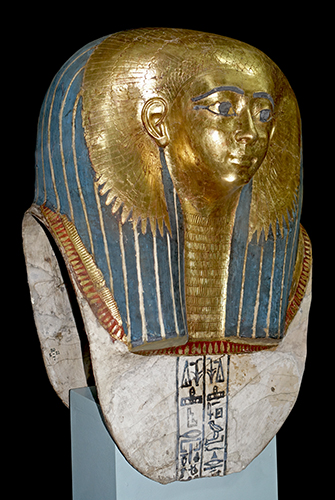
Eighteenth Dynasty: 1 550 BC - 1 292 BC
Gilded plaster mummy-mask
Circa 1 600 BC - 1 500 BC
Cartonnage mummy-mask of Satdjehuty. On this splendid female mask, gold leaf not only covers the woman's face, but also her huge collar necklace and the vulture-headdress that embrace the front and sides of her voluminous, lapis lazuli-coloured wig. The wings are examples of protective symbolism that, like the feather patterns on many anthropoid coffins of the Seventeenth and early Eighteenth Dynasties, evokes the guardianship of Isis and other deities. This woman's name, once written at the bottom of each column of hieroglyphs, has been lost, but is believed to be Satdjehuty. There are two columns of hieroglyphic text on the chest.
The winged headdress of this mask may be related to the Rishi decoration of coffins of the early New Kingdom. The name of the dead lady is missing from the offering formula inscribed on the front, but inscriptions on the linen from the same burial indicate that her name was Satdgehuty.
The striped wig, predominantly blue in colour, together with the white ground of the front and rear flaps associate the mask stylistically with the 'white' type of anthropoid coffin which was in use at Thebes approximately from the reign of Thutmose I to that of Thutmose III.
Height 455 mm ( face? ), height 610 mm ( total? ), width 325 mm, depth 190 mm.
Curator's comments:
The frontal inscription may have given the name of the owner, but, if so, this is now lost. The mask was acquired together with several large pieces of fine linen inscribed in ink with the name Satdjehuty, who is described as 'one who is praised' by Queen Ahmose-Nefertary (wife of King Ahmose I).
Samuel Birch, who inspected the items before purchase in 1880, suggested that the mask and the textiles had belonged to the same person (Minutes of the BM Trustees Standing Committee, 8 May 1880), which appears probable as the stylistic features of the mask are consistent with the date suggested by the linen-texts. The fine quality of the mask would also be appropriate to an individual who was in favour at the royal court.
Catalog: Gilded cartonnage, linen, plaster, gold, Rifeh, EA29770
Photo: Don Hitchcock 2015
Source: Original, British Museum
Text: © http://www.britishmuseum.org/research/ and card at the Museum, © Trustees of the British Museum, CC BY-NC-SA 4.0
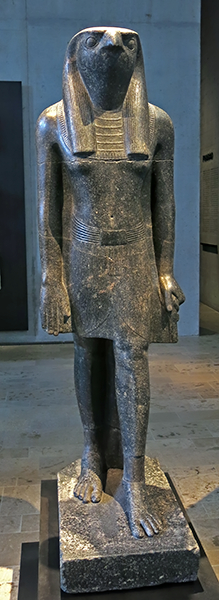

Eighteenth Dynasty: 1 550 BC - 1 292 BC
Horus
Standing-striding statue of the god Horus.
New Kingdom, circa 1 360 BC
Catalog: Granodiorite, Theben-West, Mortuary Temple of Amenhotep III / Amenophis III (?), Gl.WAF 22a
Photo: Don Hitchcock 2015, 2018
Source: Original, Ägyptischen Museum München
Text: © Ägyptischen Museum München
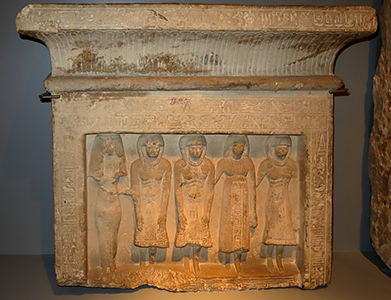
Eighteenth Dynasty: 1 550 BC - 1 292 BC
Meryptah
Tomb stela of Meryptah, Late 18th dynasty, circa 1 360 BC, from Memphis.
This is only the upper half of the stele, the rest is located in London, see below. Meryptah is pictured second from left. Like his brother Ptahmes beside him he carries the zijlok, the side lock of hair, and chest insignia of the high priests of Ptah. The brothers may be flanked by their proud parents. Djehoetymes' father wears the high-necked robe neckband of a vizier or viceroy. On the far right is another priest of Ptah.
Meryptah was the Chief Steward of the mansion (Temple) of Amenhotep III and brother of the High-priest of Ptah in Memphis Ptahmose, Martin (1991). A stela mentioning Meryptah and relatives is spread over two museums. The top part is on display in Leiden, as shown here, while the bottom part is in the Petrie museum. Depicted are the parents Thutmose (Vizier) and his wife Tawy, with the two brothers Meryptah amd Ptahmose between them. To the right is an additional priest.
Photo: Don Hitchcock 2014
Source and text: Original, Rijksmuseum van Oudheden, National Museum of Antiquities, Leiden.
Additional text: http://mathstat.slu.edu/~bart/egyptianhtml/tombs/Saqqara-Tombs-NK.html

Eighteenth Dynasty: 1 550 BC - 1 292 BC
Meryptah
Tomb stela of Meryptah, Late 18th dynasty, circa 1360 BC, from Memphis.
This is the lower half of the limestone stela of Meryptah, Chief Steward of the mansion (Temple) of Amenhotep III and High Priest of Memphis, Ptahmose, located in London at the Petrie Museum.
Rectangular frame and cavetto cornice.
Photo and text: Original, http://mathstat.slu.edu/~bart/egyptianhtml/tombs/Saqqara-Tombs-NK.html
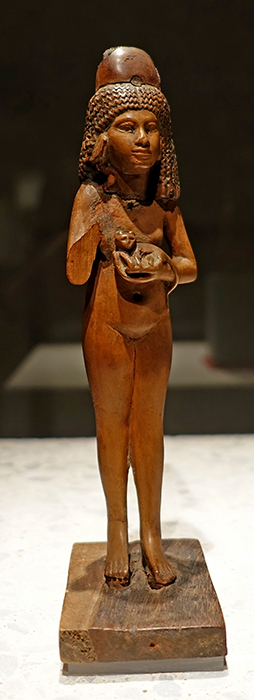
Eighteenth Dynasty: 1 550 BC - 1 292 BC
Figurine
Figurine of a girl holding a kitten, circa 1 380 BC
Mirror handle.
Catalog: Wood, Abusir el Meleq, ÄM 16400
Photo: Don Hitchcock 2018
Source: Original, Staatliche Museen zu Berlin, Neues Museum, Germany
Text: © Card at the Staatliche Museen zu Berlin, (CC BY-NC-SA 3.0 DE)
Additional text: http://www.griffith.ox.ac.uk/gri/3berlin.pdf
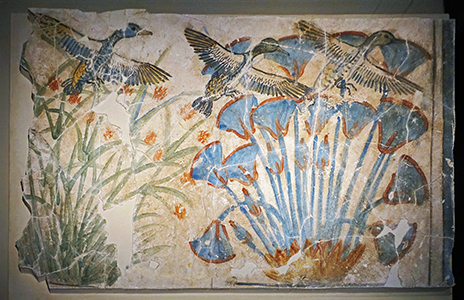
Eighteenth Dynasty: 1 550 BC - 1 292 BC
Palace Floor
Fragment of a Palace Floor.
Circa 1 350 BC.
Catalog: Painted plaster, Amarna, South Palace, ÄM 15335
Photo: Don Hitchcock 2018
Source: Original, Staatliche Museen zu Berlin, Neues Museum, Germany
Text: © Card at the Staatliche Museen zu Berlin, (CC BY-NC-SA 3.0 DE)
The Greek historian Herodotus called Egypt a gift of the Nile. Only the elongated river oasis in the middle of the desert could provide the foundations of life for the advanced Egyptian civilisation that developed here from around 3000 BC.
The unity of the landscape of the narrow river valley also promoted the political union of the kingdoms of Upper and Lower Egypt.
The incomparable stability of the Egyptian culture is remarkable. The artistic forms and religious ideas of the Egyptians were only subject to temporary changes during the reign of Akhenaten (1351 - 1334 BC), and they were still able to retain their own character in the Graeco-Roman period. Apart from brief interruptions by foreign rulers, the Egyptian pharaohs maintained their power unchallenged for three millennia.
Text above: Poster, Badisches Landesmuseum Karlsruhe Germany
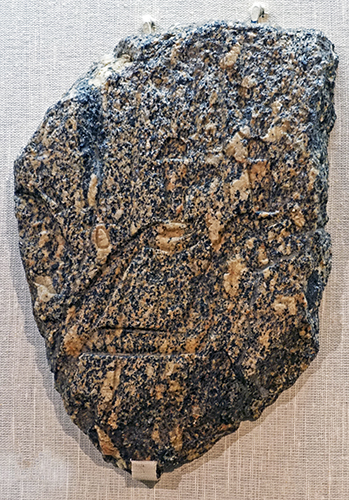
Eighteenth Dynasty: 1 550 BC - 1 292 BC
A Princess
Reliefs of the Amarna Period, reign of Akhenaten 1 353 BC - 1 336 BC - A princess offers two ointment vessels.
Circa 1 350 BC.
Catalog: Granodiorite, probably from Amarna, Inv. no. 1981.40
Photo: Don Hitchcock 2018
Source and text: Original, Museum August Kestner, Hannover
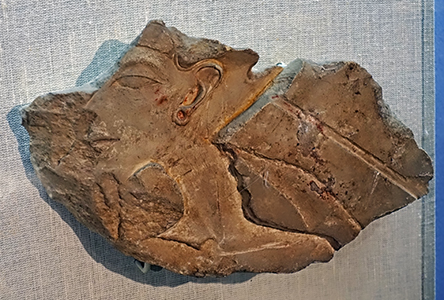
Eighteenth Dynasty: 1 550 BC - 1 292 BC
Head of Akhenaten
Reliefs of the Amarna Period, reign of Akhenaten 1 353 BC - 1 336 BC - Head of Akhenaten.
Catalog: Limestone, probably from Amarna, Inv. no. 1966.113
Photo: Don Hitchcock 2018
Source and text: Original, Museum August Kestner, Hannover

Eighteenth Dynasty: 1 550 BC - 1 292 BC
Royal Letter from Ashur-uballit, the king of Assyria, to the king of Egypt, Akhenaten
Circa 1 365 - 1330 BC)
This document was found in the late 1880s at the site of Amarna, the religious capital of Egypt under Akhenaten. It was likely originally stored in administrative offices that formed part of a palace complex in the central part of the city. It is written in cuneiform script on a clay tablet using a reed stylus. The language is an Assyrian dialect of Akkadian, the lingua franca of the time. In this letter the king of Assyria, Ashur-uballit, sends a personal messenger and offers gifts to the king of Egypt, most probably Akhenaten, in order to open communications with the major superpower of the region.
In the fourteenth century BC the state of Assyria emerged as a dominant power in the northern part of Mesopotamia, in modern Iraq. This letter, written on a clay tablet in the Assyrian language using the cuneiform script, was sent by Ashur-uballit (circa 1 365 - 1330 BC) to the king of Egypt in a gesture of friendship. He writes:
'Say to the king of the land of Egypt: Thus Ashur-uballit, the king of the land of (the god) Ashur. For you, your household, for your land, may all be well. I have sent my messenger to you to visit you and to visit your land. Up to now, my predecessors have not written; today, I have written to you. I send you a splendid chariot, 2 horses, and 1 date-stone of genuine lapis lazuli as your greeting gift. Do not delay the messenger whom I have sent to you for a visit. He should visit and then leave for here. He should see what you are like and what your land is like, and then leave for here.'
(adapted from Cuneiform Texts in the Metropolitan Museum of Art Vol. I, No. 102)
The newly powerful king of Assyria could not lay claim to the same historical prestige as the king of Egypt, so although it was common practice in letter writing to define the relationship between addressee and sender, Ashur-uballit avoids such terms. Instead, he offers typical expressions of good wishes and notes that his message arrives with gifts, an incentive for the development of friendly relations. Such 'greeting gifts' are known from the archaeological record of the ancient Near East and Egypt and include portable luxury objects and imported raw materials discovered in royal palaces.
Unlike modern heads of state, kings of the ancient world rarely met face-to-face. This letter shows that Ashur-uballit expected a report from his messenger on the exotic land of the king he would never meet, a kind of encounter by proxy. By forging ties through travelling objects and messengers, the kings of the ancient Near East and eastern Mediterranean could begin to imagine themselves as part of a family – a 'brotherhood' of rulers.
Ashur-uballit’s letter is one of several hundred discovered in the late 1800s at the Egyptian capital of Amarna. Known today as the Amarna Letters, the missives were written within a forty year period by rulers from across the ancient Near East. They provide insight into international relations during the latter half of the second millennium B.C., a time during which rulers of states and cities interacted in both peaceful trade and war.
Elizabeth Knott, Research Associate, Ancient Near Eastern Art, 2016
Dimensions: Height 77 mm, Width 55 mm.
Catalog: Clay, 24.2.11
Photo, source and text: Original, Met Museum, New York
Permission: Public Domain
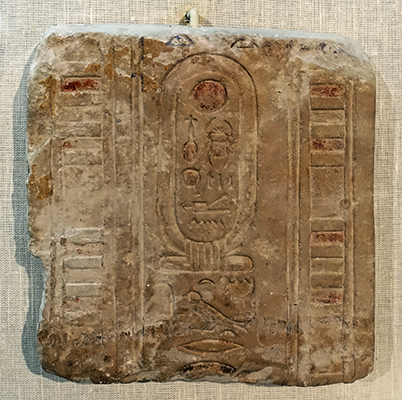
Eighteenth Dynasty: 1 550 BC - 1 292 BC
Relief with the Throne Name of Akhenaten
Relief from the Amarna Period, showing Akhenaten's throne name, reign of Akhenaten 1 353 BC - 1 336 BC.
The Throne name was the most important name of the Pharaohs.
Catalog: Limestone, probably from Amarna, Inv. no. 1935.200.362
Photo: Don Hitchcock 2018
Source and text: Original, Museum August Kestner, Hannover

Eighteenth Dynasty: 1 550 BC - 1 292 BC
Princesses
Relief from the Amarna Period, showing two daughters of Akhenaten, reign of Akhenaten 1 353 BC - 1 336 BC.
Catalog: Limestone, probably from Amarna, Inv. no. 1963.35
Photo: Don Hitchcock 2018
Source and text: Original, Museum August Kestner, Hannover

Eighteenth Dynasty: 1 550 BC - 1 292 BC
Part of a staircase balustrade
Relief from the Amarna Period, reign of Akhenaten 1 353 BC - 1 336 BC.
Catalog: Limestone, probably from Amarna, Inv. no. 1935.200.195
Photo: Don Hitchcock 2018
Source and text: Original, Museum August Kestner, Hannover
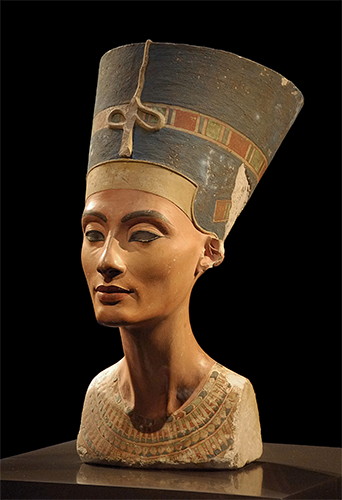
Eighteenth Dynasty: 1 550 BC - 1 292 BC
Nefertiti
Bust of Queen Nefertiti
Nefertiti was an Egyptian queen and the Great Royal Wife (chief consort) of Akhenaten, an Egyptian Pharaoh. Nefertiti and her husband were known for a religious revolution, in which they worshiped one god only, Aten, or the sun disc. Together Akhenaten and Nefertiti were responsible for the creation of a whole new monotheistic religion which changed the ways of religion within Egypt.
With her husband, she reigned at what was arguably the wealthiest period of Ancient Egyptian history. Some scholars believe that Nefertiti ruled briefly as Neferneferuaten after her husband's death and before the accession of Tutankhamun, although this identification is a matter of ongoing debate.
She was made famous by her bust, now in Berlin's Staatliche Museen zu Berlin, Neues Museum. The bust is one of the most copied works of ancient Egypt. It was attributed to the sculptor Thutmose, and it was found in his workshop. The bust is notable for exemplifying the understanding Ancient Egyptians had regarding realistic facial proportions.
Circa 1 345 BC, dimensions 490 x 245 x 350 mm.
Catalog: Painted limestone, stucco, wax, rock crystal, ÄM 21300
Photo: Philip Pikart
Permission: GNU Free Documentation License
Source: Original, Staatliche Museen zu Berlin, Neues Museum, Germany
Text: © http://www.smb-digital.de/ (CC BY-NC-SA 3.0 DE)
Additional text: Wikipedia
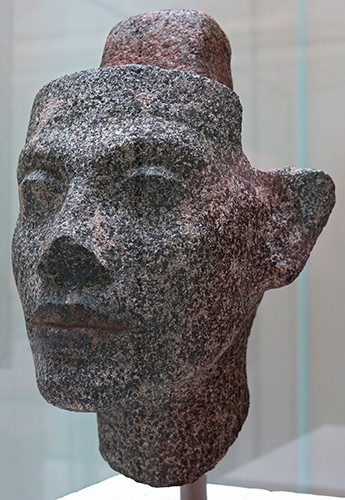

Eighteenth Dynasty: 1 550 BC - 1 292 BC
Head of a statue of Queen Nefertiti
18th Dynasty circa 1345 BC
Dimensions: 240 x 160 x 163 mm.
Granodiorite, grey, painted.
This head is also identified with a royal lady due to the slightly accentuated frontal ligament and the pin serving as crown attachment. But this head did not function as part of a composite statue, but rather the broken lower side of the neck, as well as the rest of a backpost, reveal that this piece originally belonged to a large, life-sized statue carved from a block.
On the long cone on the head was presumably a head-covering, which extended far backward, and the recesses at the level of the temples also indicate a blue hood, which was typical of Nefertiti, was placed on the head. Dorothea Arnold therefore defines this type as a 'partial composite statue'.
Lips and the part of the statue above the head are painted red, slight traces of black painting are still preserved in the eye and brows, which served as a preparation for further elaboration. The nasal tip is broken, and the ears also do not seem to be finished. Compared to Nefertiti's other pictures, the eyes are narrower and the mouth wider, the cheeks are set below the temples. These traits indicate a late work of the Amarna period.
Catalog: Amarna, ÄM 21358
Photo: Don Hitchcock 2015
Source: Original, Staatliche Museen zu Berlin, Neues Museum, Germany
Text: © http://www.smb-digital.de/ (CC BY-NC-SA 3.0 DE)
Additional text: Wikipedia

Eighteenth Dynasty: 1 550 BC - 1 292 BC
Unfinished head of a statue of Queen Nefertiti.
Limestone, painted, 300 x 180 x 210 mm.
This unfinished statuary head with corrections by the sculptor is described as a portrait of Nefertiti due to numerous design criteria, but especially because of the typical crown approach. Since Borchardt's interpretation of the colored bust as a sculpture model, both heads have been related to each other and the completed work has been regarded as the model for this.
Even if the first sight of the unfinished queen is at first astonishing for many viewers, and is almost repulsive and confusing to many a visitor, the approach and mode of operation of the ancient Egyptian artisans unfolds in an exemplary fashion in this piece.
The already very advanced blank had already in the face and the neck a very good smoothing of the surface, while the coarser chisel marks on the ears and on the crown neck were still left raw. The eyes and the eyebrow bead had already been set so precisely that they were enclosed and painted with accurate lines as a safe reference point for further work. The nose and mouth as well as the tendons on the neck seem to be quite close to being complete, but obviously some corrections have to be made. In order to mark the places to be remodelled, the sculptor drew the questionable parts in the face with skilful, sweeping brush strokes.
These included the missing, slight furrow in the middle of the forehead; The folds of the eyes at the inner corner of the eye; The elaboration of the left ventricle, a straightening of the nasal bridge, the missing nasolabial folds, a correction of the lips that are too full, as well as a more delicate modelling of the slightly recessed cheeks - especially on the left side of the face - and the missing neck folds.
On the chin and around the mouth as well as on the upper lip one can already recognise the next processing step by means of fine, small chisel marks. How many such corrections this statuary head had already passed through can not be estimated, but the unfinished head shows in comparison to the completed bust and to the gypsum model head of the queen (ÄM 21349, below) that reliable model templates in the workshop were indispensable to the set goal of a perfect, though idealised, image of the queen.
Catalog: Circa 1340 BC, Amarna, Painted Limestone, ÄM 21352
Photo: Don Hitchcock 2015
Source: Original, Staatliche Museen zu Berlin, Neues Museum, Germany
Text: © Card at the Staatliche Museen zu Berlin, K. Finneiser at http://www.smb-digital.de/ (CC BY-NC-SA 3.0 DE)
Additional text: Seyfried (2012)

Eighteenth Dynasty: 1 550 BC - 1 292 BC
Head of Akhenaten
Circa 1340 BC.
Photo: Don Hitchcock 2018
Catalog: Amarna, plaster, gift of James Simon 1920, ÄM 21348
Source: Original, Staatliche Museen zu Berlin, Neues Museum, Germany
Text: © Card at the Staatliche Museen zu Berlin, http://www.smb-digital.de/, (CC BY-NC-SA 3.0 DE)
Eighteenth Dynasty: 1 550 BC - 1 292 BC
Wall Decor
Circa 1340 BC.
Grape and lotus garland as wall decor.
Catalog: Limestone, el-Armana/Hermupolis, Inv. No. 1972.18
Photo: Don Hitchcock 2018
Source and text: Original, Museum August Kestner, Hannover
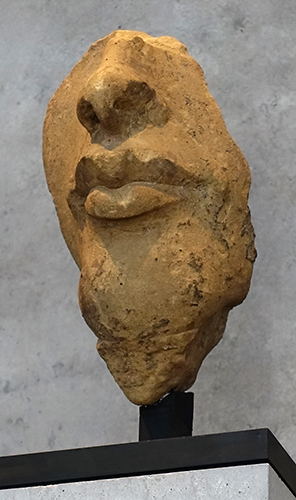
Eighteenth Dynasty: 1 550 BC - 1 292 BC
Akhenaten
Fragment from the face of a colossal statue of Pharaoh Akhenaten, circa 1 350 BC.
Catalog: Sandstone, Karnak, Aton-Tempel, ÄS 6290
Photo: Don Hitchcock 2018
Source: Original, Ägyptischen Museum München
Text: © Ägyptischen Museum München
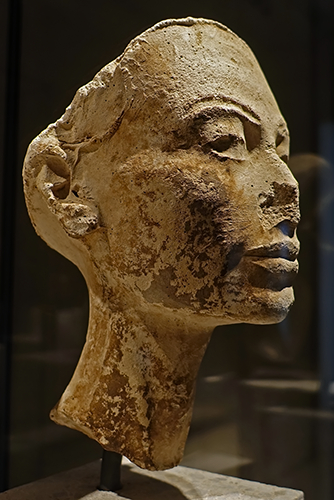
Eighteenth Dynasty: 1 550 BC - 1 292 BC
Head of Nefertiti
Circa 1340 BC.
Photo: Don Hitchcock 2018
Catalog: Amarna, plaster, gift of James Simon 1920, ÄM 21349
Source: Original, Staatliche Museen zu Berlin, Neues Museum, Germany
Text: © Card at the Staatliche Museen zu Berlin, http://www.smb-digital.de/, (CC BY-NC-SA 3.0 DE)

Eighteenth Dynasty: 1 550 BC - 1 292 BC
Statuette of a woman
Only a few remains of the paint are left. It is uncertain whether the figure originally stood in a temple as a votive offering or whether it is from a tomb.
Circa 1300 BC.
Catalog: Painted wood
Photo: Don Hitchcock 2015
Source and text: Badisches Landesmuseum Karlsruhe Germany
Eighteenth Dynasty: 1 550 BC - 1 292 BC
Head of Nefertiti (?)
Circa 1345 BC - 1 340 BC
Plaster model of the head of a king or a queen, 240 mm x 112 mm.
From the time of Amenhotep IV / Akhenaten.
This under life-sized head belongs to the round plastic studies of the royal portrait heads. The identity of the person depicted is unknown, but it must be a king or a queen, because the cast has unmistakable royal features: a crown band and the start of a crown over the temples. While Roeder classifies the head as a representation of Nefertiti, the thesis that this is a prince can not be confirmed.
Neither princes nor princesses wore this type of crown in ancient Egypt. Head and neck were both found separately in room 19 of house P 47.2. The face is more weathered on the right half and may have been exposed to the air for a long time on this side. In this example, deepened eyebrows and eye sockets are visible. These recesses come from the original and were originally intended to hold inserts made of other materials. The assumption is obvious that these examples are direct impressions of statues. Likewise, it is likely that many plaster portraits served as models or as exercise pieces in the sculpture workshops.
Catalog: Stucco, P 47.02 ( Amarna / P 47 / P 47.01-03) Room 19, ÄM 21353
Photo: Don Hitchcock 2015, 2018
Source: Original, Staatliche Museen zu Berlin, Neues Museum, Germany
Text: © Card at the Staatliche Museen zu Berlin, http://www.smb-digital.de/, (CC BY-NC-SA 3.0 DE)
Additional text: © Jung, M., in: F. Seyfried (ed.), In the Light of Amarna. 100 years find of Nefertiti, Berlin 2012, p. 326 (Cat. # 113)
Mettlen (2012)
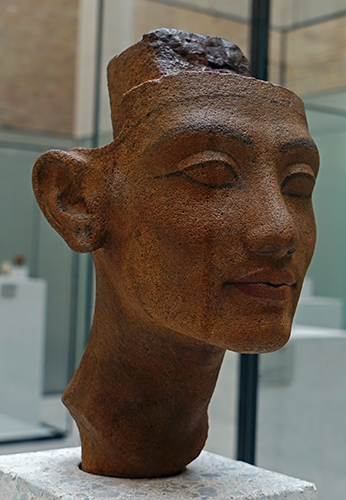

Eighteenth Dynasty: 1 550 BC - 1 292 BC
Head of a statue of Queen Nefertiti or Queen Merit-Aten.
Circa 1340 - 1335 BC.
Painted quartzite, 290 x 149 x 165 mm.
The top projection of this head served for the attachment of a royal head covering, which is attributed to a queen. Frequently this piece is identified with Nefertiti, who appears here with the soft features of her young years. As a part of a composite statue, the head is included in the series of three further images of Nefertiti (ÄM 21300, ÄM 21358, ÄM 21263), which were found in the workshop of Thutmose.
Dorothea Arnold assigns the production of these heads to different sculptors, but asserts that this head was still in its processing phase. In further steps, polishing and presumably painting of the head were to be completed, as indicated by the perfectly curved lips, which had a touch of red. The slightly sharp cheek muscles, the dimples around the corners of the mouth, and the wider nose give the somewhat rounded head very natural, but idealising features. The youthful freshness of the piece makes some researchers assign this image oto Merit-Aton, daughter of Akhenaten and Nefertiti.
This 'splendid piece', described by Borchardt, was found in Room 19, just before the passage, which led to the 'large courtyard' of P 47.2 / 3 and was later walled. Many of the plaster models found appeared in the immediate vicinity.
Catalog: Amarna, Painted Quartzite, ÄM 21220
Photo: Don Hitchcock 2015, 2018
Source: Original, Staatliche Museen zu Berlin, Neues Museum, Germany
Text: © Card at the Staatliche Museen zu Berlin, K. Finneiser at http://www.smb-digital.de/ (CC BY-NC-SA 3.0 DE)
Additional text: Mettlen (2012)
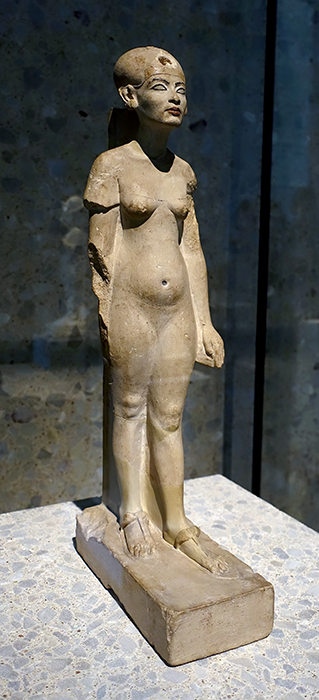
Eighteenth Dynasty: 1 550 BC - 1 292 BC
Nefertiti
Standing-striding figure of Nefertiti.
Dimensions 405 x 80 x 170 mm, circa 1 355 BC
This statue of the Nefertiti, broken into several fragments, was found in the same room in which the brightly painted bust of the queen came to light. According to the records of Borchardt, the base was first recovered with its feet, which then later led the other fragments. All fragments were in close proximity to the site of the great Akhenaten bust (ÄM 21360).
A deliberate destruction of the sculpture, as in the case of the royal bust, can not be proved, since the delicately modelled face is not damaged. On the other hand, the damaged nipples give the impression of a conscious intervention. Except for the missing right forearm and the damaged areas in the left shoulder area, the statuette was completely reassembled with some additions to the calves.
The figure impresses in every detail by its incredible naturalness. According to the later Amarna style, Nefertiti is reproduced as a mature woman with clear wrinkles around the eyes and prominent incisions around the corners of the mouth. Only the eye and mouth received a colour accent. As a headdress, Nefertiti carries the typical, wide-waisted dome, which is typical of her - besides the helmet crown - into which a separately worked Uraeus snake was fixed as a royal protection symbol, as can be seen by the hole over the forehead and hood band.
The Queen also has two disc-shaped earrings. The shoulders and upper body are slightly flexed and the upper body with the slightly hanging breasts, due to the slightly forward-headed head, which is further underlined by the round, wide-reaching pelvic and abdomen and the full thighs. Also typical of the sculptures during the Amarna period are the extremely flexed knees, the wearing of sandals - even in royal personalities - and the slightly outward-facing foot position.
Had the garment not been shown at the right shoulder, as well as the fine black line of the neck-collar over the breasts, one could guess the body to be naked. This misleading impression is further emphasised by the accentuated abdomen and the abdominal folds over the pubis. It is, however, one of the perpetual, ancient Egyptian representational conventions to emphasise the femininity of a person in her perfect physicality as opposed to clothing, which in this example has succeeded to the utmost in this image of the older queen and mother.
Catalog: Painted limestone, Amarna, ÄM 21263
Photo: Don Hitchcock 2018
Source: Original, Staatliche Museen zu Berlin, Neues Museum, Germany
Text: © Card at the Staatliche Museen zu Berlin, F. Seyfried at http://www.smb-digital.de/ (CC BY-NC-SA 3.0 DE)

Eighteenth Dynasty: 1 550 BC - 1 292 BC
Akhenaten, Nefertiti, and their three daughters
Dimensions 335 x 395 x 35 mm, circa 1 355 BC
This plaque in bas-relief is the altar of a shrine. It shows the royal couple in an intimate scene with their children, and above them is represented the god Aton as a sun-disc with a multitude of radiation arms directed towards the earth and ' signs of life '. The depiction shows an intimate, tender family scene of the ruling couple together with their princess children.
( note the distortion of the face that was fashionable during the reign of Akhenaten, particularly in bas-relief sculptures, with an elongated chin the most obvious effect on adults, possibly because of Akhenaten's long chin. This and other differences in portrayal are known as the Amarna style, which was extant during and just after the reign of Akhenaten. Akhenaten moved the royal capital to the city now known as Amarna and erected a number of palaces and temples there.
Both Akhenaten and Nefertiti had elongated heads, as did their female children, and their son Tutankhamun. See also the sculpture of a princess below, thought to be of one of his children. The elongation is due to heredity, and is known as dolichocephaly. Nefertiti is thought to be a half-sister to Akhenaten, and they shared the elongated head, as did Akhenaten's father and grandfather, Thutmose III and Thutmose II. Further information can be obtained at the website
http://www.soul-guidance.com/houseofthesun/elongatedskulls/elongatedskullsafrica.html
- Don )
It is widely believed that King Akhenaten had an illness called Marfan's Syndrome. Today, Marfan's Syndrome affects about one in 5 000 people and is a genetic disorder that involves the body's connective tissue. Depictions of the king and his family reveal that they displayed some of the symptoms of Marfan's Syndrome. Symptoms include an elongated head, neck, arms, hands and feet, a pot belly and heavy thighs, poor muscle tone and a short torso. The illness tends to make people very tall and many die at an early age because of weakened aortas that are prone to rupture.
King Akhenaten is the first Pharaoh to have insisted that sculptures, paintings and other depictions of him and his family be real depictions instead of the strong, muscular-looking depictions of pharaohs in the past. The innovative depictions gave the artists of the time freedom to portray the royal family in real-life events, (as above) something that had never happened before.
Text above: https://www.ancient-egypt-online.com/akhenaten.html
Catalog: Limestone, Amarna, ÄM 14145
Photo: Don Hitchcock 2015
Source: Original, Staatliche Museen zu Berlin, Neues Museum, Germany
Text: © Card at the Staatliche Museen zu Berlin, http://www.smb-digital.de/ (CC BY-NC-SA 3.0 DE)
Additional text: https://www.psychologytoday.com/au/blog/how-we-do-it/201907/strange-head-shapes-revisiting-nefertiti-akhenaten-and-tut, Wikipedia
This is an excellent summary of the life and times of Akhenaten, by Marsha Hill of the Department of Egyptian Art, The Metropolitan Museum of Art (The Met):
https://www.metmuseum.org/toah/hd/amar/hd_amar.htm
Nefertiti disappears from the historical record around the 12th year of Akhenaten's 17-year reign. She may have died at that point, but it is possible she became her husband's official co-regent under the name Neferneferuaten. Akhenaten was followed as pharaoh by Smenkhkare, who some historians suggest may have been another name for Nefertiti. This would not have been without precedent: In the 15th century B.C. the female pharaoh Hatshepsut ruled Egypt in the guise of a man, complete with a ceremonial false beard.Text above: https://www.history.com/topics/ancient-history/nefertiti
If Nefertiti kept power during and beyond Akhenaten's last years, it is possible she began the reversal of her husband's religious polices that would reach fruition during the reign of King Tut. At one point Neferneferuaten employed a scribe to make divine offerings to Amun, pleading for him to return and dispel the kingdom's darkness.
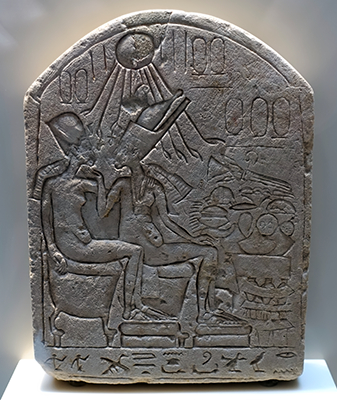
Eighteenth Dynasty: 1 550 BC - 1 292 BC
Nefertiti and Akhenaten
Stela: Royal couple at feast.
Circa 1 345 BC.
Catalog: Limestone, ÄM 17813
Photo: Don Hitchcock 2018
Source: Original, Staatliche Museen zu Berlin, Neues Museum, Germany
Text: © Card at the Staatliche Museen zu Berlin, (CC BY-NC-SA 3.0 DE)
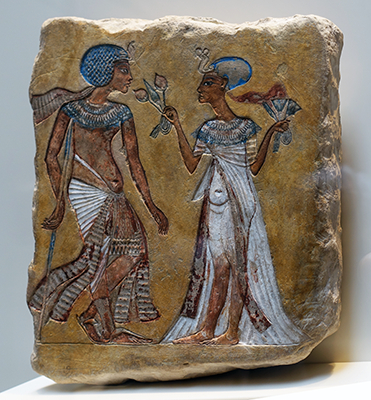
Eighteenth Dynasty: 1 550 BC - 1 292 BC
Nefertiti and Akhenaten
A stroll in the garden.
Circa 1 345 BC.
Catalog: Painted limestone, Amarna, ÄM 15000
Photo: Don Hitchcock 2018
Source: Original, Staatliche Museen zu Berlin, Neues Museum, Germany
Text: © Card at the Staatliche Museen zu Berlin, (CC BY-NC-SA 3.0 DE)
Eighteenth Dynasty: 1 550 BC - 1 292 BC
Akhenaten
Fragment of a relief: Akhenaten with olive branch.
Circa 1 353 - 1323 BC.
In this fragment only the beautifully carved left hand of Akhenaten remains, holding a heavily laden branch of olives that appears to be caressed by the hands of the sun's rays.
The entire scene would have shown the king standing directly beneath the sun disc, facing what appears to be the olive tree from which he may have cut the branch. The upper boughs of the tree are to the right along the lower edge of the block. The text in the upper right has been intentionally destroyed, leaving only a few traces of the hieroglyphs.
This relief is currently on long-term loan to the Ägyptisches Museum und Papyrussammlung in Berlin in exchange for two heads in plaster that were excavated at Amarna.
Dimensions: Height 22 cm.
Catalog: Painted sandstone, Armana, 1981.449
Photo: Don Hitchcock 2018
Source: Original, Staatliche Museen zu Berlin, Neues Museum, Germany, on loan from the New York Metropolitan Museum of Art
Text: © Card at the Staatliche Museen zu Berlin, (CC BY-NC-SA 3.0 DE)
Additional text: https://www.metmuseum.org/art/collection/search/544057
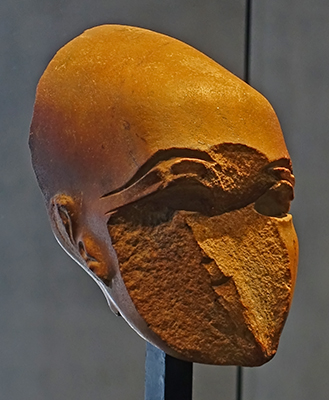
Eighteenth Dynasty: 1 550 BC - 1 292 BC
Akhenaten's daughter
Head from a statue of a daughter of Akhenaten.
Circa 1 345 BC.
Catalog: Quartzite, Amarna, Ä5 1628
Photo: Don Hitchcock 2018
Source: Original, Ägyptischen Museum München
Text: © Ägyptischen Museum München
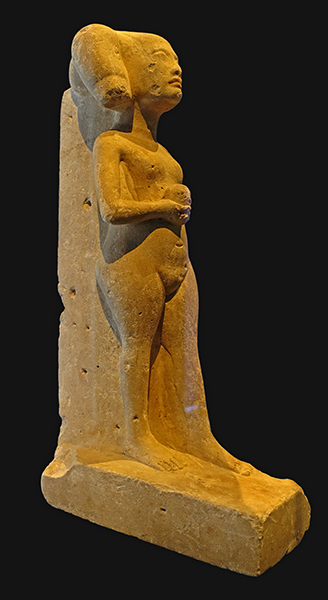
Eighteenth Dynasty: 1 550 BC - 1 292 BC
Akhenaten's daughter
Standing-striding figure of a daughter of Pharaoh Akhenaten.
Circa 1 345 BC.
Catalog: Limestone, on loan from a private collection
Photo: Don Hitchcock 2018
Source: Original, Ägyptischen Museum München
Text: © Ägyptischen Museum München
Eighteenth Dynasty: 1 550 BC - 1 292 BC
Akhenaten
Temple relief: Akhenaten beneath the rays of the sun god Aten / Aton. Aten is not in its usual human form, but abstract, as the rays of the sun, circa 1350 BC.
Dimensions: 445 x 225 x 50 mm.
Catalog: Painted sandstone, Karnak, Aton-Tempel, ÄM 31283
Photo: Don Hitchcock 2018
Source: Original, Staatliche Museen zu Berlin, Neues Museum, Germany
Text: © Card at the Staatliche Museen zu Berlin, http://www.smb-digital.de/ (CC BY-NC-SA 3.0 DE)
Additional text: Meyer-Dietrich (2017)
Eighteenth Dynasty: 1 550 BC - 1 292 BC
Nefertiti
Temple relief: Nefertiti beneath the rays of the sun god Aten / Aton. Circa 1350 BC.
Catalog: Painted sandstone, Karnak, Aton-Tempel, ÄM 31284
Photo: Don Hitchcock 2018
Source: Original, Staatliche Museen zu Berlin, Neues Museum, Germany
Text: © Card at the Staatliche Museen zu Berlin, (CC BY-NC-SA 3.0 DE)
Eighteenth Dynasty: 1 550 BC - 1 292 BC
Akhenaten
Fragment of a relief: Akhenaten / Amenhotep IV at his jubilee.
Here Akhenaten is once again shown below the rays of the sun god Aten. He wears the distinctive white crown of upper Egypt, which may have been passed from one Pharaoh to the next, since there are no extant examples of the crown. Circa 1348 BC.
Catalog: Painted sandstone, Karnak, Aton-Tempel, ÄM 30509
Photo: Don Hitchcock 2018
Source: Original, Staatliche Museen zu Berlin, Neues Museum, Germany
Text: © Card at the Staatliche Museen zu Berlin, (CC BY-NC-SA 3.0 DE)
Eighteenth Dynasty: 1 550 BC - 1 292 BC
Akhenaten
Fragment of a Temple relief: Lower Face and Shoulders of Akhenaten.
Circa 1 353 - 1336 BC.
Provenance: From Middle Egypt, Hermopolis (Ashmunein; Khemenu), Pylon of Ramesses II, foundations level, Deutsche Hermopolis-Expedition 1938; Probably originally from Amarna (Akhetaten)
Dimensions: 210 mm x 345 mm
Catalog: Painted limestone, Amarna, 1985.328.3
Photo: Don Hitchcock 2018
Source: Original, Staatliche Museen zu Berlin, Neues Museum, Germany, on loan from the New York Metropolitan Museum of Art
Text: © Card at the Staatliche Museen zu Berlin, (CC BY-NC-SA 3.0 DE)
Additional text: https://www.metmuseum.org/art/collection/search/549203
Eighteenth Dynasty: 1 550 BC - 1 292 BC
Nefertiti and Akhenaten
Part of a stela: Nefertiti ties an an ornamental collar around Akhenaten.
Circa 1 345 BC.
Catalog: Painted limestone, Armana (?), ÄM 14511
Photo: Don Hitchcock 2018
Source: Original, Staatliche Museen zu Berlin, Neues Museum, Germany
Text: © Card at the Staatliche Museen zu Berlin, (CC BY-NC-SA 3.0 DE)
Eighteenth Dynasty: 1 550 BC - 1 292 BC
Nefertiti and Akhenaten
Temple relief: Nefertiti behind Akhenaten, worshipping Aten.
Circa 1 345 BC.
Catalog: Painted limestone, Armana, ÄM 19781
Photo: Don Hitchcock 2018
Source: Original, Staatliche Museen zu Berlin, Neues Museum, Germany
Text: © Card at the Staatliche Museen zu Berlin, (CC BY-NC-SA 3.0 DE)

Eighteenth Dynasty: 1 550 BC - 1 292 BC
Akhenaten
Akhenaten portrayed as a sphinx, circa 1 340 BC.
Catalog: Limestone, Inv. Nr. 1964.3
Photo: Don Hitchcock 2018
Source and text: Original, Museum August Kestner, Hannover
Eighteenth Dynasty: 1 550 BC - 1 292 BC
Akhenaten
Fragment of a temple relief: Akhenaten makes sacrifices to the god Aten.
Circa 1 345 BC.
Catalog: Painted limestone, Armana (?), ÄM 22265
Photo: Don Hitchcock 2018
Source: Original, Staatliche Museen zu Berlin, Neues Museum, Germany
Text: © Card at the Staatliche Museen zu Berlin, (CC BY-NC-SA 3.0 DE)

Eighteenth Dynasty: 1 550 BC - 1 292 BC
Stelaphon
Stelaphon (statue of a person presenting a stele) of Nehi.
Circa 1 350 BC.
Catalog: Limestone, gift of the Deutschen Museum, München
Photo: Don Hitchcock 2015
Source: Original, Ägyptischen Museum München
Text: Museum card, © Ägyptischen Museum München
Eighteenth Dynasty: 1 550 BC - 1 292 BC
Akhenaten
Bust of Akhenaten. Limestone (painted and gilded) with reversible modern additions.
This impressive bust was originally intended to be placed in a sanctuary for the adoration of the king. It was found earlier than the queen's bust, and was already cut into several pieces in antiquity.
The voids between these fragments have now been partially filled in order to stabilise the bust and to approximate the state in which it was found by Borchardt on 6th December 1912. The reconstruction of the lost mouth is temporary. It has only been added for the period of this special exhibition.
Dimensions 570 x 450 x 350 mm, circa 1 351 BC - 1 334 BC.
Catalog: Painted, gilded limestone, Amarna, P 47 / P 47.01-03 (estate), Room 19.01, ÄM 21360
Photo: Don Hitchcock 2015, 2018
Source: Original, Staatliche Museen zu Berlin, Neues Museum, Germany
Text: © Card at the Staatliche Museen zu Berlin, http://www.smb-digital.de/ (CC BY-NC-SA 3.0 DE)
Eighteenth Dynasty: 1 550 BC - 1 292 BC
Head of Akhenaten
Head of Pharaoh Amenhotep IV/Akhenaten, marble and limestone (crown) Egypt, probably Hermopolis (west bank of Amarna) New Kingdom, 18th dynasty around 1350 BC.
The head appears to represent the king as a young man. However, if the rumoured location of Hemopolis was true, it would have to come from the later years of his reign. The crown is made separately and is removable.
Catalog: Inv. no. 1970.49
Photo: Don Hitchcock 2018
Source and text: Original, Museum August Kestner, Hannover
Eighteenth Dynasty: 1 550 BC - 1 292 BC
Akhenaten
Torso of a standing-strinding figure of Akhenaten.
1 351 BC - 1 334 BC.
Catalog: Limestone, ÄM 15081
Photo: Don Hitchcock 2018
Source: Original, Staatliche Museen zu Berlin, Neues Museum, Germany
Text: © Card at the Staatliche Museen zu Berlin, http://www.smb-digital.de/ (CC BY-NC-SA 3.0 DE)
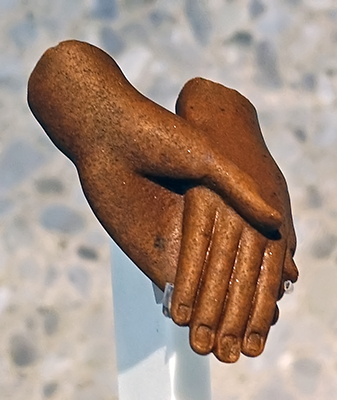
Eighteenth Dynasty: 1 550 BC - 1 292 BC
Hands
Pair of hands from a group statue of Akhenaten and Nefertiti or two princesses, circa 1 350 BC.
Catalog: Quartzite, Amarna, House P 49.6, ÄM 20494
Photo: Don Hitchcock 2018
Source: Original, Staatliche Museen zu Berlin, Neues Museum, Germany
Text: © Card at the Staatliche Museen zu Berlin, (CC BY-NC-SA 3.0 DE)
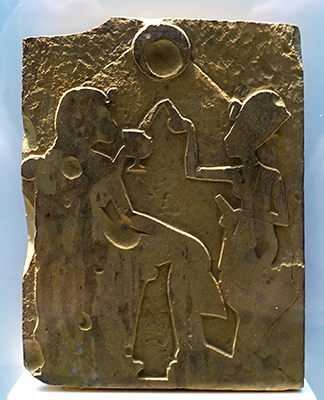
Eighteenth Dynasty: 1 550 BC - 1 292 BC
Nefertiti and Akhenaten
Unfinished stele of Akhenaten and Nefertiti, circa 1 345 BC.
This first rough out of a stela shows Queen Nefertiti pouring wine into a goblet for her husband. The Blue Crown of Nefertiti with the royal uraeus shows that Nefertiti had achieved an improvement in status in the late phase of her husband's reign. This also correlates with the statuette of Nefertiti in Berlin ÄM 21263 which depicts Nefertiti with a cap crown, and a Uraeus metal tiara once attached, and with her at a somewhat advanced age. They prove that at least part of the reign of Nefer-Neferu-Aton (Nefertiti) can be placed as being parallel in importance to that of Akhenaten.
Catalog: Limestone, Amarna, ÄM 20716
Photo: Don Hitchcock 2018
Source: Original, Staatliche Museen zu Berlin, Neues Museum, Germany
Text: © Card at the Staatliche Museen zu Berlin, (CC BY-NC-SA 3.0 DE)
Additional text: Habicht (2014)
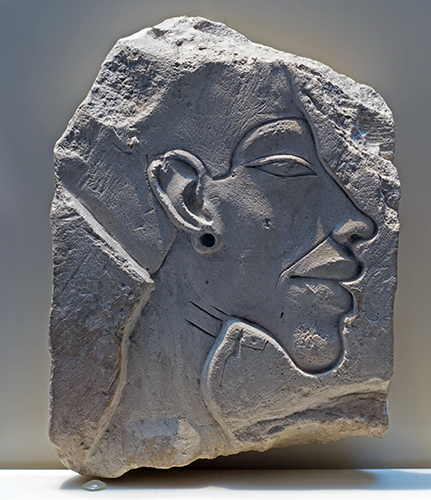
Eighteenth Dynasty: 1 550 BC - 1 292 BC
Akhenaten
The relief shows the head of Pharaoh Akhenaten, which is turned to the right, in the style of the early years of the so-called ' Amarna period '. To this new, expressive, almost caricature-like mode of representation belong the overly long, convexly curved neck, the full lips and the lengthened chin, as well as the narrow eye. The earlobe is pierced by a hole. Neck and nasolabial folds are marked with scored lines. The shape of the king's crown cannot be determined.
Dimensions: 155 x 115 x 32 mm, circa 1 345 BC.
Catalog: Limestone, Amarna, ÄM 14512
Photo: Don Hitchcock 2018
Source: Original, Staatliche Museen zu Berlin, Neues Museum, Germany
Text: © Card at the Staatliche Museen zu Berlin, F. Seyfried at http://www.smb-digital.de/ (CC BY-NC-SA 3.0 DE)
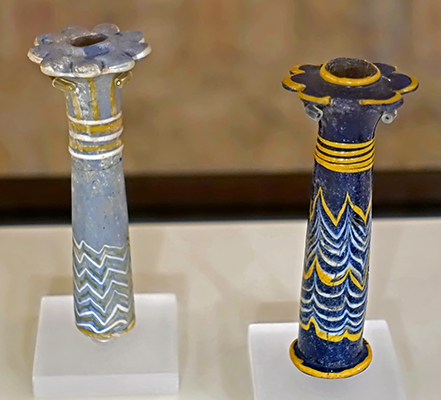
Eighteenth Dynasty: 1 550 BC - 1 292 BC
Vessels for eye-paint (kohl)
Vessels for eye-paint (kohl) in the shape of palm columns, circa 1 340 BC.
Catalog: Glass, ÄM 32257, ÄM 32258
Photo: Don Hitchcock 2018
Source: Original, Staatliche Museen zu Berlin, Neues Museum, Germany
Text: © Card at the Staatliche Museen zu Berlin, (CC BY-NC-SA 3.0 DE)

Eighteenth Dynasty: 1 550 BC - 1 292 BC
Pen-Box
Ivory scribal palette, or pen-box, with two reed pens. Jottings and ink stains are still visible on it.
Two ink wells at the top preserve the remains of red and black pigment. Two rush pens are inserted into the pen slot, the shorter one bearing black ink stains. The palette is not inscribed, but hieratic jottings in black ink cover much of the lower half of the upper surface.
The reverse side bears further hieratic inked text, with reference to measurements, and records of sacks of grain being issued.
Palette: Length 305 mm, width 38 mm.
Catalog: Ivory, reeds, Thebes, EA5524
Photo: Don Hitchcock 2018
Source: Original, British Museum
Text: © Card at the Museum, http://www.britishmuseum.org/research/ © Trustees of the British Museum, CC BY-NC-SA 4.0
Eighteenth Dynasty: 1 550 BC - 1 292 BC
Collar
Glazed composition open-work broad collar. The top row represents yellow and blue mandrake fruits; the middle row is composed of green date palm leaves and the lowest of yellow, white and mauve lotus petals. Between the pendants are strung tiny disc beads in red, blue, mauve or yellow. Even the two triangular terminals into which the stringing threads pass to emerge as a single united cord at each side of the collar take the shape of a lotus inlaid in red, yellow, blue and green to indicate the individual petals. All the elements were made in open moulds, as their backs are flat and not detailed.
Circa 1 352 BC - 1 336 BC during the reign of Akhenaten.
Length 508 mm total.
Curator's comments: It is highly likely that jewellery elements depicting fruit, flowers and parts of plants had an amuletic significance, since all growing plants were inherently symbolic of new life and some flowers actually open each morning, reconfirming the idea of resurrection. This collar was found complete but the original order of stringing could not be determined.
Catalog: glazed, mould-made, Amarna, EA59334
Photo: Don Hitchcock 2018
Source: Original, British Museum
Text: © Card at the Museum, http://www.britishmuseum.org/research/ © Trustees of the British Museum, CC BY-NC-SA 4.0
Eighteenth Dynasty: 1 550 BC - 1 292 BC
Gold Ring
Gold finger-ring with the name of Thutmose III, circa 1 479 BC - 1 425 BC
Known as the Ashburnham Ring, circa 1 352 BC - 1 336 BC, during the reign of Thutmose III.
A gold finger-ring with a solid-cast rectangular swivel-bezel inscribed on one face with prenomen of Thutmose III and epithets: 'Menkhperra beloved of Ptah beautiful-of-face'. The verso has the 'Two Ladies' name of the king: 'Great of Terror in All Lands'.
The cartouche contains Thutmose III's prenomen, Menkheperre, Mn ḫpr Rˁ, 'Enduring is the apparition of Ra'
( In order that the pharaoh, who held divine office, could be linked to the people and the gods, special epithets were created for them at their accession to the throne. These titles also served to demonstrate one's qualities and link them to the terrestrial realm. The five names were developed over the centuries beginning with the Horus name. This name identified the figure as a representative of the god Horus.
The Nebty or 'Two Ladies' name was the second part of the royal titular of Upper and Lower Egypt. This name placed the king under the protection of two female deities, Nekhbet and Wadjet and began sometime towards the end of the First Dynasty as a reference to 'The one who belongs to Upper and Lower Egypt', along with mention of the Two Ladies.
Beginning sometime in the Fourth Dynasty of Egypt, the Gold Falcon name (sometimes called the Horus of Gold) was created. The last two names of the king, the prenomen and the nomen, were generally depicted within the circular, roped cartouche of the king (eventually the cartouche would contain all royal names, including the queen and the royal children) and were known as the Throne name and the Son of Re name. - Don )
Diameter of the ring 29 mm, length of the bezel 18 mm, width of the bezel 16 mm.
Catalog: Gold, Saqqara, Memphis, EA71492
Photo: Don Hitchcock 2018
Source: Original, British Museum
Text: © Card at the Museum, http://www.britishmuseum.org/research/ © Trustees of the British Museum, CC BY-NC-SA 4.0
Additional text: Wikipedia
Eighteenth Dynasty: 1 550 BC - 1 292 BC
(right) Signet Ring
(right) Solid gold signet-ring. The bezel bears a representation of a squatting child-king, wearing a pleated garment and a bag-wig, and adorned with a uraeus. The king sits above the hieroglyphic signs for 'Lord of the Two Lands', a standard royal epithet.
He holds a large feather, symbol of Maat, with a long Shu-feather behind him and an ankh-sign before him. Above him is a sun-disc, flanked by two cobras.
The slouching form of this figure, with wide hips, suggests the style of Akhenaten, who may be the king represented here.
Height 25 mm, length 15 mm, depth 30 mm.
Curator's comments: The image of the king as a child emphasised his role in the cycle of regeneration and rebirth as the son of the gods. This symbolism was especially prominent at the end of the Eighteenth Dynasty, under Amenhotep III, Akhenaten, and Tutankhamun.
Catalog (right): Gold, Saqqara, Memphis, EA32723
Catalog (left), as described fully in the photograph and description immediately above this image: Gold, Saqqara, Memphis, EA71492
Photo: Don Hitchcock 2015
Source: Original, British Museum
Text: © Card at the Museum, http://www.britishmuseum.org/research/ © Trustees of the British Museum, CC BY-NC-SA 4.0
Additional text: Wikipedia
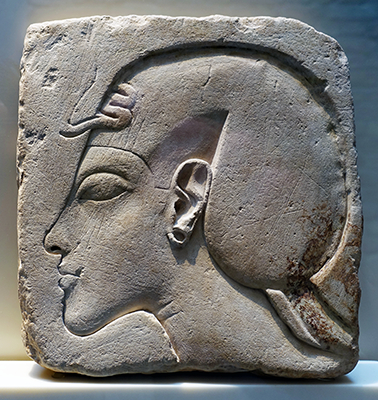
Eighteenth Dynasty: 1 550 BC - 1 292 BC
Akhenaten
Relief portrait of King Akhenaten, circa 1 340 BC.
This is described as a sculptor's model in Ertman (2013)
Catalog: Limestone, Amarna, ÄM 21683
Photo: Don Hitchcock 2015
Source: Original, Staatliche Museen zu Berlin, Neues Museum, Germany
Text: © Card at the Staatliche Museen zu Berlin, (CC BY-NC-SA 3.0 DE)
Eighteenth Dynasty: 1 550 BC - 1 292 BC
Portrait bust of Akhenaten
Circa 1345 BC, 260 x 150 x 200 mm.
Akhenaten is the Pharaoh in Thomas Mann's Joseph trilogy:
'He looked like an aristocratic young Englishman of somewhat decadent stock', wrote Mann, 'spare, haughty, weary, with a well-developed chin which yet somehow looked weak, a nose with a narrow, rather depressed bridge which made even more striking the broad, sensitive nostrils; and deeply, dreamily overshadowed eyes with lids he could never open quite wide. Their weary expression was in disconcerting contrast to the unrouged, morbid brilliancy of the full lips . . .'
The lower end of the headband on this sculpture was subsequently marked by a thin coloured line. The eyebrows and the edges of the eyes are also painted black. Fine lines mark the upper eyelid furrows, the nasolabial folds, the nose wings and nostrils, thus providing a lively, overall visual impression.
At the temples, the recesses for the crown neck are visible, the structure of the blue crown being visible on the left side. In the nape of the gypsum model, a perpendicular crown was formed. The cast was presumably made from two moulds, as one can still see remnants of a retouched centre seam on the forehead and the overlying band. A statuary head apparently served as a model for this sumptuous sculpture, from which the sculptor made a true-to-scale copy. Presumably, this portrait head is a ready-made model and view piece in a workshop.
Catalog: Painted plaster, Amarna, ÄM 21351
Photo: Don Hitchcock 2018
Source: Original, Staatliche Museen zu Berlin, Neues Museum, Germany
Text: © Card at the Staatliche Museen zu Berlin, (CC BY-NC-SA 3.0 DE)
Additional text: Jung (2012b)
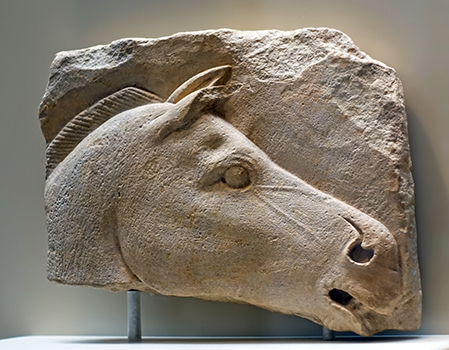
Eighteenth Dynasty: 1 550 BC - 1 292 BC
Horse
Relief study of the head of a horse, circa 1 345 BC.
Catalog: Limestone, ÄM 23717
Photo: Don Hitchcock 2018
Source: Original, Staatliche Museen zu Berlin, Neues Museum, Germany
Text: © Card at the Staatliche Museen zu Berlin, (CC BY-NC-SA 3.0 DE)
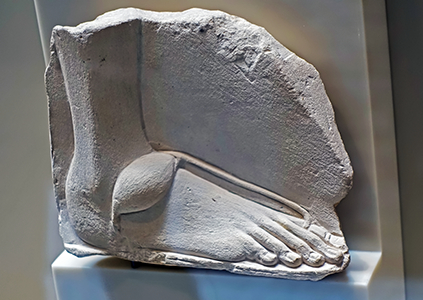
Eighteenth Dynasty: 1 550 BC - 1 292 BC
Foot
Relief study of a human foot, circa 1 345 BC.
Catalog: Limestone, ÄM 20672
Photo: Don Hitchcock 2018
Source: Original, Staatliche Museen zu Berlin, Neues Museum, Germany
Text: © Card at the Staatliche Museen zu Berlin, (CC BY-NC-SA 3.0 DE)
Eighteenth Dynasty: 1 550 BC - 1 292 BC
Temple relief
Falcon-headed sun god Aten and King Amenhotep IV / Akhenaten
Circa 1353 BC
Akhenaten was known before the fifth year of his reign as Amenhotep IV, and Amenophis is the Greek form of the name Amenhotep.
Dimensions: 720 x 1510 x 270 mm
This relief block from Karnak probably dates from the first two years of Amenhotep IV, and is one of the few examples that show the Pharaoh in the traditional manner in Thebes. The relief is divided into two picture panels separated by a vertical inscription line. On the left is a falcon-headed sun god, and on the right Amenophis IV with the blue crown. The iconography in the representation corresponds to the style of Amenophis III.
The face of Amenophis IV / Akhenaten is very similar to that of his father. The inscriptions, on the other hand, tend already towards the new religious ideas, and the sun-disc above the head of Amenophis IV with the signs of life at the lower edge are the forerunners of a motif which is one of the best known in the Amarna period: The god Aton represented by a sun-disc, the rays of which flow into hands and hold signs of life.
Catalog: Painted sandstone, Karnak, Temple of the god Amun, 10th pylon (secondary installation), ÄM 2072
Photo: Don Hitchcock 2018
Source: Original, Staatliche Museen zu Berlin, Neues Museum, Germany
Text: © Card at the Staatliche Museen zu Berlin, http://www.smb-digital.de/ (CC BY-NC-SA 3.0 DE)
Additional text, included on http://www.smb-digital.de/ : Jung (2012a)

Eighteenth Dynasty: 1 550 BC - 1 292 BC
Akhenaten
Three cartouches bearing the name of King Akhenaten and the god Aten.
Length 210 mm, circa 1340 BC.
These bronze cartouches of King Akhenaten and his god Aton were excavated by Borchardt on January 6, 1913, in the so-called ' obscure house Q 47.10 '. The excavator presumed an original placement in the palace or a temple of Achet-Atons. In his opinion, the place of discovery suggests that the objects were ' carried away for the precious metal ' in order to reuse them. Due to the thickness of the material, it can be assumed that the cartouches were originally set into stone or wood. Their size is an indication that it must have been a door frame or the like. A break runs through all three cartridges, which suggests that they may have been forcibly removed from their original position.
The smallest cartouche on the left shows the name of the Akhenaten in the following form: ' The only one of the Re who is beautiful in appearance of the Re '. The two others are assigned to the god Aton. There he bears the name ' Long live the Aton, ruler of the two horizons who rejoice in the light country ' with the addition ' in his name as Re, the father who has come out as Aton '. This is the later version of the god's name, which previously contained names of other gods, which finally had to give way in favour of the sole naming of the Aton.
Catalog: Bronze, Amarna, Haus O 47.10 ÄM 22082/1-3
Photo: Don Hitchcock 2015
Source: Original, Staatliche Museen zu Berlin, Neues Museum, Germany
Text: © Card at the Staatliche Museen zu Berlin, http://www.smb-digital.de/ (CC BY-NC-SA 3.0 DE)
Additional text: Weber (2012)
Eighteenth Dynasty: 1 550 BC - 1 292 BC
Head of a princess.
Head of a statue of a princess, probably a daughter of Akhenaten, without inlays. 210 mm.
Circa 1345 BC
The Princess's head was discovered in the 'large courtyard' of P 47.2 / 3, just a few metres north of the Wall of P 47.1. In its immediate vicinity a royal statuary head (Acts 21222) had been found earlier. According to Borchardt's diary entries, it lay 'face up, embedded in hair'.
The polished portrait is very similar in form and material to the head ÄM 21364, which was found in 1911 near the sculptor's workshop. In contrast to the latter, the surface of the back part of the sculpture is polished to a smoother finish. The facial features of the princess are based on the representation of her father Akhenaten: a long face, a pronounced chin and a curved neck. The head was intended for a composite statue, having a pin below the neck. Paint residues in the creases as well as the recesses of the eyes and eyebrows suggest that this statuary element had already been painted and provided with inlays of faience, glass or precious stones, but these were removed when taken from the workshops of Achet-Aten.
Catalog: Amarna, Quartzite, P 47.2 / 3, ÄM 21223
Photo: Don Hitchcock 2018
Source: Original, Staatliche Museen zu Berlin, Neues Museum, Germany
Text: © Card at the Staatliche Museen zu Berlin, http://www.smb-digital.de/ (CC BY-NC-SA 3.0 DE)
Additional text: Wegner (2012)

Eighteenth Dynasty: 1 550 BC - 1 292 BC
Head of a princess.
Dimensions: 147 x 117 x 140 mm
According to Ludwig Borchardt's diary, the 'very pleasing find' of a princess's head came to light in a group of small houses near the famous sculptor's workshop. There it was discovered in a shed in the main living area 29. Based on this finding, Borchardt assumed that this was the home of a sculptor. In his opinion, the small room could have been used as a storage place for unfinished work. But he also stated the possibility 'that the head from another workshop was taken here'.
The head of the princess, damaged on the nose, mouth and ears, closely resembles the portrait ÄM 21223, which was discovered in P 47.2. The skull has a protruding shape on all sides, which Borchardt calls 'pronounced hydrocephalus' in his diary. The prepared eye sockets and eyebrows were intended for coloured inserts made of glass, faience or stone.
The fine lines of the eyelids may have been filled with a coloured paste. It is striking that the side and back of the skull, unlike the face, have not yet been polished. The cheekbones and skull bones as well as the muscle attachments on the back of the head are clearly shown to be in accordance with that of the royal family.
From: Tauschner, L., in: F. Seyfried (Hrsg.), Im Licht von Amarna. 100 Jahre Fund der Nofretete, Berlin 2012, S. 262 (Kat.-Nr. 41).
Catalog: Amarna, Quartzite, O 49.13, (small group of houses), ÄM 21364
Photo: Don Hitchcock 2015, 2018
Source: Original, Staatliche Museen zu Berlin, Neues Museum, Germany
Text: © Card at the Staatliche Museen zu Berlin, http://www.smb-digital.de/ (CC BY-NC-SA 3.0 DE)
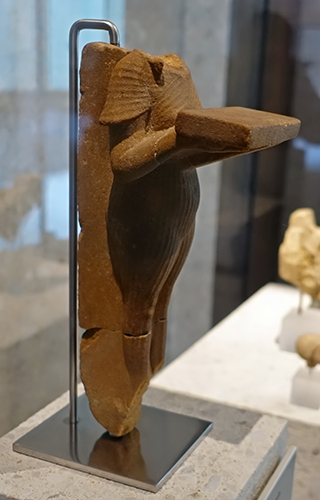
Eighteenth Dynasty: 1 550 BC - 1 292 BC
Statuette of a princess.
Statuette of a princess with a sacrificial plate.
Circa 1 351 BC - 1 334 BC
Height x width x depth: 224 x 86 x 110 mm.
Weight: 985 g.
During Akhenaten's reign, permissions for private sacrifices were greatly restricted. The pharaoh himself was now - even more prominently than in earlier times - the chief priest and therefore the only one authorised by Aton to carry out acts of sacrifice. At most, Nefertiti and their daughters were still authorised to do this. The royal family was also allowed to carry out sacrificial and consecration processions.
This statuette of a princess, whose curly hair can still be seen in remains on the right shoulder, bears an unlabelled sacrificial plate. This form of representation of the act of sacrifice is an assumption of fertility and Nile gods. This also refers to the earthly gift of swelling the Nile and ensuring a rich harvest.
After: Rattmann, A., in: F. Seyfried (Hrsg.), Im Licht von Amarna. 100 Jahre Fund der Nofretete, Berlin 2012, S. 234 (Kat.-Nr. 22).
Catalog: Quartzite, Amarna, N 47.06 (homestead), ÄM 21690
Photo: Don Hitchcock 2018
Source: Original, Staatliche Museen zu Berlin, Neues Museum, Germany
Text: © Card at the Staatliche Museen zu Berlin, http://www.smb-digital.de/ (CC BY-NC-SA 3.0 DE)

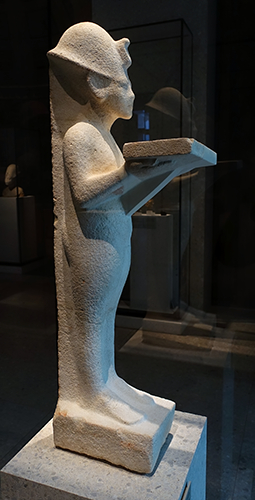
Eighteenth Dynasty: 1 550 BC - 1 292 BC
Akhenaten
Unfinished statue of Akhenaten standing with a sacrificial plate in his hands.
Circa 1 340 BC.
Height x width x depth: 1060 x 252 x 275 mm.
This unfinished statue of Akhenaten with a blue crown was purchased in 1992. The statue is still in 'rough working' condition and has remnants of red and black markings. The king originally held a sacrificial plate in his hands, the fracture surface of which is clearly visible ( now restored - Don ).
Two fragments of hands holding a sacrificial plate were found in Achet-Aton during the excavation of Ludwig Borchardt. The size and material of these fragments match the status of the stand exactly, which is why they can be viewed as belonging and are now included in the reconstruction. However, the two fragments come from different houses in Achet-Aton. Although the buildings belong to the same 'building block', they are not directly adjacent. It is unclear how the two fragments of the sacrificial plate got into different houses.
The statue type of the sacrificial plate carrier was an innovation of the early 18th Dynasty and was used in both private and royal sculptures. In his manifestation as visible light, the god Aton was able to receive the offerings directly. Offering sacrifices in the open air was therefore particularly important in the Amarna period. This is borne out by numerous depictions in relief and statues of the sacrificing Akhenaten and his entire family.
From: Taschner, L., in: F. Seyfried (Hrsg.), Im Licht von Amarna. 100 Jahre Fund der Nofretete, Berlin 2012, S. 232 (Kat.-Nr. 21)
Catalog: Limestone, Amarna, ÄM 34437
Photo: Don Hitchcock 2018
Source: Original, Staatliche Museen zu Berlin, Neues Museum, Germany
Text: © Card at the Staatliche Museen zu Berlin, http://www.smb-digital.de/ (CC BY-NC-SA 3.0 DE)
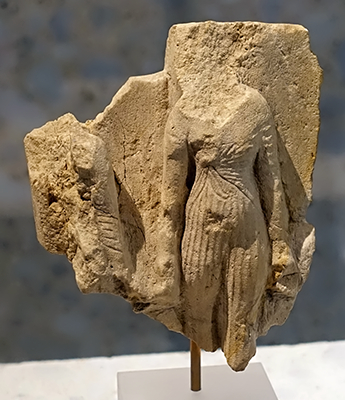
Eighteenth Dynasty: 1 550 BC - 1 292 BC
Merit-aten and Meket-aten
Fragmentary pair-statue, Merit-aten and Meket-aten, daughters of Amenophis IV / Akhenaten.
Circa 1 345 BC
Catalog: Limestone, ÄM 20718
Photo: Don Hitchcock 2018
Source: Original, Staatliche Museen zu Berlin, Neues Museum, Germany
Text: © Card at the Staatliche Museen zu Berlin, (CC BY-NC-SA 3.0 DE)
Additional text: http://www.griffith.ox.ac.uk/gri/3berlin.pdf
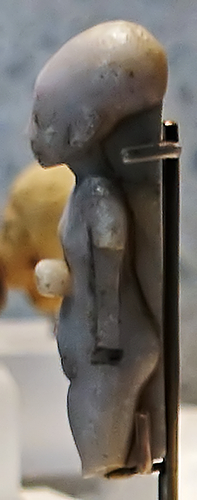
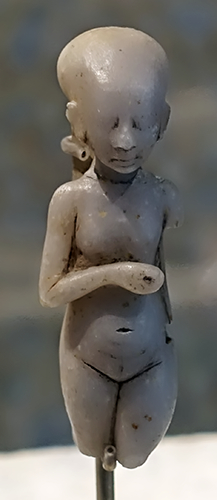
Eighteenth Dynasty: 1 550 BC - 1 292 BC
A Princess
Statuette of a Princess.
From the reign of Akhenaten.
( note the elongated head, seen clearly in the left hand image, which almost certainly means that it is of one of the daughters of Akhenaten and Nefertiti - Don )
Circa 1 345 BC
Catalog: Calcite-alabaster, ÄM 17951
Photo: Don Hitchcock 2018
Source: Original, Staatliche Museen zu Berlin, Neues Museum, Germany
Text: © Card at the Staatliche Museen zu Berlin, (CC BY-NC-SA 3.0 DE)
Additional text: http://www.griffith.ox.ac.uk/gri/3berlin.pdf
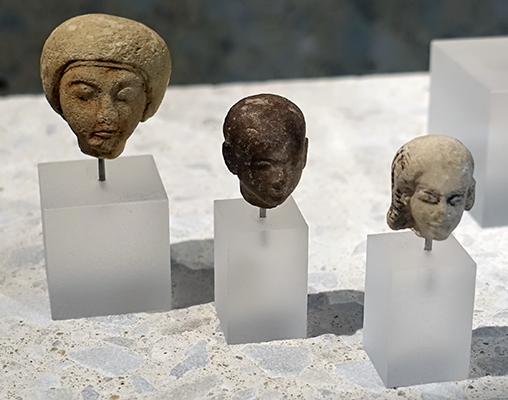
Eighteenth Dynasty: 1 550 BC - 1 292 BC
Heads of Princesses
Three small heads of princesses.
Circa 1 345 BC
Catalog: ÄM 29595, ÄM 25575, ÄM 22034
Photo: Don Hitchcock 2018
Source: Original, Staatliche Museen zu Berlin, Neues Museum, Germany
Text: © Card at the Staatliche Museen zu Berlin, (CC BY-NC-SA 3.0 DE)
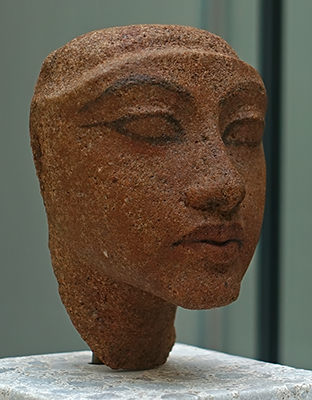
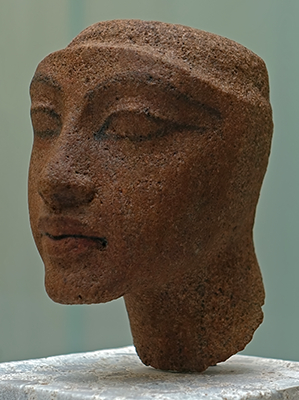
Eighteenth Dynasty: 1 550 BC - 1 292 BC
Queen's head
Reign of Akhenaten.
Dimensions: 110 x 68 x 85 mm.
The under-sized head shows a royal woman whose identity is unknown. The face has an oval shape, a strong nose and full lips. Remains of black paint can be found on the unfinished eyes and eyebrows. Traces of red paint have also remained on the lips. The youthful-looking face is characterised by slightly lowered upper eyelids, which, together with the flat transition of the not yet pronounced tear ducts to the cheeks, give rise to the 'veiled look' that has been mentioned many times. The indentations on the forehead and temples were probably intended for a wig or crown, which would also explain the missing ears on the head and suggests that this head was part of a composite statue.
The thesis put forward in the literature that this is Kija, Akhenaten's well-known co-wife, or Merit-Aton, a daughter of Akhenaten and Nefertiti, cannot be clearly decided. However, the facial features preclude assignment to Nefertiti.
From: Jung, M., in: F. Seyfried (Hrsg.), Im Licht von Amarna. 100 Jahre Fund der Nofretete, Berlin 2012, S. 346 (Kat.-Nr. 127).
Catalog: Quartzite, painted, Amarna, P 47.02, P 47 / P 47.01-03 (estate), room 19, ÄM 21245
Photo: Don Hitchcock 2018
Source: Original, Staatliche Museen zu Berlin, Neues Museum, Germany
Text: © Card at the Staatliche Museen zu Berlin, http://www.smb-digital.de/ (CC BY-NC-SA 3.0 DE)
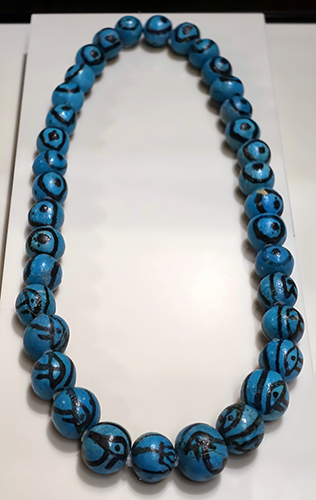
Eighteenth Dynasty: 1 550 BC - 1 292 BC
Yoke pendant
Yoke pendant of a chariot, beads with magic symbols of health.
Circa 1 340 BC - 1 334 BC
This ancient Egyptian chain dates to the reign of Pharaoh Akhenaten. It was found in 1911 during the excavations of the German Orient Society under the direction of Ludwig Borchardt in Tell el-Amarna. The modern site is located on the remains of the ancient settlement of Achet-Aton (translated: Horizon of Light), the new residence founded by Pharaoh Akhenaten, which is today scientifically researched by the Amarna Project under the leadership of the British Egyptologist Barry Kemp.
The chain with a total length of 95 cm consists of 35 beads with a diameter of 25 to 31 mm, with black paint protection symbols painted on the balls. Eleven beads carry the 'Udjat eye', 24 beads show a stylised representation of an iris with pupil - also known as 'fish eye'. The modern threading of the juxtaposed Udjat eyes can be considered assured. Another bead stands out in its appearance. On one side it shows an ankh, symbolizing 'life' and 'power'. This is located between two Was-Scepters, an ancient Egyptian symbol in the form of a staff. It has a stylised animal head at the top, is forked at the bottom and has either a straight or wavy shaft, and they are usually handed over by the gods to the kings and stand as a symbol of power or luck.
Catalog: Tell el-Amarna, faience, painted, Tell el-Amarna, house N 51.03, stable, ÄM 21944
Photo: Don Hitchcock 2018
Source: Original, Staatliche Museen zu Berlin, Neues Museum, Germany
Text: © Card at the Staatliche Museen zu Berlin, (CC BY-NC-SA 3.0 DE)
Additional text: https://blog.smb.museum/35-mal-goettlicher-schutz-ein-alt-aegyptisches-jochgehaenge/, Wikipedia
(left) House N 51.3, with stables marked in red.
Photo: L. Borchardt, H. Ricke: The houses in Tell el-Amarna, Scientific publication of the German Orient Society 91, Berlin 1980, Plan 110
Proximal source: https://blog.smb.museum/35-mal-goettlicher-schutz-ein-alt-aegyptisches-jochgehaenge/
____
(right) Amenhotep IV and Nefertiti on the chariot: the yoke hanger fastened to the harness of the horse is marked in red.
Source: N. Davies, The Rock Tombs of El Amarna, Part III, The Tombs of Huya and Ahmes (Archaeological Survey of Egypt, Fifteenth Memoir), London 1905, Pl.
Proximal source: https://blog.smb.museum/35-mal-goettlicher-schutz-ein-alt-aegyptisches-jochgehaenge/
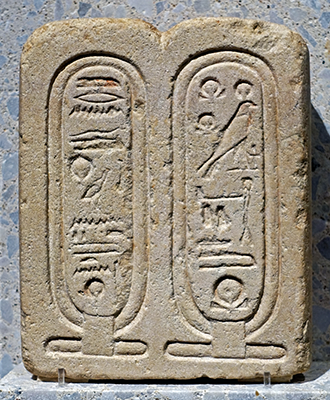
Eighteenth Dynasty: 1 550 BC - 1 292 BC
Relief block
Relief block with the cartouches of the god Aton.
Dimensions: 200 x 160 x 55 mm.
Catalog: Painted limestone, Amarna, N 49.06 (small houses), ÄM 20720
Photo: Don Hitchcock 2018
Source: Original, Staatliche Museen zu Berlin, Neues Museum, Germany
Text: © Card at the Staatliche Museen zu Berlin, http://www.smb-digital.de/ (CC BY-NC-SA 3.0 DE)

Eighteenth Dynasty: 1 550 BC - 1 292 BC
Votive plaque
Votive plaque or relief stele for the god Aten / Aton.
Small holy table with kneeling king and cartouches of Aton, Akhenaten and Nefertiti.
In the 6th year of his reign, Akhenaten changed several parts of his name and had the god Amun replaced by Aton /Aten. The pharaoh appears on the dedication tablet (ÄM 2045), as the life-giving god Shu. In this function, he raises the two cartouches with the name of the god Aton and thus converts the meaning of the word Schu into an active action, since the word in addition to the meaning 'sun; light' can also mean 'to raise'. This implementation can also be found in his changed Goldhorus name: 'Who raises the name of Aton.' In front of and behind the pharaoh are his two names in cartouches and the cartouche of his royal consort Nefertiti. The function of the object has not been clarified.
From: Rattmann, A., in: F. Seyfried (Hrsg.), Im Licht von Amarna. 100 Jahre Fund der Nofretete, Berlin 2012, S. 236 (Kat.-Nr. 24).
Catalog: Calcite alabaster (travertine), provenance unknown, ÄM 2045
Photo: Don Hitchcock 2018
Source: Original, Staatliche Museen zu Berlin, Neues Museum, Germany
Text: © Card at the Staatliche Museen zu Berlin, http://www.smb-digital.de/ (CC BY-NC-SA 3.0 DE)
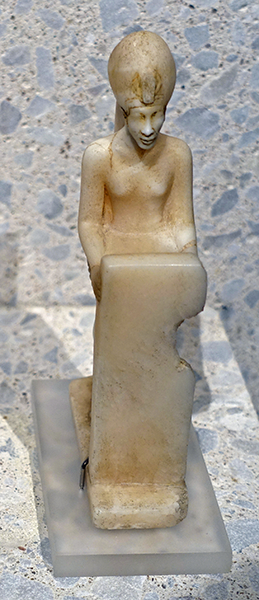

Eighteenth Dynasty: 1 550 BC - 1 292 BC
Akhenaten
Standing figure of Akhenaten holding an uninscribed stela.
Circa 1 351 BC - 1 334 BC
Dimensions: 120 x 30 x 60 mm.
Sacrifice and consecration were integral parts of the cult of the gods. During Akhenaten's reign, the possibility of private victims was largely restricted. The pharaoh himself was now - even more exposed than in earlier times - the chief priest and therefore the only one authorised by Aton to perform acts of sacrifice. At most, Nefertiti and their daughters were still authorised to do this. The royal family was also allowed to carry out sacrificial and consecration processions.
The type of stelophora, a figure carrying stelae, was developed under Hatshepsut. This new type occurred exclusively in Thebes West and became further developed in the reign of Amenophis III as a standing figure. It originally belonged to private sculpture, and in connection with the sun hymn it can also be found in Theban tombs. Akhenaten also used this type for royal presentations and wears the Blue Crown for this piece, which is only a decorative element and cannot be assigned to any cult role. It is remarkable that the pharaoh appears barefoot, which does not correspond to the normal royal regalia.
From: Rattmann, A., in: F. Seyfried (Hrsg.), Im Licht von Amarna. 100 Jahre Fund der Nofretete, Berlin 2012, S. 234 (Kat.-Nr. 22).
( note also that an uninscribed stela is quite unusual, at least for larger, more massive figures of this type, and that the sculptor has shown Akhenaten's (visible) leg as being directly beneath his elbow, seemingly not in its correct position on the body - Don )
Catalog: Calcite-Alabaster, Amarna, N 48.15 (houses) ÄM 21835
Photo: Don Hitchcock 2018
Source: Original, Staatliche Museen zu Berlin, Neues Museum, Germany
Text: © Card at the Staatliche Museen zu Berlin, http://www.smb-digital.de/ (CC BY-NC-SA 3.0 DE)
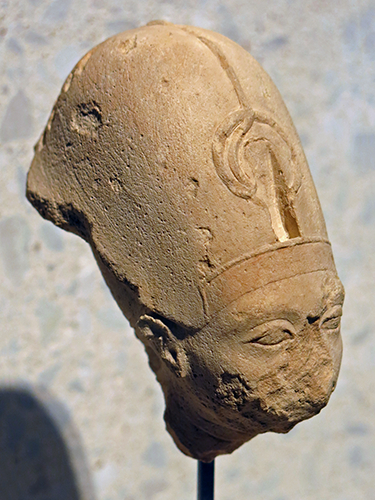
Eighteenth Dynasty: 1 550 BC - 1 292 BC
Head of a king.
Head of a king with a blue crown.
Circa 1 351 BC - 1 334 BC
Reign of Akhenaten.
Dimensions: 100 x 60 x 79 mm.
The statuette head was found in the paved courtyard on the east wall of P 47.3. Also discovered there was a small alabaster falcon's head, the head and associated torso of a sandstone princess statue and the fragment of an Uraean frieze. Due to the blue crown, the statuette head can be attributed to a male, royal person. The attachment of the back pillar is preserved at the back of the headdress.
On the forehead, the elongated recess of the front body of the uraeus snake, which is made of a different material, is clearly visible. There are traces of red paint in the corners of the eyes and at the base of the crown. Remains of black painting are visible on the eye contours. At the top of the neck the portrait has two folds, which are typical of the depictions during the Amarna period. Despite missing elements that are important for dating such as the mouth and nose, the almond-shaped eyes and the modelling of the facial features speak for a portrait from the late Amarna period.
In this phase, the protruding cheekbones, the elongated face and the slit-shaped eyes were replaced by softer features. Statuettes like this may also have been used in private settings. There they could have served as mediators to Aton in small chapels and were themselves the subject of cult worship.
Catalog: Limestone, Amarna, P 47, P 47.01-03 (estate), ÄM 21200
Photo: Don Hitchcock 2015
Source: Original, Staatliche Museen zu Berlin, Neues Museum, Germany
Text: © Card at the Staatliche Museen zu Berlin, http://www.smb-digital.de/ (CC BY-NC-SA 3.0 DE)
Additional text: Taschner, L., in: F. Seyfried (ed.), In the light of Amarna. 100 Years Discovery of the Nefertiti, Berlin 2012, p. 384 (cat.no.173), via http://www.smb-digital.de/
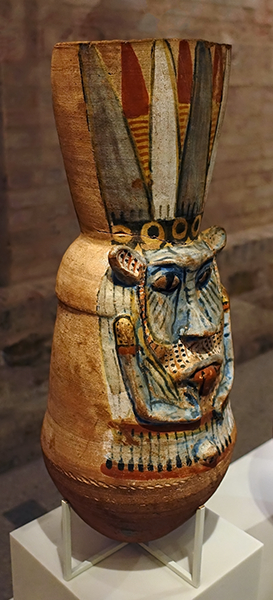
Eighteenth Dynasty: 1 550 BC - 1 292 BC
Wine vessel
Wine vessel (funnel neck vessel) in the shape of the god Bes.
Dimensions: 520 x 220 mm.
This large ceramic vessel has a rounded lower body, a drawn-in middle part and a stepped, funnel-shaped neck. The front of the body of the vessel is made in the shape of the god Bes in a semi-plastic shape: the face, arms, navel and the shoulder area are modelled. The contours and details of Bes are marked with multicoloured painting, which is only on the front of the vessel.
The upper body of the blue-skinned, bearded Bes appears with animal ears, mane, wide-open eyes and extended tongue on the body of the vessel, while the funnel-shaped neck is decorated for the typical feather crown of Bes, which here resembles the shape of an open lotus flower. His comparatively short, narrow arms are angled against the front of the body. A stylised flower wreath is attached to his navel. A circumferential band of notched cross lines is located directly below the painting.
The god Bes, with his grotesque-looking features, was a protective god at home for the Egyptians, who was supposed to dispel all evil through his terrible appearance. He also belonged to the circle of the goddess Hathor. In the wake of the Hathor, he was often associated with dance, music and drunkenness. It is therefore suspected that the funnel-necked vessel with the Bes representation may have been used as a wine vessel for festive occasions in which the intoxication was an important component.
Since the painting was done before firing and became waterproof, it could theoretically have been used for the actual use in the preparation and serving of drinks. However due to the elaborate decoration, which is only on the front side, it is more likely that it was primarily used purely for decorative purposes.
Few comparable Bes vessels with blue paint are known. The Berlin specimen proves to be a special piece due to the good condition and the high quality craftsmanship compared to other such vessels.
Text above: I. Liao
Catalog: Amarna (?), ceramic, painted, ÄM 22620
Photo: Don Hitchcock 2018
Source: Original, Staatliche Museen zu Berlin, Neues Museum, Germany
Text: © Card at the Staatliche Museen zu Berlin, (CC BY-NC-SA 3.0 DE)
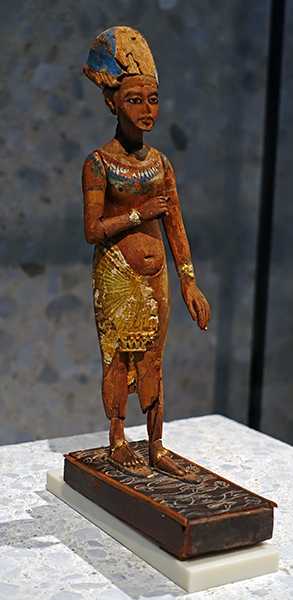
Eighteenth Dynasty: 1 550 BC - 1 292 BC
Tutankhamen or Akhenaten
Standing-striding figure of either Tutankhamen or Akhenaten.
1 340 BC - 1 330 BC.
( The card on this statue in the Neues Museum says that this is either Tutankhamen or Akhenaten. If the choice is between Tutankhamen or Akhenaten, then to my mind this must be Tutankhamen. A young man is portrayed, and the distinguishing features of Akhenaten are quite absent. The nose and chin are not those of Akhenaten. The online catalog of the Neues Museum, however, identifies it as Akhenaten, as in the text below - Don )
Statuette of the King Akhenaten, dimensions 260 x 75 x 133 mm.
The left arm is stretched out, straight down and held slightly in front of the body. The hand is also stretched out flat. In contrast, the right arm is angled in front of the body and the hand is clenched in front of the chest. The two sceptres, the crook and flail, were probably in the hand.
The head is directed forward and shows almond-shaped eyes, which are highlighted by black and white colour, broad brow arches, a delicate nose and a full, red painted mouth. The moustache and whiskers were painted black. The ears are far behind and are set very high. The sitter is crowned by the blue crown, which was worked separately, and the associated headband.
These as well as the sceptres, which must be inferred, mark the man as king, possibly Akhenaten. On the base, nine captive enemies are reproduced, over which the pharaoh passes and thus, figuratively, annihilates them. The enemies are the three large neighbouring groups of Egypt: Nubians, Asians and Libyans.
The described object was bought in Luxor in 1918 by Ludwig Borchardt for James Simon, who donated it to the Egyptian Museum and Papyrus Collection in Berlin. Although the exact origin is not known, it is likely that statuettes of the king and his family were placed in private shrines of the royal couple in Amarna in their own shrines.
Text above: Jessica Jancziak, In: J. Helmbold-Doyé - J. Jancziak (Hrsg.), Wechselnde Identitäten. Eine Ausstellung mit Werken von Gleb Bas, Sonderschrift der Ägyptischen Sammlung (SÄS) 4, Berlin 2015, S. 48
Catalog: Wood, paint, partially gilded, Amarna, ÄM 21836
Photo: Don Hitchcock 2018
Source: Original, Staatliche Museen zu Berlin, Neues Museum, Germany
Text: © Card at the Staatliche Museen zu Berlin, http://www.smb-digital.de/ (CC BY-NC-SA 3.0 DE)
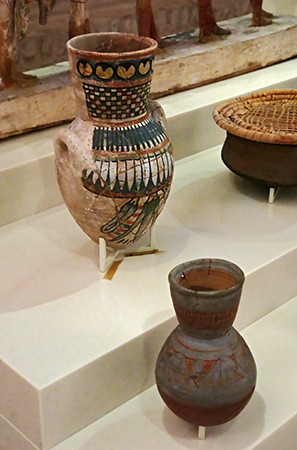
Eighteenth - Nineteenth Dynasty: 1 550 BC - 1 187 BC
Painted wine vessel with handles (top)
Catalog: Deir el-Medine, ceramic, ÄM 21327
Eighteenth Dynasty: 1 550 BC - 1 292 BC
Small storage vessel with glazed blue floral pattern of Lotus flowers. (bottom)
Catalog: circa 1 340 BC, Luxor, ceramic, ÄM 14988
Photo: Don Hitchcock 2015
Source: Original, Staatliche Museen zu Berlin, Neues Museum, Germany
Text: © Card at the Staatliche Museen zu Berlin (CC BY-NC-SA 3.0 DE)
Eighteenth Dynasty: 1 550 BC - 1 292 BC
Palace Life
Circa 1340 BC
(left) Musician with lyre and lute.
(right) Servant brings a headrest.
Catalog: Limestone, el-Armana/Hermupolis, Inv. nos. 178.16, 1964.26
Photo: Don Hitchcock 2018
Source and text: Original, Museum August Kestner, Hannover
Additional text: Wikipedia
Eighteenth Dynasty: 1 550 BC - 1 292 BC
Storage scenes
Two reliefs with storage scenes from the Temple of Aton. This appears to show bags of grain being stacked in neat piles, apparently on stone platforms. Perhaps this made rodent control easier, and in any case one can see why the Egyptians had a great fondness for domestic cats!
Circa 1 340 BC.
Large granaries were attached to temples and palaces, as here at the Temple of Aton, while smaller ones were distributed within the local town.
Catalog: Limestone, el-Amarna/Hermupolis, Inv. nos. 1972.16 and 1978.17
Photo: Don Hitchcock 2018
Source and text: Original, Museum August Kestner, Hannover
Additional text: Wikipedia
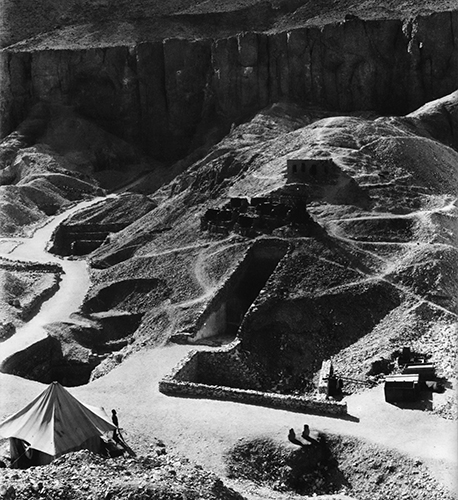
Valley of the Kings, 1923
In the centre of the picture, the entrance to Ramesses VI's tomb, below it the modern wall enclosure of the entrance to Tutankhamun's tomb.
Photo: Howard Carter
Proximate source and text: von Zabern (1980)
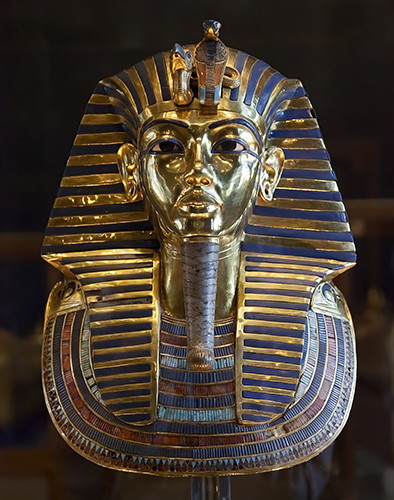
Eighteenth Dynasty: 1 550 BC - 1 292 BC
Tutankhamun
The 1922 discovery by Howard Carter of Tutankhamun's nearly intact tomb, funded by Lord Carnarvon, received worldwide press coverage. It sparked a renewed public interest in ancient Egypt, for which Tutankhamun's mask, now in the Egyptian Museum, remains the popular symbol. Exhibits of artefacts from his tomb have toured the world. In February 2010, the results of DNA tests confirmed that he was the son of the mummy found in the tomb KV55, believed by some to be Akhenaten. His mother was his father's sister and wife, whose name is unknown but whose remains are positively identified as 'The Younger Lady' mummy found in KV35. The 'mysterious' deaths of a few of those who excavated Tutankhamun's tomb have been popularly attributed to the curse of the pharaohs.
Since January 1, 2016 it is possible again to take photographs in the Egyptian Museum in Cairo. The funerary mask of Tutankhamun is certainly the most popular exhibit.
Catalog: JE 60672
Photo: Roland Unger, GNU Free Documentation License, Version 1.2
Source and text: Cairo Museum, Wikipedia
The mask is 540 mm tall, 393 mm wide and 490 mm deep. It is fashioned from two layers of high-carat gold, varying from 1.5 to 3 mm in thickness, and weighing 10.23 kg (22.6 lb). X-ray crystallography has revealed that the mask contains two alloys of gold: a lighter 18.4 karat shade for the face and neck, and 22.5 karat gold for the rest of the mask.
This mask of Tutankhamun is an example of the highest artistic and technical achievements of the ancient Egyptians in the New Kingdom. Covering the head of the wrapped mummy in its coffin and activated by a magical spell, no.151b from the Book of the Dead, the mask ensured more protection for the king's body.
The exact portrayal of the king's facial features achieved here made it possible for his soul to recognise him and return to his mummified body, thus ensuring his resurrection. The head is covered by the royal headdress and the forehead bears the emblems of kingship and protection: the vulture and uraeus, or cobra.
The gold sheets used in this wonderful mask are joined together by heating and hammering. The eyes are of obsidian and quartz and the eyebrows and eyelids are inlaid with lapis lazuli. The broad inlaid collar of semiprecious stones and coloured glass ends in falcon heads.
The face represents the pharaoh's standard image, and the same image was found by excavators elsewhere in the tomb, in particular in the guardian statues. He wears a 'nemes' headcloth, topped by the royal insignia of a cobra (Wadjet) and vulture (Nekhbet), symbolising Tutankhamun's rule of both Lower Egypt and Upper Egypt respectively.
The ears are pierced to hold earrings, a feature that appears to have been reserved for queens and children in almost all other surviving ancient Egyptian works of art. It contains inlays of coloured glass and gemstones, including lapis lazuli (the eye surrounds and eyebrows), quartz (the eyes), obsidian (the pupils), carnelian, feldspar, turquoise, amazonite, faience and other stones (as inlays of the broad collar).
When it was discovered in 1925, the 2.5 kg narrow gold beard, inlaid with blue lapis lazuli, giving it a plaited effect, had become separated from the mask, but it was reattached to the chin using a wooden dowel in 1944.
In August 2014, the beard fell off when the mask was taken out of its display case for cleaning. The museum workers responsible used quick-drying epoxy in an attempt to fix it, leaving the beard off-centre. The damage was noticed in January 2015, and has been repaired by a German-Egyptian team who reattached it using beeswax, a natural material used by the ancient Egyptians.
Additional text: http://www.globalegyptianmuseum.org/record.aspx?id=15062

Eighteenth Dynasty: 1 550 BC - 1 292 BC
Tutankhamun
This is the rarely depicted rear view of the mask above.
A protective spell is inscribed with Egyptian hieroglyphs on the back and shoulders in ten vertical and two horizontal lines. The spell first appeared on masks in the Middle Kingdom, 500 years before Tutankhamun, and was used in Chapter 151 of the Book of the Dead.
Osiris was the Egyptian god of the afterlife. Ancient Egyptians believed that kings preserved in the likeness of Osiris would rule the Kingdom of the Dead. It never totally replaced the older cult of the sun, in which dead kings were thought to be reanimated as the sun-god Re, whose body was made of gold and lapis lazuli. This confluence of old and new beliefs resulted in a mixture of emblems inside Tutankhamun's sarcophagus and tomb.
Although it is usually removed when the mask is on display, it has a triple-string necklace of gold and blue faience disc-beads with lotus flower terminals and uraeus clasps.
Photo: von Zabern (1980)
Source and text: Cairo Museum, Wikipedia

Eighteenth Dynasty: 1 550 BC - 1 292 BC
Tutankhamun
The tomb of the ancient Egyptian king Tutankhamun at Luxor is one of the most famous discoveries in modern archaeology.
An exhibition (2022) at the University of Oxford's Bodleian Libraries - Tutankhamun: Excavating the Archives - marks the 100th anniversary of the discovery by the British Egyptologist Howard Carter and his team.
Dramatically lit images captured by the photographer Harry Burton, along with letters, plans, drawings and diaries from Carter's archive shed new light on the story of the 10-year excavation of the tomb, which was the first known intact royal burial from ancient Egypt.
They also challenge the perception of Carter as a solitary hero, highlighting the contribution of the many skilled Egyptian workers who are often overlooked.
Tutankhamun's gold mask, seen here without its beard, was covered with paraffin wax by photographer Harry Burton to dull reflections.
Photo: Harry Burton/Griffith Institute, Oxford University
Source: An exhibition at the University of Oxford's Bodleian Libraries - Tutankhamun: Excavating the Archives, 2022 - marks the 100th anniversary of the discovery by the British Egyptologist Howard Carter and his team.
Proximate source and text: https://www.bbc.com/news/world-middle-east-61394416
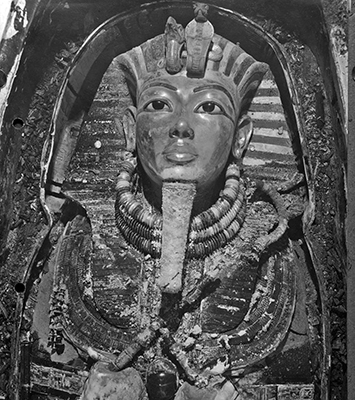
Eighteenth Dynasty: 1 550 BC - 1 292 BC
Tutankhamun
Tutankhamun's solid gold mask, found on his mummified body, was one of the most iconic objects discovered in the tomb.
Photo: Harry Burton/Griffith Institute, Oxford University
Source: An exhibition at the University of Oxford's Bodleian Libraries - Tutankhamun: Excavating the Archives, 2022 - marks the 100th anniversary of the discovery by the British Egyptologist Howard Carter and his team.
Proximate source and text: https://www.bbc.com/news/world-middle-east-61394416
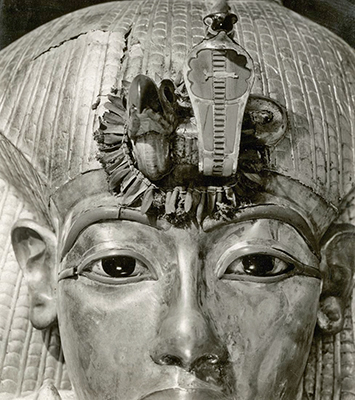
Eighteenth Dynasty: 1 550 BC - 1 292 BC
Tutankhamun
The photographer Harry Burton's intimate view of Tutankhamun's outer coffin focuses on the garland of cornflowers and olives leaves adorning the young king's forehead.
Soon after it was exposed, the natural materials disintegrated. Its existence is now preserved only through this striking image.
Photo: Harry Burton/Griffith Institute, Oxford University
Source: An exhibition at the University of Oxford's Bodleian Libraries - Tutankhamun: Excavating the Archives, 2022 - marks the 100th anniversary of the discovery by the British Egyptologist Howard Carter and his team.
Proximate source and text: https://www.bbc.com/news/world-middle-east-61394416
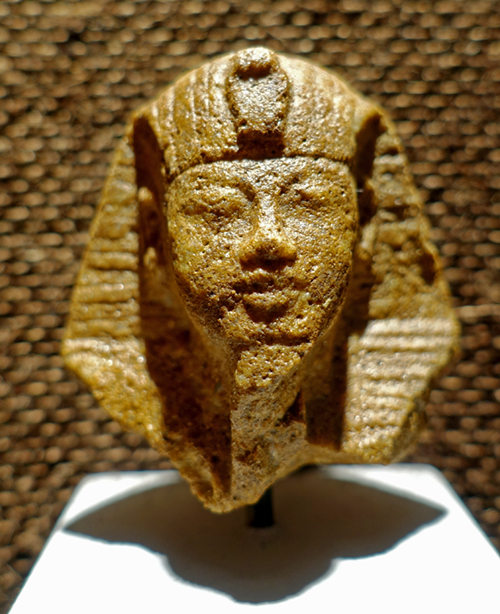
Eighteenth Dynasty: 1 550 BC - 1 292 BC
Tutankhamun
Head of a quartzite sphinx of Pharaoh Tutankhamun
Circa 1 350 BC.
The so-called Nemes headscarf of the king, which extends far back, makes it likely that it is a fragment of a sphinx. The round face suggests an attribution to Pharaoh Tutankhamun.
Inv. No. 1977.3
Photo: Don Hitchcock 2018
Source and text: Original, Museum August Kestner, Hannover
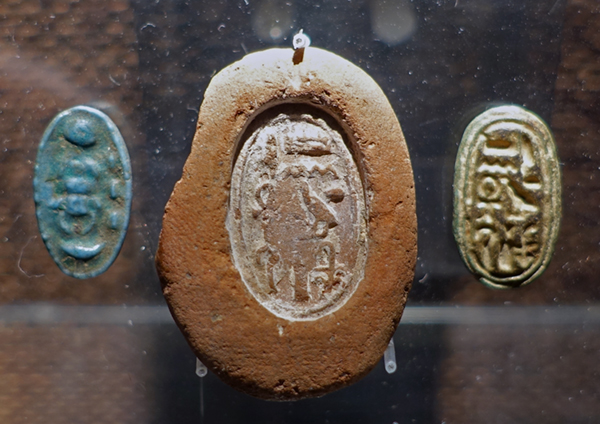
Eighteenth Dynasty: 1 550 BC - 1 292 BC
Cartouches
Although not identified in the museum, these cartouches appear to be those of Tutankhamun, and were associated with the sculpture above.
Photo: Don Hitchcock 2018
Source: Original, Museum August Kestner, Hannover
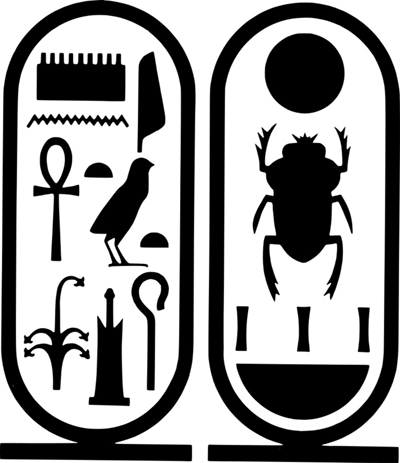
The cartouches associated with Tutankhamun.
Cartouche with hieroglyphic spelling of Tutankhamun's name with epithet, 'Tutankhamun, ruler of On of Upper Egypt (a name for Thebes)' and his throne name, 'Nebkheperura'
Photo and text: Mark Miller via Wikimedia Commons
Permission: Public Domain
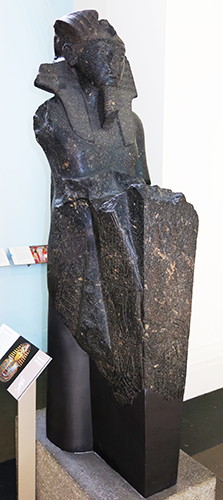
Eighteenth Dynasty: 1 550 BC - 1 292 BC
Tutankhamun
The king presents an abundance of offerings including lotus blossoms, bunches of grapes, pomegranates, and ducks hung by their feet. These are for 'his father Amun-Ra', the god in whose temple the statue was placed.
The facial features are Tutankhamun's, but the text on the back-pillar attributes the statue to Horemheb, who usurped it after taking the throne. He erased from every monument the memory of Tutankhamun and other rulers linked to the despised Armuna Period.
Circa 1 336 BC - 1 327 BC.
Catalog: Thebes, Karnak, temple of Amun-Ra, granodiorite, EA75
Photo: Don Hitchcock 2015
Source: Original, British Museum
Text: Card at the British Museum, © Trustees of the British Museum, CC BY-NC-SA 4.0
This is a granodiorite figure of Tutankhamun, wearing a royal 'nemes' headcloth, false beard, beaded broad collar, and elaborately pleated kilt, who steps forward to present a chest-high pillar that once tapered toward the statue base (now lost). The three exposed surfaces of the pillar are decorated with low raised relief depicting lotus blossoms, bunches of grapes, pomegranates, sheaves of grain, and clutches of bagged ducks hung by their feet. An adjoining fragment from the lower part of the statue preserves the umbels of papyrus plants that "grew" from the base on the proper left side of the sculpture. This may be a depiction of the pharaoh in the guise of the god Hapi, who embodied the Nile in flood. The back-pillar is inscribed.
Dimensions: Height 1677 mm, width 480 mm, depth 720 mm.
Inscription Translation:
There lives the perfect god [i.e., the king] who does what is beneficial for his father Amun-Re, the King of Upper and Lower Egypt Djeserkheperure-Setepenre, the son of Re Hor[emheb] beloved of Amun ...
One column of incised hieroglyphs. Both cartouches with Horemheb's name are original, and the rest of the inscription provides no evidence of usurpation, which has led Egyptologists to accept this sculpture as an original work of his reign. The text continues on another similar statue now in the Cairo Museum.
Curator's comments: Although the cartouches give Horemheb's name, the face does not exemplify Horemheb's physiognomy, nor the style peculiar to his reign. The features and the way they are rendered evoke Tutankhamun's portrait in sculptures that can now be assigned with confidence to the later years of his reign. This sculpture would seem, then, to have been made for Tutankhamun. Either the back pillar had remained uninscribed during Tutankhamun's lifetime and was thus free to receive Horemheb's text when he ascended the throne, or Horemheb's sculptors usurped it for their king by cutting down the surface to remove completely any trace of an original text naming Tutankhamun.
Text above: © http://www.britishmuseum.org/
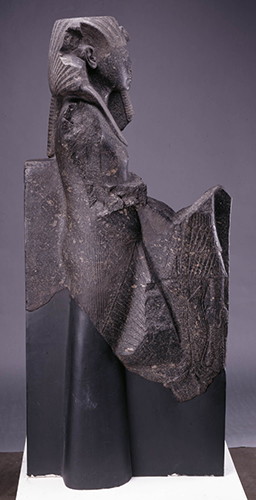
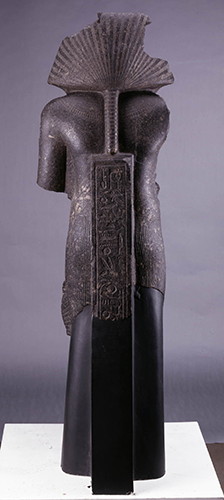
Eighteenth Dynasty: 1 550 BC - 1 292 BC
Tutankhamun
Views from the side and the back of the Tutankhamun statue.
Circa 1 336 BC - 1 327 BC.
( note in particular the great similarity between the treatment of the back of the head and hair/wig of this statue and the back of the famous gold mask of Tutankhamun, shown above - Don )
Catalog: Thebes, Karnak, temple of Amun-Ra, granodiorite, EA75
Photo: © Trustees of the British Museum, CC BY-NC-SA 4.0, http://www.britishmuseum.org/
Source: Original, British Museum
Text: Card at the British Museum, © Trustees of the British Museum, CC BY-NC-SA 4.0
Eighteenth Dynasty: 1 550 BC - 1 292 BC
Dagger of Tutankhamun
A dagger made of meteoric iron from the tomb of Pharaoh Tutankhamun.
An iron dagger was found in Tutankhamun's tomb. But iron smelting was unknown in Egypt 3 400 years ago.
The meteoric iron dagger was found on Tutankhamen's mummy. The handle is elaborately decorated with colored stones, rock crystal and gold.
Hundreds of artistic objects lay in the tomb of Pharaoh Tutankhamun. And for some time it has been known that among them was a dagger with a blade made of meteoric iron. A working group led by Takafumi Matsui and Tomoko Arai from the Chiba Institute of Technology has now found out what type of meteor the valuable addition was made of and where the gold-decorated weapon originally came from. As the researchers write in the journal "Meteoritics & Planetary Science", the dagger could have been a gift from an oriental ruler.
When Howard Carter discovered the tomb of the young pharaoh almost 100 years ago, he found no fewer than 5 400 grave goods: chariots, furniture, walking sticks, wooden figures and some very unusual objects made of iron. Since then, many researchers have been interested in the special finds, because when Tutankhamun ruled Egypt between 1 336 BC and 1 327 BC, the smelting of iron was still unknown there. In addition to some small-format iron tools with wooden handles, these pieces include a miniature headrest, an amulet and an elaborately crafted dagger.
Several working groups have now proven using X-ray fluorescence methods that the objects were made of meteoric iron. These included the archaeometrist Florian Ströbele and the metal restorers Christian Eckmann and Katja Broschat from the Roman-Germanic Central Museum in Mainz, who published their results in 2016 in the specialist journal 'Metalla' and in 2018 as a book.
The most important indication of an extraterrestrial origin of the iron is the nickel content in the metal. If this is more than four percent by weight, it is very likely to be meteoric iron and not smelted iron. According to Ströbele's analyses, Tutankhamun's dagger contains 12.7 to 13.1 percent by weight nickel. This suggests that the blade was forged from meteoric iron. The analyses by Matsui and Arai confirm the older results. Her team determined a nickel content of around 9.8 percent by weight. The researchers elicited even more information from the object, which was decorated with gold and rock crystal.
In order to determine meteoric iron beyond doubt, archaeometrists uncover the so-called Widmanstätten structure. This is a characteristic surface pattern that results from treating the meteor with nitric acid. However, the invasive procedure is not suitable for works of art. Matsui and his team solved the problem by using a special X-ray fluorescence camera to visualise the distribution of nickel on the dagger blade. When compared to other meteor surfaces, the pattern showed similarities to octahedrites. These are nickel-iron meteors. Because the Widmanstätten structure on the dagger blade is still largely intact, the researchers also assume that the metal was forged at a comparatively low temperature of around 950 degrees Celsius.
Matsui and Arai's team also examined the hilt of the stabbing weapon, which was decorated with precious stones. The decor had been glued in place. And as the chemical analyses showed, with a calcareous mass - the working group detected an unusually large amount of calcium in their measurements. Now it is known that this type of glue came into use in Egypt much later: only when Greek rulers from the late 4th century BC held power in the country on the Nile. From this, the research group concludes that the approximately 3 400-year-old dagger was not made in Egypt, but may have come to the Nile as a gift from a foreign ruler.
The so-called Amarna letters provide a clue. This refers to inscribed clay tablets that came to light in the residence of Pharaoh Akhenaten, who was later ostracised as a heretic. They concern the correspondence of the pharaohs with foreign rulers. One of the letters mentions an iron dagger with a scabbard of gold, which Tušratta, king of Mitanni - his empire then consisted of the region where northern Syria and northern Iraq are now - gave to Pharaoh Amenhotep III, Akhenaten's father. Experts know that in 14th century BC Anatolia and Mesopotamia calcareous glue was already being used. So the dagger from Tutankhamun's tomb could have been a gift from Tušratta.
The dagger, which is a little over 35 cm long, is not the only find of its kind from antiquity. The oldest known dagger made of meteoric iron comes from Anatolia and is around 4 300 years old. Its now completely rusted blade and golden handle were found in a Bronze Age grave in Alaca Höyük in Turkey.
Photo (top): © Christian Eckmann / RGZM / DPA / Picture Alliance (Detail)
Photo (bottom): Matsui et al. (2022)
Text: Karin Schlott, a classical archaeologist and editor at 'Spektrum der Wissenschaft', 'Spektrum.de' and 'Spektrum Geschichte'.
Source: https://www.spektrum.de
Additional material: Matsui et al. (2022)
Present location of the dagger: Egyptian Museum of Cairo
Eighteenth Dynasty: 1 550 BC - 1 292 BC
Dagger of Tutankhamun
Photograph of the gold hilt of the iron dagger (upper panel) and the associated gold sheath (lower panel).
Enlarged images of hatched areas of the gold hilt (b) and the gold sheath (c) of (a).
Analytical points of semiquantitative analyses are shown with red circles.
Photo: Matsui et al. (2022)
Source and text: Matsui et al. (2022)
Present location of the dagger: Egyptian Museum of Cairo
Detail of the golden embossed panels decorating a small wooden shrine (formerly containing figurines) in Tutankhamun's tomb.
Photo and text: von Zabern (1980)
Eighteenth Dynasty: 1 550 BC - 1 292 BC
Tutankhamen boomerang
When Tutankhamun's tomb was opened, Carter found many weapons such as bows, arrows, throw sticks and boomerangs in the Annex of the tomb.
The boomerang was used in ancient Egypt in all periods primarily to hunt fowl in the marshes. Scenes of tomb owners, about to hurl the weapon, were part of the artists' repertoire as early as the Old Kingdom (2 700 - 2 150 BC). A depiction of the king hunting is on the left side of the golden shrine. There, Tutankhamun stands in a papyrus skiff in the marshes, the boomerang in his right hand and captured birds in his left.
This faience boomerang bears the inscription of Tutankhamen, as well as images of the Wedjat eye, and a lotus bloom. This boomerang was not part of Tutankhamun's tomb effects, however, and is of unknown provenance.
Dimensions: 380 x 50 x 22 mm.
Catalog: Unknown provenance, faience, AD 19
Photo: Don Hitchcock 2014
Source and text: Original, Rijksmuseum van Oudheden, National Museum of Antiquities, Leiden, http://www.rmo.nl/
Additional text: http://www.touregypt.net/museum/boomerangpage.htm
Painted ivory plaque from the lid of a box showing Tutankhamun and his wife Ankhesenamun in a garden.
Photo: von Zabern (1980)
Eighteenth Dynasty: 1 550 BC - 1 292 BC
Cubit ruler
Cubit ruler of Maya, King Tutankhamun's Minister of Finance.
1 332 BC - 1 323 BC
This 52.3 cm cubit rule is divided into 28 'fingers' of 1.86 cm which are then split into halves (on the right) to give 9.3 mm and then down to 1/16 = 1.16 mm.
The early years of Maya's life and career are not well known. It is possible that Maya started his career during the reign of Amenhotep III.
Maya is well known from the reign of Tutankhamen however. As the Overseer of the treasuries, he was also an important official and was noted for restoring the burials of several earlier Pharaohs in the Royal Necropolis in the years following the deaths of Tutankhamun and Ay. It is possible that he personally left a hand written text in the tomb of Thutmose IV stating that he had been charged with the restoration of the burial of the king. Maya would have reported to the vizier of Lower Egypt, who was based in Memphis.
Maya collected taxes and performed other services for these pharaohs, including supervising the preparation of their tombs.
Maya contributed an Ushabti to the funerary furnishings for King Tutankhamen. He also presented the king with a figure of the King in the guise of the god Osiris. Both items were inscribed and recorded that Maya was the donor of the statues.
Maya is known to have lived until at least year 8 of Horemheb when an inscription mentions he was charged with tax collection for the entire country and organising offerings for the gods. He is also depicted in TT50, the tomb of a divine father of Amun named Neferhotep. Maya is depicted between King Horemheb and the viziers showing his close relation to the king.
Catalog: Sully, Salle 335, Vitrine 6: Poids et mesures, N 1538
Photo: Don Hitchcock 2018
Source and text: Louvre Museum, Paris, France
Additional text: Wikipedia
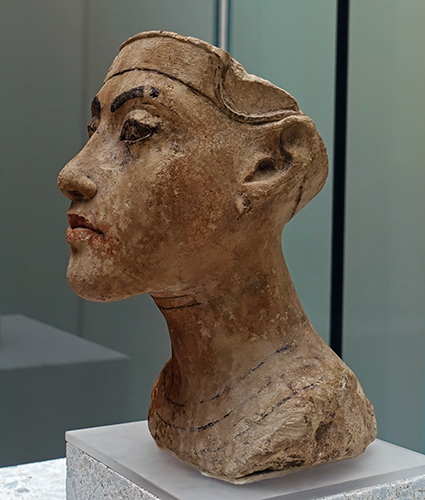
Eighteenth Dynasty: 1 550 BC - 1 292 BC
Bust of a king, circa 1335 BC.
Limestone, painted, 215 mm.
This limestone bust, much discussed in the literature, decorated with red and black paint, shows a king in his youth. The status is clearly visible on the royal headbands, while the temporal assignment (age) is ensured by the style of the object. However, it is uncertain as to its identity, since Semenchkare comes into consideration alongside the possibility of it also being either Akhenaten or Tutankhamun.
It is probably a bust of King Tutankhamen.
The neck collar is marked with three black, curved lines but lets red colouring show through in some places, suggesting that chain links were indicated. The short neck is marked near the chin by two folds, which are among the typical styles of the time. The soft, round face and the slight nasolabial folds indicate the youthfulness of the pharaoh. The physiognomy follows the tradition of the safely assigned portraits of Akhenaten, which points to one of his successors. The comparatively small and narrow eyes are framed by a still partially preserved ink stroke. The eyes were originally painted and not intended for inlays. The thick black eyebrows frame the upper part of the face of the king. Since there is no pin at the back of the bust, it is to be assumed that this portrait would be provided with a wig or a headscarf instead of a crown to reach the appropriate height. The house P 49.6, from which the object originates, is a sculptor's workshop.
Catalog: Limestone, painted, Amarna, P 49.06 (Sculptor's workshop), ÄM 20496
Photo: Don Hitchcock 2018
Source: Original, Staatliche Museen zu Berlin, Neues Museum, Germany
Text: © Card at the Staatliche Museen zu Berlin, http://www.smb-digital.de/ (CC BY-NC-SA 3.0 DE)

Eighteenth Dynasty: 1 550 BC - 1 292 BC
Old Man
Portrait head of an old man, from a group statue, circa 1 330 BC.
Catalog: Gabbro, Saft el-Henna, ÄS 6296
Photo: Don Hitchcock 2015, 2018
Source: Original, Ägyptischen Museum München
Text: © Ägyptischen Museum München
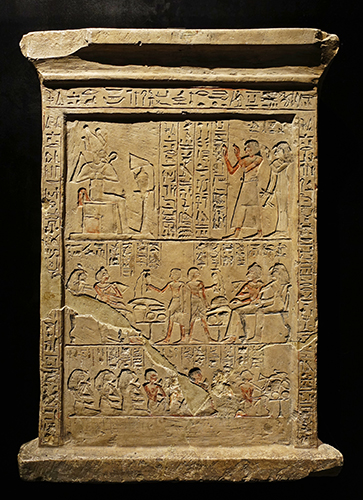
Eighteenth Dynasty: 1 550 BC - 1 292 BC
Pairi
Stela of Pairi, reused by Nefer, circa 1 300 BC.
( In the upper register, the deceased and his wife adore Osiris on the left, in the middle register is a scene at the burial feast, and in the lower register a scene apparently of servants preparing food - Don )
At the burial feast or banquet, the deceased sits at a table well stocked with food and floral offerings. The master presides over the meal with guests of relatives, friends and colleagues.
Catalog: Limestone, Antinoe Catacombs, ÄS 39
Photo: Don Hitchcock 2018
Source: Original, Ägyptischen Museum München
Text: Museum card, © Ägyptischen Museum München
Additional text adapted from www.osirisnet.net
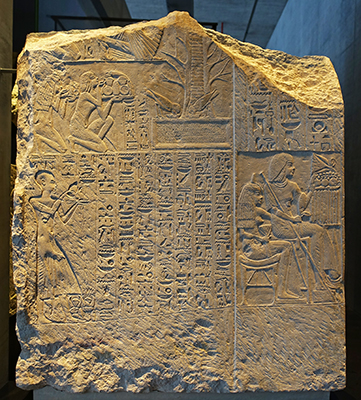
Eighteenth Dynasty: 1 550 BC - 1 292 BC
Tomb Relief
The deceased, Imeneminet, seated with his wife in the lower right register before an offering table, circa 1 320 BC.
( In the register at top left, the deceased and his wife kneel and offer gifts of food to the 'tree of life', at the foot of which are two Ba-birds feeding from bowls - Don )
Catalog: Limestone, Sakkara, grave of Imeneminet, Gl. 298
Photo: Don Hitchcock 2018
Source: Original, Ägyptischen Museum München
Text: © Ägyptischen Museum München

Eighteenth Dynasty: 1 550 BC - 1 292 BC
Tomb Relief
Tomb wall with relief on both sides, circa 1 330 - 1 300 BC.
Imeneminet was a goldsmith at Memphis. side A above: mourning people (8 men) in front of the funerary building with columns; below: Imeneminet standing, wearing a panther fur.
Height 940 mm.
Catalog: Painted limestone, possibly made in Memphis, found at Sakkara, grave of Imeneminet, Gl. 298
Bibliography: Sylvia Schoske, Dietrich Wildung, Das Münchner Buch der Ägyptischen Kunst, München 2013, 111-113, fig. 93
Photo: Don Hitchcock 2018
Source: Original, Ägyptischen Museum München
Text: © Ägyptischen Museum München
Additional text: Wikipedia
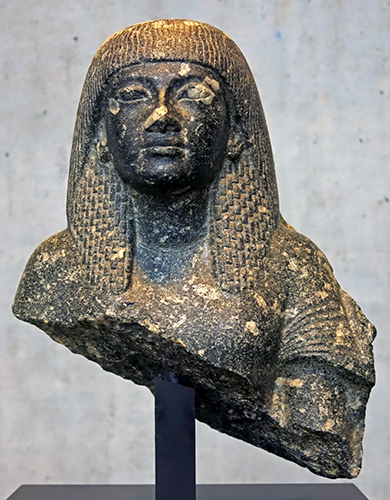
Eighteenth Dynasty: 1 550 BC - 1 292 BC
Head and Torso
Head and torso of a male figure, circa 1 320 BC.
Catalog: Quartzdiorite, Thebes, ÄS 5560
Photo: Don Hitchcock 2015, 2018
Source: Original, Ägyptischen Museum München
Text: © Ägyptischen Museum München
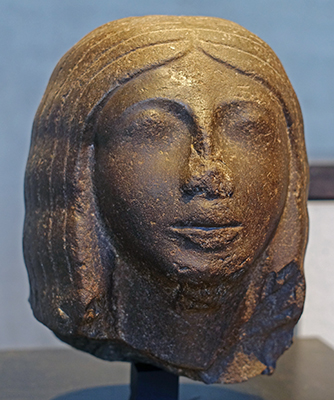
Eighteenth Dynasty: 1 550 BC - 1 292 BC
Young Man
Portrait head of a young man, circa 1 310 BC.
Catalog: Basalt, ÄS 7229
Photo: Don Hitchcock 2015, 2018
Source: Original, Ägyptischen Museum München
Text: © Ägyptischen Museum München
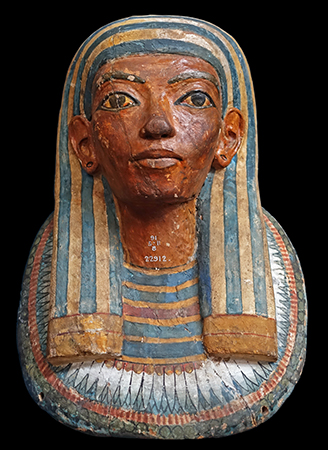
Eighteenth Dynasty: 1 550 BC - 1 292 BC
Mummy-mask
Painted wooden mummy-mask of an unidentified woman.
Late 18th Dynasty, circa 1 350 BC - 1 295 BC, from Thebes / Luxor.
The mask is made from the wood of the Sycomore fig. The outer rows of the collar are composed of lotus petals and fruits or berries. Perforations in the ear-lobes for the suspension of ear-rings have been carefully represented.
Height 410 mm, width 330 mm, diameter 215 mm.
Catalog: EA22912
Photo: Don Hitchcock 2018
Source: Original, British Museum
Text: http://www.britishmuseum.org/research/ and card at the Museum, © Trustees of the British Museum, CC BY-NC-SA 4.0
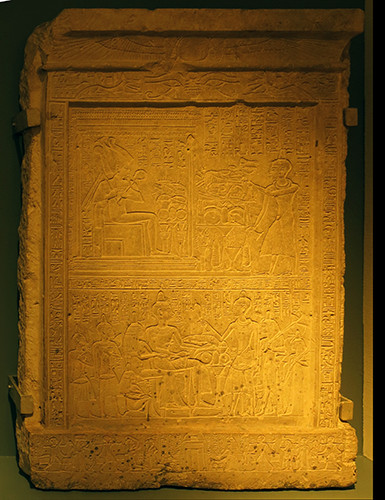
Eighteenth Dynasty: 1 550 BC - 1 292 BC
Stela of Ipoe
Tomb stela of Ipoe (Ipu), cupbearer to the king, 18th Dynasty.
Circa 1 333 BC - 1 323 BC, during the reign of Tutankhamun
Dimensions 129 x 85 x 21 cm, circa 450 kg.
Photo: Don Hitchcock 2014
Catalog: AP 9
Source and text: Original, Rijksmuseum van Oudheden, National Museum of Antiquities, Leiden.

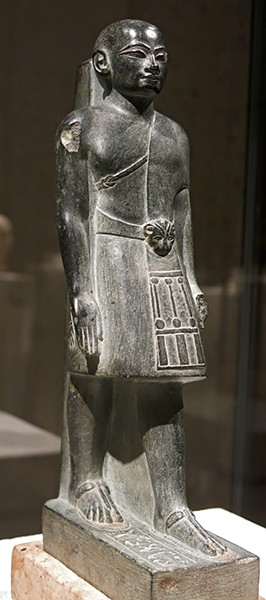
Eighteenth Dynasty: 1 550 BC - 1 292 BC
Taitai
Standing-striding figure of the priest and astronomer Taitai, or Tchaichi.
Circa 1323 BC -1319 BC
Tchaichi is wearing a short robe, as well as the priestly leopard fur, whose head rests on the front of the belt. Below is a pocket for an instrument, which identifies the wearer as an astronomer.
275 x 80 mm.
Catalog: Greywacke, Limestone, ÄM 17021
Photo: Don Hitchcock 2015, 2018
Source: Original, Staatliche Museen zu Berlin, Neues Museum, Germany
Text: © Card at the Staatliche Museen zu Berlin, (CC BY-NC-SA 3.0 DE)
Additional text: http://www.jenseits-des-horizonts.de/downloads/pressebilder/


Temple Wall panels from the private tomb of the Great Commander of the Army, Horemheb, showing him receiving 'gold of honour' collars.
Eighteenth Dynasty: 1 550 BC - 1 292 BC
Horemheb
Horemheb was the military force behind the throne in the aftermath of the Amarna Period. He was general in the army during the reigns of Tutanchamon and Aye, after this he himself became pharaoh and abandoned this tomb for a tomb in the Valley of the Kings.
Photo: Don Hitchcock 2014
Source: Original, Rijksmuseum van Oudheden, National Museum of Antiquities, Leiden
Text: adapted from http://ancientpeoples.tumblr.com/post/50495250530/saqqara-saqqara-is-the-most-important-cemetery
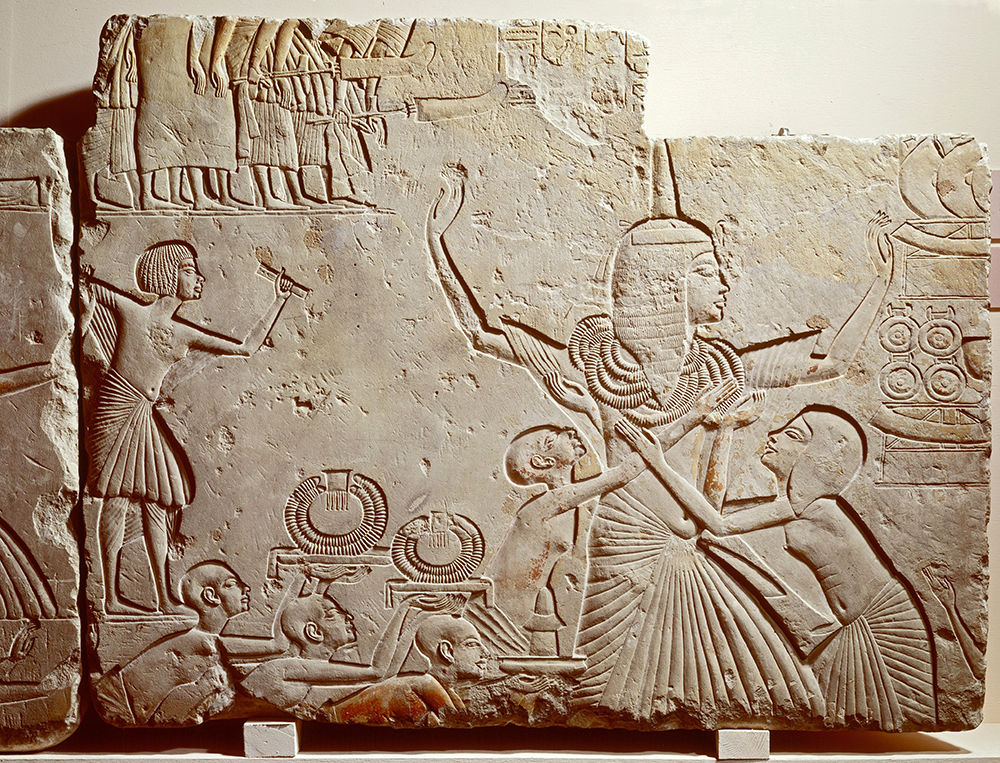
Close up of part of the panel above.
Dimensions: 860 x 1090 x 195 mm
Photo and text: Google Arts and Culture
Eighteenth Dynasty: 1 550 BC - 1 292 BC
Horemheb
Horemheb was the supreme commander of Tutankhamun's armies. Four years after the latter's death, he himself ascended to the throne as pharaoh. A magnificent tomb at Saqqara dates from his period as general. The National Museum of Antiquities owns two series of wall reliefs from the second courtyard of the grave complex. Here, Horemheb is being presented with gold gorgets in gratitude for his victories on the battlefield. On the left, Egyptian soldiers are bringing in some Asian captives. 1 333 BC - 1 319 BC. Size 860 x 1090 x 195 mm
Photo: Google Arts and Culture, https://www.google.com/culturalinstitute/beta/asset/horemheb-grave-relief/-gHrFrcniOR5Ow
Source: Original, Rijksmuseum van Oudheden, National Museum of Antiquities, Leiden
Text: Google Arts and Culture, https://www.google.com/culturalinstitute/beta/asset/horemheb-grave-relief/-gHrFrcniOR5Ow
Maya and HoremhebText above from a display at the Rijksmuseum van Oudheden, National Museum of Antiquities, Leiden.
At the time of the young pharaoh Tutankhamun the true power was in the hands of two experienced officers. Treasurer Maya looked after domestic administration, and General Horemheb regulated foreign policy.
Both top officials built tombs in the desert at Saqqara. These graves were found around 1825 by art collectors. Through the art market the reliefs of Horemheb and the tomb statues of Maya and his wife Meryt were taken to Leiden.
Since 1975 the National Museum of Antiquities conducted excavations in the necropolis of Saqqara. Both the tomb of Maya as well as that of Horemhab have now been recovered. Thus we now know much more about these treasures.
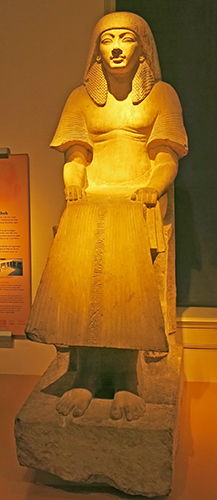
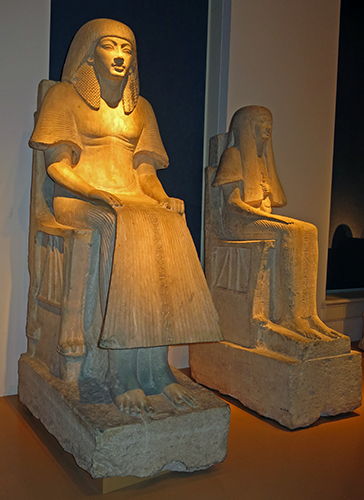
Eighteenth Dynasty: 1 550 BC - 1 292 BC
Maya
Maya was an important figure during the reign of the Pharaohs Tutankhamun, Ay and Horemheb of the eighteenth dynasty of Ancient Egypt. Maya's titles included: fan bearer on the King's right hand, overseer of the treasury, chief of the works in the necropolis, and leader of the festival of Amun in Karnak.
From: Sakkara circa 1 325 - 1 310 BC 18th Dynasty.
Photo: Don Hitchcock 2014
Source and text: Original, Rijksmuseum van Oudheden, National Museum of Antiquities, Leiden
Additional text: Wikipedia
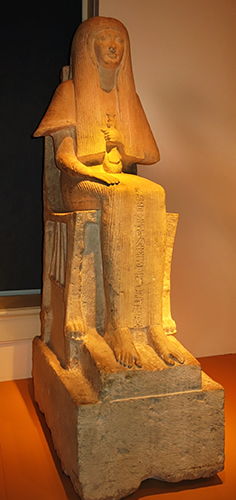
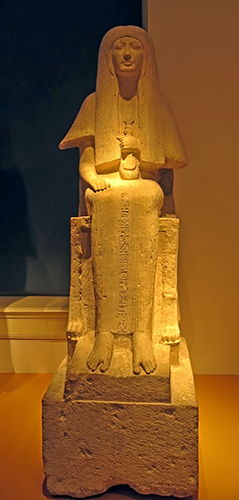
Eighteenth Dynasty: 1 550 BC - 1 292 BC
Meryt
Meryt, shown here, was the wife of Maya. Like many significant women she carries the title 'singer of Amun'. In her hands she holds a menat: a necklace of many strings of beads with the counterweight, a figure of the goddess Hathor, normally worn on the back, shown here in her hands. This might be used also as a rattle in the supervision of temple hymns.
From: Sakkara circa 1 325 - 1 310 BC 18th Dynasty.
Photo: Don Hitchcock 2014
Source and text: Original, Rijksmuseum van Oudheden, National Museum of Antiquities, Leiden
Additional text: Wikipedia
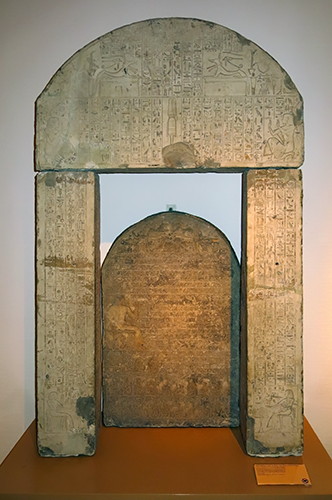
Eighteenth Dynasty: 1 550 BC - 1 292 BC
Door frame and stela of Hatiay
Hatiay was the supreme sculptor of the pharaoh. He built a chapel for himself at the shrine of Osiris at Abydos, during the period of Tutankhamun-Horemheb, at the end of the Eighteenth Dynasty.
This round door opening has beautifully carved figures and hieroglyphs, still showing remnants of gold leaf. The memorial stone would have been placed against the back wall of the chapel.
Dimensions: 1225 × 245 × 245 mm.
Catalog: limestone, Abydos, circa 1 330 - 1 320 BC, AP 14c
Photo: Don Hitchcock 2014
Source and text: Original, Rijksmuseum van Oudheden, National Museum of Antiquities, Leiden, http://www.rmo.nl/
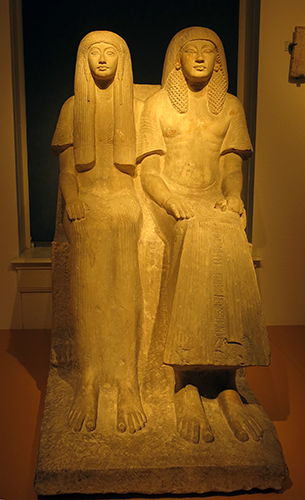
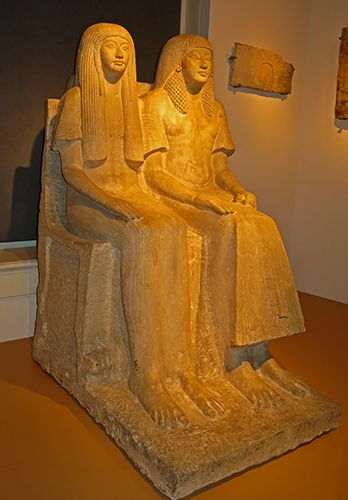
Eighteenth Dynasty: 1 550 BC - 1 292 BC
Maya and Meryt
This Tomb statue shows Maya and Meryt side by side. Meryt (on the left) embraces her husband. These images are among the best created by Egyptian artists. The three sculptures shown here are all from Maya's tomb, where they stood on pedestals beneath the galleries around the inner court.
From: Sakkara ca 1325 - 1310 BC 18th Dynasty.
Photo: Don Hitchcock 2014
Source and text: Original, Rijksmuseum van Oudheden, National Museum of Antiquities, Leiden
Additional text: Wikipedia

Eighteenth Dynasty: 1 550 BC - 1 292 BC
Meri-Ptah
Relief from the burial chamber of Meri-Ptah, from the necropolis of the New Kingdom of Saqqara
The tomb owner Meri-Ptah, high priest of Ptah in Memphis, appears as a sower; the large size of this figure corresponds to his rank.
The sower of grain, Meri-Ptah is depicted in a garment made of fine pleated linen. He attained the highest office of priesthood in Memphis.
In his job he is assisted by men arranged in two registers behind him. In the upper row is a man in a stooped posture, who holds out his bag of seed, and behind him is a group of servants who hoe the weeds. A bovine team with the words 'go, run' is driven to hurry. Two men, one of them with a writing utensil, advance.
The name of the tomb owner has been preserved on the upper text line as well as the beginning of a tomb saying: 'You go for a walk among them, you go with the Horus servants, you come out ...'.
Circa 1 300 BC.
Catalog: Limestone, Saqqara, inv. H 1046
Photo: Don Hitchcock 2015
Source and text: Original, Badisches Landesmuseum Karlsruhe Germany
Additional text: http://www.moin-monja.de/egypt/Museen/karlsruhe_museum/karlsruhe_museum-b/karlsruhe_museum-2.htm from the writings of Kurt Sethe, Egyptologist.
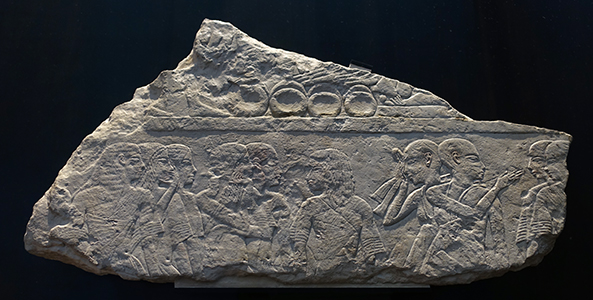
Eighteenth Dynasty: 1 550 BC - 1 292 BC
Funeral Procession
Tomb relief with funeral procession, circa 1 320 BC.
Catalog: Limestone, Sakkara, ÄS 7127
Photo: Don Hitchcock 2018
Source: Original, Ägyptischen Museum München
Text: © Ägyptischen Museum München
Eighteenth Dynasty: 1 550 BC - 1 292 BC
Maya
Maya was a high official of the provincial administration. He was appointed governor and chief of the priests by King Thutmose III whose name is on the chest and right upper arm, in the 10th Egyptian Region. There, in the necropolis of the capital, his grave was also found, from which this figure may originate.
Maya sits upright on a simple stool. The text lists the names and titles of Maya, as well as the sacrificial formulas addressed to the local gods. He is dressed in a short robe, which was originally worn only by kings, but later also by private people. In his clenched right hand he holds a so-called 'sweat cloth', while the left lies flat on the apron.
The round, expressive face is, like the whole figure, very formally constructed. A wig, corresponding to the fashion of the time, has been carefully placed over his head. The two gold chains around his neck, as well as the massive upper and lower gold arm bands, are awards which the king had given him for previous military successes.
Dimensions: 740 x 215 x 400 mm.
Catalog: Limestone, Achmim (?), ÄM 19286
Photo: Don Hitchcock 2015, 2018
Source: Original, Staatliche Museen zu Berlin, Neues Museum, Germany
Text: © Card at the Staatliche Museen zu Berlin (CC BY-NC-SA 3.0 DE)
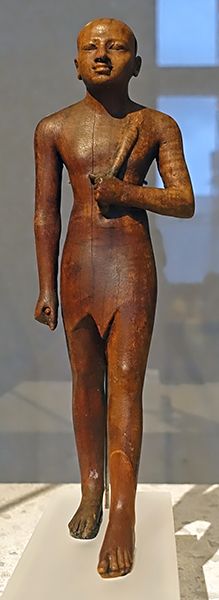
Eighteenth Dynasty: 1 550 BC - 1 292 BC
Figure with a flagellum
Figure of a military person holding the handle of a flagellum.
Amenhotep III / Amenophis III (?)
A flagellum was a flail or rattle to drive away evil spirits. It could only be used by a pharaoh and was a symbol of royal power.
Catalog: Wood, ÄM 14134
Photo: Don Hitchcock 2018
Source: Original, Staatliche Museen zu Berlin, Neues Museum, Germany
Text: © Card at the Staatliche Museen zu Berlin (CC BY-NC-SA 3.0 DE)
Additional text: http://www.touregypt.net/flagellum.htm
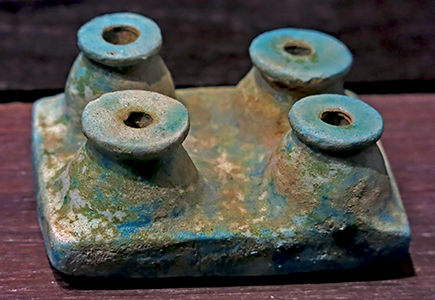
Eighteenth Dynasty: 1 550 BC - 1 292 BC
Inkpot
A faience inkpot with four inkwells. Circa 15th century BC.
Catalog: Faience, ÄS 7121
Photo: Don Hitchcock 2015
Source: Original, Ägyptischen Museum München
Text: Museum card, © Ägyptischen Museum München

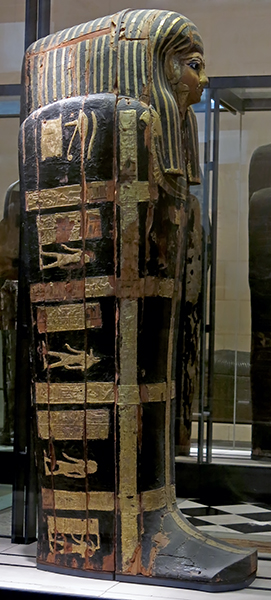
Eighteenth Dynasty: 1 550 BC - 1 292 BC
Mesra
Mummiform coffin, with shroud, tripartite wig, Usekh collar.
On the right side, the catalog lists, in order, the Eye of Wedjat, Imset (?), Anubis, the jackal/wolf headed god of the dead, Duamutef (with a man's head), and Thoth, the ibis headed god of the moon, writing and languages.
On the left side are listed the Eye of Wedjat, Hapi the god of the Nile, Anubis, the jackal/wolf headed god of the dead, Qebehsenuef (with a man's head), and Thoth, the ibis headed god of the moon, writing and languages.
( It is not clear whether the description of left and right above depends on how the observer sees the coffin, or whether it refers to the left and right sides of the individual portrayed - Don )
Length 1950 mm, width 750 mm, thickness 570 mm.
Catalog: Gilded, painted and stuccoed wood, Aile Sully, Room 321, the Sarcophagi, N 2573, Salt no. 3006, 894
Photo: Don Hitchcock 2015
Source and text: Original, Louvre Museum, Paris, France, https://collections.louvre.fr/

Eighteenth Dynasty: 1 550 BC - 1 292 BC
Mesra
Mummiform coffin, with shroud, tripartite wig, Usekh collar.
On the abdomen below the collar is a vulture with wings spread, holding a Shen ring in each claw.
According to style, the piece was created sometime during the reigns of Amenhotep II, Thutmose IV, or Amenhotep III. Thus, it is circa 1 425 BC - 1 350 BC.
Length 1950 mm, width 750 mm, thickness 570 mm.
Catalog: Gilded, painted and stuccoed wood, Aile Sully, Room 321, the Sarcophagi, N 2573, Salt no. 3006, 894
Photo: 4180 x 13095 pixels, Don Hitchcock 2015
Source and text: Original, Louvre Museum, Paris, France, https://collections.louvre.fr/


Eighteenth Dynasty: 1 550 BC - 1 292 BC
Senhetep
Mummiform coffin, with shroud, hidden hands, tripartite wig, Usekh collar, false beard.
Length 1990 mm, width 580 mm.
Catalog: Painted wood, Aile Sully, Room 321, the Sarcophagi, Vitrine 1, E 7724
Photo: Don Hitchcock 2015
Source and text: Original, Louvre Museum, Paris, France, https://collections.louvre.fr/
Eighteenth Dynasty: 1 550 BC - 1 292 BC
Senhetep
Mummiform coffin, with shroud, hidden hands, tripartite wig, Usekh collar, false beard, inlaid eyes.
On the chest, a vulture with spread wings holding two Shen rings, one in each claw.
Length 1990 mm, width 580 mm.
Catalog: Painted wood, Aile Sully, Room 321, the Sarcophagi, Vitrine 1, E 7724
Photo: Don Hitchcock 2015
Source and text: Original, Louvre Museum, Paris, France, https://collections.louvre.fr/
Eighteenth Dynasty: 1 550 BC - 1 292 BC
Vizier Pa-Ramessu
Head of a male figure, probably the Vizier Pa-Ramessu.
Pa-Ramessu was Vizier to Pharaoh Horemheb, the last king of the 18th Dynasty.
Granite, circa 1310 BC.
Catalog: Granite, ÄS 7924
Photo: Don Hitchcock 2015
Source: Original, Ägyptischen Museum München
Text: © Ägyptischen Museum München, Wikipedia
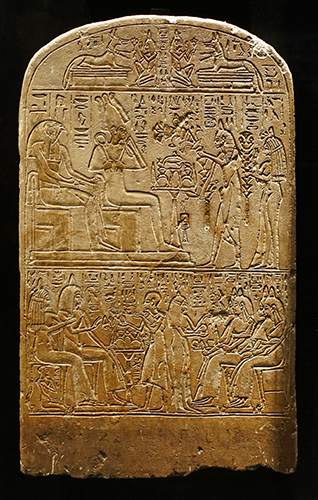
Eighteenth Dynasty: 1 550 BC - 1 292 BC
Ptahmay
Stela of the Chief of Police, Ptahmay, circa 1 300 BC.
( At the very top of the stela, two symmetrical representations of Anubis are shown, together with an adorant. In the top, main register, Ptahmay and his wife present gifts to Osiris and the falcon-headed Horus, the son of Osiris and Isis. In the lower register, servants present food to Ptahmay and his wife, and to members of Ptahmay's family. It is noteworthy that in this scene both men and women are wearing perfume cones on their heads, whereas often it is only women who wear them - Don )
( The role of police in Egyptian society developed slowly, and by the Middle Kingdom the Nubians known as Medjay performed this service. By the Eighteenth Dynasty, the Medjay were an elite paramilitary police force, but the term no longer referred to an ethnic group. Over time the new meaning became synonymous with policing in general. As an elite force, the Medjay were often used to protect valuable areas, especially areas of pharaonic interest like capital cities, royal cemeteries, and the borders of Egypt. Though they are best known for their protection of the royal palaces and tombs in Thebes and the surrounding areas, the Medjay were used throughout Upper and Lower Egypt. Each regional unit had its own captains. Chiefs of the Medjay are also known from the New Kingdom, but by then that title is more likely to refer to a person in charge of building and building material procurement - Don )
Catalog: Limestone, Memphis (?), ÄS 48
Photo: Don Hitchcock 2018
Source: Original, Ägyptischen Museum München
Text: Museum card, © Ägyptischen Museum München
Additional text: Wikipedia
Eighteenth Dynasty: 1 550 BC - 1 292 BC
Mummy of Katebet, circa 1 300 BC, during the reign of Pharaoh Horemheb.
The mummy of the woman Katebet was discovered in the 1820s in a tomb at Thebes, together with the mummy of a man named Qenna, possibly her husband.
Catalog: Thebes, EA6665
Photo: Don Hitchcock 2015, 2018
Source: Original, British Museum
Text: © http://www.britishmuseum.org/research/ and card at the Museum, © Trustees of the British Museum, CC BY-NC-SA 4.0

Eighteenth Dynasty: 1 550 BC - 1 292 BC
Katebet
Mummy of Katebet, circa 1 300 BC.
Her fine gilded cartonnage mask represents Katebet wearing wearing an elaborate wig with calcite ear-studs, a broad collar, bracelets and real finger-rings. Analysis of the surface decoration of the trappings has revealed almost pure gold leaf on the mask. The white metal of the pectorals is not silver, but pure tin. The shabti is of low-fired ceramic or clay, with applied gesso and gold leaf on the head, and copper foil on the torso. At the time of the discovery, the coffin also contained plaits of hair wrapped in linen, a pair of sandals and floral garlands, the last two items now lost.
Catalog: Thebes, EA6665
Photo: © Trustees of the British Museum, CC BY-NC-SA 4.0
Source: Original, British Museum
Text: © http://www.britishmuseum.org/research/ and card at the Museum, © Trustees of the British Museum, CC BY-NC-SA 4.0
Eighteenth Dynasty: 1 550 BC - 1 292 BC
Katebet
Mummy of Katebet, circa 1 300 BC.
The mummy of the woman Katebet was discovered in the 1820s in a tomb at Thebes (Luxor), together with the mummy of a man named Qenna, possibly her husband. Like Katebet's wooden coffin, the two pectorals and shabti figure placed on her mummy appear to have been designed for a man and adapted for her burial.
Catalog: Thebes, EA6665
Photo: Don Hitchcock 2015
Source: Original, British Museum
Text: © http://www.britishmuseum.org/research/ and card at the Museum, © Trustees of the British Museum, CC BY-NC-SA 4.0
Eighteenth Dynasty: 1 550 BC - 1 292 BC
Katebet
Mummy of Katebet, circa 1 300 BC.
Pectorals and a shabti were placed on the mummy.
Catalog: Thebes, EA6665
Photo: Don Hitchcock 2018
Source: Original, British Museum
Text: © http://www.britishmuseum.org/research/ and card at the Museum, © Trustees of the British Museum, CC BY-NC-SA 4.0
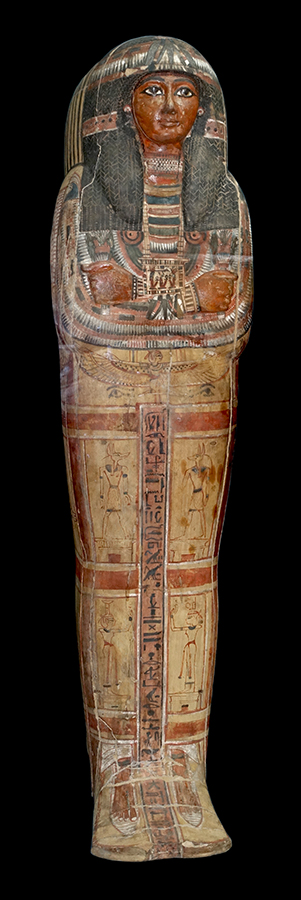
Eighteenth Dynasty: 1 550 BC - 1 292 BC
Coffin of Katebet
Painted wooden coffin of Katebet, circa 1 300 BC.
The upper part of the lid represents the deceased wearing an elaborate braided wig with a fillet of lotus petals, a rich floral collar and a pectoral suspended on a necklace. The coffin was originally designed for a man and was adapted for Katebet by overpainting the carved outline of the wig. The inscription, however, still contains masculine pronouns.
Catalog: Thebes, EA6665
Photo: Don Hitchcock 2018
Source: Original, British Museum
Text: © http://www.britishmuseum.org/research/ and card at the Museum, © Trustees of the British Museum, CC BY-NC-SA 4.0
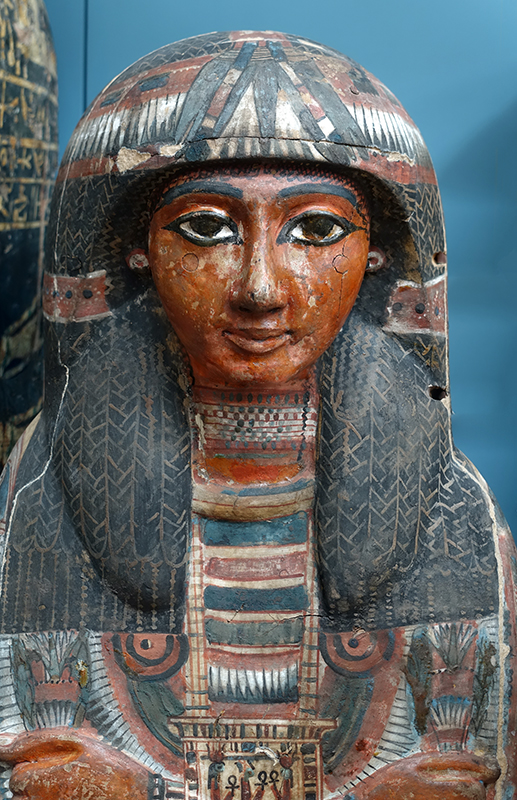
Eighteenth Dynasty: 1 550 BC - 1 292 BC
Coffin of Katebet
Close up of the painted wooden coffin of Katebet, circa 1 300 BC.
Catalog: Thebes, EA6665
Photo: Don Hitchcock 2018
Source: Original, British Museum
Text: © http://www.britishmuseum.org/research/ and card at the Museum, © Trustees of the British Museum, CC BY-NC-SA 4.0
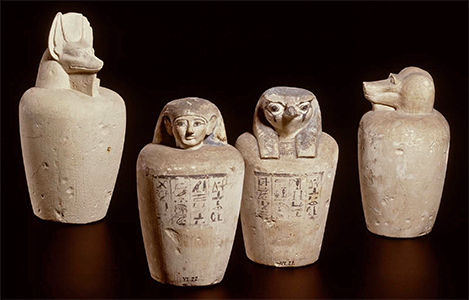
Eighteenth Dynasty: 1 550 BC - 1 292 BC
Panehsy
Canopic jars of Panehsy, 18th Dynasty, ca 1300 BC.
Material: limestone, 21 cm.
When someone someone was mummified lungs, liver, stomach and intestines were removed from the abdominal cavity. The bodies were mummified independently, and the organs placed separately in stoppered pots. These pots had lids that represent the four sons of Horus. They look after the mummified organs.
The liver went into a pot with a lid in the form of an Amset (man)
The stomach went into a pot with a lid in the form of a Duamutef (jackal)
The lungs went into a pot with a lid in the form of a Hapy (baboon)
The intestines went into a pot with a lid in the form of a Qebehsenuf (falcon)
Photo: http://www.rmo.nl/collectie/zoeken?object=AH+184-a
Text: http://www.dierenmuseum.nl/dierenliefde/dierenmummies-dierenbegraafplaatsen/
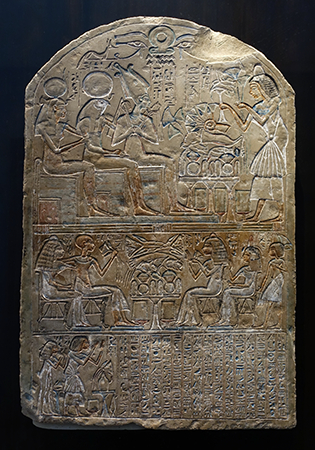
Eighteenth Dynasty: 1 550 BC - 1 292 BC
Nena
Stela of the Royal Archivist Nena, circa 1 300 BC
Catalog: Limestone, Memphis, ÄS 51
Photo: Don Hitchcock 2018
Source: Original, Ägyptischen Museum München
Text: © Ägyptischen Museum München
Eighteenth Dynasty: 1 550 BC - 1 292 BC
Canopic Chest
Painted Sycomore fig wooden Canopic Chest and four jars of Neby.
The shape of the box resembles that of a shrine, with a cornice and a sloping roof. It is mounted on sledge-runners, on which it could be drawn into the tomb during the funeral procession. On the sides are the protective figures of the Sons of Horus and the goddesses Isis, Nephthys, Neith, Selkis.
The four jars, also of wood, have stoppers in the form of human heads.
Height 635 mm (chest), height 65 mm (lid), mm, length 800 mm, width 630 mm, weight 3600 grams.
Catalog: Painted wooden Canopic Chest and four jars of Neby, Thebes, EA35808
Photo: Don Hitchcock 2015, 2018
Source: Original, British Museum
Text: Card with the display at the British Museum, https://www.britishmuseum.org/, © Trustees of the British Museum, CC BY-NC-SA 4.0
Eighteenth Dynasty: 1 550 BC - 1 292 BC
Cartouche shaped godet / mortar
The inks were ground in this mortar.
( there was no date ascribed to this piece, but it is very similar to the godet/mortar above - Don )
Length 135 mm, width 84 mm, height 22 mm.
Catalog: Basalt, traces of gilding, E 18544, MG 1035
Location: Aile Sully, Salle 335, Writing and the scribes, Vitrine 2
Photo (above): Don Hitchcock 2015
Photo (below): © Louvre Museum
Source and text: Original, Louvre Museum, https://collections.louvre.fr/
Eighteenth Dynasty: 1 550 BC - 1 292 BC
Pestles
These pestles were used to grind the inks in the mortars.
(left): E 21071: Labelled as a smoother of papyrus in the catalog, this Egyptian alabaster pestle has a height of 48 mm, and a diameter of 31 mm.
(right back): E 11503: Labelled as both a papyrus smoother and as a pestle in the catalog, this alabaster pestle has a height of 50 mm and a width of 31 mm.
(centre forward): AF 9558: Labelled as either a weight or a polisher or a measuring instrument in the catalog, this dark grey stone pestle has a height of 39 mm, a width of 21 mm, and width (sic) of 233 mm.
( It is possible that the measurements for AF 9558 are: height 39 mm, width bottom of 21 mm, and width top of circa 10 mm - Don )
Catalog: E 21071, E 11503, AF 9558
Location: Aile Sully, Salle 335, Writing and the scribes, Vitrine 2
Photo (above): Don Hitchcock 2015
Photo (below): © Louvre Museum
Source and text: Original, Louvre Museum, https://collections.louvre.fr/
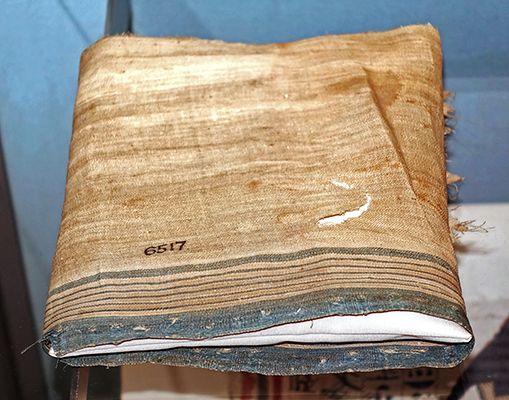
Eighteenth Dynasty: 1 550 BC - 1 292 BC
Linen mummy cloth with blue borders
Catalog: Provenance unknown, EA6517
Photo: Don Hitchcock 2018
Text: Card at museum display © Trustees of the British Museum, CC BY-NC-SA 4.0
Source: Original, British Museum
Eighteenth Dynasty: 1 550 BC - 1 292 BC
Rowers on a barque
Catalog: Limestone, el-Amarna/Hermupolis, Inv. no. 1972.17
Photo: Don Hitchcock 2018
Source and text: Original, Museum August Kestner, Hannover
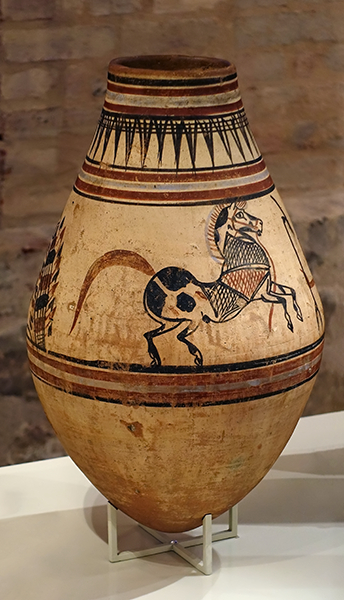
Eighteenth Dynasty: 1 550 BC - 1 292 BC
Large vessel
Large storage vessel, painted, illustrated with two galloping horses, Ankh sign and Was sceptre.
From the reigns of Thutmose II - Thutmose IV, i.e. 1 493 BC - 1 388 BC.
Dimensions: 420 x 260 mm
The two piebald horses are in motion as well as harnessed and bearing breast covers. Horses have only been known in Egypt since the second period (around 1 750 BC). They were brought in from Asia by the Hyksos with their chariots and from then on were indispensable for warfare. In addition, there are depictions of an Ankh sign holding two Was-scepters on the vessel, as well as a depiction of a plant bouquet.
Text above: J. Jancziak
Catalog: Provenance unknown, ceramic, painted, ÄM 14412
Photo: Don Hitchcock 2018
Source: Original, Staatliche Museen zu Berlin, Neues Museum, Germany
Text: © Card at the Staatliche Museen zu Berlin (CC BY-NC-SA 3.0 DE)
Eighteenth Dynasty: 1 550 BC - 1 292 BC
Headrest
Circa 1 390 BC - 1 295 BC
Folding wooden headrest. The base and shaft have been replaced by two legs in the form of ducks' heads and necks that are pierced by a pivot so that the piece could be folded shut for easy storage and transportation.
Household rituals were important: wealthy houses often had a small shrine to a god or ancestor. A household god like the fierce little Bes was particularly important at times of danger, such as during sleep or childbirth. Images of gods would protect the family, such as 'clay cobras' which one magical text says should be placed in each corner of every room in which there is a man or a woman.
In this example, faces of Bes adorn both ends of the curved support, literally cradling the sleeper's head with divine protection. He is depicted with fully frontal face. His features are characteristically lion-like and he has lions' ears, a mane and a tall plumed headdress. His face has thick eyebrows and two flesh folds running along his cheeks, and he sticks his tongue out cheekily.
The legs are riveted and where they cross at their ends duck heads grasp the bottom rails with their beaks. They were once extensively inlaid, but only two slivers of inlay survive.
Height 190 mm, width 194 mm.
Catalog: Akhmim, EA18156
Photo: (left) Don Hitchcock 2015
Photo: (right) © Trustees of the British Museum, CC BY-NC-SA 4.0
Source: Original, British Museum
Text: Card at museum display, http://www.britishmuseum.org/, © Trustees of the British Museum, CC BY-NC-SA 4.0
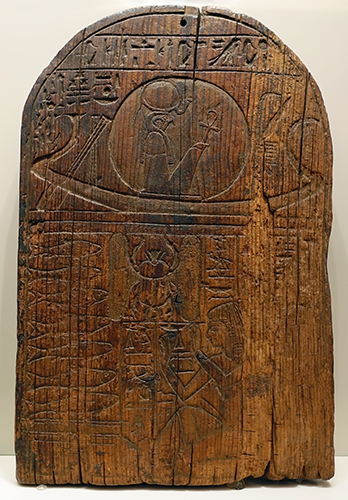

Eighteenth Dynasty: 1 550 BC - 1 292 BC
Unknown man
Stela of an unknown man in front of a sacrificial table with fish.
Dimensions: 385 x 262 x 35 mm.
The formerly painted wooden stele shows in the upper field the sun ship with the falcon-headed figure of Horus in the horizon in the large solar disc. In addition, the inscription: Re-Harachte, the great God, the Gracious , has been added later on the left: Amon-re, lord of the thrones of the two countries, ruling in Karnak, the great god, the beloved, presumably as a contemporary commitment to the restored Amon faith in Akhenaten, which would date the stele to the end of the eighteenth dynasty, a little earlier than most memorial stones with representations of the sun ship from the el-Medine.
Approximately in the middle of the stele area is shown as an illustration to the text below a large flying scarab. The praise of the donor kneeling on the right is not directed to Re as such, but to the variety of its manifestations, which in Egyptian are called cheperu, which is reproduced in the hieroglyphic script with the image of the sacred Beetle Cheper and is connected with its self-creation symbolism.
One of the royal tombs of the New Kingdom is often a litany of 75 such transmissions of the sun god. One of its most secretive figures is that of a Nilfish of the species Mormyros (Hyperopsius Bebe), which is reproduced on this stele on the left seven times over the entrance to a building.
Unfortunately, there is almost nothing left of the certainly equally extraordinary text on the back of the stele. The name of the owner can no longer be ascertained, but only his office is known: as a servant at the site of the truth he belonged to the artisans and artists guild working in the valley of the king's tombs.
Catalog: Wood, ÄM 818
Photo (left): Don Hitchcock 2018
Photo (right): Sandra Steiß, Ägyptisches Museum und Papyrussammlung, Staatliche Museen zu Berlin, (CC BY-NC-SA 3.0 DE)
Source: Original, Staatliche Museen zu Berlin, Neues Museum, Germany
Text: © Card at the Staatliche Museen zu Berlin, http://www.smb-digital.de/, (CC BY-NC-SA 3.0 DE)
Additional Text: W. Kaiser, Egyptian Museum Berlin at Charlottenburg Palace (Berlin 1967) p. 77, no. 807.

Eighteenth Dynasty: 1 550 BC - 1 292 BC
Amenemhat
Lower part of a seated figure of Amen-em-het, probably from Megeb near Qaw el-Kebir (Middle Egypt).
Circa 1450 BC
According to the inscriptions, the statue erected in the 'Temple of the Goddess Mut of Megeb' once showed the 'scribe of the king' and 'frond-bearer' Amen-em-het (i.e. 'Amun is at the head'), son of Qen-Atum.
Amenemhat was an ancient Egyptian High Priest of Amun at Karnak, during the reign of pharaoh Amenhotep II of the 18th Dynasty.
His titles included Scribe of the king, overseer of the site, frond-bearer and follower of his lord (i.e. the king) in his steps (i.e. war campaigns) in the southern foreign land, Amenemhet true to voice (i.e. justified/ready for the hereafter) whom Qen-Atum (begat).
The title of Frond Bearer to the Right of the King was a high title in the royal court of the ancient Egyptian New Kingdom.
A son of the wab-priest (lowest priestly rank) and 'Overseer of the sandal makers of Amun', Djehutyhotep, Amenemhat is attested by several funerary cones now exhibited at the University College, London and in the Metropolitan Museum of Art, New York; he also left an inscription outlining his career at Gebel el-Silsila.
He was probably buried in TT97 at Qurna, near Thebes.
Catalog: Breccia, place of discovery unknown (TT97 Qurna?)
Photo: Don Hitchcock 2018
Source and text: Original, Museum August Kestner, Hannover
Additional text: Wikipedia
Eighteenth Dynasty: 1 550 BC - 1 292 BC
Water Spout
Head from a lion-shaped water spout.
Circa 1 450 BC - 1 400 BC
Catalog: Limestone, Tell el Daba (?), ÄS 5348
Photo: Don Hitchcock 2015
Source: Original, Ägyptischen Museum München
Text: Museum card, © Ägyptischen Museum München

Eighteenth Dynasty: 1 550 BC - 1 292 BC
Djehuti-nefer
Stele of Djehuti-nefer in front of the god Amun-Re.
Dimensions: 443 mm x 325 mm x 87 mm.
This limestone stele from the Posno Collection was purchased in May 1883 by the Egyptian Museum and Papyrus Collection Berlin. It is divided into two picture fields, the upper one of which is the founder Djehuti-Nefer ('Thot is beautiful') in front of the gods Amun-von-Karnak, Mut-von-Ischeru (holy lake in the Karnak temple) and a smaller version of Amun -Re.
The lower area represents a series of gods that the viewer has to imagine behind the first protagonists. These are Ptah, the crocodile-headed, anthropomorphic Sobek, a ram-headed Amun and the representation of a human-headed Seth with horns influenced by the Near East. The object dates to the first third of the Egyptian New Kingdom and probably comes from the temple of Karnak.
Catalog: Karnak, Amun temple, Limestone, ÄM 8440
Photo: Don Hitchcock 2018
Source: Original, Staatliche Museen zu Berlin, Neues Museum, Germany
Text: © Card at the Staatliche Museen zu Berlin (CC BY-NC-SA 3.0 DE), http://www.smb-digital.de/ (A. Weber)
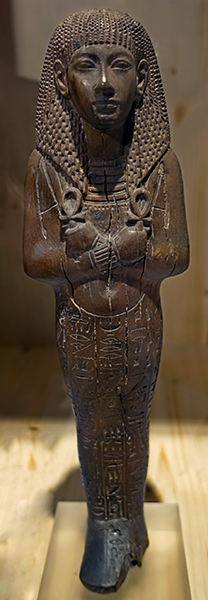
Eighteenth Dynasty: 1 550 BC - 1 292 BC
Ije
Shabti of lje, circa 1 350 BC
Catalog: Wood
Photo: Don Hitchcock 2018
Source and text: Original, Museum August Kestner, Hannover
Eighteenth Dynasty: 1 550 BC - 1 292 BC
Cooking pot with ladle and sieve.
Catalog: Ceramic and vegetable fibres, ÄM 13628, ÄM 22363, ÄM 32220
Eighteenth - Twentieth Dynasty: 1 550 BC - 1 077 BC
Models of grapes
Catalog: Deir el-Bahiri and Amarna, Faience, ÄM 23003, ÄM 30829, ÄM 30829, ÄM 30831, ÄM 30832
Photo: Don Hitchcock 2015
Source: Original, Staatliche Museen zu Berlin, Neues Museum, Germany
Text: © Card at the Staatliche Museen zu Berlin, (CC BY-NC-SA 3.0 DE)
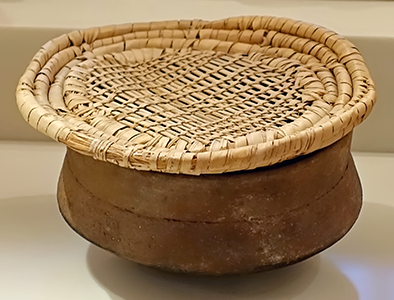
Eighteenth Dynasty: 1 550 BC - 1 292 BC
Cooking pot with ladle and sieve.
Closeup of the pot and seive above.
Catalog: Ceramic and vegetable fibres, ÄM 13628, ÄM 22363
Photo: Don Hitchcock 2018
Source: Original, Staatliche Museen zu Berlin, Neues Museum, Germany
Text: © Card at the Staatliche Museen zu Berlin, (CC BY-NC-SA 3.0 DE)
Eighteenth Dynasty: 1 550 BC - 1 292 BC
Ladle
Closeup of the ladle above.
Catalog: Ceramic ÄM 32220
Photo: Don Hitchcock 2018
Source: Original, Staatliche Museen zu Berlin, Neues Museum, Germany
Text: © Card at the Staatliche Museen zu Berlin, (CC BY-NC-SA 3.0 DE)
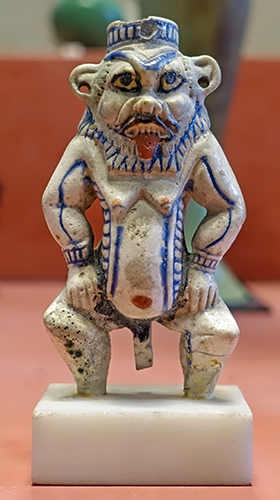
Eighteenth Dynasty: 1 550 BC - 1 292 BC
Bes
Kohl pot, in the form of the household god Bes.
Kohl is an ancient eye cosmetic, traditionally made by grinding stibnite (Sb2S3) for similar purposes to charcoal used in mascara. The multicoloured pigments on a white background are typical of this period.
Bes is portrayed standing, naked, hands on thighs, with a beard, tongue hanging out, pierced ears, and wearing bracelets.
Bes was responsible for such varied tasks as killing snakes, fighting off evil spirits, watching over children, and aiding women in labour by fighting off evil spirits, and thus present with Taweret at births.
Height 85 mm, width 49 mm
Catalog: Faience, Aile Sully, Room 334, Materials and Techniques, Vitrine 6, N 4469
Photo: Don Hitchcock 2018
Source and text: Original, Louvre Museum, Paris, France, https://collections.louvre.fr/
Additional text: Wikipedia
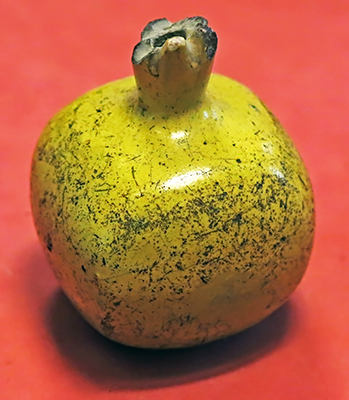
Eighteenth Dynasty: 1 550 BC - 1 292 BC
Pomegranate
Vase in the shape of a pomegranate, faience.
Lead antimonate, Naples yellow, Pb2Sb2O7 gives the yellow colour.
Height 65 mm, width 55 mm
Catalog: Faience, Early 18th Dynasty, Aile Sully, Room 334, Materials and Techniques, Vitrine 6, E 11651
Photo: Don Hitchcock 2018
Source and text: Original, Louvre Museum, Paris, France, https://collections.louvre.fr/
Additional text: Wikipedia
Eighteenth Dynasty: 1 550 BC - 1 292 BC
Neferrenpet
Neferrenpet presents a stele.
The southern part of the country has a lot of sandstone deposits. Freshly cut, it is white, and the Egyptians called it 'the beautiful white stone'. Most temples from the New Kingdom onwards were made from it.
Neferrenpet is shown kneeling, wearing his wig in 'pockets' (covered with cloth), he has a goatee beard and is wearing a kilt, and is presenting a stele.
His titles include Director of the Upper and Lower Egyptian Wine Place and Director of the Livestock of Amun.
Catalog: Thebes, Aile Sully, Room 334, Materials and Techniques, Vitrine 4, A 79, N 80, Salt n°3796
Photo: Don Hitchcock 2015, 2018
Source and text: Original, Louvre Museum, Paris, France, https://collections.louvre.fr/
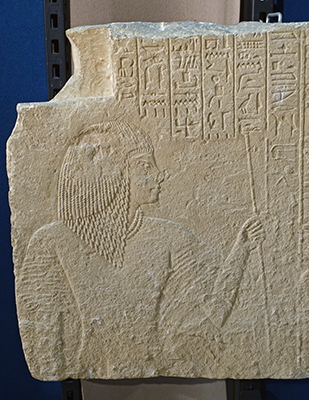
Eighteenth Dynasty: 1 550 BC - 1 292 BC
Grave doorway
Relief block with the grave owner, from the doorway to his grave.
Late 18th dynasty, circa 1 320 BC.
Catalog: Limestone, Saqqara (?), Inv. Nr. 1935.200.186
Photo: Don Hitchcock 2018
Source and text: Original, Museum August Kestner, Hannover
Eighteenth Dynasty: 1 550 BC - 1 292 BC
Four Courtiers
Four Courtiers, frond bearers.
Late 18th dynasty, circa 1 330 BC.
Catalog: Limestone, Saqqara (?), Inv. Nr. 1926.207
Photo: Don Hitchcock 2018
Source and text: Original, Museum August Kestner, Hannover
Eighteenth Dynasty: 1 550 BC - 1 292 BC
Papyrus of Nakht
Agriculture in the afterlife, from the papyrus of Nakht, circa 1 300 BC.
The ideal state of existence, which the dead achieved after becoming akh, included and agricultural paradise known as the Field of Reeds. Here the blessed dead would plant and reap abundant crops, traverse the waterways of the netherworld, and worship the gods.
From: Book of the Dead of Nakht, frame 13, flax-harvesting vignette, and sixteen columns of Hieroglyphic text.
Catalog: Thebes, EA10471/13
Photo: Don Hitchcock 2015
Source: Original, British Museum
Text: Card at the British Museum, http://www.britishmuseum.org/, © Trustees of the British Museum, CC BY-NC-SA 4.0

Eighteenth Dynasty: 1 550 BC - 1 292 BC
Antelope Deity
Squatting antelope / gazelle (?) headed deity. Late 18th Dynasty, circa 1 295 BC.
Perhaps from the tomb of Horemheb, no 57 in the Valley of the Kings.
This is one of several types of protective figures represented as if turning to confront a potential aggressor. The body of the figure is made from sycomore fig, and the two horns from the wood of the Christ's thorn (Ziziphus spina-christi), both native Egyptian timbers. Black varnish has been applied over a linen base layer.
Dimensions: Height 373 mm, width 400 mm.
The contorted pose of this creature, who sits with its lower half in profile and upper body turned toward the viewer, is eerily menacing, as if the monster were ponderously swinging around to confront an interloper. A divine wig has been used to mask the juncture between animal and human.
The antelope, who inhabited the wild lands of the desert, was considered a creature of chaos, dangerous to the living and enemies of the gods. In the Middle Kingdom, however, they were depicted on jewellery, magical implements, and even children's drinking cups, thus transforming their threat into protective power.
Catalog: Perhaps from the tomb of Horemheb, no 57 in the Valley of the Kings, or Biban el-Muluk (Valley of the Kings - Thebes): Tomb of Thutmose III, EA50703
Photo: Don Hitchcock 2018
Source: Original, British Museum
Text: Card at museum display, http://www.britishmuseum.org/, © Trustees of the British Museum, CC BY-NC-SA 4.0
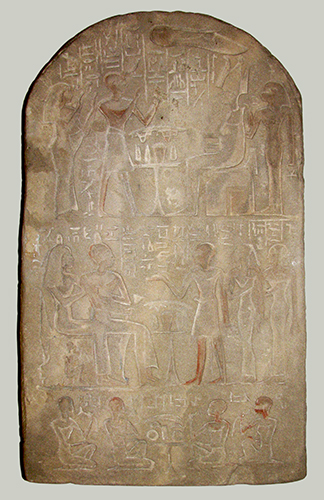
Eighteenth Dynasty: 1 550 BC - 1 292 BC
Iry-rekh and his wife Ta-Imentet
Limestone stela of 'Servant of Amun' Iry-rekh, and his wife Ta-Imentet, praying to Osiris and Imentet. The central panel shows their son Huy sacrificing to them.
Late 18th Dynasty, circa 1 300 BC.
Photo: Don Hitchcock 2014
Source and text: Original, Københavns (Copenhagen) Museum, National Museum of Denmark

Eighteenth Dynasty: 1 550 BC - 1 292 BC
Ram Headed Deity
Ram headed deity. Late 18th Dynasty, circa 1 295 BC.
Perhaps from the tomb of Horemheb, no 57 in the Valley of the Kings.
Depictions of similar figures on tomb walls and coffins indicate that this deity originally grasped knives, snakes or lizards in his outstretched hands. Black varnish, applied over a linen base, originally coated the entire figure. A pair of horns was originally attached to the top of the head.
Catalog: Perhaps from the tomb of Horemheb, no 57 in the Valley of the Kings, EA50702
Photo: Don Hitchcock 2018
Source: Original, British Museum
Text: Card at museum display, http://www.britishmuseum.org/, © Trustees of the British Museum, CC BY-NC-SA 4.0

Eighteenth Dynasty: 1 550 BC - 1 292 BC
Hippopotamus Headed Deity
Hippopotamus headed deity. Late 18th Dynasty, circa 1 295 BC.
Perhaps from the tomb of Horemheb, no 57 in the Valley of the Kings.
In depictions in tombs and on sarcophagi this figure is sometimes identified as Hememet, which associates her with the goddesses Isis, Nut, and Hathor as protectresses of the dead. The head and body are made from the wood of the sycomore fig. A variety of materials was used to make the teeth, including tamarisk, sycomore fig and probably ivory. A covering of linen was attached, over which black resin has been applied.
Catalog: Perhaps from the tomb of Horemheb, no 57 in the Valley of the Kings, EA50699
Photo: Don Hitchcock 2018
Source: Original, British Museum
Text: Card at museum display, http://www.britishmuseum.org/, © Trustees of the British Museum, CC BY-NC-SA 4.0
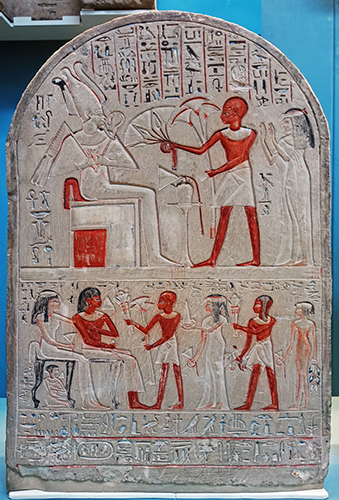
Eighteenth Dynasty: 1 550 BC - 1 292 BC
Stela
Round-topped limestone stela of Bakenamun / Bakkay with painted detail: upper register depicts deceased and wife offering to Osiris; lower register depicts couple receiving offerings from family-members.
Above, the deceased offers flowers to Osiris. Below, offerings are made to a couple named Huy and Henutnofret by four members of the family.
Height 508 mm, width 356 mm.
Catalog: Painted limestone, EA289
Photo: Don Hitchcock 2018
Source: Original, British Museum
Text: Card at museum display, http://www.britishmuseum.org/, © Trustees of the British Museum, CC BY-NC-SA 4.0
Statues
An important part of a well-equipped tomb was a statue representing the occupant. It was intended to act as a substitute for the physical body, in which the ka could reside to receive offerings.
Statues could be situated in the offering chapel, or in an adjacent sealed chamber (serdab). A single tomb might contain several statues of the owner, made in different materials, and in a variety of costumes and poses. In tombs without a chapel, the statue was often small in size and was placed in or near the coffin.
the statue was usually made of stone or wood, and ranged in scale from life size to very small examples, only a few centimetres high. Attitude and dress varied from period to period. The majority of tomb statues were idealised, generic images, and did not purport to convey a true likeness. The owner's name, inscribed on the seat or plinth, was sufficient to identify the figure. A few tomb statues, however, do appear to be likenesses of individuals.
Text above: Poster, © Trustees of the British Museum, CC BY-NC-SA 4.0
Stelophorous statuettes
Small statues representing the deceased supporting a small stela were placed in a niche in the pyramid superstructures of private tombs during the New Kingdom. The figure was oriented towards the rising sun, and the stela was usually inscribed with a prayer to the sun-god.
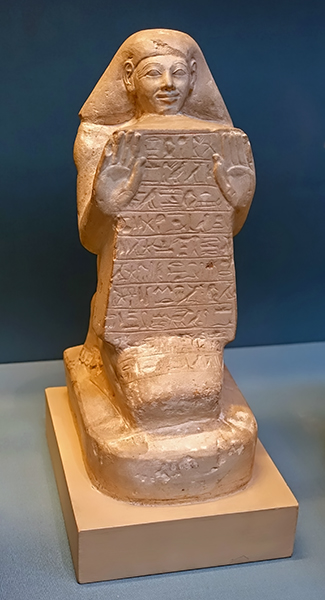
Eighteenth Dynasty: 1 550 BC - 1 292 BC
Nebiri
Stelophorous limestone figure of Nebiri, circa 1 450 BC.
The deceased is represented kneeling on a pedestal and holding before him a stela. He wears a long wig and a long skirt reaching to the ankles. The inscription is incised in ten horizontal lines, beginning on the stela and continuing on the skirt above the knees. Apart from minor abrasions, both stela and statuette are well preserved.
Inscription incised in ten lines of hieroglyphics on the front.
Height 250 mm, width 100 mm. length 125 mm.
Catalog: Limestone, Karnak, Thebes, EA48033
Photo: Don Hitchcock 2018
Source: Original, British Museum
Text: Card at museum display, http://www.britishmuseum.org/, © Trustees of the British Museum, CC BY-NC-SA 4.0

Eighteenth Dynasty: 1 550 BC - 1 292 BC
Necklace
Necklace of cylindrical gold beads alternating with groups of simple blue glazed composition beads. A series of cornflower pendants, also of gold, hangs down from the string of beads.
Length 368 mm.
Curator's comments: The cornflower bead is a typical element of New Kingdom necklaces.
Catalog: Gold and glazed composition (faience), EA65557
Photo: Don Hitchcock 2018
Source: Original, British Museum
Text: Card at museum display, http://www.britishmuseum.org/, © Trustees of the British Museum, CC BY-NC-SA 4.0
Eighteenth Dynasty: 1 550 BC - 1 292 BC
Necklace
Complex necklace, formed with two strings of beads. The upper one features gold and green glass beads, from which hang a series of gold drop-shaped pendants. The lower string bears cornelian, red jasper and blue glazed composition beads, from which hang cornflower-shaped pendants.
Length 330 mm (beads as restrung), width 50 mm, beads length 5 mm.
Circa 1 340 BC - 1 320 BC.
Catalog: Cornelian, glass, glazed composition (faience), gold, jasper, Biban el-Muluk (Valley of the Kings - Thebes), EA65617
Photo: Don Hitchcock 2018
Source: Original, British Museum
Text: Card at museum display, http://www.britishmuseum.org/, © Trustees of the British Museum, CC BY-NC-SA 4.0
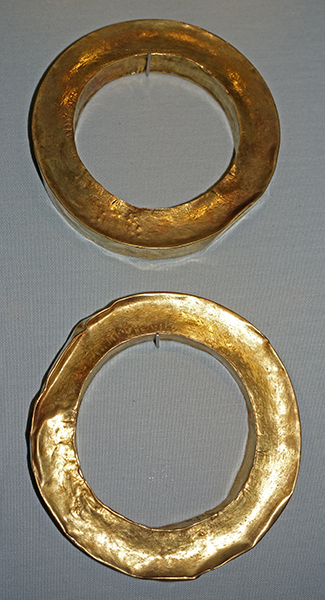
Eighteenth Dynasty: 1 550 BC - 1 292 BC
Gold Bangles
A pair of hollow gold bangles made of thin sheet gold beaten into shape on a wooden ring. The two ends were joined to form a three-sided hoop with an open internal face, onto which was soldered a thin sheet of gold strip. No further decoration or inscription has been added.
Diameter 119 mm (external), height 19 mm.
Catalog: Gold, EA66840, EA66841
Photo: Don Hitchcock 2018
Source: Original, British Museum
Text: Card at museum display, http://www.britishmuseum.org/, © Trustees of the British Museum, CC BY-NC-SA 4.0
Eighteenth Dynasty: 1 550 BC - 1 292 BC
Sennefer
Block statue of the priest Sennefer.
Circa 1 360 BC.
Sennefer took up his role as Mayor of the Southern City (Thebes) during the reign of Amenhotep II. His cousin, Amenemopet, was Vizier of Upper Egypt, which included Thebes. They both probably owed their position to Ahmose Humay, who actually managed to become overseer of the royal harem and tutor of princes, whilst Nub, his wife, was a lady of the court. These two cousins may have grown up together with the prince, who eventually became king Amenhotep II.
Sennefer's most important title was that of ' Mayor of the Southern City ', which during this period additionally included other cities, their ports and their surrounding lands. Even with this title, his position was subordinate to that of his cousin, who was the vizier and to whom he was responsible for the collection of the taxes of grain and other goods. He also held a great many other titles, found as usual embedded in the inscriptions which accompany the scenes of the walls, ceilings and pillars of both the upper and lower chambers. The list is quite extensive, some being more honorary than practical in nature; but such a long list was not unusual for high officials.
In his autobiography, found on the ceiling of the longitudinal corridor of the upper chambers, he describes himself in the following manner:
' The well-beloved courtier, great of the great ones, the noble dignitary among the courtiers and (of) the Lord of Upper and Lower Egypt, he says: ' I reached the state of venerable old age under the king, in that I was the confidant of the Lord of the Two Lands. The king knew of my excellence and he knew that I did useful things in the service in which he had placed me. He investigated everywhere, but could find nothing bad of me. I was praised because of this and my every need was catered for. He appointed me as chief administrator and Mayor of the Southern City, as overseer of the granary of Amun, overseer of the fields of Amun, as overseer of the gardens of Amun, high priest of Amun in the temple Men-isut (the mortuary temple of Ahmose-Nefertari) ', Mayor Sennefer, justified by the great god '.
( note the image of the goddess Hathor on the front of the block statue, recognisable from the cow ears used to identify her - Don )
Catalog: Granodiorite, ÄM 21595
Photo: Don Hitchcock 2015, 2018
Source: Original, Staatliche Museen zu Berlin, Neues Museum, Germany
Text: © Card at the Staatliche Museen zu Berlin, (CC BY-NC-SA 3.0 DE)
Additional text: http://www.osirisnet.net/tombes/nobles/sennefer/e_sennefer_01.htm
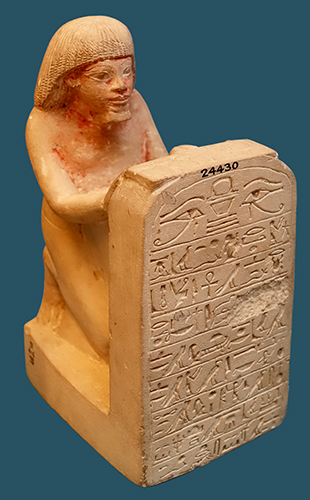
Eighteenth Dynasty: 1 550 BC - 1 292 BC
Limestone stelophorous statue
Limestone stelophorous statue of an unnamed man. The deceased is represented kneeling on a pedestal and holding before him a stela. He wears a long braided wig, a short beard and a long skirt reaching to the ankles. The top of the stela is shaped in the form of an offering-table, some of the offerings being carved on the top of the support connecting the stele with the figure.
In the arch are incised two 'wedjat' eyes flanking a shen ring, a cup and three lines of water. Below, incised in eight horizontal lines of Middle Egyptian, is a hymn to the sun-god (one of those now designated as Spell 15 of the funerary Book of the Dead). The name of the owner has been erased, but otherwise both figure and stela are well preserved. Traces of red paint still remain on the body.
Inscription translation: Praising Re when he rises, until it happens that he sets in life, by the cup-bearer [...], he says; 'Hail to you Re at your rising, Atum at your perfect setting. I shall give you adorations at your perfect setting. Exalted be Re in the Solar Day-barque, who rises in the eastern horizon, who sets in the west, who fells enemy.
Reign of Amenhotep III, 1 388 BC - 1 350 BC
Height 260 mm, width 115 mm. length 180 mm.
Catalog: Painted limestone, EA24430
Photo: Don Hitchcock 2018
Source: Original, British Museum
Text: Card at museum display, http://www.britishmuseum.org/, © Trustees of the British Museum, CC BY-NC-SA 4.0
Equipping the Tomb
Tomb architecture
In the Old Kingdom, tombs of high-ranking individuals possessed a rectangular stone or brick built superstructure (known to Egyptologists as a mastaba).
This often incorporated an offering chapel, with a shaft to the subterranean burial chamber. From the later Old Kingdom to the Middle Kingdom provincial officials were usually buried in rock-cut tombs, with chapels and burial chambers hewn from the cliffs facing the Nile or situated in nearby wadis.
In the New Kingdom, at Thebes, private tombs possessed small but elaborate superstructures which incorporated a small steep-sided pyramid with a niche containing a statuette or stela. The ownership of the tomb was proclaimed by means of rows of conical clay objects, known as funerary cones, the flat ends of which were stamped with the name and titles of the owner. These were inserted into the facade of the tomb-entrance forming a frieze above the door.
The Third Intermediate Period was characterised by the extensive reuse of earlier tombs. A revival of tomb construction took place during the Late Period. Examples include the shaft-tombs at Memphis and the tombs of high officials at Thebes, with brick superstructures and rock-cut burial apartments.

Reconstructed pyramid above a tomb at Deir el-Medina.
( Note the steep sided, small pyramidion on top of the pyramid - Don )
Photo: John Williams and Dudley Hubbard
Rephotography: Don Hitchcock 2018
Source: Poster at museum display, © Trustees of the British Museum, CC BY-NC-SA 4.0
Eighteenth Dynasty: 1 550 BC - 1 292 BC
Wooden shabtis of Khons, captain of the barque of Amun, with their shrine shaped box, late 18th Dynasty.
Box: Undecorated sycomore fig wood shabti-box; arched lid; knob on one side.
Dimensions: height 280 mm, width (base) 132 mm.
Shabti EA14425, left:
Painted and incised wooden shabti of Khonsu, Captain of The Barque of Amun with a striated lappet-wig, a white modelled face and crossed arms with white hands in relief; the front of the leg section is inscribed with part of Chapter 6 of The Book of The Dead in nine rows of incised Hieroglyphs.
Dimensions: Height 208 mm, width 66 mm, depth 39 mm.
Shabti EA14426, right:
Painted and incised wooden shabti of Khonsu, Captain of The Barque of Amun with a lappet-wig, a white modelled face, a traced collar and crossed arms with white hands in relief; the front of the leg section is inscribed with part of Chapter 6 of The Book of The Dead in seven rows of incised Hieroglyphs.
Dimensions: Height 204 mm, width 66 mm, depth 42 mm.
Catalog: Thebes, EA8523, EA14425, EA14426
Photo: Don Hitchcock 2018
Source: Original, British Museum
Text: Card at museum display, http://www.britishmuseum.org/, © Trustees of the British Museum, CC BY-NC-SA 4.0
Eighteenth Dynasty: 1 550 BC - 1 292 BC
Amenemopet
Block statue of Amenemopet / Amenemope
Circa 1 340 BC.
Block statue of Amenemopet Jmn-m-jpt, Overseer of necropolis-workers in Memphis, with text which mentions the Aten, Hathor, (Ptah-Sokari-) Osiris lord of Shetyt, etc., temp. Amenophis IV (early), in Berlin, Ägyptisches Museum, 31199 (formerly 4/65). (Probably from Memphis.)
Catalog: Limestone, ÄM 31199
Photo: Don Hitchcock 2015, 2018
Source: Original, Staatliche Museen zu Berlin, Neues Museum, Germany
Text: © Card at the Staatliche Museen zu Berlin, (CC BY-NC-SA 3.0 DE)
Additional text: http://www.griffith.ox.ac.uk/gri/3berlin.pdf
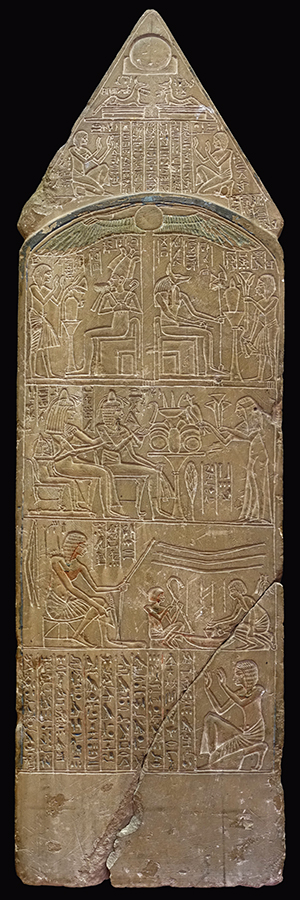
Eighteenth Dynasty: 1 550 BC - 1 292 BC
Arched pyramidion stele
Circa 1 327 BC - 1 292 BC.
In the arch, a winged sun disc. Above that, two men kneeling, worshipping. Two images of Anubis facing each other, lying on a plinth.
First register: worship scene, symmetrical. Man standing, worshipping, Osiris (left, seated), Anubis (right, seated)
Second register: funeral meal, woman standing holding a bouquet and a hes vase on the right, with a seated couple and a child on the left, these three with scented cones on their heads.
Third register: Making bows, three men seated.
Fourth register: A man worshipping, with text.
The text includes a hymn to Re, and the titles of Hor, a superior bow maker, Nayt, his wife, mistress of the house, Henoutoudjebou, a girl, Anubis, Re-Horakhty, and Osiris.
Height 1170 mm, width 360 mm.
Catalog: Limestone, painted, sunken bas-relief, Sully, Salle 334, level 0, Materials and techniques, Vitrine 9, N 5405, C 259
Photo: Don Hitchcock 2018
Source and text: Original, © 2008 Louvre Museum / Christian Décamps, collections.louvre.fr
Eighteenth Dynasty: 1 550 BC - 1 292 BC
Djehutyhotep
Cover of the sarcophagus of the chief steward Djehutyhotep, in the costume of the living. The depiction wears a skirt with puffed front, shirt with pleated sleeves, wig with lapels, pierced ears, Usekh necklace, bracelet, pectoral, crossed arms.
( Note that there was an Egyptian nomarch of the fifteenth nomos of Upper Egypt ('the Hare') with the name Djehutyhotep during the twelfth dynasty, circa 1 900 BC - Don )
Height 280 mm, width 340 mm, thickness 50 mm.
End of dynasty 18
Catalog: Diorite, N 339, D 3, Drovetti no. 399
Location: Room 321 - The sarcophagi
Photo: Don Hitchcock 2015
Source and text: Original, Louvre Museum, https://collections.louvre.fr/
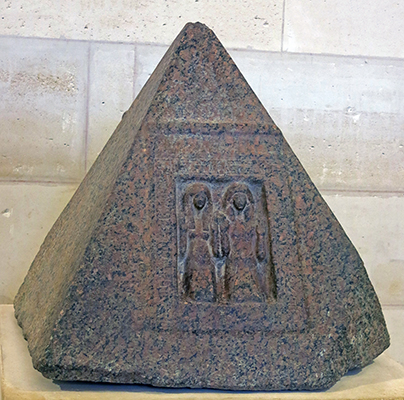
Eighteenth Dynasty: 1 550 BC - 1 292 BC
Pyramidion
Pyramid top (pyramidion) of the chief steward of Memphis, Iniouia
On the front and back face are adoration scenes. On each face are a man kneeling, wearing a skirt, a wig with lapel, adoring. Beside him, a woman, kneeling, wearing a dress, tripartite wig, adoring.
About 1300 BC, end of 18th dynasty
Height 630 mm, width 675 mm, thickness 700 mm.
Catalog: Saqqara Granite, Saqqara, Memphite necropolis, N 355, D 14
Location: Aile Sully, Salle 321, Les sarcophages, not in a vitrine
Photo: Don Hitchcock 2015
Source and text: Original, Louvre Museum, https://collections.louvre.fr/
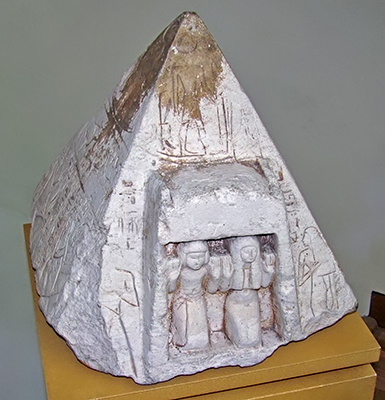
Eighteenth Dynasty: 1 550 BC - 1 292 BC
Ptah-mose
The pyramidion of the tomb of the 'Priest of the Apis' Ptah-mose, circa 1 340 BC - 1 290 BC.
During the New Kingdom, some private underground tombs were marked on the surface by small brick pyramids that terminated in pyramidia. The four lateral sides included texts and scenes related to the cult of the Sun God (as the representation of Pharaoh).
The scenes typically depict the course of the sun, rising on one lateral face, setting on the opposite face, and traveling, through the night, through the underworld, ruled by Osiris.
Photo: Don Hitchcock 2014
Catalog: Limestone
Source and text: Original, Københavns (Copenhagen) Museum, National Museum of Denmark
Additional text: Wikipedia
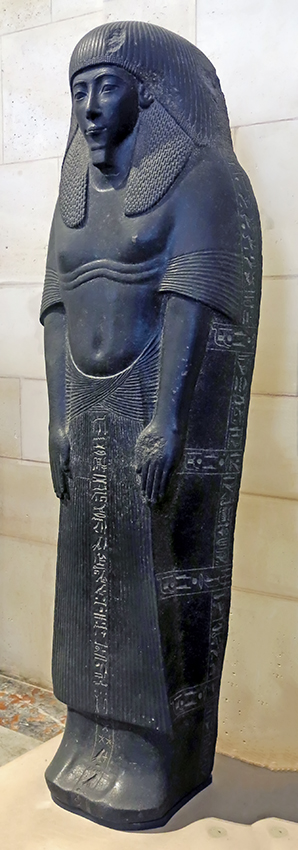
Eighteenth Dynasty: 1 550 BC - 1 292 BC
Iniouia
Sarcophagus of Iniouia, late 18th Dynasty, 1 336 BC - 1 292 BC
Decoration: Man in shirt with pleated sleeves, pleated skirt with a front and flap, wig with lapels, arms by his side, goatee beard.
Names and titles: Iniouia (royal scribe, chief steward at Memphis), Nut, Thoth, Anubis, Geb, Mut, Isis, the four sons of Horus.
Height 720 mm, length 2050 mm, width 650 mm.
Catalog: Saqqara Memphite necropolis, Tomb of Iniouia, D 2 N 338, LL 380
Location: Aile Sully, Salle 321, Les sarcophages, not in a vitrine
Photo (top): © Louvre Museum, https://collections.louvre.fr/
Photo (bottom and left): Don Hitchcock 2015
Source and text: Original, Louvre Museum, https://collections.louvre.fr/

Eighteenth Dynasty: 1 550 BC - 1 292 BC
Ahmes
Ahmes, 'Scribe of accounts of gold' and 'Overseer of the works of the god of Amun' kneels holding a stela with a prayer to the sun god Re.
Granite, circa 1 340 BC - 1 290 BC.
Photo: Don Hitchcock 2014
Source and text: Original, Københavns (Copenhagen) Museum, National Museum of Denmark

Eighteenth Dynasty: 1 550 BC - 1 292 BC
Neb-nefer
The Foreman Neb-nefer praying to the deceased King Amenophis I and his mother Queen Ahmose-Nefertari, circa 1 285 BC - 1 250 BC.
Catalog: Limestone, Deir el-Medina, Luxor
Photo: Don Hitchcock 2014
Source: Original, Københavns (Copenhagen) Museum, National Museum of Denmark
Eighteenth Dynasty: 1 550 BC - 1 292 BC
Finger-rings
Finger-rings from the late Eighteenth Dynasty.
(left) Chalcedony finger-ring with integral cartouche-shaped bezel. This is not inscribed, but incised with a decorative motif.
Diameter 20 mm (hoop), length 17 mm (bezel).
Catalog: Chalcedony, Fayum, Gurob, EA68915
(right) Cornelian finger-ring, with integral oval bezel bearing no further decoration.
Diameter 20 mm centimetres (hoop), length 18 mm (bezel).
Catalog: Cornelian, Fayum, Gurob, EA68916
Photo: Don Hitchcock 2018
Source: Original, British Museum
Text: © Card at the Museum, http://www.britishmuseum.org/research/ © Trustees of the British Museum, CC BY-NC-SA 4.0
Eighteenth Dynasty: 1 550 BC - 1 292 BC
Finger-ring
Finger-ring from the late Eighteenth Dynasty.
(far left) Chalcedony (?) integral finger-ring, bezel is carved to resemble a scarab, with clypeus, elytra and striated legs marked, the shoulders are elaborated with incised floral motifs.
Diameter 18 mm.
Catalog (far left): Chalcedony, Fayum, Gurob, EA68914
Catalog (centre and right): Fayum, Gurob, EA68915, EA68916 (as above)
Photo: Don Hitchcock 2015
Source: Original, British Museum
Text: © Card at the Museum, http://www.britishmuseum.org/research/ © Trustees of the British Museum, CC BY-NC-SA 4.0
© 2008 Louvre Museum / Christian Décamps
Eighteenth Dynasty: 1 550 BC - 1 292 BC
Arched stele with pyramidion
Circa 1 327 BC - 1 295 BC (late 18th dynasty)
The piece is in two glued fragments.
In hollow bas-relief:
On the first register is a worship scene (2, symmetrical) of a man standing, worshipping, with Osiris on the left, seated, with the dog- headed god Anubis on the right, seated.
On the second register is an illustration of a funeral meal, with a woman standing, holding a bouquet and a hes vase, in front, a seated couple and seated child.
On the third register is an illustration of bow making (3, seated), with a bow, a stick, an adze, and an element of char (?)
On the fourth register is a worship scene, showing a man kneeling, worshipping.
In the 'hanger' at the top is a winged solar disk with an uraeus.
At the top is a man (2, kneeling, worshipping, a horizon sign, and the god Anubis, shown as 2 dogs lying on a base.
The text is a hymn to Re.
The names and titles are Hor (a superior bow maker), Nayt (wife, mistress of the house), Henoutoudjebou (daughter), Anubis, D, Re-Horakhty, Osiris.
Height 1170 mm, width 360 mm.
Findplace: Serapeum, in the sand north of the Avenue of the Sphinxes.
Photo: Don Hitchcock 2015
Catalog: Limestone, Serapeum of Memphis, Room 334, Sully Wing, Level 0, Showcase 9, C 259; No. 5405; IM 3748
Source and text:
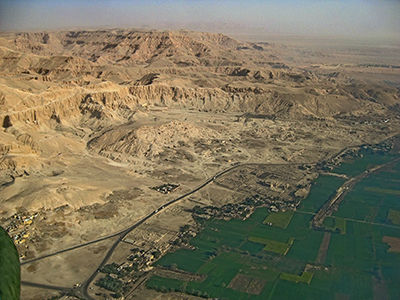
Eighteenth Dynasty or later: 1 550 BC - 1 069 BC
Theban Necropolis
The Theban necropolis was used in the New Kingdom, which lasted circa 1550 BC - 1069 BC.
Thebes (modern Luxor), a provincial centre in the Old Kingdom, produced families of rulers who reunified Egypt after the political decentralisation of the First and Second Intermediate Periods.
The city was a major royal residence on several occasions, and was the principal cult centre of Amun, the supreme deity of the Egyptian state. The cemeteries of Thebes / Luxor were used extensively from the 4th Dynasty to the Roman Period. They included the tombs of the kings of the 11th and 17th to 20th Dynasties, and those of administrators, craftsmen and priests of all periods.
Most of the private burials were in rock-cut sepulchres, those of the New Kingdom being renowned for the carved and painted wall-decoration of their funerary chapels. Although the majority of these tombs were robbed in antiquity, a substantial number of mummies, coffins and associated burial goods have been recovered from them since the early 19th century.
Photo: Steve F-E-Cameron
Permission: Multi-license with GFDL and Creative Commons CC-BY 3.0
Text: Poster, © Trustees of the British Museum, CC BY-NC-SA 4.0
Eighteenth - Twentieth Dynasty: 1 550 BC - 1 077 BC
Models of grapes
Closeup of the grapes above.
Catalog: Deir el-Bahiri and Amarna, Faience, ÄM 23003, ÄM 30829, ÄM 30829, ÄM 30831, ÄM 30832
Photo: Don Hitchcock 2018
Source: Original, Staatliche Museen zu Berlin, Neues Museum, Germany
Text: © Card at the Staatliche Museen zu Berlin, (CC BY-NC-SA 3.0 DE)
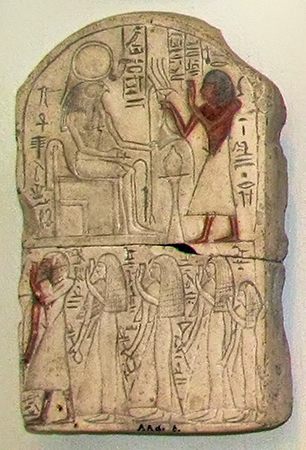
Eighteenth Dynasty: 1 550 BC - 1 292 BC
Nefer-renpet
Nefer-renpet burning incense for the sun god Re-Harakhte, circa 1 300 BC - 1 200 BC.
Photo: Don Hitchcock 2014
Catalog: Limestone, Deir el-Medina, Luxor
Source: Original, Københavns (Copenhagen) Museum, National Museum of Denmark
Eighteenth - Nineteenth Dynasty: 1 550 BC - 1 187 BC
Cosmetic jars
From the abundance of containers for ointments and makeup, mostly cut from alabaster, a smaller group of vessels stands out by virtue of its material and artistic design, of which the Kestner Museum possesses an almost complete one (left) and five fragments of another (right), absolutely unique example.
Steatite with honey coloured and green glazes.
Dimensions: (left) height 65 mm, width 41 mm, (right) height of the largest fragment 28 mm, diameter of lid 58 mm.
The most important features are the casing of the actual, cylindrical container with openwork carving and (only in the case of the jar on the left) the base in the form of a square table with struts between the top and the four legs - with the exception of the lid, the entire object is carved from the same block of steatite.
The dating of this group - hardly possible on the basis of stylistic features - is reliably derived from the fragments of the jar on the right.
The mantle below the shoulder of this green jar (with rosette or star) consists of an approximately 30 mm high frieze with heraldically ordered elements of royal symbolism. The centre of each is a cartouche with the throne and birth name of Thutmosis I (18th dynasty, c. 1500 BC) ( on the right of this photograph, including the image of a dung beetle - Don ). These are flanked and held by Horus falcons; and the falcons in turn 'lean' on the hieroglyphic group 'union-of-the-both-countries' (the so-called sema sign, associated with the heraldic plants of Upper and Lower Egypt). Exceptionally, a large part of the lid with the small plug used for closing the cylinder is also preserved. The vessel can only have come from royal property and probably belonged to the grave goods.
The cosmetic jar on the left was private property, and a round dance of animals and mythical creatures takes the place of the ruler's motto. The figure of Bes, a friendly demon in human form whom lovers will encounter several times, indicates that they were intended to lend the eye makeup (kohl, powdered antimony) kept in the vessel a love - magic effect.
Catalog: (left) Inv. Nr. 1935.200.722, (right) Inv. Nr. 1976.69
Photo: Don Hitchcock 2018
Source and text: Original, Museum August Kestner, Hannover
Additional text: Paper Catalogue, Museum August Kestner, Hannover
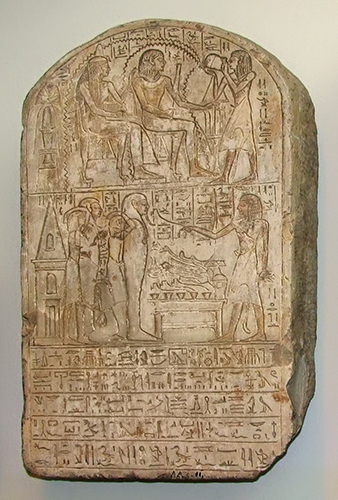
Eighteenth - Nineteenth Dynasty: 1 550 BC - 1 187 BC
Meri-Meri
Meri-Meri performs the opening of the mouth for his parents, 'Relief-cutter in the Valley of the Kings' Ken and Nefertari circa 1 290 BC - 1 224 BC.
Photo: Don Hitchcock 2014
Catalog: Limestone, Deir el-Medina, Luxor
Source: Original, Københavns (Copenhagen) Museum, National Museum of Denmark
Eighteenth - Nineteenth Dynasty: 1 550 BC - 1 187 BC
Head on a sarcophagus
The representation of the face of the deceased was worked separately and attached to the sarcophagus.
Catalog: Wood with painted stucco cover, H 380
Photo: Don Hitchcock 2015
Source and text: Badisches Landesmuseum Karlsruhe Germany

Eighteenth - Nineteenth Dynasty: 1 550 BC - 1 187 BC
Cosmetic spoon and makeup sticks
Alabaster cosmetic spoon, length with handle 138 mm, Inv. no. 1900.
The spoon has the shape of a mirror, the handle is modelled on a lotus flower with a wide open blossom. It is likely that makeup was applied to the surface.
Make-up sticks, rods and beads of Alabaster and coloured glass pastes, origin partly from el-Amarna.
Lengths from 28 mm to 58 mm.
The alabaster sticks were used to mix the makeup colour with oil and to apply it to eyelashes and brows. The glass rods, which are not pierced lengthwise, may have served the same purpose, perhaps also as inlays in boxes and jewellery.
Catalog: (cosmetic spoon) Alabaster, Inv. no. 1900, others Inv. no. 1919, 1928, 1929.368, 1929.569
Photo: Don Hitchcock 2018
Source and text: Original, Museum August Kestner, Hannover
Additional text: Paper Catalogue, Museum August Kestner, Hannover, Wallert (1967)
Eighteenth - Nineteenth Dynasty: 1 550 BC - 1 187 BC
Duck head
Duck head as jewellery element, origin unknown
Wood with ivory and glass paste inlays, length 95 mm.
The fractures do not allow us to be certain who this elegant and delicate duck's head belonged to. However, although the motif has been used since early dynastic times as a decoration, especially on toilet articles, the object certainly originates from the New Kingdom, which also had a special predilection for the duck in the area of erotic symbolism, without the reason for this being precisely comprehensible.
Catalog: Wood with ivory and glass paste inlays, origin unknown, on loan from John and Ralf Busch.
Photo: Don Hitchcock 2018
Source and text: Original, Museum August Kestner, Hannover
Additional text: Paper Catalogue, Museum August Kestner, Hannover.

Eighteenth - Nineteenth Dynasty: 1 550 BC - 1 187 BC
Tree Goddess and King
Relief depicting a tree goddess suckling the king.
Representations of a goddess suckling a king occur in Egyptian art
as early as the Old Kingdom, and they continue throughout
Egyptian history. They are concerned with an event which was
preserved in scenes as well as in statuary. These representations
seem to symbolise the nurturing relationship of mother and child.
Also, they might symbolise the ruler's rebirth in the Afterlife.
Catalog: Limestone, on loan
Photo: Don Hitchcock 2018
Source: Original, Ägyptischen Museum München
Text: Museum card, © Ägyptischen Museum München
Additional text: Bayoumi & El-din (2022)
Eighteenth - Nineteenth Dynasty: 1 550 BC - 1 187 BC
Headrest
Limestone, inscribed with a proper name.
15th - 13th century BC.
Catalog: Limestone, Deir el-Medina, ÄS 7192
Photo: Don Hitchcock 2015
Source: Original, Ägyptischen Museum München
Text: Museum card, © Ägyptischen Museum München
Eighteenth - Nineteenth Dynasty: 1 550 BC - 1 187 BC
Nun Bowl
Nun bowl with the Hathor cow and floral motifs.
In ancient Egyptian origin myths, dark blue (produced from copper compounds) and black (from manganese compounds) were colours of the primordial waters that the Egyptians called nun, or nonexistence. Faience bowls, popular in the New Kingdom, were often decorated with motifs that evoked marshland, recalling the waters of nun. The square in the centre of this bowl is a pond from which lotus buds and flowers grow. The lotus blossoms symbolise life emerging from the waters of nonexistence.
( Note the difference in colour between the body of the bowl and its outer layer. At first glance it would appear that a non-coloured matrix was used for the main body of the bowl, with a coating of blue coloured faience on that, and the design then painted in a black oxide. However it may have been a one step process, in marked contrast to the two step process of producing glazed clay based pottery, where the object is first fired at a relatively low temperature, (biscuit or bisque glazed), then glazed, then refired, often at a higher temperature. The manufacture of faience is discussed below - Don )
The Metropolitan Museum of Art seems to imply below that the whole piece is of one composition, but the colour is only formed on the surface, perhaps by oxidation:
Egyptian faience is a ceramic material with a siliceous body and a brightly coloured glaze. In addition to silica, faience also contains alkaline salts (the source of which was either natron or plant ash), minor amounts of lime, and a metallic colorant. Although faience was made in a range of bright colours, the turquoise blue colouriser reacts with the silica in the core to form a glaze on the surface.
Observed in cross-section, the microstructure of faience reveals at least two different layers of material: an inner core and an outer layer of glaze. The core is friable and porous, and is made up of particles that can vary in size from fine to coarse. These particles tend to be white but can be very pale blue, green, brown, or grey, depending on impurities contained in source materials. The bulk of this core material is made up of angular quartz grains without any visible clay particles, and always has the appearance of being artificially powdered. The quartz grains in the core are coated and held in place by small amounts of a soda-lime-silicate glass.
This interstitial glass appears colourless and transparent in cross-section, but in the glaze on the exterior surface one observes a very different optical effect: translucency. The crushed quartz core visible beneath the glaze creates an irregular white ground that scatters the light. The result is a diffuse, almost variegated appearance of depth that closely resembles the optical qualities of turquoise. The way light hits the interface between the core and the glaze gives an impression of brightness as well as translucency. Steatite, a soft, easily carved stone to which similar glazes were applied, is much smoother at this interface and does not scatter light in the same way faience does. This distinction might offer one explanation as to why faience, which is difficult to form, might have replaced glazed steatite as a preferred method for producing prized objects.
Wikipedia has this to say about the process:
The technology of glazing a siliceous body with a soda lime silica glaze employs various methods discovered over time: namely application, efflorescence and cementation glazing.Catalog: Faience, ÄS 6291
Application glazing
In the application method, formerly assumed to be the only one used for faience glazing, silica, lime and alkalis are ground in the raw state to a small particle size, then mixed with water to form a slurry which is then applied to the quartz core. Partial fritting of the slurry favours the first stages of vitrification, which in turn lowers the final firing temperature. The ( fritted? - Don ) slurry can be then applied to the body, through brushing or dipping, to create a fine, powdery coating. Upon firing, the water ( ? - Don ) from the melting glaze partially diffuses in the sand body, sintering the quartz particles and thus creating some solid bridges in the body.
Efflorescence glazing
In the self-glazing process of efflorescence, the glazing materials, in the form of water-soluble alkali salts, are mixed with the raw crushed quartz of the core of the object. As the water in the body evaporates, the salts migrate to the surface of the object to recrystallise, creating a thin surface, which glazes upon firing.
Cementation glazing
Cementation glazing, a technique discovered in the Middle Kingdom, is also a self-glazing technique. The possibility of the existence of cementation glazing, also known as the 'Qom technique', followed the observation of this method being used in the city of Qom in Iran in the 1960s. In this method the artefact, while buried in a glazing powder with a high flux content, is heated inside a vessel, causing the fusion of the object with the cement. During firing, the flux migrates to the quartz and combines with it to form a glassy coating.
Photo: Don Hitchcock 2015
Source: Original, Ägyptischen Museum München
Text: Museum card, © Ägyptischen Museum München
Additional text: metmuseum.org, Wikipedia
This pdf is a very good detailed resource on faience: https://uwe-repository.worktribe.com/OutputFile/875324
Eighteenth - Nineteenth Dynasty: 1 550 BC - 1 187 BC
Castanets
Two ivory castanets, origin unknown.
Castanets belong to the group of so-called ideophones (instruments whose entire sounding body is made to sound) and, as the many instances prove, were a frequently used instrument in Egypt to accompany dances, and also, as text passages seem to prove, for magical-religious purposes. Two such objects were connected at the upper end with a ribbon. Because of their different dimensions, however, these two specimens could not have belonged together.
Dimensions: 1935.200.104 (length 233 mm, width 29 mm) and 1935.200.105 (length 138 mm, width 34 mm)
Catalog: Ivory, Inv. No. 1935.200.104, 1935.200.105
Photo: Don Hitchcock 2018
Source and text: Original, Museum August Kestner, Hannover
Additional text: Paper Catalogue, Museum August Kestner, Hannover.
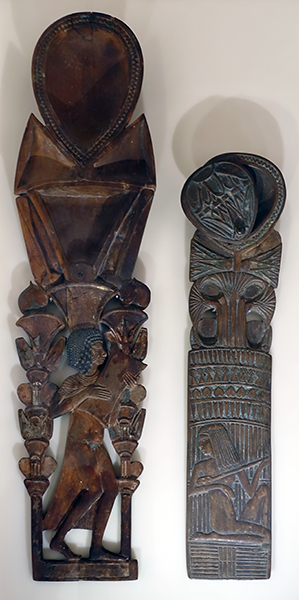
Eighteenth - Nineteenth Dynasty: 1 550 BC - 1 187 BC
Ointment spoons
Drum player and lute player.
Catalog: Wood, Drum player from Memphis (?), Lute player from Medinet Gurob, ÄM 1877, ÄM 17337
Photo: Don Hitchcock 2015
Source: Original, Staatliche Museen zu Berlin, Neues Museum, Germany
Text: © Card at the Staatliche Museen zu Berlin (CC BY-NC-SA 3.0 DE)
Eighteenth - Nineteenth Dynasty: 1 550 BC - 1 187 BC
Shabti of Pataouy
Painted quartzite funerary servant of the scribe Pataouy
Catalog: Painted quartzite, red-black, Room 334, Materials and Techniques, vitrine 4, N 2957, Durand n°21
Photo: Don Hitchcock 2015, 2018
Source and text: Original, Louvre Museum, Paris, France, https://collections.louvre.fr/
Eighteenth - Nineteenth Dynasty: 1 550 BC - 1 187 BC
Riy and his wife Maya in front of an offering table with priests.
Relief blocks from the wall of the grave of Riy in the necropolis of Saqqara: depicting the lord and his wife at the dining table receiving sacrifices, circa 1 320 BC - 1 290 BC
Dimensions: 967 x 1680 x 100 mm
Catalog: Painted limestone, ÄM 7278
Photo: Don Hitchcock 2018
Source: Original, Staatliche Museen zu Berlin, Neues Museum, Germany
Text: © Card at the Staatliche Museen zu Berlin, http://www.smb-digital.de/ (CC BY-NC-SA 3.0 DE)
c
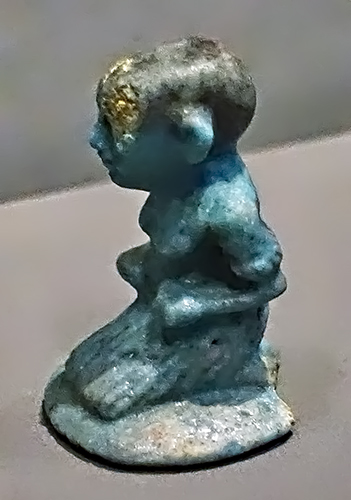
Eighteenth - Nineteenth Dynasty: 1 550 BC - 1 187 BC
Prisoner
Game playing piece in the form of a prisoner.
Catalog: Faience, ÄS 5584
Photo: Don Hitchcock 2018
Source: Original, Ägyptischen Museum München
Text: © Ägyptischen Museum München
Eighteenth - Nineteenth Dynasty: 1 550 BC - 1 187 BC
Game-Board
Ivory game-board/box for senet, circa 1 400 BC - 1 200 BC. This rectangular games box is formed from a hollowed out block of wood, which has been fitted with a drawer (its back wall restored), with a wooden floor and decorative walls, to contain the gaming pieces. A bolt on the front of the drawer, held by two copper rings, can be passed through an identical ring at either side of the box's front in order to hold the drawer closed.
The back of the box has also been restored, but its long walls and its top surface have been faced with a decorative material, the latter divided by ridges into thirty hollow squares arranged in three columns of ten. The underside of the box is of plain wood marked in ink with a system of twenty squares; twelve in a single central column, flanked at each side from squares nine to twelve by four squares. Only the two corner squares, and a long plain section at one side of the central column (level with squares one to eight), are still faced with this decorative material.
Height 45 mm, width 280 mm.
Curator's comments: A number of gaming boards and boxes with the same disposition of squares are known, but may have been used for senet, or 'twenty' or 'twenty squares'.
Catalog: Wood, ivory (?), copper, EA66669
Photo: Don Hitchcock 2018
Source: Original, British Museum
Text: © Card at the Museum, http://www.britishmuseum.org/research/ © Trustees of the British Museum, CC BY-NC-SA 4.0
Eighteenth - Nineteenth Dynasty: 1 550 BC - 1 187 BC
Game-Board Pieces
Conical blue glazed composition game-piece with nodular top.
Height 23 mm, width 15 mm, depth 15 mm, weight 4 grams.
Curator's comments: This shape of gaming piece is one of two shapes associated with the game senet, as it is featured in depictions in tomb paintings, and found with senet gaming-boards.
Catalog: Glazed composition, EA6411
Spool-shaped glazed composition game-piece, with bands of light- and dark-blue glaze.
Height 15 mm, width 20 mm, depth 20 mm, weight 2 grams.
Curator's comments: This shape of gaming piece is one of two shapes associated with the game senet, as it is featured in depictions in tomb paintings, and found with senet gaming-boards.
Catalog: Glazed composition, EA35922
Ivory gaming-piece, an artificial copy of the knuckle bone (or astragal, a small bone found within hooved animals) used to determine a player's move in a game such as senet. Length 32 mm.
Catalog: Ivory, Thebes, EA21605
Wooden game-stick, of long and rectangular shape, but semi-circular in section. The main body is carved with a series of incised lines (both parallel and criss-cross motifs). Both ends are carved in the form of a dog's head. Length 226 mm, width 15 mm.
Curator's comments: Throwsticks were used in sets of four or more, and depending on how they fell (with rounded or flat surface uppermost), could dictate player's moves in a game. This shape of gaming piece is one of two shapes associated with the game senet, as it is featured in depictions in tomb paintings, and found with senet gaming-boards. They are a feature of elite burial assemblages of the New Kingdom, but also earlier periods.
Catalog: Wood, EA26686
Wooden game-stick of long rectangular form, semi-circular in section. The surface is divided into three parts by a groups of three parallel incised lines, the space in between then criss-crossed with diagonal lines. The end is carved to intimate a duck's head (?), with inlaid ivory eyes. Length 218 mm, width 18 mm.
Curator's comments: Throwsticks were used in sets of four or more, and depending on how they fell (with rounded or flat surface uppermost), could dictate player's moves in a game. This shape of gaming piece is one of two shapes associated with the game senet, as it is featured in depictions in tomb paintings, and found with senet gaming-boards. They are a feature of elite burial assemblages of the New Kingdom, but also earlier periods.
Catalog: Wood, ivory (?), EA20935
Photo: Don Hitchcock 2018
Source: Original, British Museum
Text: © Card at the Museum, http://www.britishmuseum.org/research/ © Trustees of the British Museum, CC BY-NC-SA 4.0

New Kingdom: 18th - 20th Dynasty, 1 550 BC - 1 077 BC
Amun
Standing, chendjit loincloth, Amon Crown.
As the chief deity of the Egyptian Empire, Amun-Ra also came to be worshipped outside Egypt, according to the testimony of ancient Greek historiographers in Libya and Nubia. As Zeus Ammon, he came to be identified with Zeus in Greece.
Height 148 mm.
Catalog: Soapstone, Aile Sully, salle 336, Le Nil, Vitrine 7, N 4404
Photo: Don Hitchcock 2015
Source and text: Original, Louvre Museum, Paris, France, https://collections.louvre.fr/
Additional text: Wikipedia
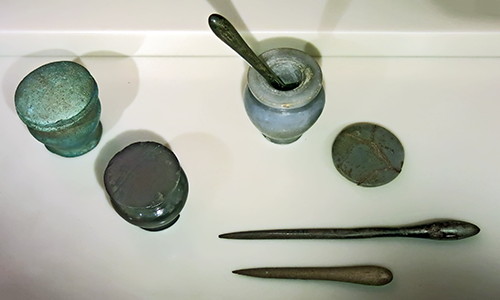
New Kingdom: 18th - 20th Dynasty, 1 550 BC - 1 077 BC
Vessels for eye make-up (kohl)
(Two lidded jars on the left)
Catalog: Saqqara, Thebes, Abydos; Wood, Malachite, Serpentine, Cane, Anydrite (Gypsum), Faience, ÄM 1324, ÄM 3408, ÄM 6772, ÄM 10817, ÄM 12780, ÄM 16142, ÄM 20574.
Middle - New Kingdom: 11th - 20th Dynasty, 2 025 BC - 1 077 BC
Ointment spoons and cosmetic sticks
(on the right, an opened jar with lid, and three spoons/cosmetic sticks)
Catalog: ÄM 4699/4, ÄM 6761, ÄM 12760, ÄM 35431, Z 4402, Z 4404.
Photo: Don Hitchcock 2015
Source: Display, Staatliche Museen zu Berlin, Neues Museum, Germany
Text: © Card at the Staatliche Museen zu Berlin (CC BY-NC-SA 3.0 DE)
New Kingdom: 18th - 20th Dynasty, 1 550 BC - 1 077 BC
Prisoner
Tied up prisoner.
Length 84 mm, height 18 mm, width 18 mm.
The object, which resembles a spoon handle in shape, cannot have belonged to this category, as it lacks a point of attachment. Perhaps the bound Asian ( sic ) was used as a toy by children. There is a hole drilled in the upper back, which could facilitate a point of attachment to something else.
( The word 'Asian' is problematical here, though it is used freely by many Egyptologists. Note that the Hyksos from modern Palestine who ruled the delta region of lower (Northern) Egypt at one time, the peoples of the Arabian Peninsula, those from Iran, Mesopotamia, Anatolia, the Levant region, the island of Cyprus, and the Sinai Peninsula, all have been defined as 'Asiatics' by Egyptian scholars. That is, most of the neighbours of Egypt have been described as Asians, used pretty much in the sense of another word for foreigners, whereas people from Europe and North America in the 21st century are more often likely to think of Asians as Eastern Asian people, such as the Chinese. Asians in this case translates more closely to 'Enemies of Egypt' than anything else, so far as I can tell. Although the core area of Egypt is the Nile valley, thus placing it in Africa, the Egyptian lands (and thus their people) sometimes extended well into the Sinai peninsula, as well as into Canaan and Syria, thus into areas that can be certainly defined as part of western Asia. See below - Don )
Catalog: Wood, origin unknown, Inv. no. 1935.154
Photo: Don Hitchcock 2018
Source and text: Original, Museum August Kestner, Hannover
Additional text: Paper Catalogue, Museum August Kestner, Hannover, Wikipedia
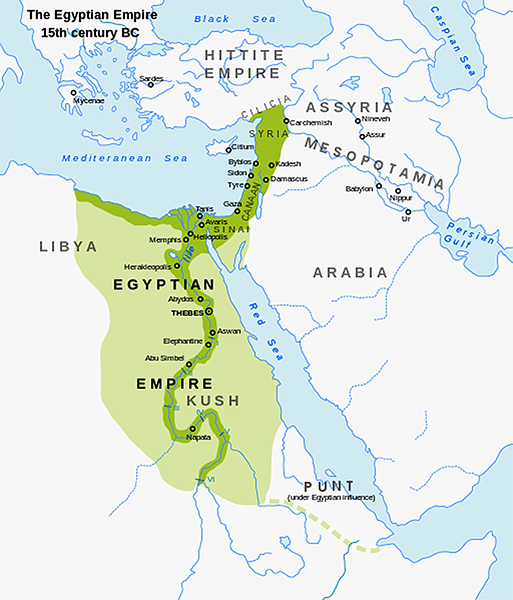
Map of Egypt's territorial control during the New Kingdom.
Photo: Andrei Nacu, Jeff Dahl
Permission: Creative Commons Attribution-Share Alike 3.0 Unported license
Source: Wikipedia
New Kingdom: 18th - 20th Dynasty, 1 550 BC - 1 077 BC
Spoon in the form of a swimmer.
1 400 BC - 1 300 BC
Length 125 mm.
Catalog: Bone? E 10903
Photo: Don Hitchcock 2018, 2015
Source and text: Louvre Museum, Paris, France
Additional text: http://cartelfr.louvre.fr/cartelfr/visite?srv=car_not_frame&idNotice=19302&langue=fr

New Kingdom: 18th - 20th Dynasty, 1 550 BC - 1 077 BC
Spoon with handle
Small spoon, with the handle in the shape of a lotus bundle, merges into a flat bowl in the shape of a royal cartouche.
Length 168 mm, width 33 mm.
Catalog: Wood, origin unknown, Inv. No. 2875
Photo: Don Hitchcock 2018
Source and text: Original, Museum August Kestner, Hannover
Additional text: Paper Catalogue, Museum August Kestner, Hannover, Wallert (1967)

New Kingdom: 18th - 20th Dynasty, 1 550 BC - 1 077 BC
Spoon with handle
The ladle, only about two-thirds preserved, bears an incised fish holding a bundle of lotuses in its mouth. The base shows the image of a jackal holding the ladle with its mouth and front feet, as seen from above.
Length 168 mm, width 36 mm.
Catalog: Wood, origin unknown, Inv. No. 2876
Photo: Don Hitchcock 2018
Source and text: Original, Museum August Kestner, Hannover
Additional text: Paper Catalogue, Museum August Kestner, Hannover, Wallert (1967)
New Kingdom: 18th - 20th Dynasty, 1 550 BC - 1 077 BC
Carpenter's axe
Height 597 mm, width 152 mm.
Catalog: Bronze and wood, Sully, Salle 334, materials and techniques, vitrine 9, E 5980
Photo: Don Hitchcock 2018
Source and text: Louvre Museum, https://collections.louvre.fr/

New Kingdom: 18th - 20th Dynasty, 1 550 BC - 1 077 BC
Carpenter's mallet
Diameter 12 cm, length 24 cm.
Catalog: Wood, Temple of Mentuhotep, Deir el-Bahri, Thebes, EA41679
Photo: Don Hitchcock 2018
Source: Original, British Museum
Text: Card at museum display, http://www.britishmuseum.org/, © Trustees of the British Museum, CC BY-NC-SA 4.0
New Kingdom: 18th - 20th Dynasty, 1 550 BC - 1 077 BC
Bow-Drill
Wooden bow-drill and bronze bits. The bronze bit was steadied in the hollow of a conical piece of wood, held in the craftsman's hand. A rapid sawing motion of the bow rotated the bit.
Length 47 cm.
Catalog: Wood, bronze, Thebes, EA6040-EA6043
Photo: Don Hitchcock 2018
Source: Original, British Museum
Text: Card at museum display, http://www.britishmuseum.org/, © Trustees of the British Museum, CC BY-NC-SA 4.0

New Kingdom: 18th - 20th Dynasty, 1 550 BC - 1 077 BC
Chair
Height 910 mm, width 475 mm, thickness 590 mm.
Catalog: Wood, ivory, Deir el-Medina, West Thebes, N 2950, Salt n°637
Location: Aile Sully, Salle 331, La maison et le mobilier, Vitrine 1
Photo: Don Hitchcock 2018
Source and text: Louvre Museum, https://collections.louvre.fr/
New Kingdom: 18th - 20th Dynasty, 1 550 BC - 1 077 BC
Folding furniture leg
Decoration in the shape of a duck's head.
Height 32 mm, length 215 mm, width 28 mm.
Catalog: Wood, inlaid ivory (?), Room 334 Sully Wing, Level 0, Vitrine 9, N 875 F, Drovetti n°63
Photo: Don Hitchcock 2018
Source and text: Louvre Museum, Paris, France, https://collections.louvre.fr/
New Kingdom: 18th - 20th Dynasty, 1 550 BC - 1 077 BC
Furniture legs for a stool.
Dark brown.
Length (of N 875 A) 485 mm.
Catalog: Wood, Room 334 Sully Wing, Level 0, Vitrine 9, N 875 A, E, H (right to left)
Photo: Don Hitchcock 2018
Source and text: Louvre Museum, Paris, France, https://collections.louvre.fr/
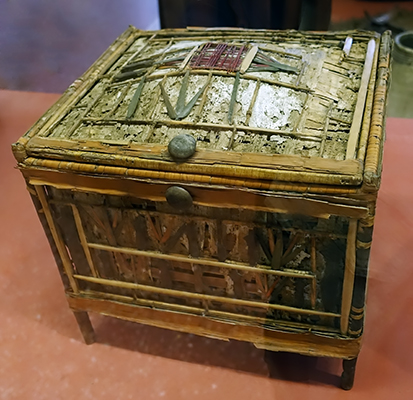
New Kingdom: 18th - 20th Dynasty, 1 550 BC - 1 077 BC
Rectangular chest with feet
Height 250 mm, width 285 mm, thickness 243 mm.
Decoration: Rosette, lotus, band of alternating rectangles
Catalog: Papyrus, reed Deir el-Medina, West Thebes, E 11896
Location: Aile Sully, Salle 331, La maison et le mobilier, Vitrine 1
Photo: Don Hitchcock 2018
Source and text: Louvre Museum, https://collections.louvre.fr/
Date not given
Statue of Bes which once held a fetal mummy.
A cavity in the back originally contained a fetal mummy, now destroyed.
Height 560 mm.
Catalog: Articulated wood, stuccoed fabric, glass, gilding, inlaid, Room 334 Sully Wing, Level 0, Vitrine 9, E 5723
Photo: Don Hitchcock 2018
Source and text: Louvre Museum, Paris, France, https://collections.louvre.fr/
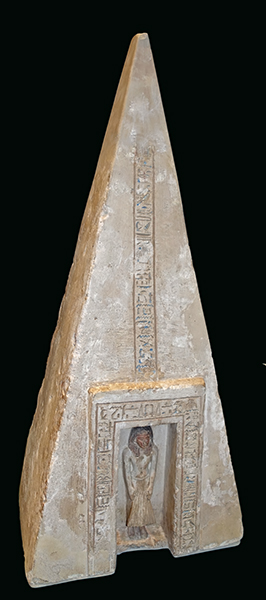
New Kingdom: 18th - 20th Dynasty, 1 550 BC - 1 077 BC
Pyramidion
Limestone pyramidion of Buqentef, with a niche at the base containing figure of the deceased. Incised Hieroglyphic text round the niche and in a column above, and some painted detail.
Height 660 mm, width 280 mm, depth 195 mm.
During the New Kingdom, some private underground tombs were marked on the surface by small brick pyramids that terminated in pyramidia. The four lateral sides included texts and scenes related to the cult of the Sun God (as the representation of Pharaoh).
The scenes typically depict the course of the sun, rising on one lateral face, setting on the opposite face, and traveling, through the night, through the underworld, ruled by Osiris.
Catalog: Painted limestone, EA1685
Photo: Don Hitchcock 2018
Source and text: Original, card at the British Museum, http://www.britishmuseum.org/, © Trustees of the British Museum, CC BY-NC-SA 4.0
Additional text: Wikipedia

New Kingdom: 18th - 20th Dynasty, 1 550 BC - 1 077 BC
Spoon with a handle of stalks
The handle is formed by five lotus stalks, the middle of which expands to form a flower as a ladle. A mandrake fruit closes it off at the top, revealing the hole through which the lid, now lost, could have been closed.
Length 202 mm, width 76 mm.
Catalog: Wood, origin unknown, Inv. No. 2873
Photo: Don Hitchcock 2018
Source and text: Original, Museum August Kestner, Hannover
Additional text: Paper Catalogue, Museum August Kestner, Hannover, Wallert (1967)


New Kingdom: 18th - 20th Dynasty, 1 550 BC - 1 077 BC
Bowed Harp
Length 1030 mm, width 170 mm, depth 110 mm.
Catalog: Acacia, painted green, Aile Sully, Room 329, Les loisirs, Vitrine 1, N 1440 B, Champollion M. 27
Photo: Don Hitchcock 2015
Source and text: Original, Louvre Museum, Paris, France, https://collections.louvre.fr/

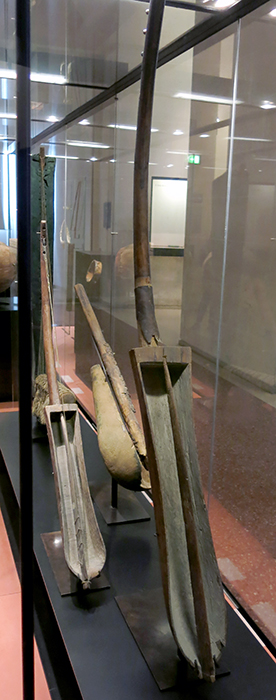
New Kingdom: 18th - 20th Dynasty, 1 550 BC - 1 077 BC
Bowed Harp
Length 1373 mm, width 425 mm, depth 130 mm.
Inscription: servant-oba of the dean of musicians, Bekou (mother, mistress of the house), Amen-Ra
Catalog: Acacia, plaster, leather, Aile Sully, Salle 329, Les loisirs, Vitrine 1, E 116 A, N 1440 A, Clot bey C 8 no. 2
Photo: Don Hitchcock 2015
Source and text: Original, Louvre Museum, Paris, France, https://collections.louvre.fr/
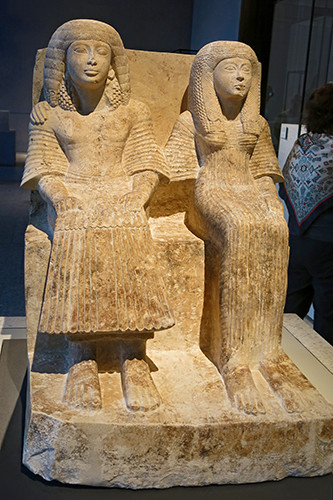
New Kingdom: 18th - 20th Dynasty, 1 550 BC - 1 077 BC
Nefer-Hor
Double statue of Nefer-Hor and his wife.
Catalog: Limestone, ÄM 2303
Photo: Don Hitchcock 2015
Source: Original, Staatliche Museen zu Berlin, Neues Museum, Germany
Text: © Card at the Staatliche Museen zu Berlin (CC BY-NC-SA 3.0 DE)

New Kingdom: 18th - 20th Dynasty, 1 550 BC - 1 077 BC
Ancestral Bust
The bust mentions the goddess Hathor.
Catalog: Painted limestone, Deir el-Medine, ÄM 20994
Photo: Don Hitchcock 2018
Source: Original, Staatliche Museen zu Berlin, Neues Museum, Germany
Text: © Card at the Staatliche Museen zu Berlin (CC BY-NC-SA 3.0 DE)
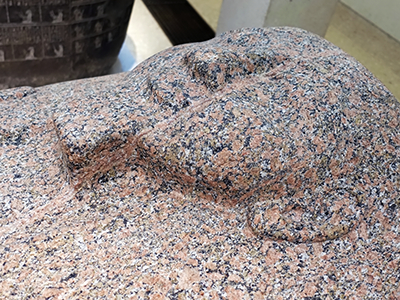
New Kingdom: 18th - 20th Dynasty, 1 550 BC - 1 077 BC
Meryt / Meriti / Meri.ti
Sarcophagus of Meryt, official of auxiliary forces, High priest of Rê.
Sarcophagus of Meriti, commander of the chariot contingent, commander of the chariot troop, troop commander, 'Great Warrior of the Chariot Troop', high priest of Rê.
Personal information: Unfortunately, we know very little about Meriti, as there are no other objects known except for his coffin. Due to his offices and titles, one can assume that the coffin originated from Memphis or from the necropolis of Saqqara.
Meri.ti is believed to have held the following positions during his military career: commander of the chariot contingents and commander-in-chief.
Since Memphis had been the largest regimental city in ancient Egypt since the 18th Dynasty and, above all, the large chariot contingents were located there, it is reasonable to assume that Meri.ti would also be active there. This fits with the fact that Meri.ti was obviously rewarded with the role of 'High Priest of Rê' as a pension office, this is not to be equated with the office of 'High Priest of Rê of Heliopolis'.
The massive rose granite sarcophagus consists of a coffin lid and coffin base and is designed in an anthropoid form. The lid shows the stylised, broad and flat face of the deceased with a short beard and three-part wig. Meri.ti holds in his hands a 'Djed' pillar and an 'Isis' knot or tyet, which are the typical emblems in the fists of the arms and hands lying crossed over the chest in the Ramesside period.
The structure of the inscriptions, which are based on large, mummy bandages, is distributed over the abdomen and foot area and corresponds to the common pattern of the Ramessid period. It is striking that the entire coffin lid and some parts of the coffin pan were obviously not completed, but only the first surface treatment on the part of the stonemason after the preparations by the draftsmen were carried out.
The design of the coffin base shows - as expected - a representation of Isis with arms raised with the normal accompanying text at her feet. At the head end, on the other hand, there is not only a picture of Nephthys, but also Neith, so that of the four goddesses, who are assigned to the protection of the canopic chests and which decorate the corners of the royal coffins of Tutankhamen, only the selket is missing.
On the sides, after the characteristic released parts, which are intended to indicate the part of the wig, on the east side, as a reminiscence of the former show-door with the pair of eyes, only the two Udjat eyes are still to be found diagonally above a standard, which is held by an ibis-headed god turned towards the foot end. The following four other deities, which are oriented in opposite directions, are the human-headed Horus son 'Amset', followed by Anubis, who in turn is associated with the jackal-headed Horus son 'Dua-mut-ef' and finally Thot.
On the 'western' side, can be found a contented Anubis lying on a shrine behind the shoulder area, which again depicts four deities advancing. These are the baboon-headed Horus son 'Hapi', followed by Anubis, as well as the falcon-headed Horus son 'Kebeh-senu-ef' and again a depiction of an ibis-headed god with a standard, who is not identified as Thot in the inscription.
In keeping with Meri.ti's office as priest of Rê the passages quoted from the Book of the Dead also show solar references, since twice the passage 'Life for Rê! Tod der Schildkröte!" is performed twice, which was considered an enemy of the sun god and therefore had to be ritually destroyed.
(Friederike Seyfried)
On the 'western' side one finds - fitting in content - after the shoulder part, a supine Anubis on a shrine, which is again depicted with four deities striding towards him. These are the baboon-headed Horus son 'Hapi', followed by Anubis, as well as the falcon-headed Horus son 'Kebeh-senu-ef' and again a representation of an ibis-headed god with standard, which however is not marked as Thot in the inscription.
Text above: Friederike Seyfried
Catalog: Pink Granite, Saqqara (necropolis), ÄM 2/1-2
Photo: Don Hitchcock 2015, 2018
Source: Original, Staatliche Museen zu Berlin, Neues Museum, Germany
Text: © Card at the Staatliche Museen zu Berlin, Friederike Seyfried at http://www.smb-digital.de/, (CC BY-NC-SA 3.0 DE)
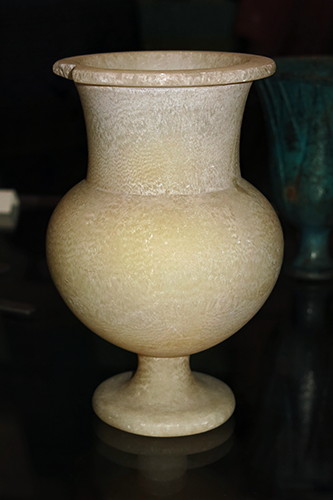
New Kingdom: 18th - 20th Dynasty, 1 550 BC - 1 077 BC
Vase
Calcite (alabaster) vase with tall foot, globular body, and a high, cylindrical neck and external ledge-rim.
Height 165 mm.
An example similar to EA4555 was found in an 18th dynasty tomb at Sedment (Petrie & Brunton, Sedment II, pl.LVII (254)) along with two cosmetic boxes, calcite kohl-pots, and ceramic vessels.
Catalog: Thebes, EA4555
Photo: Don Hitchcock 2015
Source: Original, British Museum
Text: Card at museum display, http://www.britishmuseum.org/, © Trustees of the British Museum, CC BY-NC-SA 4.0
New Kingdom: 18th - 20th Dynasty, 1 550 BC - 1 077 BC
Cosmetic Box
Wooden cosmetic box in the form of a trussed duck. The container can be closed with a swivel lid, which bears incised decoration. Holes, one in the body and the other in the lid, would allow the lid to be held in place with string.
Length 108 mm, width 50 mm.
Curator's comments: Cosmetic containers such as this one are typically found in tombs though examples have been found in temples.
Catalog: Wood, EA5949
Photo: Don Hitchcock 2018
Source: Original, British Museum
Text: Card at museum display, http://www.britishmuseum.org/, © Trustees of the British Museum, CC BY-NC-SA 4.0
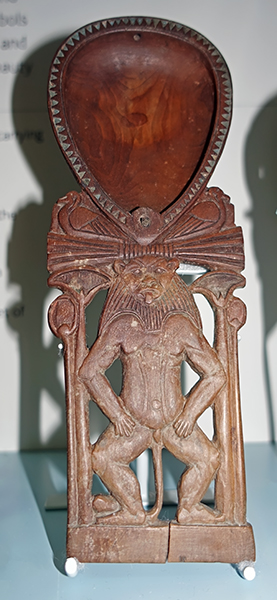
New Kingdom: 18th - 20th Dynasty, 1 550 BC - 1 077 BC
Cosmetic Spoon
Wooden cosmetic-spoon. The bowl and upper handle are in the form of the upper half of an ankh-symbol. The rim is inlaid with egyptian blue(?) triangles, to create a floral motif.
The handle is in the form of an open-work representation of the god Bes, squatting, and flanked by papyrus plants. Two ducks are represented above the crossbar of the ankh.
Length 187 mm, width 10 mm, depth 67 mm, weight 38 grams.
Catalog: Wood, Egyptian blue (?) Thebes, EA5954
Photo: Don Hitchcock 2018
Source: Original, British Museum
Text: Card at museum display, http://www.britishmuseum.org/, © Trustees of the British Museum, CC BY-NC-SA 4.0
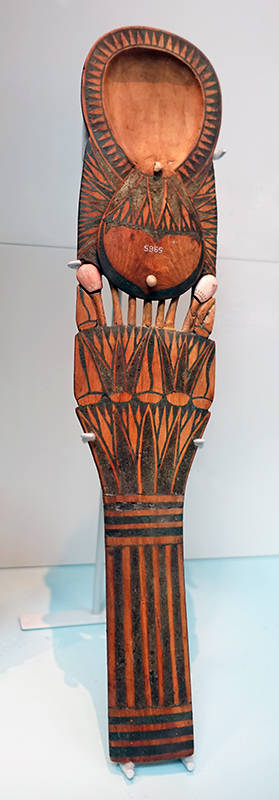
New Kingdom: 18th - 20th Dynasty, 1 550 BC - 1 077 BC
Ointment Spoon
Wooden ointment-spoon in the form of a bouquet of lotus-flowers. The buds are of inlaid pink-stained ivory, the leaves are painted green. The swivel-lid is attached by an ivory peg, and hides two more pink-stained ivory buds in this image.
Length 310 mm, width 15 mm, depth 70 mm, weight 58 grams.
Catalog: Wood, ivory, Memphis, EA5965
Photo: Don Hitchcock 2018
Source: Original, British Museum
Text: Card at museum display, http://www.britishmuseum.org/, © Trustees of the British Museum, CC BY-NC-SA 4.0
New Kingdom: 18th - 20th Dynasty, 1 550 BC - 1 077 BC
Clappers
Catalog: Bone and wood, Thebes, ÄM 9532/1-2, ÄM 8177, ÄM 8179
Photo: Don Hitchcock 2018
Source: Display, Staatliche Museen zu Berlin, Neues Museum, Germany
Text: © Card at the Staatliche Museen zu Berlin (CC BY-NC-SA 3.0 DE)

New Kingdom: 18th - 20th Dynasty, 1 550 BC - 1 077 BC
Mirror
Catalog: Bronze, Thebes, ÄM 2774
Photo: Don Hitchcock 2018
Source: Display, Staatliche Museen zu Berlin, Neues Museum, Germany
Text: © Card at the Staatliche Museen zu Berlin (CC BY-NC-SA 3.0 DE)
New Kingdom: 18th - 20th Dynasty, 1 550 BC - 1 077 BC
Oboe and double clarinet
Tube with papyrus mouthpiece (bronze repair), tube.
Catalog: ÄM 12461/1-2, ÄM 10706
Photo: Don Hitchcock 2018
Source: Display, Staatliche Museen zu Berlin, Neues Museum, Germany
Text: © Card at the Staatliche Museen zu Berlin (CC BY-NC-SA 3.0 DE)
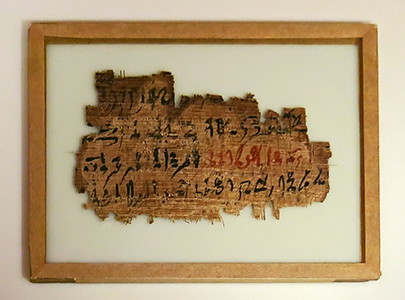
New Kingdom: 18th - 20th Dynasty, 1 550 BC - 1 077 BC
Teaching text
Teaching of a man for his son, with red ink, hieratic.
Catalog: Papyrus, ÄM 15338
Photo: Don Hitchcock 2015
Source: Display, Staatliche Museen zu Berlin, Neues Museum, Germany
Text: © Card at the Staatliche Museen zu Berlin (CC BY-NC-SA 3.0 DE)
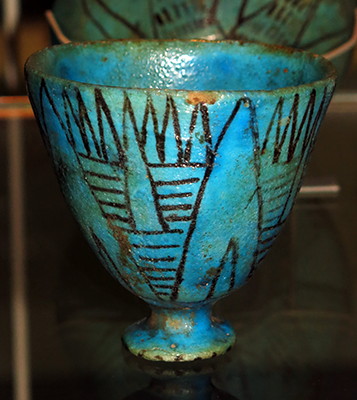
New Kingdom: 18th - 20th Dynasty, 1 550 BC - 1 077 BC
Cup
Blue glazed composition (faience) drinking-cup, in the form of a stemmed lotus flower. The floral motif, with petals of various sizes, is outlined in black (probably manganese) on the exterior of the vessel.
Height 92 mm, diameter 98 mm.
The lotus motif, and indeed the qualities of faience as a material, were closely linked to rebirth.
Catalog: EA4801
Photo: Don Hitchcock 2015
Source: Original, British Museum
Text: Card at museum display, http://www.britishmuseum.org/, © Trustees of the British Museum, CC BY-NC-SA 4.0
New Kingdom: 18th - 20th Dynasty, 1 550 BC - 1 077 BC
Agricultural tools
A plow, a hoe, and a sickle with a flint blade.
Photo: Don Hitchcock 2018
Source: Original, Staatliche Museen zu Berlin, Neues Museum, Germany
Text: © Card at the Staatliche Museen zu Berlin (CC BY-NC-SA 3.0 DE)
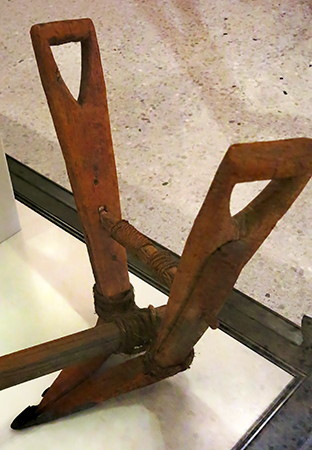
New Kingdom: 18th - 20th Dynasty, 1 550 BC - 1 077 BC
Plow
This plow would presumably have been drawn by oxen. It has been provided with a replacement wooden pole, but is otherwise original.
Catalog: Luxor, wood and bronze, ÄM 13876, ÄM 13687
Photo: Don Hitchcock 2015
Source: Original, Staatliche Museen zu Berlin, Neues Museum, Germany
Text: © Card at the Staatliche Museen zu Berlin (CC BY-NC-SA 3.0 DE)

New Kingdom: 18th - 20th Dynasty, 1 550 BC - 1 077 BC
Plow
Closeup of the plow above.
Catalog: Luxor, wood and bronze, ÄM 13876, ÄM 13687
Photo: Don Hitchcock 2018
Source: Original, Staatliche Museen zu Berlin, Neues Museum, Germany
Text: © Card at the Staatliche Museen zu Berlin (CC BY-NC-SA 3.0 DE)
New Kingdom: 18th - 20th Dynasty, 1 550 BC - 1 077 BC
Sickle
Closeup of the sickle above.
( this view allows us to see the groove which originally held a number of flint blades, secured probably by an animal glue, which was widely used in Egypt at the time - Don )
Catalog: Gebelein, wood and flint, ÄM 19475
Photo: Don Hitchcock 2018
Source: Original, Staatliche Museen zu Berlin, Neues Museum, Germany
Text: © Card at the Staatliche Museen zu Berlin (CC BY-NC-SA 3.0 DE)
Additional text: Wikipedia
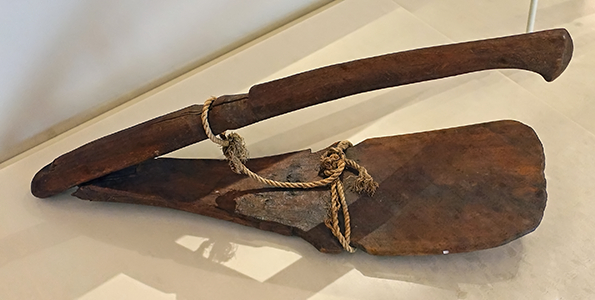
New Kingdom: 18th - 20th Dynasty, 1 550 BC - 1 077 BC
Hoe
Catalog: Qurna, wood, ÄM 7104
Photo: Don Hitchcock 2018
Source: Original, Staatliche Museen zu Berlin, Neues Museum, Germany
Text: © Card at the Staatliche Museen zu Berlin (CC BY-NC-SA 3.0 DE)
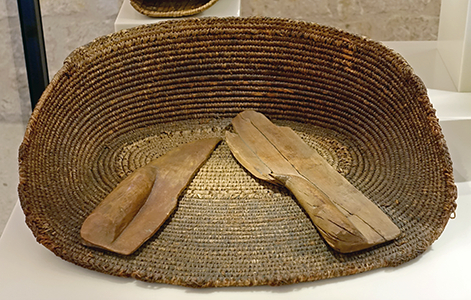
New Kingdom: 18th - 20th Dynasty, 1 550 BC - 1 077 BC
Winnowing basket and two winnowing shovels.
Catalog: From Elephantine, made of wood and palm fibre, ÄM 10773, ÄM 12478, ÄM 13885
Photo: Don Hitchcock 2018
Source: Original, Staatliche Museen zu Berlin, Neues Museum, Germany
Text: © Card at the Staatliche Museen zu Berlin (CC BY-NC-SA 3.0 DE)

New Kingdom: 18th - 20th Dynasty, 1 550 BC - 1 077 BC
Seed bag
Catalog: Sedge grass, ÄM 6913
Photo: Don Hitchcock 2018
Source: Original, Staatliche Museen zu Berlin, Neues Museum, Germany
Text: © Card at the Staatliche Museen zu Berlin (CC BY-NC-SA 3.0 DE)
New Kingdom: 18th - 20th Dynasty, 1 550 BC - 1 077 BC
Bronze knife
Papyrus knife with the handle in the form of the neck and head of a duck.
Length 303 mm, width 32 mm, diameter 3 mm, thickness 2 mm.
Catalog: Bronze, N 2120, Drovetti n° 150
Location: Sully, Salle 335, Writing and the scribes, Vitrine 2
Photo: Don Hitchcock 2015
Source and text: Original, Louvre Museum, https://collections.louvre.fr/
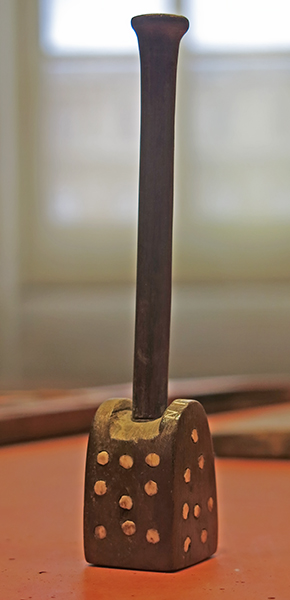
(?) New Kingdom: 18th - 20th Dynasty, 1 550 BC - 1 077 BC
Papyrus smoother
Height 120 mm, width 23 mm.
Catalog: Wood and ivory, N 1723, Salt n° 617
Location: Sully, Salle 335, Writing and the scribes, Vitrine 2
Photo: Don Hitchcock 2015
Source and text: Original, Louvre Museum, https://collections.louvre.fr/
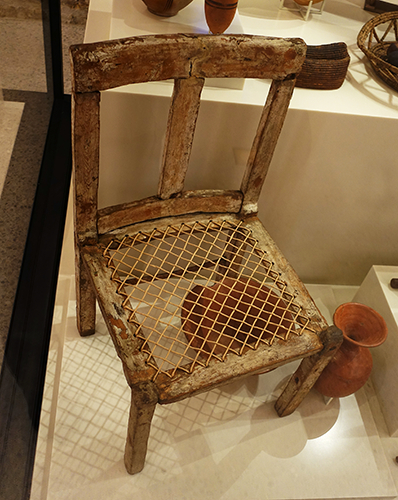
New Kingdom: 18th - 20th Dynasty, 1 550 BC - 1 077 BC
Chair with backrest
Catalog: Wood, ÄM 10748
Photo: Don Hitchcock 2018
Source: Original, Staatliche Museen zu Berlin, Neues Museum, Germany
Text: © Card at the Staatliche Museen zu Berlin (CC BY-NC-SA 3.0 DE)
18th - 23rd Dynasty: 1 550 BC - 720 BC
Sandals
A pair of sandals with curved tips and footrest.
Circa 1540 BC - 840 BC.
Catalog: Plant fibre and wood, Luxor, ÄM 6931, ÄM 19359
Photo: Don Hitchcock 2018
Source: Original, Staatliche Museen zu Berlin, Neues Museum, Germany
Text: © Card at the Staatliche Museen zu Berlin (CC BY-NC-SA 3.0 DE)
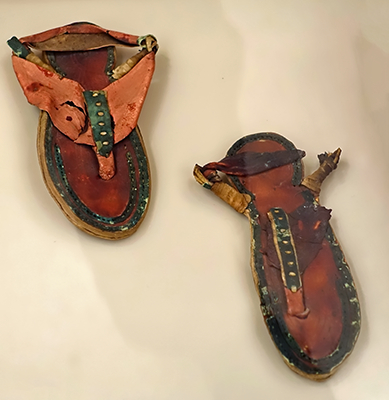
18th - 31st Dynasty: 1 550 BC - 332 BC
Sandals for a child
Catalog: Plant fibre and painted leather, Deir el-Medine, ÄM 10824/1+2
Photo: Don Hitchcock 2018
Source: Original, Staatliche Museen zu Berlin, Neues Museum, Germany
Text: © Card at the Staatliche Museen zu Berlin (CC BY-NC-SA 3.0 DE)
New Kingdom: 18th - 20th Dynasty, 1 550 BC - 1 077 BC
Chest
Painted sycomore-fig wood chest with four legs. The shape of the chest, with tapering lid, and cavetto cornice, echoes that of a traditional shrine. A knob was provided on the top of the lid, and at the corresponding end of the chest, to allow the chest to be secured with cord and wax (which does not survive on this example).
The painted decoration, with red, white and black colours, may have served to suggest a more elaborate storage container, made form a variety of precious materials (e.g. ivory, ebony).The lid is painted with a single column of hieroglyphic text, which reads 'honoured before Osiris, the sailor (?), Denerg(i), true of voice'.
Houses had distinct areas for men and women and seasonal rooms. Bedrooms were often small rooms in the most private area at the back of the house. Even wealthy homes would have had few pieces of furniture, but their chairs, stools and boxes were made of expensive woods, often lavishly decorated and inlaid with coloured ivory and other precious materials.
This wooden chest was used to store linen, cosmetics, and other personal belongings, and were found in wealthy tombs at Thebes.
Height 250 mm, length 338 mm, width 217 mm.
Catalog: Thebes, EA5907
Photo: (left) Don Hitchcock 2015
Photo: (right) © Trustees of the British Museum, CC BY-NC-SA 4.0
Source: Original, British Museum
Text: Card at museum display, http://www.britishmuseum.org/, © Trustees of the British Museum, CC BY-NC-SA 4.0
New Kingdom: 18th - 20th Dynasty, 1 550 BC - 1 077 BC
Chest
Toilet set, containing cosmetics.
Wooden toilet-chest with lid containing a pottery vessel, two calcite vases, a pumice stone, an ivory comb, a shallow bronze cosmetic-dish, a pair of leather sandals, three fibre jar-lids, a reed double kohl-pot with application stick and an ivory pin.
The box is made around four square-sectioned legs, with glue and tenons used to hold the component pieces of wood together. The front panel, however, was not secured, so could have been removed to allow the contents to be visible.
Inside, pieces of wood have been used to create internal divisions. Three smaller compartments (at the back) each contained a vessel, while the front compartment (running along the width of the box) contained the other items. Wooden knobs attached to the front of the box, and the top of the lid, would have allowed the box to be fastened shut.
Materials: wood, reed , pumice, pottery, leather, ivory, fibre, calcite, bronze.
Height 355 mm, width 343 mm.
Catalog: Tomb of Ani, Thebes, EA24708
Photo: Don Hitchcock 2015
Source: Original, British Museum
Text: Card at museum display, http://www.britishmuseum.org/, © Trustees of the British Museum, CC BY-NC-SA 4.0
New Kingdom: 18th - 20th Dynasty, 1 550 BC - 1 077 BC
Folding stool
Folding stool with duck heads. The duck heads are stylised, with the beak on the lower rails resting on the floor.
See the image below of a similar folding stool on display at the British Museum.
Catalog: Luxor, Wood, Elephant Ivory, ÄM 12552
Photo: Don Hitchcock 2018
Source: Original, Staatliche Museen zu Berlin, Neues Museum, Germany
Text: © Card at the Staatliche Museen zu Berlin (CC BY-NC-SA 3.0 DE)
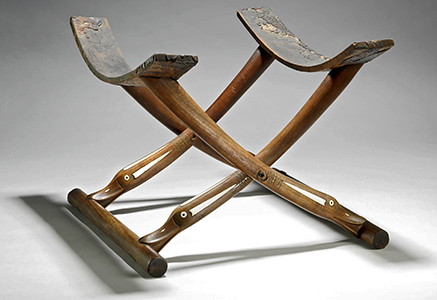
New Kingdom: 18th - 20th Dynasty, 1 550 BC - 1 077 BC
Folding stool
Wooden folding-stool. The well cut and finished base rails are cylindrical and without further decoration. The folding legs each terminate in a head of a duck or goose. These heads are carefully carved, with the eyes and nostrils inlaid with ivory; there are also long thin triangular pieces of ivory inlaid into the neck of the bird. The third part is the seat rails. To these would have been attached a piece of leather to serve as the seat, and many traces of the leather remain on the underside of the rails.
Height 533 mm, width 546 mm.
It is very probable that this stool was found in a tomb, one of the many cleared at Thebes during the 1820s, when Henry Salt or one of his agents would have purchased this piece. The excellent quality of the piece means that it probably came from the tomb of an important and wealthy individual.
Catalog: Thebes, Wood, Elephant Ivory, EA2477
Photo: © The Trustees of the British Museum
Text: http://www.britishmuseum.org/research/collection_online/, © Trustees of the British Museum, CC BY-NC-SA 4.0
Source: Original, British Museum
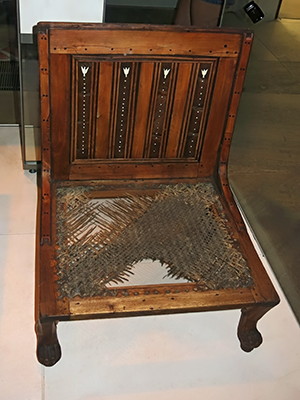
New Kingdom: 18th - 20th Dynasty, 1 550 BC - 1 077 BC
Chair
A low, straight-backed, chair made from acacia wood, with finely inlaid decoration.The legs take the form of lion legs, though sat upon small cylindrical supports. These legs are attached to the main part of the chair with mortises and tenons, secured by dowels.
The seat of the chair is still partly preserved, with a webbing of woven string.The front side of the chair back is finely decorated, with vertical panels of timber, alternatively darker and lighter in colour, inset to create a decorative frame. The darker timbers have been further embellished with a column of ivory circles leading to small ivory lotus flowers. The reverse of the chair-back does not feature ivory inlays.
Height: 597 mm.
Catalog: Thebes, ivory, fibre, ebony, acacia wood, EA2480
Photo: Don Hitchcock 2015
Source: Original, British Museum
Text: Card at museum display, http://www.britishmuseum.org/, © Trustees of the British Museum, CC BY-NC-SA 4.0
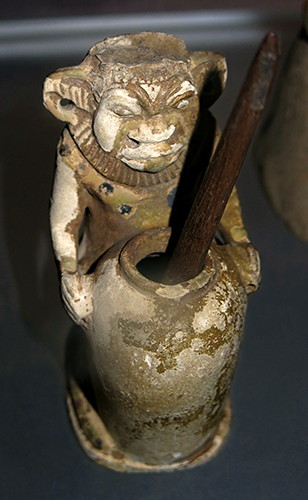
New Kingdom: 18th - 20th Dynasty, 1 550 BC - 1 077 BC
Bes with kohl
Green glazed composition kohl-tube, with details in black, in the form of a squatting Bes figure, holding a large jar before him, in which the kohl would have been kept.
The figure of Bes has pierced ears, suggesting it was once adorned with earrings, and a mane indicated with incised lines. The headdress is now lost, but probably consisted of feathers. He wears a leopard-skin outfit, with details picked out in black paint.
Height 80 mm, length 50 mm.
Catalog: EA65242
Photo: Don Hitchcock 2015
Source: Original, British Museum
Text: Card at museum display, http://www.britishmuseum.org/, © Trustees of the British Museum, CC BY-NC-SA 4.0
New Kingdom: 18th - 20th Dynasty, 1 550 BC - 1 077 BC
Box in the form of a duck. The two wings act as a lid for the receptacle.
Wood and ivory, length 165 mm, width 65 mm, depth 350 mm.
Catalog: N 1740
Photo: Don Hitchcock 2015, 2018
Source and text: Louvre Museum, Paris, France
New Kingdom: 18th - 20th Dynasty, 1 550 BC - 1 077 BC
Box in the form of a duck. The two wings act as a lid for the receptacle.
Carob wood, length 83 mm, width 25 mm.
Catalog: E 219
Photo: Don Hitchcock 2018
Source and text: Louvre Museum, Paris, France
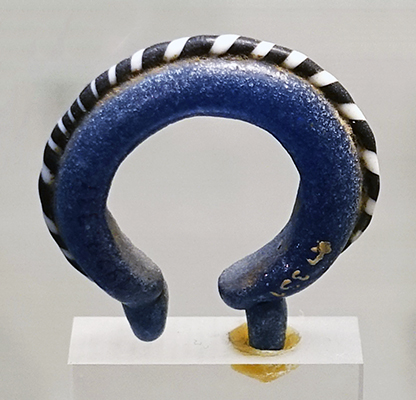
New Kingdom: 18th - 20th Dynasty, 1 550 BC - 1 077 BC
Earring.
Coloured glass paste, diameter 29 mm.
On the inner ring of blue glass paste with two lugs or projections to attach it to the ear (probably by means of a cord), a narrow decorative black and white spiralled outer ring has been fused on.
Catalog: Place of discovery unknown, New Kingdom, inv. no. 1929.331
Photo: Don Hitchcock 2018
Source and text: Original, Museum August Kestner, Hannover
Additional text: Anton Kisa, Das Glas im Altertum I, T1, I, 17
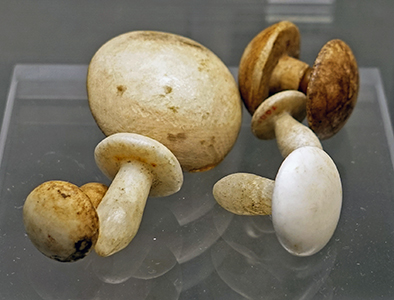
New Kingdom: 18th - 20th Dynasty, 1 550 BC - 1 077 BC
Keepers, or ear buds.
These appear to be what are now called 'keepers', used for everyday wear and/or at night to keep the holes of pierced ears open, and are made of alabaster and ivory (probably from hippopotamus teeth).
Catalog: Place of discovery unknown, New Kingdom. Numbers and dimensions: 1679 (height 21 mm, diameter 35 mm), 1681 (height 22mm, diameter 15 mm), 1929.345a/b (height 15 mm, diameter 22 mm), 1930.380a/b (height 25 to 24 mm, diameter 19 mm to 16 mm), 1951.42 (height 27 mm, diameter 21mm).
Photo: Don Hitchcock 2018
Source and text: Original, Museum August Kestner, Hannover
New Kingdom: 18th - 20th Dynasty, 1 550 BC - 1 077 BC
Shell-shaped bowl and earrings
Alabaster, glass, and jasper earrings.
Catalog: Place of discovery unknown, New Kingdom, bowl inv. nr. 1926 (length 131 mm, width 73 mm), rings between 12 mm and 28 mm
Photo: Don Hitchcock 2018
Source and text: Original, Museum August Kestner, Hannover
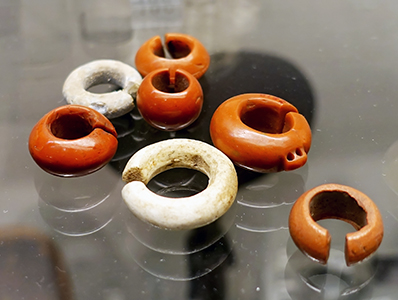
New Kingdom: 18th - 20th Dynasty, 1 550 BC - 1 077 BC
Earrings
Alabaster and jasper earrings.
Catalog: Place of discovery unknown, New Kingdom
Photo: Don Hitchcock 2018
Source and text: Original, Museum August Kestner, Hannover
New Kingdom: 18th - 20th Dynasty, 1 550 BC - 1 077 BC
Crouching frog
Frogs, together with snakes, are among the animals with which the Egyptians have always associated the idea of their mysterious emergence from the primordial mud. This idea was obvious, for the spawn is practically invisible: and the process of reproduction eludes human observation.
Frog and snake heads also marked the four pairs of gods located in Hermopolis in central Egypt with the names 'primordial waters', 'Spatial Deification', 'Darkness' and 'Dwindling' (each with a feminine complement), which together describe the faraway state before the emergence of light and the solid land and also - after ever repeated and yet limited eternities - at the end of all time.
From this viewpoint, the connection of the frog with birth in general follows consistently, which took shape in the goddess Heqet as the helper of the creator god Chnum of Elephantine (where the Egyptians defined the sources of the Nile to be despite better geographical knowledge). Heqet, the 'sorceress', thus often appears where the protection of the mother and the child to be born is concerned.
This frog effigy, which is particularly precious because of its size, its multi-coloured glaze (bright blue ground, reddish-brown eyes, green back drawing) and its elegant lines, may therefore originally have been kept in the chamber of a rich woman in childbirth.
Faience, height 42 mm, length 75 mm, width 41 mm.
Catalog: Place of discovery unknown, New Kingdom, Inv. no. 1935.200.378
Photo: Don Hitchcock 2018
Source and text: Original, Museum August Kestner, Hannover
New Kingdom: 18th - 20th Dynasty, 1 550 BC - 1 077 BC
Wigs
Wigs of female statuettes.
The combination of wig and natural hair, as shown on the wig at right (the broad cross braids were only applied, the natural hair is braided into three thick plaits at the nape of the neck or falls down in strands) was found on statuettes from the Middle Kingdom and the beginning of the New Kingdom.
( note that no actual natural hair is used, but in contrast to most ancient Egyptian wigs, natural hair has been simulated on the wood or limestone - Don )
Catalog: Wood and limestone, place of discovery unknown, New Kingdom, 2872 (height 133 mm), 1935.200.143 (height 118 mm, width 84 mm)
Photo: Don Hitchcock 2018
Source and text: Original, Museum August Kestner, Hannover
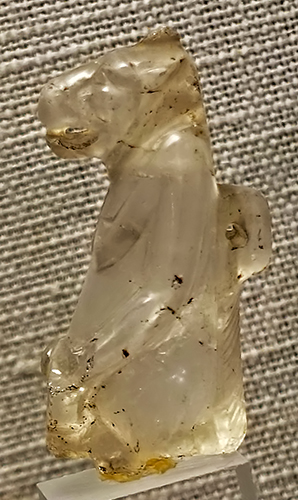
New Kingdom: 18th - 20th Dynasty, 1 550 BC - 1 077 BC
Toeris
Statuette of Toeris or Tawaret, a protective ancient Egyptian goddess of childbirth and fertility.
Rock crystal, height 50 mm.
The deity is typically depicted as a bipedal female hippopotamus with feline attributes, pendulous female human breasts, the limbs and paws of a lion, and the back and tail of a Nile crocodile.
( note that the statuette is provided with an eyelet in the back to allow it to be mounted, perhaps let into a flat surface - Don )
Catalog: Rock crystal, unknown provenance, Inv. no. 1950.19
Photo: Don Hitchcock 2018
Source and text: Original, Museum August Kestner, Hannover
Additional text: Wikipedia

New Kingdom: 18th - 20th Dynasty, 1 550 BC - 1 077 BC
Bowl
Bowl with the inscription 'medicinal herbs from the East'.
Catalog: Ceramic, ÄS 4132
Photo: Don Hitchcock 2015
Source: Original, Ägyptischen Museum München
Text: Museum card, © Ägyptischen Museum München
New Kingdom: 18th - 20th Dynasty, 1 550 BC - 1 077 BC
Salt Bowl
As usual, the artistically themed side - an antelope with bound legs and long horns laid back - forms the base, while the recess intended for the storage of cosmetics faces upwards.
The eye sockets were filled with blue glass paste.
Dimensions: height 64 mm, length 147 mm, thickness 18 mm.
Catalog: Light serpentine, unknown provenance, Inv. no. 1935.200.147
Photo: Don Hitchcock 2018
Source and text: Original, Museum August Kestner, Hannover
Additional text: Kayser (1969) p. 56
New Kingdom: 18th - 20th Dynasty, 1 550 BC - 1 077 BC
Rectangular Chest
Box with feet, cornice, and a rounded lid.
( The rounded lid seems to be a muted version of the typical top to an Ancient Egyptian Naos or wooden shrine - Don )
Height 176 mm, length 223 mm, width 153 mm.
Catalog: Wood, veneered feet, Room 334 Sully wing, Level 0, Vitrine 9, E 8429, AF 204
Photo: Don Hitchcock 2018
Source and text: Original, Louvre Museum, collections.louvre.fr
New Kingdom: 18th - 20th Dynasty, 1 550 BC - 1 077 BC
Salt Bowl
New Kingdom, probably from the 18th Dynasty.
The underside is modelled on a fish frequently found in the Nile ( Tilapia Nilotica ). The head and gill fin as well as the tail also decorate the utility side, which has been hollowed out flat for the application of make-up or ointment.
Dimensions: height 83 mm, length 170 mm, thickness 22 mm.
Catalog: Serpentine, unknown provenance, Inv. no. 1935.200.160
Photo: Don Hitchcock 2018
Source and text: Original, Museum August Kestner, Hannover
Additional text: Paper Catalogue, Museum August Kestner, Hannover
New Kingdom: 18th - 20th Dynasty, 1 550 BC - 1 077 BC
Mirror
The desire to control the appearance of the face is probably as old as the human desire to adorn oneself and to beautify the face by whatever means. The prerequisite for this, however, is a reflective surface. In ancient times, this could be provided only by standing water, but the endeavour to make oneself independent of such localised possibilities soon led to 'mirroring' in the form of shallow bowls that could be filled with water at will. Even brightly polished and moistened stone discs can reflect the surroundings. Real mirrors, however, which allow even the finest details to be seen without distortion, require the use of metal (copper, bronze) and the careful polishing of its surface. Real mirror glass is a relatively recent invention.
The metal mirror is encountered from the early Old Kingdom to the latest epochs, and its mortise in a wooden handle is just as old.
The miracle of the reflection and doubling of the countenance, which, as in the early days of man, is experienced anew by every child with amazement, is naturally a source of mythical ideas and ritual customs (cf. also the myth of Narcissus).
The Egyptians knew mirror dances in honour of Hathor, the great goddess of motherhood and love; in late times, mirrors were the hallmark and equipment of female cult communities. The mirror disc was often compared to the sun, and what the disc itself could not express directly (except through a corresponding inscription), the handle could. Even in the Old Kingdom, for example, it often had the shape of a standard of the gods or was designed as the face of Hathor.
Its design as a papyrus plant with a broad and beautifully curved blossom (no. 124) is mainly aesthetically determined, although the thought of Hathor also resonates, in whose honour there was a rite of gathering and digging up papyrus.
Certainly the hope that the face seen in the mirror would be full of charms and enchant the beloved leads to the shaping of the handle as an unclothed young girl holding a duck in front of her breast - as an erotic motif that cannot be explained exactly, but which also recurs frequently in salt spoons.
Dimensions: height 262 mm, breadth of disc 128 mm.
Catalog: Bronze, unknown provenance, Inv. no. 1935.200.325
Photo: Don Hitchcock 2018
Source and text: Original, Museum August Kestner, Hannover
Additional text: Paper Catalogue, Museum August Kestner, Hannover
New Kingdom: 18th - 20th Dynasty, 1 550 BC - 1 077 BC
Wine amphorae
Wine amphorae found at Abydos.
Some have a potter's mark engraved before firing. On others, the year of the vintage and the vineyard of origin are inscribed in ink.
Catalog: Terracotta, Abydos, E 30547, E 30238 to E 30243
Location: Aile Sully, Salle 331 - La maison et le mobilier, Vitrine 3
Photo: Don Hitchcock 2018
Source and text: Original, Louvre Museum, https://collections.louvre.fr/
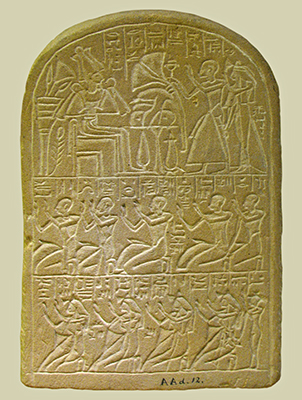
New Kingdom: 18th - 20th Dynasty, 1 550 BC - 1 077 BC
Iy-nefer
Iy-nefer and his wife, a 'Chantress of Amun' burning incense for Osiris. Below five men and five women are praying. Stela of sandstone.
Photo: Don Hitchcock 2014
Source: Original, Københavns (Copenhagen) Museum, National Museum of Denmark
New Kingdom: 18th - 21st Dynasty/High Priests of Amun Period, 1 550 BC - 943 BC
Heart Scarabs
Two heart scarabs. The undersides have an abridged version of Book of the Dead Spell 30.
Circa 1 450 BC - 980 BC
Catalog: Greenschist, Thebes(?), ÄS 1154, ÄS 6073
Photo: Don Hitchcock 2015
Source: Original, Ägyptischen Museum München
Text: Museum card, © Ägyptischen Museum München
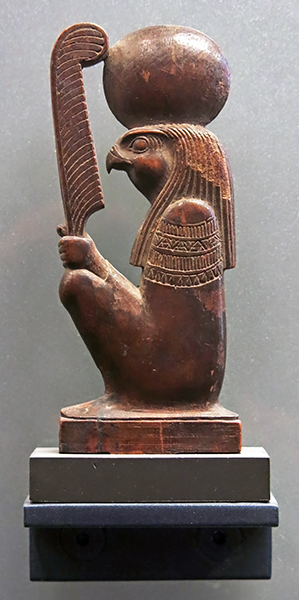
New Kingdom/Third Intermediate Period: 18th - 25th Dynasty, 1 550 BC - 656 BC
Re Figurine
Wooden figurine of Re, a falcon-headed god, crouching, with a shroud, sun disc on the head, Usekh necklace, holding an ostrich feather. A fixing pin on the bottom.
Height 102 mm, thickness 9 mm.
Catalog: Wood, E 5779, AF 2817
Location: Aile Sully, Salle 336 - Le Nil, Vitrine 7
Photo: Don Hitchcock 2015
Source and text: Original, Louvre Museum, https://collections.louvre.fr/
Additional text: Wikipedia

New Kingdom/Third Intermediate Period: 18th - 25th Dynasty, 1 550 BC - 656 BC
Amulet ring
Diameter 23 mm x 23 mm.
The faience coating imitates the deep blue colour of lapis lazuli. The symbol for 'life' (ankh) is engraved.
Catalog: Faience, place of discovery unknown, Inv.no. 1929.375
Photo: Don Hitchcock 2018
Source and text: Original, Museum August Kestner, Hannover
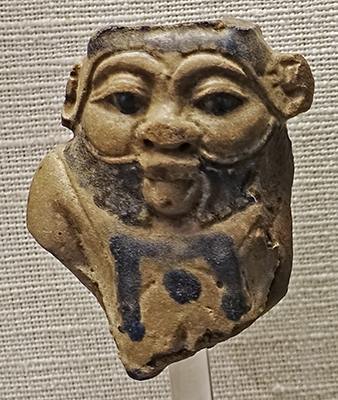
New Kingdom/Third Intermediate Period: 18th - 25th Dynasty, 1 550 BC - 656 BC
Head of a Bes figure
Height 63 mm, width 49 mm.
Judging by the rectangular depression on the head, the feather crown was placed separately. The faience is completely rubbed off; only remnants of brown detail drawing are preserved.
Catalog: Faience, place of discovery unknown, Inv.no. 1935.200.379
Photo: Don Hitchcock 2018
Source and text: Original, Museum August Kestner, Hannover
Ointment vessels
The ointment (sometimes translated as anointment) vessels below include round sculptural figures depicting monkeys. In all probability, this does not express a special connection of this animal with cosmetic materials. The decisive factor is more likely to be the role of the monkey as a docile, fun-loving housemate who squatted under the lady's or gentleman's chair and was trained to perform all kinds of simple acts, as attested to in numerous depictions.
Especially in the New Kingdom, the household also included Negroes, who were brought back from the campaigns of the pharaohs as prisoners and given to the high officials as slaves. At the same time, the connection may have been intended as a reference to the origin of precious essences (myrrh) from the southernmost, already African regions of the Nile and from the legendary land of Punt, the name of which was given by the Pharaohs. Its exact location is still disputed, but it was probably located in the area of present-day Somalia and inhabited by Negroid tribes.
The design of oil vessels (Aryballoi, small spherical or globular flasks with a narrow neck, used to contain perfume and oil - No. 145) in the shape of a hedgehog which is documented several times in the late period, is probably not only determined by the particularly suitable, almost spherical shape of the animal's body; the hedgehog also has, although it is difficult to specify, connections to Bes and to the goddess Courage and was regarded as a protective power because of its resistance to poisons (enemy of snakes!) - Aryballoi of this shape in the Greek culture can also be seen.
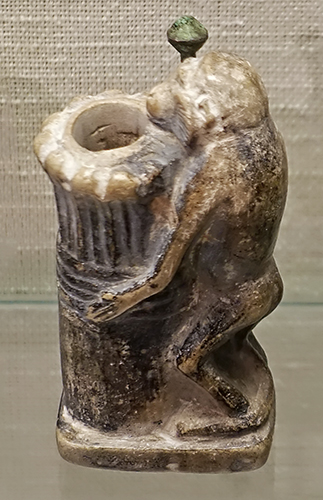
New Kingdom/Third Intermediate Period: 18th - 25th Dynasty, 1 550 BC - 656 BC
Ointment Vessel
Ointment vessel with a monkey
The actual ointment vessel is in the form of a column capital, which the monkey clasps rather than carries. A hole between the column, the right elbow and the right leg was apparently used to insert the makeup stick.
Height 79 mm.
Catalog: Limestone, origin unknown, Inv. No. 2880
Photo: Don Hitchcock 2018
Source and text: Original, Museum August Kestner, Hannover
Additional text: Paper Catalogue, Museum August Kestner, Hannover, Kayser (1969)

New Kingdom/Third Intermediate Period: 18th - 25th Dynasty, 1 550 BC - 656 BC
Female figures
(left) Female figure (number 158 in the vitrine)
Height 115 mm, breadth 31 mm.
In the female statuettes of this category, either both arms are pressed tightly against the body, or the left forearm is bent and lies across the body (cf. no. 159 on the right). Often, as here, the details of the body and the belt as the only 'garment' are indicated by painting.
Catalog: Teracotta, painted, origin unknown, Inv. no. 1950.17
Female figure (number 159 in the vitrine)
Height 95 mm, breadth 20 mm.
The polished details (face), the flowing transitions between the individual parts of the body and especially the flat, unfinished back can be explained by the manufacturing process: The terracotta figures were often copied from models and reproduced as cheap mass-produced goods.
Catalog: Teracotta, origin unknown, Inv. no. 1950.18
Photo: Don Hitchcock 2018
Source and text: Original, Museum August Kestner, Hannover
Additional text: Paper Catalogue, Museum August Kestner, Hannover
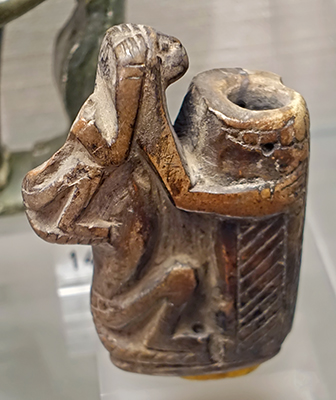
New Kingdom/Third Intermediate Period: 18th - 25th Dynasty, 1 550 BC - 656 BC
Ointment Vessel
Ointment vessel held by a monkey mother.
Dark stone, height 84 mm, width 34 mm, depth 65 mm.
The quite large monkey carries her young on her back.
Catalog: Dark stone, origin unknown, Inv. no. 1935.200.166
Photo: Don Hitchcock 2018
Source and text: Original, Museum August Kestner, Hannover
Additional text: Paper Catalogue, Museum August Kestner, Hannover.
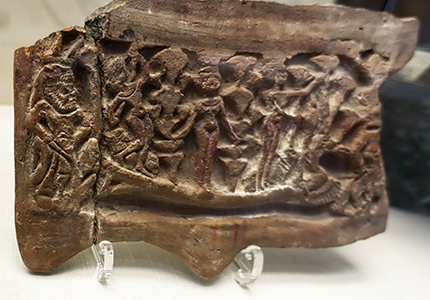
New Kingdom/Late Period: 18th - 31st Dynasty: 1 550 BC - 332 BC
Pastoral scene
Since only a distant parallel is known so far, it can only be assumed that the plate was part of a clay basin; its representation fits thematically into the framework of the pieces assembled here.
Three unclothed girls are riding on a papyrus boat whose prow is - very unusually - designed as a fluttering duck.
The girl in the stern strokes the boat forward, her comrade in the bow reaches into the plants with both hands and seems to shake them, performing a ritual that was used to summon the goddess Hathor. The figure in the middle is also unusual - she also grasps bundles of papyrus - due to the non-canonical rendering in en-face view. That an event comparable to the occidental 'pastoral scenes' is being displayed here is perhaps also indicated by the two Bes figures flanking the boat.
Terracotta, painted red; height 172 mm, breadth 269 mm.
Catalog: Terracotta, origin unknown, Inv. no. 1935.200.331
Photo: Don Hitchcock 2018
Source and text: Original, Museum August Kestner, Hannover
Additional text: Paper Catalogue, Museum August Kestner, Hannover.
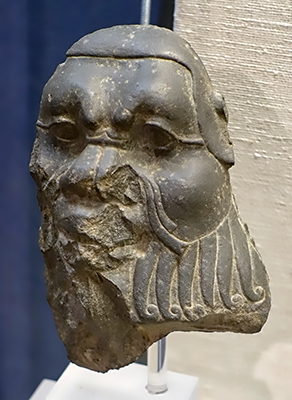
New Kingdom/Late Period: 18th - 31st Dynasty: 1 550 BC - 332 BC
Bes
Face of a Bes figure.
Height 137 mm, width 91 mm.
Despite the fragmentary condition, the essential characteristics of the god's image are recognisable, especially the beard ruff adopted from the lion.
Catalog: Slate, place of discovery unknown, Inv.no. 1935.200.529
Photo: Don Hitchcock 2018
Source and text: Original, Museum August Kestner, Hannover
Additional text: Printed Catalogue, Museum August Kestner, Hannover
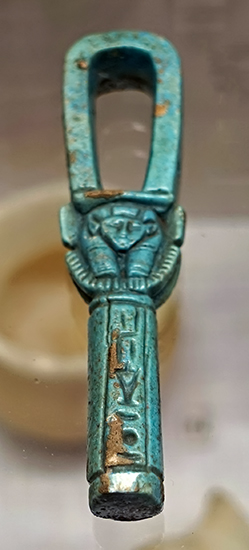
New Kingdom/Late Period: 18th - 31st Dynasty: 1 550 BC - 332 BC
Model sistrum
The sistrum belongs to the ideophones, in particular as a rattling instrument in the cults of goddesses. This model, made of faience, was only ten centimetres long, so was probably too small (and delicate, most are made of metal) to have been used in practice, but may have belonged to a grave or represented a temple dedication.
( The advantage of a model is that it was magically transformed into the real object in the afterlife of the deceased, but many could be made very cheaply (in terms of labour and skill and time) from faience for use in one grave, or indeed a number of graves at the one time, with a very good looking result - Don )
Height 100 mm, width 24 mm.
Catalog: Faience, origin unknown, Inv. no. 2865
Photo: Don Hitchcock 2018
Source and text: Original, Museum August Kestner, Hannover
Additional text: Paper Catalogue, Museum August Kestner, Hannover, Kayser (1969) p.141
References
- Adams B., Porat N. , 1996: Imported Pottery with Potmarks from Abydos, In: J. Spencer (ed.), Aspects of Early Egypt, London: British Museum Press, p. 98-107.
- Anderson W. , 1989: Badarian Burials: Possible Indicators of Social Inequality in Middle Egypt During the Fifth Millennium B.C., Department of Anthropology McGill University, Montreal April, 1989, a thesis submitted to the Faculty of Graduate Studies and Research in partial fulfilment of the requirements for the degree of Master of Arts
- Bayoumi T., El-din R., 2022: Representations of a Goddess Suckling a King in Ancient Egypt,https://cguaa.journals.ekb.eg/article_37343_876ae6fc336f4f8e0358165e273e913c.pdf accessed 2022
- Böhme I. , 2013: Die privaten Sarkophage des Neuen Reiches – ein Vorbericht, Göttinger Orientforschungen IV Ägypten 54, DAI Kairo - German Archaeological Institute Cairo, preliminary paper for a PhD thesis.
- Breasted J. , 1903: Jewellery from the Tombs of Egypt, The Biblical World, Vol. 22, No. 1 (Jul., 1903), pp. 64-66, published by The University of Chicago Press, http://www.jstor.org/stable/3140533.
- Brunton G., Caton-Thompson C., 1928: The Badarian civilization and predynastic remains near Badari, (British School of Archaeology in Egypt and Egyptian research account : thirtieth year, 1924). 1928
- Brunton G., Morant G., 1937: Mostagedda and the Tasian Culture, British Museum Expedition to Middle Egypt, First and Second Years (1928, 1929), B. Quaritch Limited, 1937 - Egypt - 163 pages
- Caton-Thompson E., Gardner E., 1934: The Desert Fayum, Royal Anthropological Institute of Great Britain and Ireland, London, 1934.
- Cowie S., Johnson T., 2001: The Mummy in Fact, Fiction and Film, McFarland, 3 Dec. 2001 - Performing Arts - 208 pages
- Cramer M., 1936: Zeitschrift für Ägyptische Sprache und Altertumskunde, Volume 72, 1936. pp. 100ff. u. Tf. IX, 1, 2.
- David R., 2002: The Experience of Ancient Egypt, Rutledge, 9 Sep. 2002 - Social Science - 216 pages
- Davies B., 1999: Who's who at Deir el-Medina : a Prosopographic Study of the Royal Workmen's Community, Leiden : Nederlands Instituut voor Het Nabije Oosten, 1999
- Davies Norman de Garis, 1925: The Tomb of Two Sculptors at Thebes, The Metropolitan Museum of Art, Robb de Peyster Tytus Memorial Series Volume IV.
- Dodson A., Hilton D., 2004: The Complete Royal Families of Ancient Egypt, The American University in Cairo Press, London 2004
- Erman A., 1894: Life in Ancient Egypt, Courier Corporation, 1894 - History - 570 pages
- Erman A., 1927: The literature of the ancient Egyptians; poems, narratives, and manuals of instruction, from the third and second millennia BC, London, Methuen & co. ltd., pp. 67f.
- Ertman E., 2013: Gesichtseinlage von König Echnaton / Amenophis IV. aus opak-blauem Glas, Auszug und Übersetzung aus Journal of Glass Studies 2013-55, S. 13-19
- Escolano-Poveda M., 2019: Egypt’s Pharaohs welcomed summer with this fabulous festival, 20/03/20. Retrieved from: https://www.nationalgeographic.com/history/magazine/2019/05-06/ancient-egypt-royal-feast/
- García J., 2013: Ancient Egyptian Administration, BRILL, 7 Jun. 2013 - Reference - 1112 pages
- Gatto M., 2001-2002: Two Predynastic pottery caches at Bir Sahara (Egyptian Western Desert), Sahara, 13: 51 - 60
- Gressmann H., 1909: Altorientalische Texte und Bilder zum Alten Testamente, Tübingen, J.C.B. Mohr.
- Habicht M., 2014: Semenchkare - Phantom-König von Achet-Aton: Beitrag zur Erforschung der rätselhaften Nachfolge von Echnaton,epubli, 17 Feb 2014 - Science - 96 pages
- Harer W., 1985: Pharmacological and Biological Properties of the Egyptian Lotus, Journal of the American Research Center in Egypt, Vol. 22 (1985), pp. 49-54 Published by: American Research Center in Egypt DOI: 10.2307/40000390
- Hartwig M., 2006: A Companion to Ancient Egyptian Art, John Wiley & Sons, 23 Dec. 2014 - Literary Criticism - 624 pages
- Hodel-Hoenes S., 2006: Life and Death in Ancient Egypt: Scenes from Private Tombs in New Kingdom Thebes, Cornell University Press, 2000 - Art - 329 pages
- Holmes D., 1989: The Predynastic Lithic Industries of Upper Egypt: A Comparative Study of the Lithic Traditions of Badari, Nagada and Hierakonpolis, BAR (15) 469, Volumes I and II.
- Humphreys C., Waddington G., 2017: Solar eclipse of 1207 BC helps to date pharaohs, Astronomy & Geophysics, Volume 58, Issue 5, 1 October 2017, Pages 5.39–5.42, https://doi.org/10.1093/astrogeo/atx178, Published: 01 October 2017
- Jung M., 2012a: F. Seyfried (eds.), In the Light of Amarna. 100 years of the discovery of the Nefertiti, Berlin 2012, p. 206 (cat. No. 7).
- Jung M., 2012b: in: F. Seyfried (Hrsg.), Im Licht von Amarna. 100 Jahre Fund der Nofretete, Berlin 2012, p. 332
- Kákosy L., 1995: 'The Soter Tomb in Thebes', in S.P, Vleeming (ed.), Hundred-Gated Thebes: Acts of a Colloqium on Thebes and the Theban area in the Graeco-Roman Period, Leiden: Brill, 61- 67
- Kayser H., 1969: Ägyptisches Kunsthandwerk: ein Handbuch für Sammler und Liebhaber, Braunschweig, Klinkhardt & Biermann, 1969
- Kitchen K., 1993: Ramesside inscriptions : translated and annotated Notes and comments, 1, Ramesses I, Sethos I and contemporaries (Oxford, 1993), 2-3.
- Loret V., 1889: La Tombe de Khâ-M-Hâ, in: Gaston Maspero, in: Urbain Bouriant - Victor Loret - H. Dulac (editors), Mémoires publiés par les membres de la mission archéologique française au Caire, Tome premierFasc. 1, Paris 1889, plate 1 after page 114
- Malkowski E., 2010: Before the Pharaohs: Egypt's Mysterious Prehistory, Inner Traditions / Bear & Co, Apr 12, 2010 - History - 336 pages
- Martin G., 1991: Hidden Tombs of Memphis, Thames and Hudson, London 1991
- Maspero G., 1903: History of Egypt, Chaldea, Syria, Babylonia, and Assyria, London : Grolier Society
- Math N., 2014: Die Badarikultur, Neue Untersuchungen zu einer Kultur des 5. Jahrtausends v. Chr., angestrebter akademischer Grad Master of Arts (MA) Wien, 2014
- Matsui T. et al., 2022: The manufacture and origin of the Tutankhamen meteoritic iron dagger, Meteoritics and Planetary Science, https://doi.org/10.1111/maps.13787
- McKerrel H., Tylecote R., 1972: The working of copper-arsenic alloys in the Early Bronze Age and the effect on the determination of provenance, Proceedings of the Prehistoric Society, 38, pp. 209–218. doi: 10.1017/S0079497X00012111.
- Mettlen J., 2012: in: F. Seyfried (Hrsg.), Im Licht von Amarna. 100 Jahre Fund der Nofretete, Berlin 2012, p. 344 (cat. No. 126).
- Meyer-Dietrich E., 2017: Auditive Räume des alten Ägypten: Die Umgestaltung einer Hörkultur in der Amarnazeit, Brill, 9 Nov. 2017, pp. 1128.
- Moberly Bell E., 1888: From Pharaoh to Fellah, First Edition, p 119, Wells Gardner, Darton & Co.
- Nelson H., 1913: The Battle of Megiddo, Dissertation for a PhD, University of Chicago
- O'Connor D., Cline E., 2001: Amenhotep III: Perspectives on His Reign, University of Michigan Press, 2001 - History - 393 pages
- Patch D., Eaton-Krauss M., Allen S., 2011: Dawn of Egyptian Art, Jan 1, 2011 - Art, Ancient - 275 pages
- Pommerening, T., Marinova, E., Hendrickx, S., 2010: The Early Dynastic origin of the water-lily motif, Chronique d'Egypte, 85 (2010): 14-40
- Raven M., 1980: Papyrus-sheaths and Ptah-Sokar-Osiris Statues, RMO, 1980 - 296 pages
- Rawlinson H., 1867: The Assyrian Canon Verified by the Record of a Solar Eclipse, B.C. 763, Athenaeum, #2064 660 (18 May)
- Riemer H., Kuper R., 2000: 'Clayton rings': enigmatic ancient pottery in the Eastern Sahara, Sahara, 12: 91-100.
- Saleem S., Hawass Z., 2021: Digital Unwrapping of the Mummy of King Amenhotep I (1525–1504 BC) Using CT, Front. Med., 28 December 2021 | https://doi.org/10.3389/fmed.2021.778498
- Schneider H., Raven M., 1981: De Egyptische Oudheid, Rijksmuseum van Oudheden, Leiden.
- Schneider H., Raven M., 1999: Life and Death Under the Pharaohs, Rijksmuseum van Oudheden, Leiden.
- Schoske S., Wildung D., 2013: Das Münchner Buch der Ägyptischen Kunst, München 2013
- Seyfried F., 2012: Im Licht von Amarna. 100 Jahre Fund der Nofretete, Berlin 2012, p. 322.
- Shaw I., 2000: The Oxford History of Ancient Egypt, Oxford University Press, USA, 31 Aug. 2000 - History - 528 pages
- Smith H., 2006: The Fortress of Buhen: The Inscriptions, (London, 1976), 118-19, no. 1511, pls. XXV/1, LXXIV/2-3
- Spanel D., 2001: in Redford D. (ed.), The Oxford Encyclopedia of Ancient Egypt, vol. 1, Oxford University Press, 2001
- Strudwick N., 2006: Masterpieces of Ancient Egypt, University of Texas Press, 1 Nov. 2006 - Social Science - 352 pages
- Taylor J., 1999: Studies in Egyptian antiquitie, British Museum, Occasional Paper 123 (1999)
- Taylor J., 2010: Journey Through the Afterlife: Ancient Egyptian Book of the Dead, Harvard University Press, 2010 - History - 320 pages
- Verner M., 2014: From The Pyramids, Atlantic Books Ltd, 6 Nov. 2014 - History - 300 pages
- von Zabern P., 1980: Tutanchamun in Köln, Kölnisches Stadtmuseum
- Wallert I., 1967: Der verzierte Löffel. Seine Formgeschichte und Verwendung im Alten Ägypten, Ägyptologische Abhandlungen, 16,Wiesbaden: Harrassowitz.
- Weber A., 2012: in: F. Seyfried (ed.) Im Licht von Amarna. 100 Jahre Fund der Nofretete, Berlin 2012, S. 226 (Kat.-Nr. 18). Atlantic Books Ltd, 6 Nov. 2014 - History - 300 pages
- Wegner E., 2012: in: F. Seyfried (Hrsg.), Im Licht von Amarna. 100 Jahre Fund der Nofretete, Berlin 2012, p. 348 (cat. No. 129).
- Wilkinson T., 2002: Early Dynastic Egypt, Routledge, 11 Sep. 2002 - Social Science - 440 pages
Back to Don's Maps
 Back to Archaeological Sites
Back to Archaeological Sites
 Back to Egypt Index Page
Back to Egypt Index Page
